

NEW GEN
MYRIEM BOUKADIDA THE ANNIVERSARY ISSUE


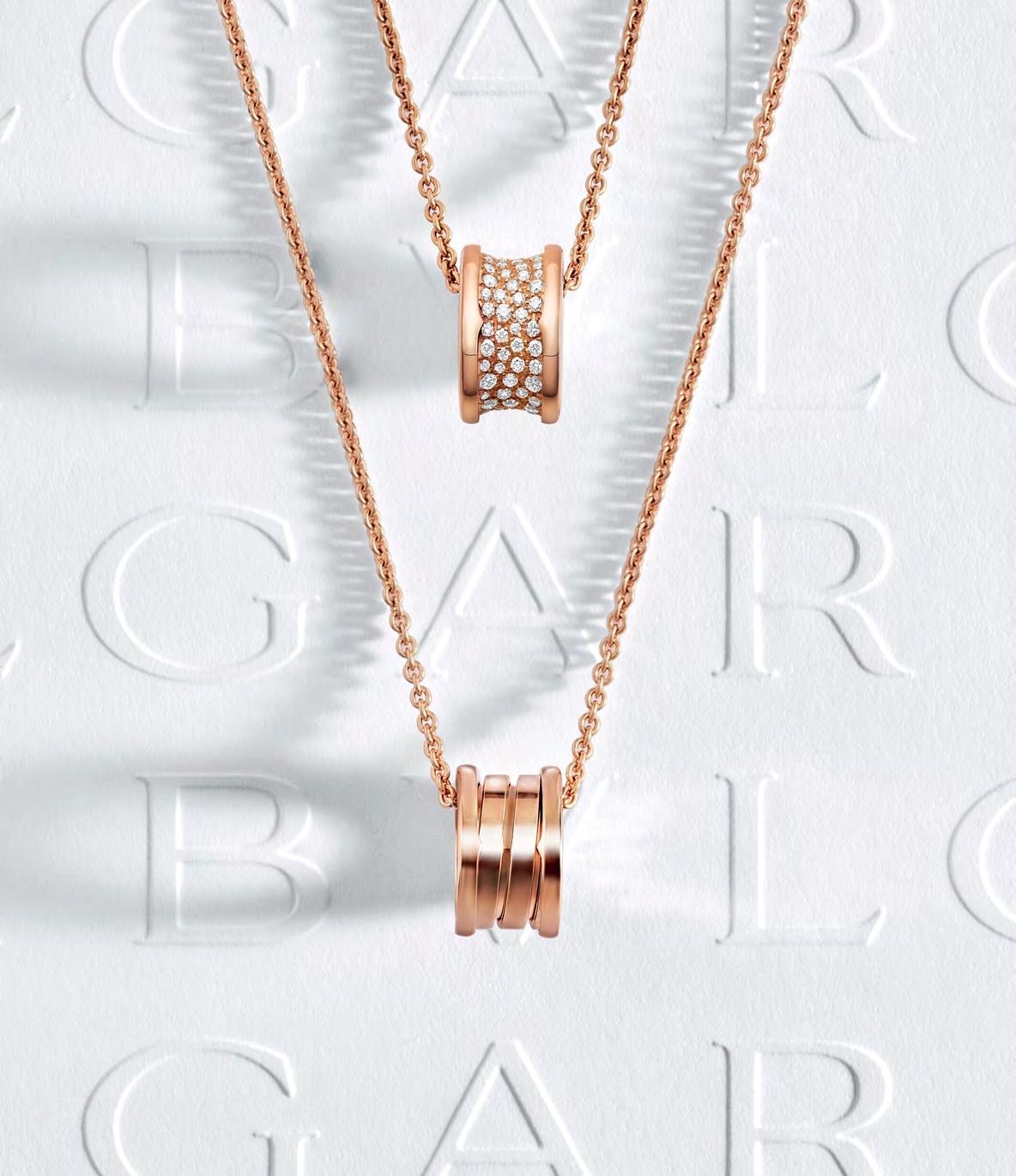




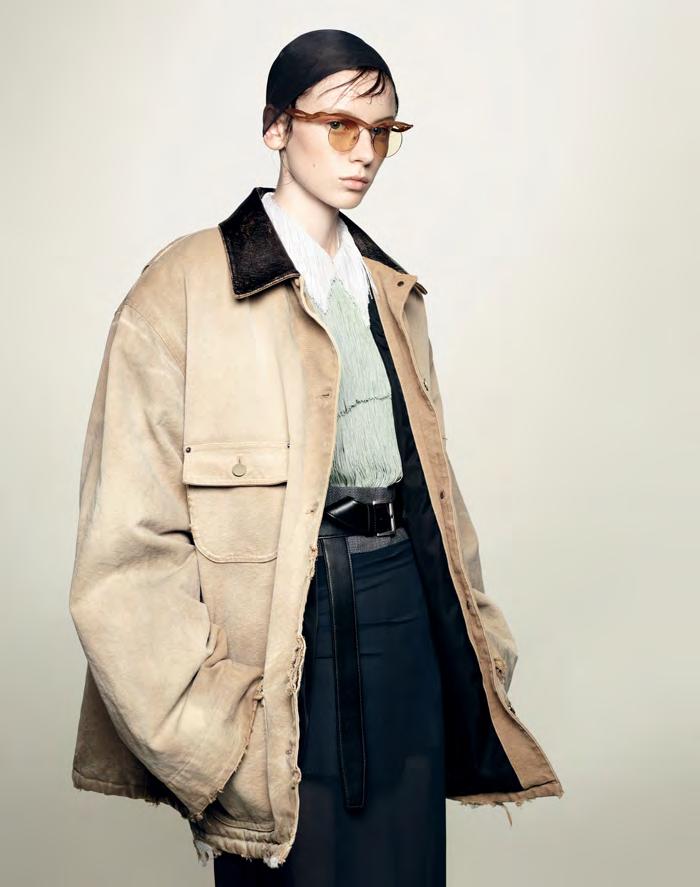

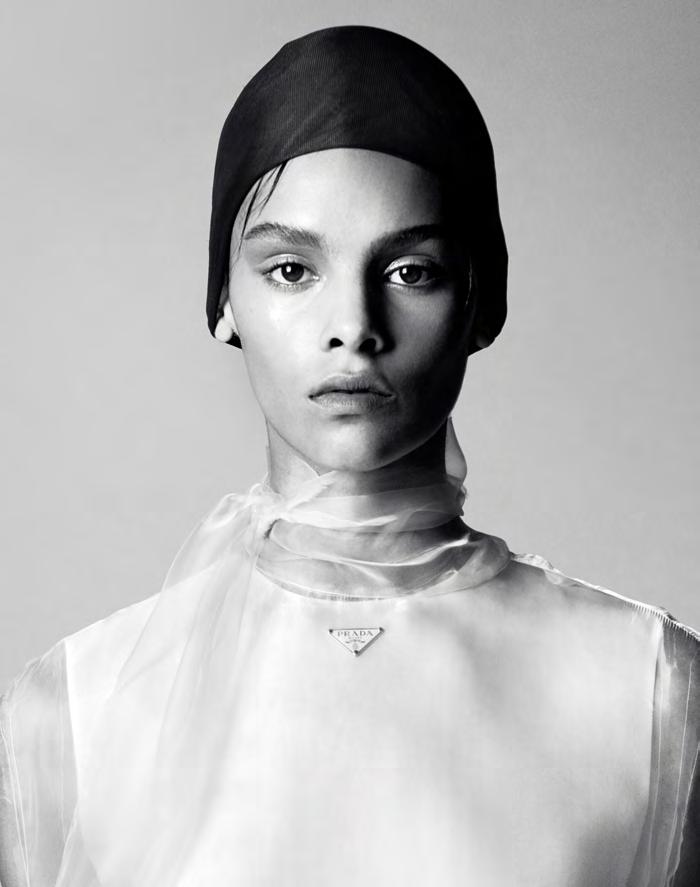





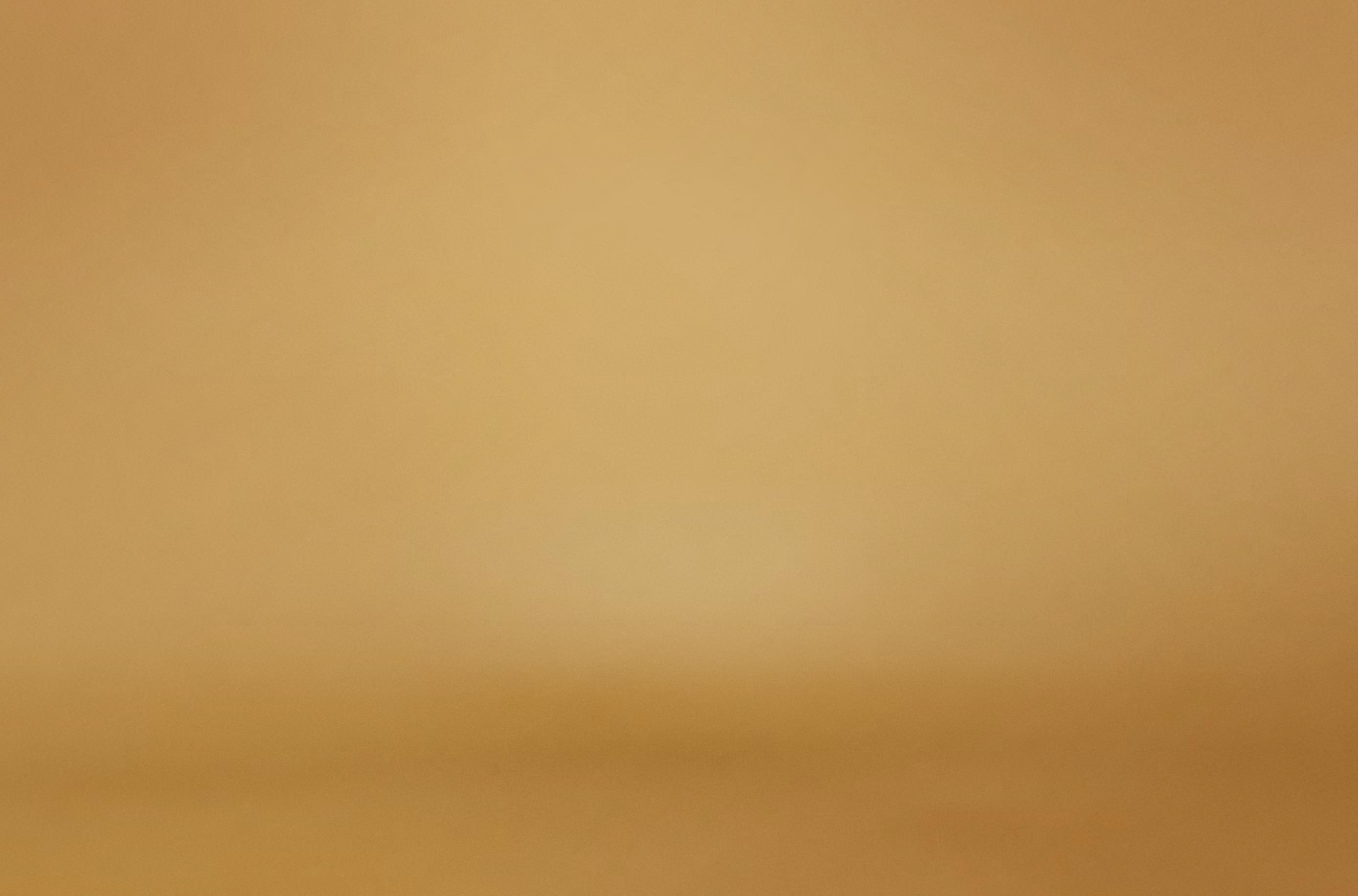


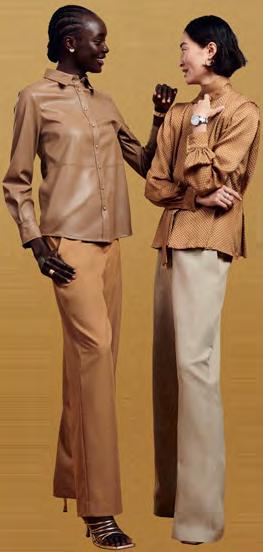


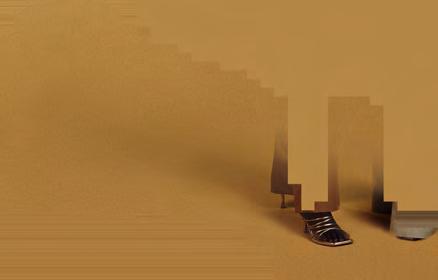




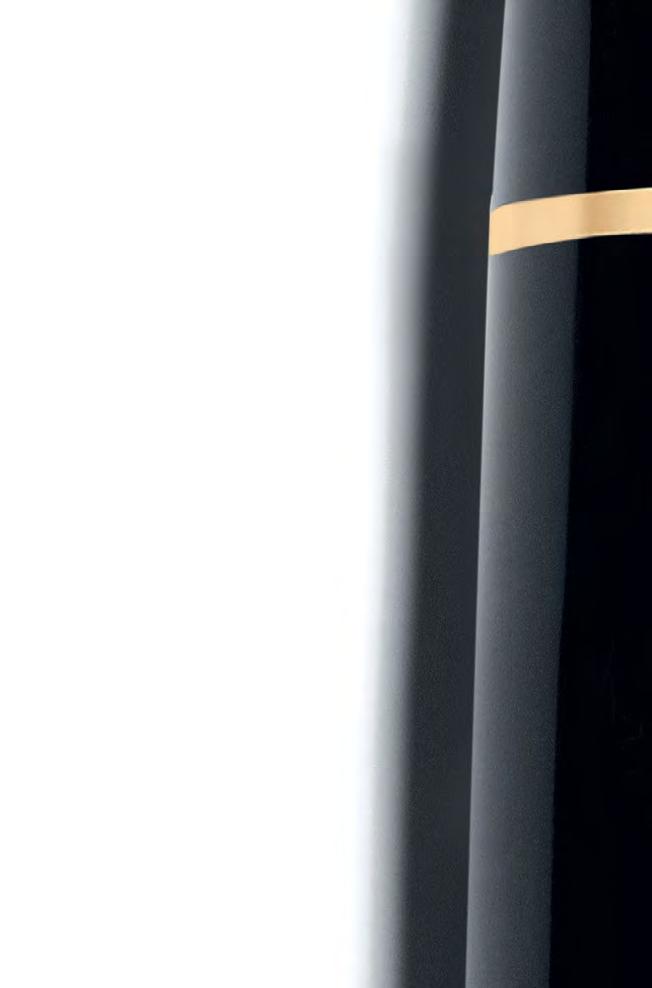
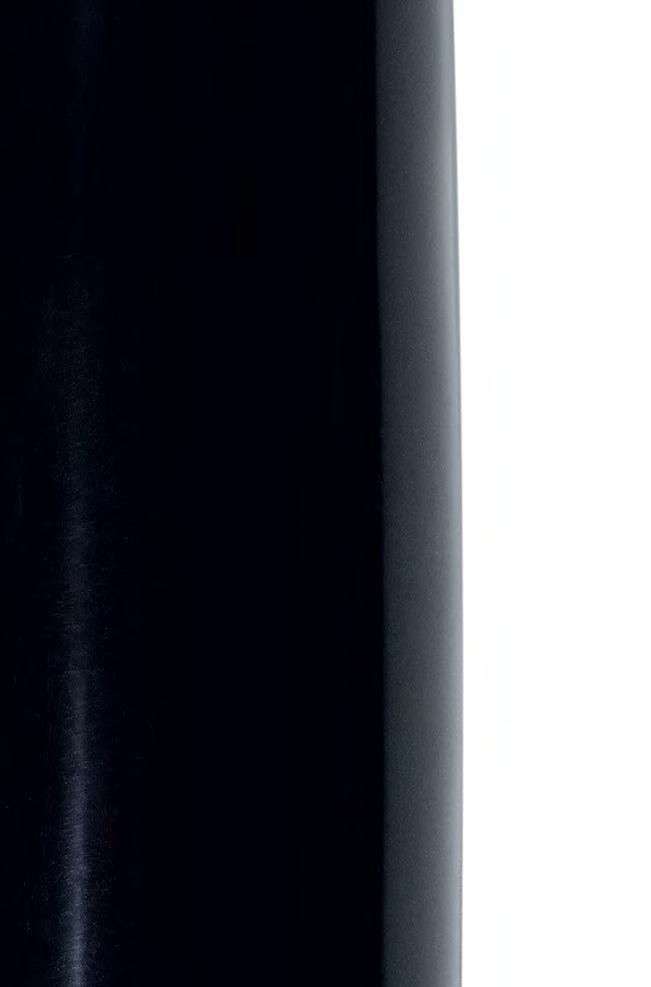

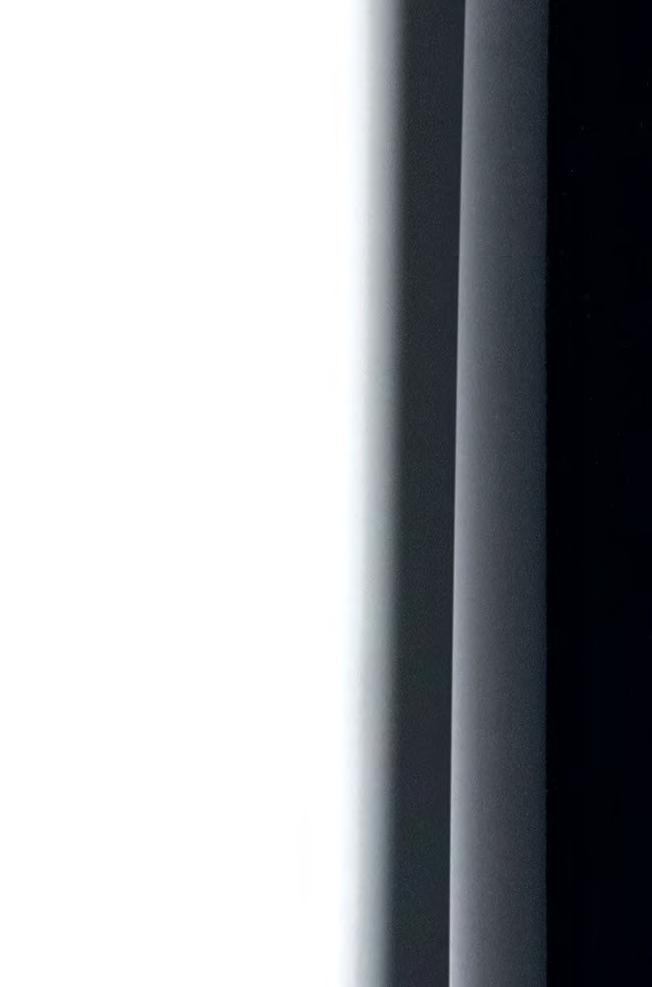
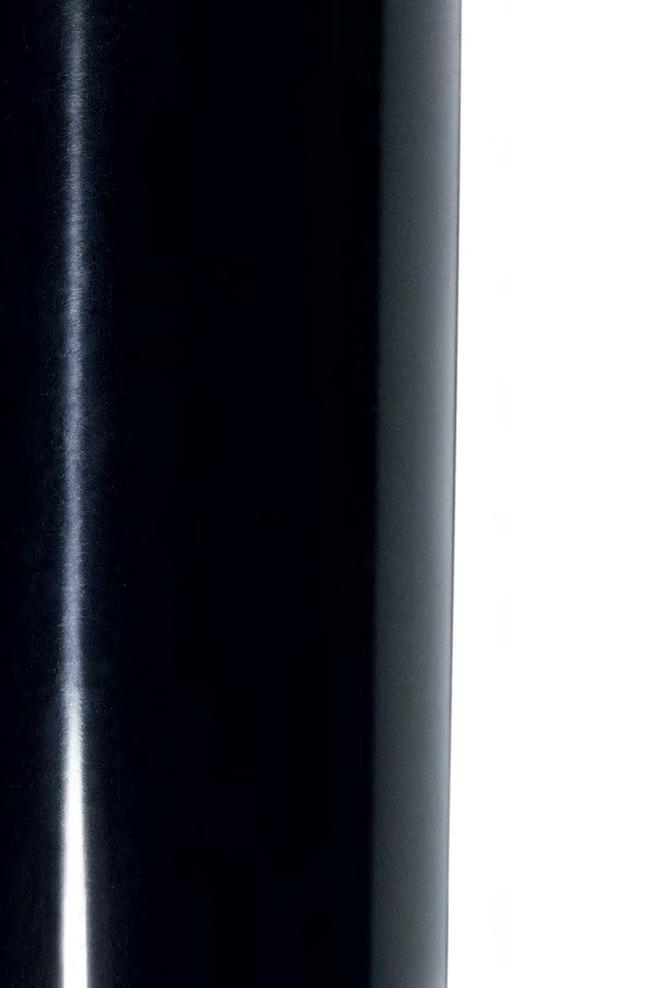

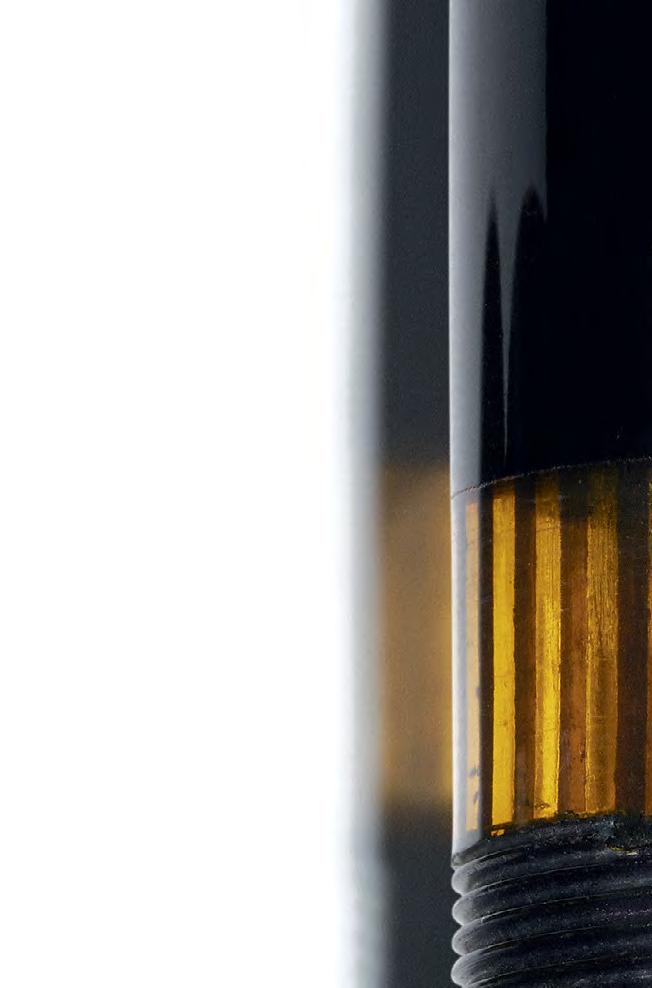
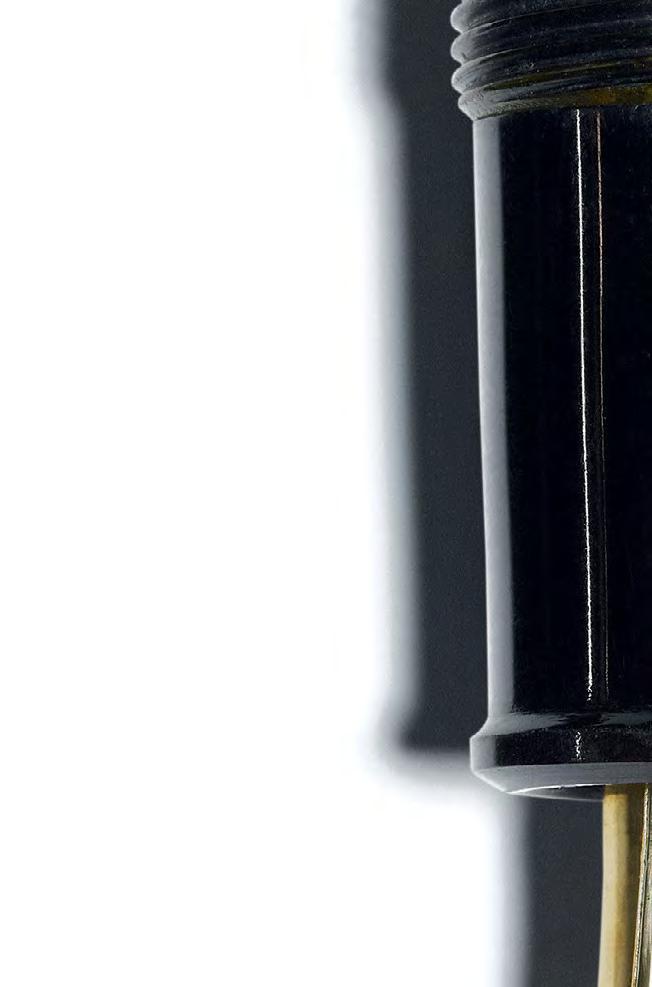

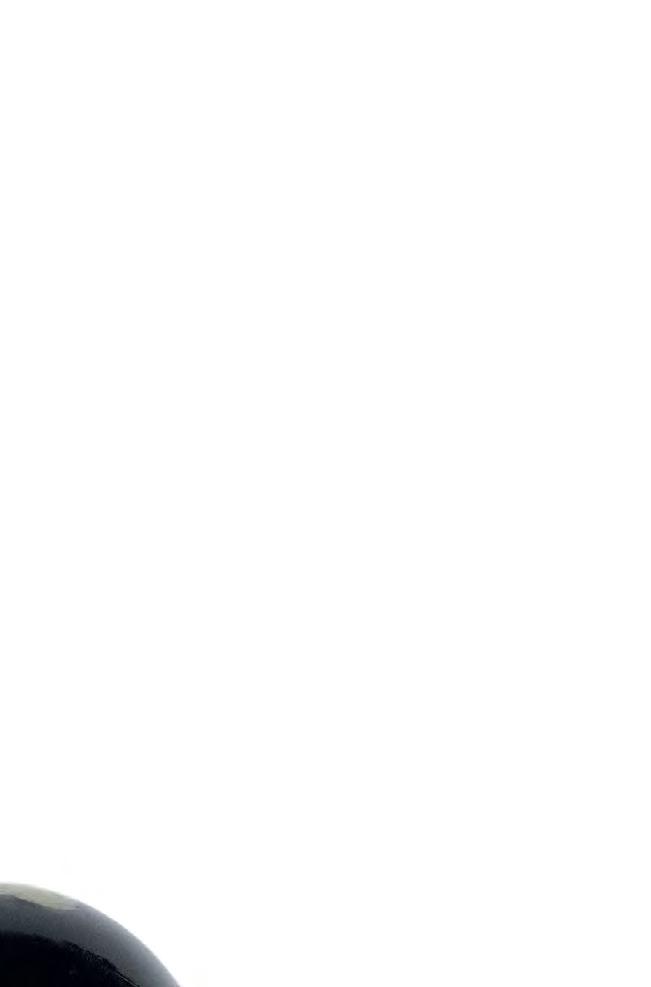





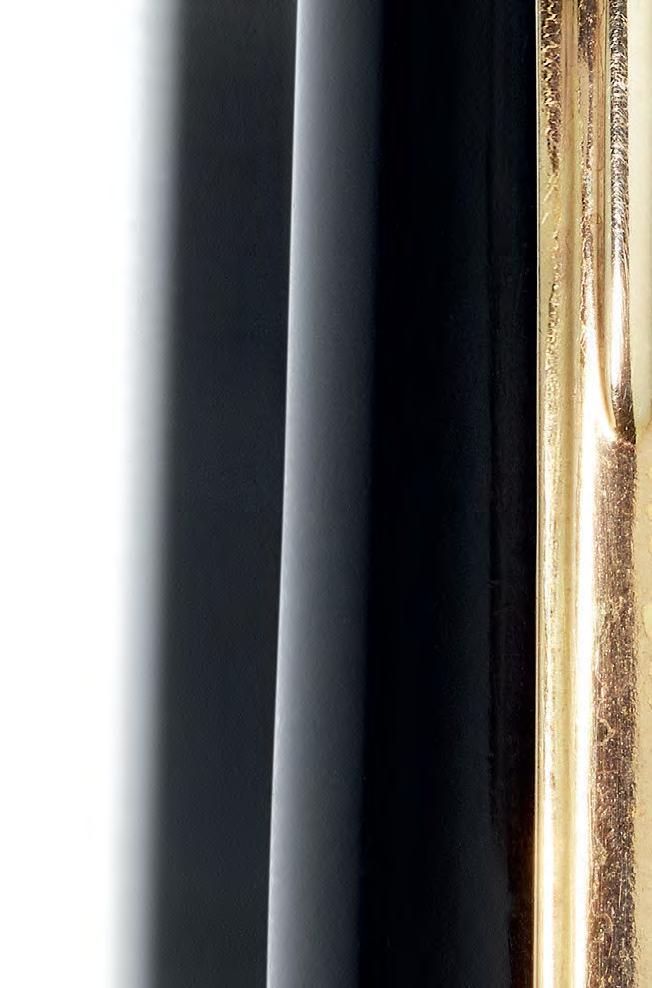
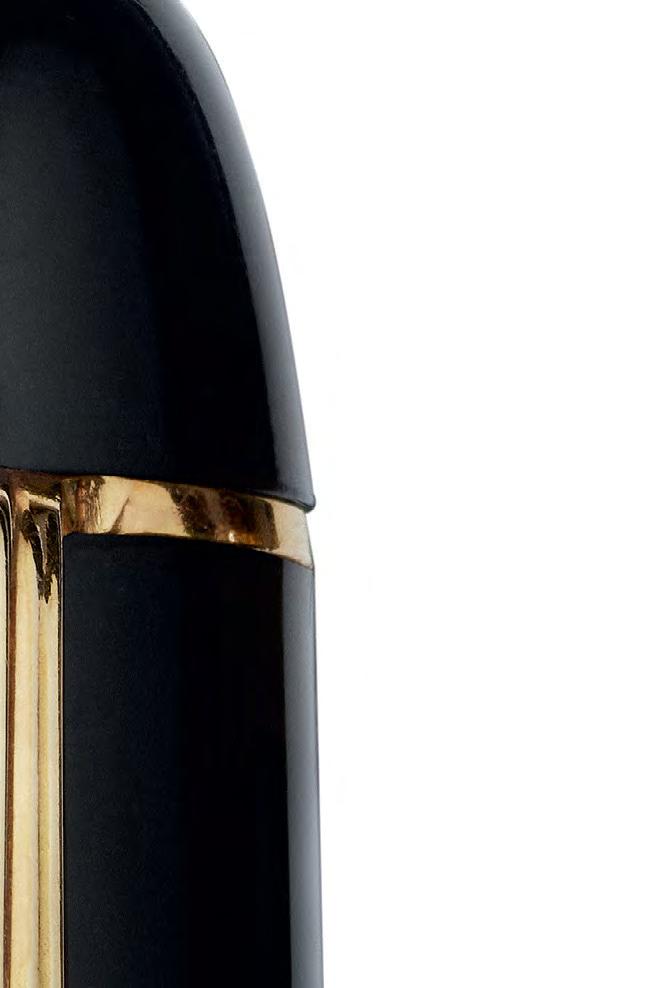
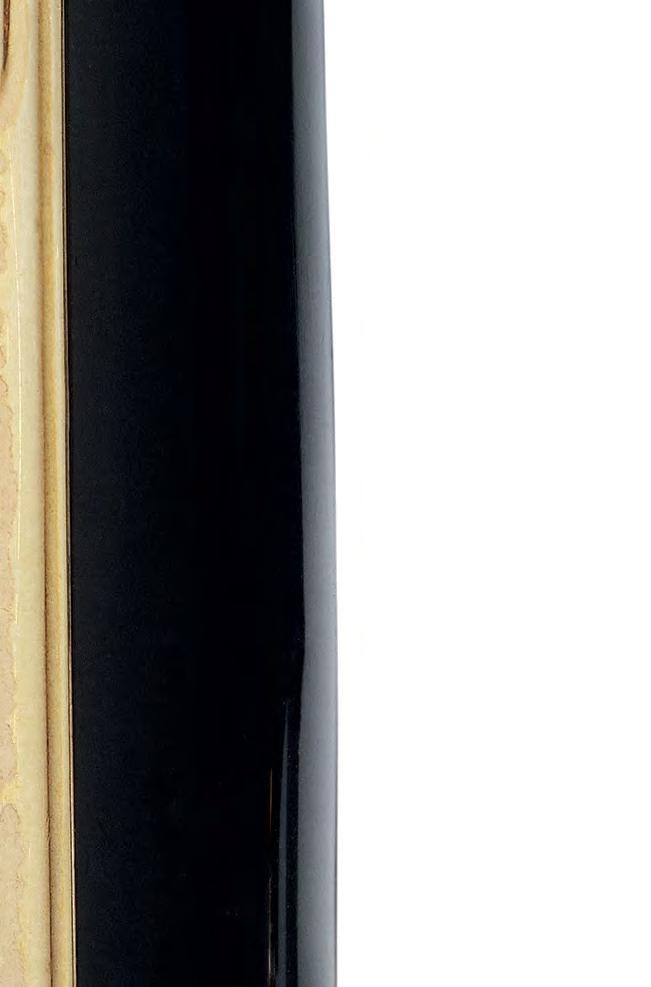


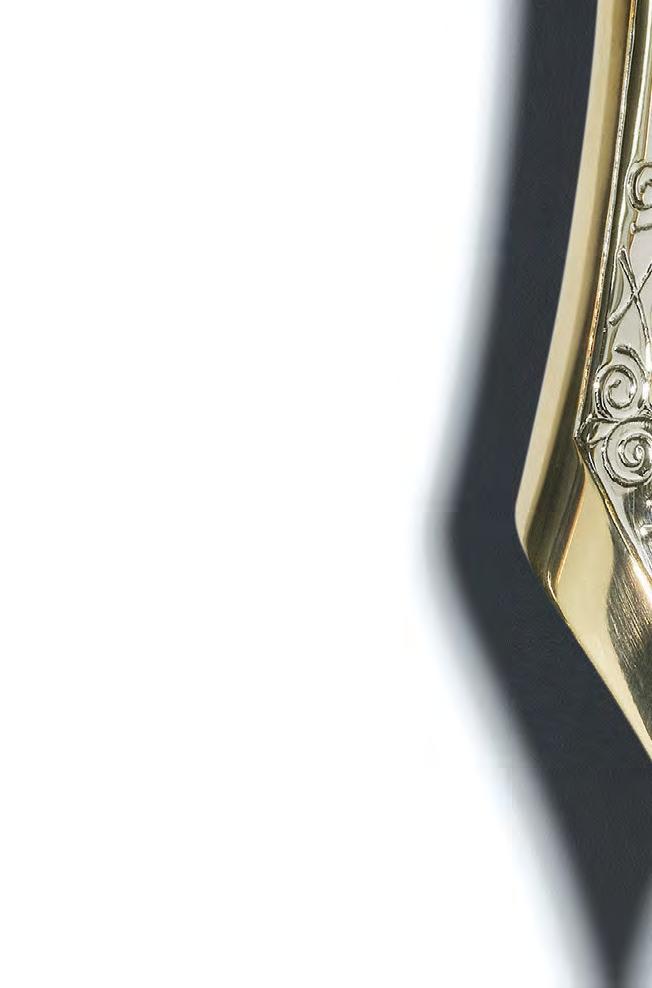

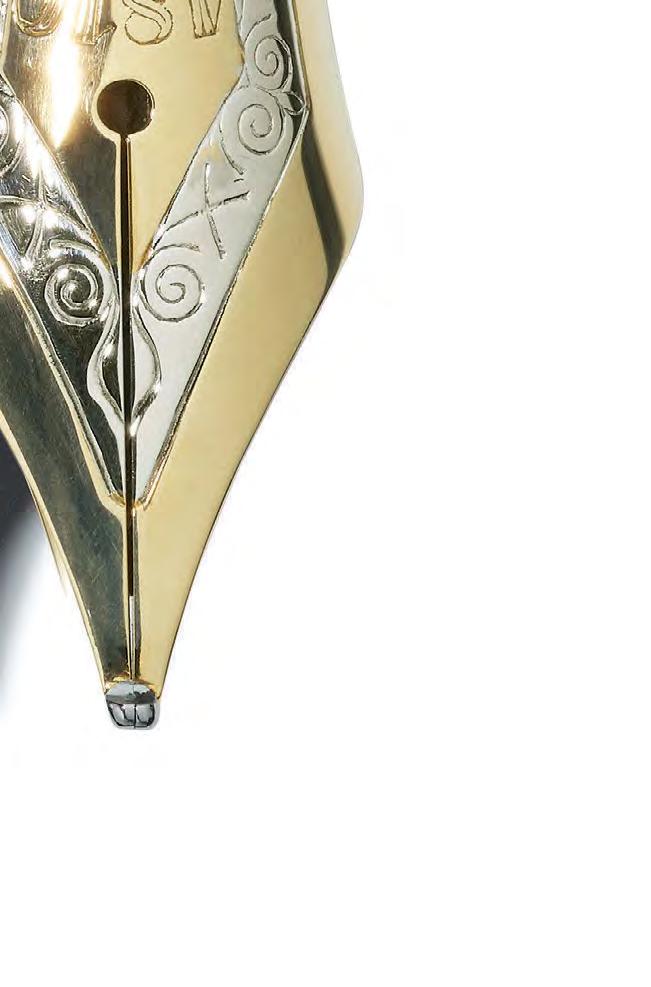
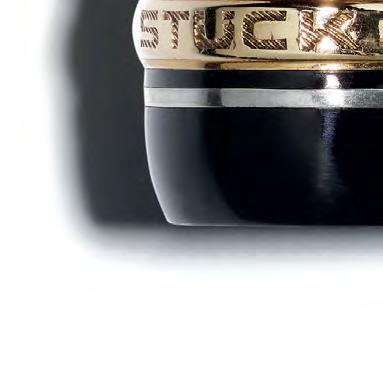
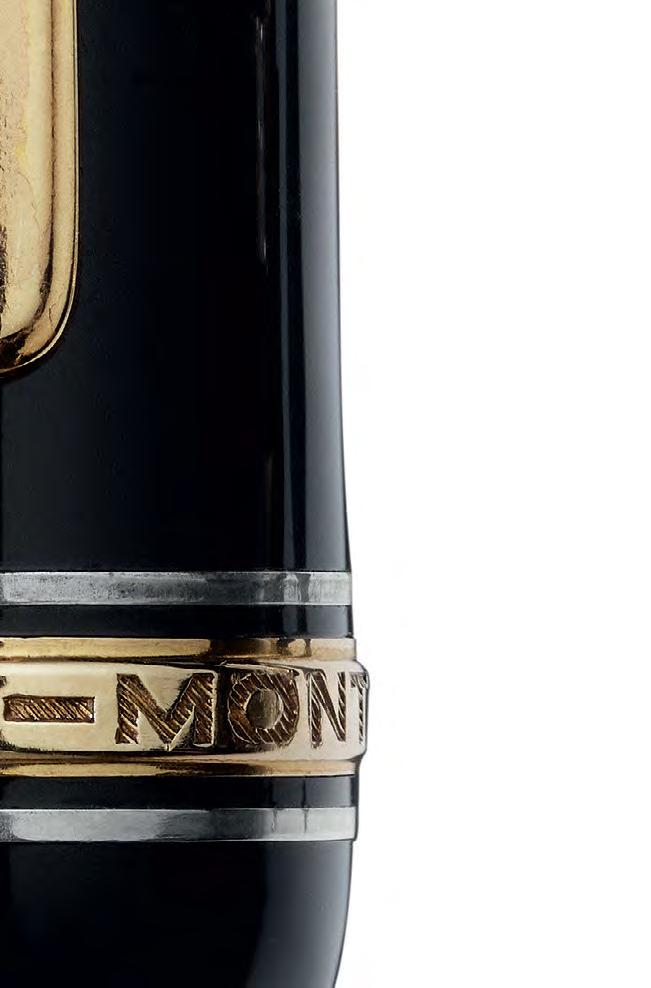
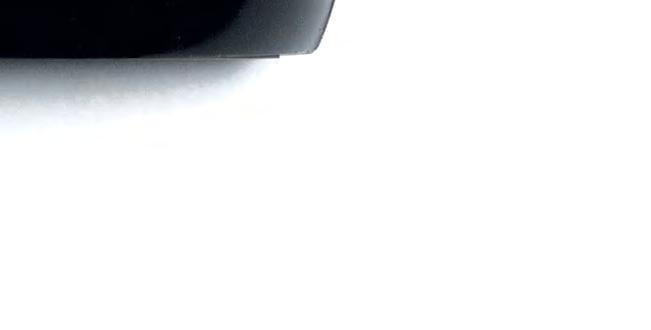
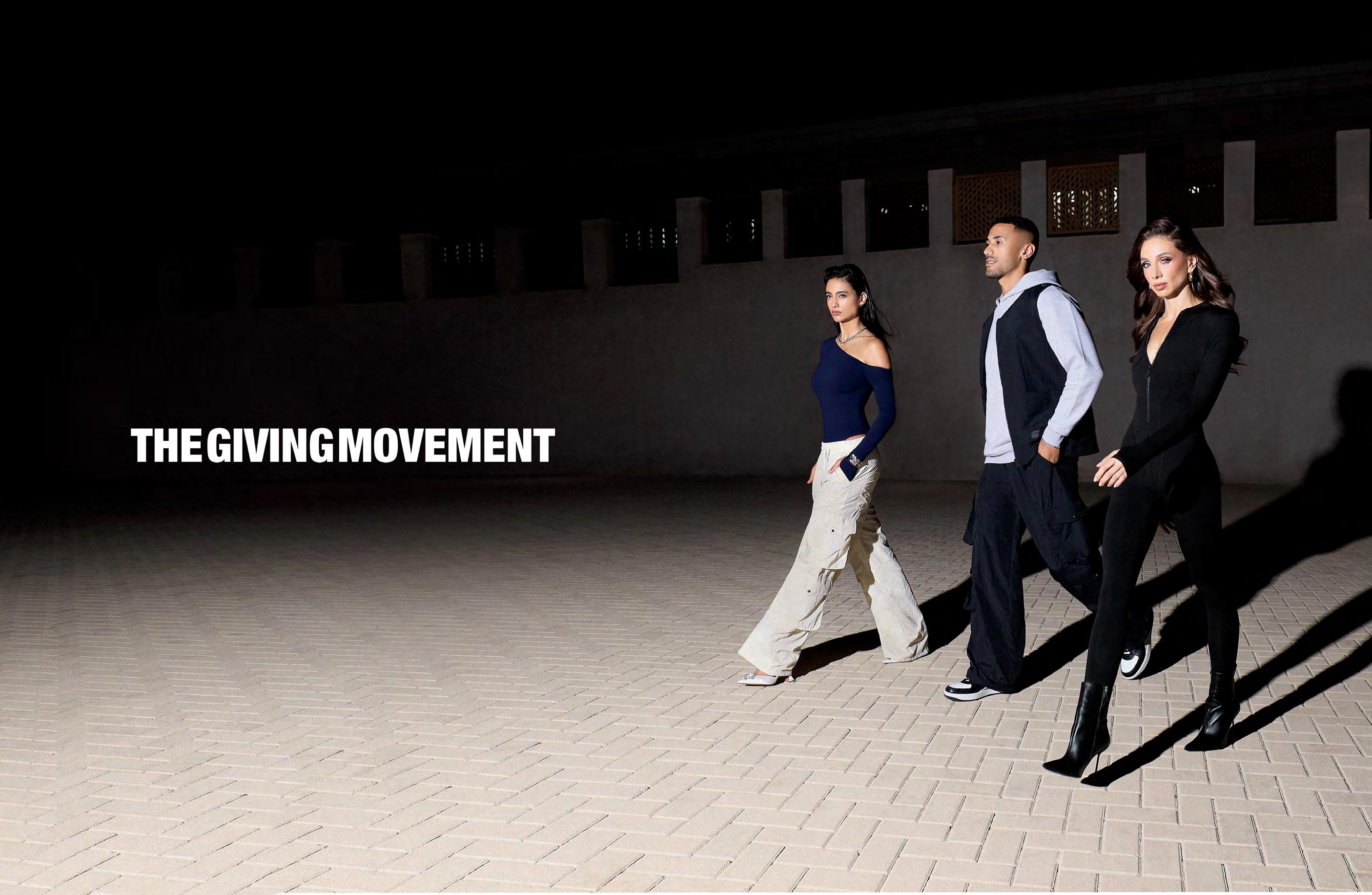

To Our People,
730 days later; 24 covers and more than a hundred creatives featured to date, we come to celebrate a milestone in the journey of YUNG—our second-year anniversary.
Just two years ago, YUNG existed merely as a spark of an idea, a concept nurtured within the depths of my mind and heart for as long as I can remember. I had a deep-seated desire to create a platform that would illuminate, celebrate, and be the voice of the unyielding talent within our region. And so, with unwavering determination, I brought that idea to life, launching YUNG’s first issue. Even now, as we stand at this juncture, two years later, the journey still feels surreal—like I am living in my own dream, manifested to reality.
Yet, the journey towards that dream has not been without challenges. Despite the setbacks, doubt and fear never clouded my vision. I accepted the stumbles and discovered that with the unconditional support of those who shared my mission, nothing was impossible. My team, in particular, has been my greatest pillar of support, wholeheartedly dedicating themselves across multiple platforms including print, digital, and social media.
After two years, I am thrilled to announce the launch of YUNG’s Anniversary Issue 2: The “New Gen” edition. This issue not only commemorates our second-year anniversary, but also celebrates the emerging talents within the MENA region—the new generation poised for success, driven by determination and passion. On every page, we’ve crafted content designed to immerse you in captivating narratives. Content that is created, designed and curated, not syndicated. We draw from the richness of our own region, proving that we have much more to offer than the world realises.
On our covers, you’ll encounter four trailblazing talents who represent the future of their respective fields. Meet Myriem Boukadida, the captivating Tunisian model and actress; Jad Hobeika, the visionary Lebanese fashion designer; Thalia Elansari, the emerging Jordanian actress; and Bayou, the exceptionally talented Egyptian singer-songwriter. Each of these talents embody the essence of the next generation, echoing the narrative and the journeys we aim to highlight at YUNG.
We captured the covers over three days in London, where I had the privilege of witnessing the stories of our Cover Stars unfold—their pasts, presents, and aspirations for the future. Each narrative drew me in completely, leaving an indelible mark on my heart. Myriem’s fearless presence on set left me in awe; with every click of the camera, her strength was palpable. Jad’s discussions about prints and embroideries with the team showcased his commitment to rejuvenating the George Hobeika house with fresh designs. As Bayou hummed beats while getting dressed, I sensed his creative energy flowing, envisioning new songs taking shape. And watching Thalia effortlessly embody her role in front of the camera affirmed her natural talent and passion for acting. Witnessing these young creatives in action was truly inspiring; they seized every moment to unleash their creativity, undeterred even by the dozen cameras pointed their way on set.
This issue we present a wealth of talent from across the MENA region, from Samy Sounessi and his Secret Language, to an American-Palestinian photographer who tells tales of resistance to an Omani creative merging AI and art. We delve into the local beauty industry with in-depth interviews with leading figures and we introduce you to Ziad Zaza and his incredible sounds. There’s so much more, but you’ll have to turn the page, I don’t want to spoil it.
Finally, I have to say to all the YUNG readers that their unconditional love and support mean more to me than anything else. Today, my wish for you, dear readers, is simple: Never stop dreaming. For it is through our dreams that we shape the future.
Happy anniversary once again YUNG! And happy anniversary to everyone involved. Without each and every one of you, this would have remained merely an idea in my head. It is through your collective efforts and support that this dream has become the reality that I am living today. Here’s to us, and here’s to love.
THIS IS YUNG LETTER FROM THE FOUNDER 10-11

THIS IS YUNG CONTENTS 12-13
Contributors Masthead The Mood Myriem Boukadida Jad Hobeika Thalia Elansari Bayou Gravitational Attraction Glenn Martens White Chanel On The Move Tod’s The Giving Movement The Black Liner Burberry Beyond The Surface Revolutionising Radiance Bulgari Studio Piaget Audemars Piguet Masters Of The Lens AI And The Camera Building Dreams: Idries Karnachi Ziad Zaza YUNG Escapes The Space 10-11 12-13 14-15 16-17 18-49 52-62 64-75 76-87 88-99 102-115 116-119 120-129 130-139 140-155 155-165 166-175 176-183 184-193 194-205 206-217 220-225 226-231 232-233 236-257 258-263 264-275 278-283 284-287 288-289
Letter From The Founder Contents

HAPPY SPORT
ADAM JEMAME / AHMED RASHWAN
ALICE DE CHERADE / AMELIA
MENSAH / BENJAMIN SHERERL
/ CHIKAKO SHINODA / CHLOE
ALAWAID / ELLA COSTACHE
CHIPPER / JAMES AQUILLANO
DAVIES / JEAN KAIROUZ / JJ MEDIA
/ KATERINA KIRTOKA / KATY
/ LESHA LICH / LESLEY VYE /
SUER / LIGA LIEPINA / LIZA MARTINS
SANTOS / MARISA TIPKANOK
MATT LEEVES / MAYA DAMIRJ
/ MOHAMMAD AL NATOUR
OLIVIA GRANBERG / OMAR
PATRICE HALLIGAN / SAM RAWADI
/ SANA JAMALI / SHARBEL HASBANY
/ SIMON LESLEY / SOPHIE DOUGLAS
THEOPHILE HERMAND / WILSON
CONTRIBUTORS
THIS IS YUNG 14-15
RASHWAN / ALEX SARGHE /
/ AMY TAPPIN / BENJAMIN
SHERERL / BROOKE SIMONS
CHLOE RAFFERTY / DEENA
/FOUAD TADROS / JACK
AQUILLANO / JASON GOH / JAYDAN
MEDIA / KALINA KOCEMBA
KATY SIMS / LARA ZANKOUL
/ LEWIS PALLETT / LEVANT
MARTINS / MARIANA BAIÃO
TIPKANOK / MARTA GONZALES / DAMIRJ / MICHEL KIAWARKIS
/ MUHAMMED AKBAR / SHA3 / OTTO MASTERS / RAWADI / SAOIRSE TOUMEY
HASBANY / SHENEM FUAT
DOUGLAS / SOHAILA KANDIL / WILSON FORK / YEHIA BEDIER
AMELIA
COSTACHE
NATOUR
founder and chief content officer
SANDRA YEGHIAZARIAN
creative director
SAIF HIDAYAH
art director
ATHINA SYMEONIDOU senior editor
LOUIS PARKS
junior fashion stylist
NUJOUD OWEIS
junior talent manager
OMAIA JALLAD producer
LANA SHASH
digital writer
MENNA SHANAB
ADVERTISING AND PARTNERSHIPS senior partnership manager
NADINE ISMAIL nadine@thisisyung.com
SUBMISSIONS AND INQUIRIES hello@thisisyung.com
PRINTING
AL GHURAIR PRINTING AND PUBLISHING LLC
PUBLISHED BY THIS IS YUNG LLC
Sharjah Media City hello@thisisyung.com www.thisisyung.com
All rights reserved. No part of this publication may be reproduced in whole or part without permission from the publishers. YUNG Magazine welcomes new contributors but can assume no responsibility for unsolicited photographs or illustrations. Every effort has been made to contact the copyright owners of the images and text in this issue.
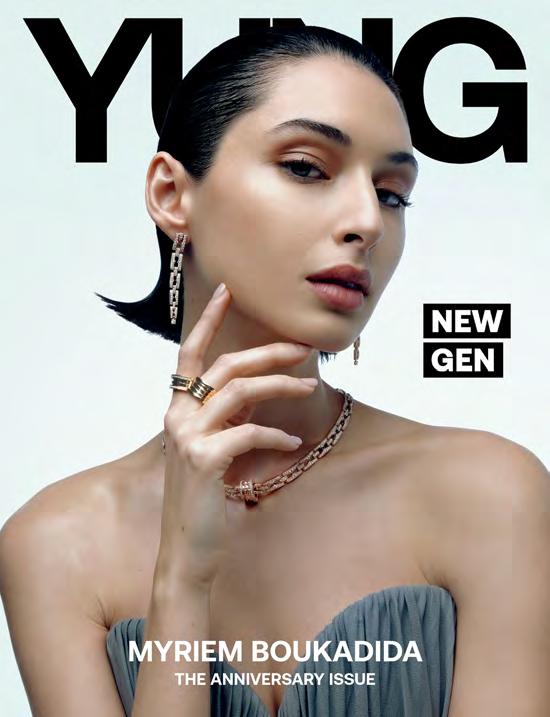
photography OTTO MASTERS styling NUJOUD OWEIS
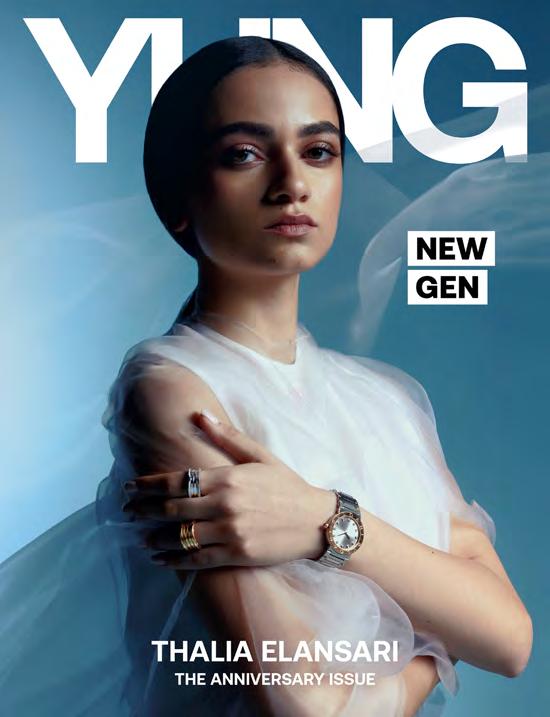
photography OTTO MASTERS styling NUJOUD OWEIS

photography OTTO MASTERS styling NUJOUD OWEIS

photography OTTO MASTERS styling NUJOUD OWEIS
THIS IS YUNG THE MOOD 18-19
words OMAIA JALLAD
SACKITEY TESA
Focus and Frame
Sackitey Tesa, a self-taught photographer and stylist from Sekondi-Takoradi in Ghana, brings a unique flair to visual storytelling. Armed with degrees in Business Administration and Marketing, Tesa began his photographic journey in 2017, exploring various genres before honing in on conceptual photography. His childhood fascination with his father’s vintage Pentax camera laid the foundation for his artistic passion. Now residing in Accra, Tesa collaborates with fellow creatives, and is eager to expand his portfolio and continue capturing compelling narratives through his lens.
How did playing with your father’s vintage Pentax camera at a young age shape your perception of photography, and which aspects of that experience continue to influence your work today?
With my dad’s Pentax camera in hand, I would look at objects through the viewfinder and bring it down to look at the same objects with my eyes and repeat this process. With the viewfinder I was able to focus on these objects by placing them in the camera frame and it was fascinating. Based on this experience I have developed a keen eye and an appreciation for good image composition.
Graduating with a degree in Business Administration, you initially set aside your passion for photography. What prompted you to rediscover and embrace it later in your journey?
My decision to pick up photography stems from my desire for self-expression and self-exploration. Photography allows me to articulate my thoughts, feelings, and experiences through visual imagery.
Growing up in Accra, how have the diverse landscapes and cultures of Ghana influenced the themes and subjects you choose to capture in your photography?
My work is heavily influenced by my experiences of growing up in Accra. Within my work I seek to explore how different objects and aspects of our lives can be reimagined. These are things I see every day; from the wares sold by street vendors to the traditions unique to the diverse ethnicities in Ghana. For example, in my long-term project on twins, I draw inspiration from twin beliefs and ceremonies to create contemporary images.
Can you share an experience or project that stands out to you, and how does collaboration enhance your artistic process?
I started a long-term project last year on twins and it’s been a wonderful experience. Before this project, most of my work has been single images that have their own unique storylines. I have been able to create a series of images that have a cohesive theme without compromising on my art style. In my opinion, collaboration is important for artists because it creates an opportunity for growth for all parties involved.
Your photographs have an interesting pop art element to them. Are there any artistic influences that guide that aesthetic? If so, what?
Yes, the pop art movement has indeed influenced my
aesthetic in photography, particularly in the use of bold colours, graphic elements, and a playful approach to subject matter. My artistic influences include David LaChapelle and Viviane Sassen.
As a multifaceted creative professional working as a creative director, stylist, and photographer, how do you ensure a seamless integration of these roles to bring forth a cohesive and visually compelling piece of art?
I try to plan out what I’m going to do for each project and draw on my skills in each role to make sure that the project is successful. I start each project by sketching out the idea. Using my skills as a photographer I consider the colours, framing and location that are best for the project. Using my styling skills, I source the props from town or create props if needed. On set I combine all my skill sets in order to complete the project in a holistic manner.
How do props play a significant role in your creative process, and what considerations or criteria guide your choices when selecting props to enhance the visual narrative of your projects?
Currently, props are vital in my creative process because they enhance the visual narrative in so many ways. They can create a particular mood or atmosphere, evoke emotions and memories. They also serve as symbols and metaphors within an image. I tend to research the symbolism of certain objects or props to make sure that I resonate with it before selecting it for a project. For example, in certain projects I used plain coloured suit jackets because, for me, it represents stiffness and conformity. The viewer may feel differently and that is the beauty of art.
Accra is known for its vibrant street scenes. Can you share a particular moment or event in the city that has profoundly inspired or influenced your recent photographic work?
One moment that profoundly influenced my recent photographic work was when I participated in The Chale Wote Street Art Festival, an annual street festival in Accra. As I wandered through the maze of art installations, I was captivated by the raw energy and authenticity of the works of different artists. The streets were bustling with activity as the artists set up their installations and the festival goers navigated the festival grounds in clothes of vibrant colours and textures that expressed their unique personality and creativity. This made me appreciate our unique Ghanaian culture and my own perspective of the world. ■
photography SUPPLIED BY TALENT THIS IS YUNG THE MOOD 20-21

OMAR GABR
Colourful Critique
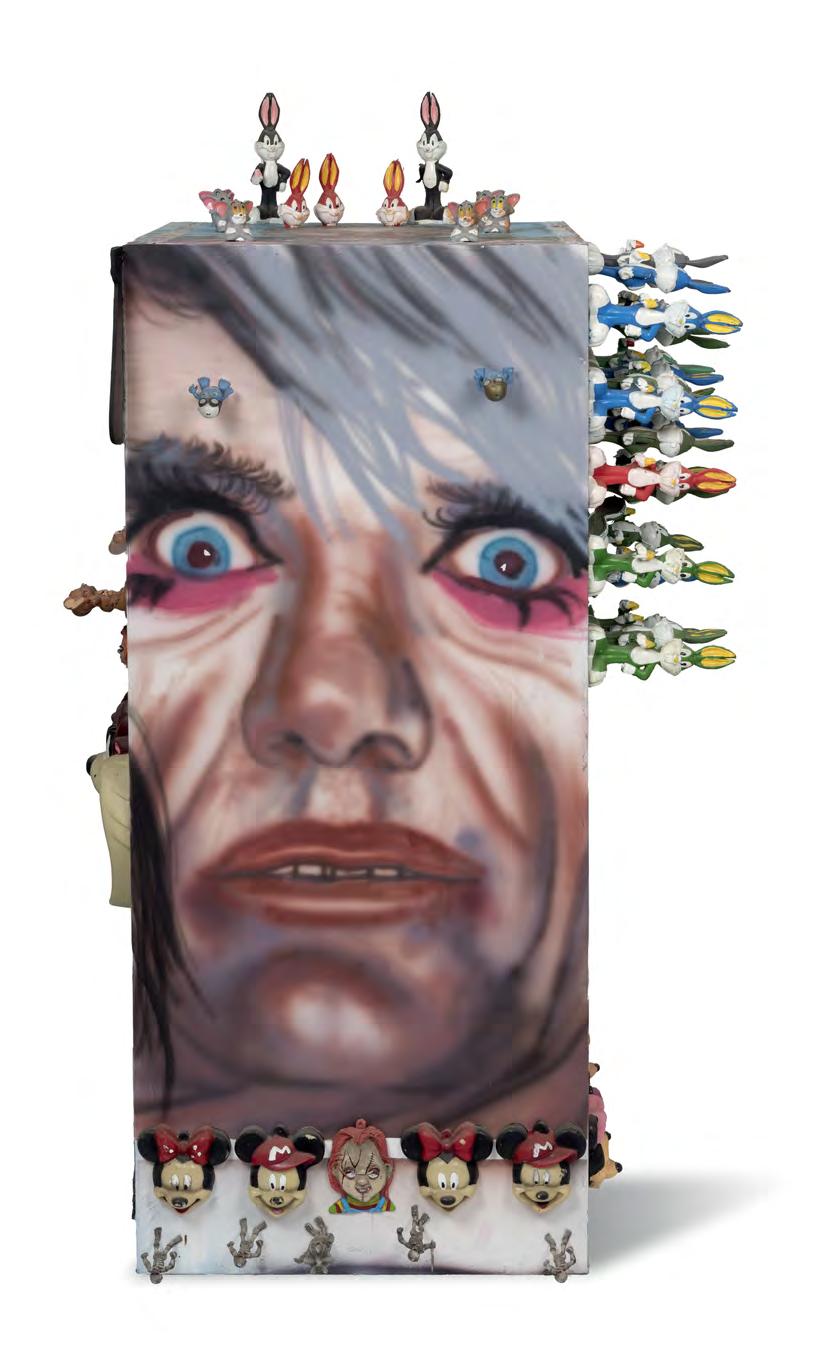
Omar Gabr, a self-taught artist from Cairo, Egypt, initially pursued a Diploma of Secondary Commerce but found his artistic calling when he joined the art collective “Al Laqta’’ in 2016. Gabr’s figureand portrait-based work, influenced by postrevolution Egypt and the digital age, often explores personal struggles, institutional negligence, and social commentary through playful and satirical brushstrokes. His art, attentive and critical, documents everyday life in Cairo with a contemporary visual language. Gabr’s colour palette, ranging from vibrant to tranquil hues, reflects the emotional depth of his subjects. Gabr’s work encapsulates powerful social narratives and a unique perspective on the human experience.
What is your earliest memory of the arts? And how did you decide to take this further?
I was admitted to the hospital at the age of 14, I had time on my hands and wanted to explore art on my own, then a friend of mine introduced me to the artist Mohamed Khedr who took me under his wing, and that’s where I began. I was a shy kid and art put me out there and made me feel outstanding and I wanted to take that further as it added value to my life.
As an artist from Cairo, how does the local art community, especially your involvement with the Al Lakta collective, influence and shape your artistic vision and techniques?
I was part of Al Lakta for a year from 2016 to 2017, they have taught me to practise art freely in a way that did not feel restrictive and that allowed me to be brave with exploring and experimenting with techniques and mediums. It has provided me with a balance of academic and free training as well. I think Cairo is very special as it is home to Egypt’s art scene, allowing me to meet a diversity of people and artists. When I meet these artists and talk about my practice and work and hear their feedback, to me this is education, it allows me to look into my work with perspective. My recent work clearly portrays the influence of my local environment, of where I live, and I think it speaks of my truth and voice.
What inspired the blend of humour and surrealism in your ‘Funny Effects’ series, and what interpretation or reaction do you hope viewers take away from this unique intersection in your artwork?
This series was influenced by observation of the art world that I was new to and looking into it in a comparison to where I came from. It is an embodiment of my learning experience entering the art world and dealing with collectors, who were intimidating to me.
THIS IS YUNG THE MOOD 22-23
photography by MENA ASSAD
I wanted people to treat it with humour and see it as it is, to only understand I was exploring this new world. I feel I failed with my expression and it is something I cannot control because people interpret art differently.
How do you maintain an academic approach and avoid repetition in your artistic journey, ensuring continual evolution in technique while preserving a consistent voice in your body of work?
Since I haven’t studied art academically, I did so freely. I believe that allowed me to have this balance between mastering my technique and at the same time exploring my personal voice and style. I am easily bored so I try to mix techniques and explore mediums constantly and switch between them, always keeping me excited about working and learning.
How do artistic censorship and educational limitations influence Gen Z artists, and what advice do you have for those facing similar challenges?
New kinds of art or different types are not as acceptable and respected, this is a big challenge when it comes to participating with public cultural entities in Cairo. I consider myself lucky to be part of the Ubuntu art gallery that has offered a space for my work to be explored freely.
Yet, I think it is important to allow yourself to be part of these public entities while ensuring you keep your voice and be true to your work. I would also advise artists to take care of their online presence as it has become a crucial means of exposure.
Can you share the creative process behind your distinctive combinations of tigers with human faces, shrimp bodies, and harmonised, disparate objects in your artworks?
It is also a humorous way of manipulating the human body and experimenting with different combinations. I like tigers, so I wanted to include them in my work. It is also influenced by the media and the progression of science and experimentation. I wanted to question, where would that lead us?
In the face of external pressures and challenges, you view them as catalysts for authentic expressions. Can you share a specific instance where adversity fueled your creativity and led to a powerful and meaningful artistic creation?
To me, artistic expression and sharing is a way of making myself feel better and get over hardships, that is consistent throughout my work. Each exhibition and work are a direct output of an instance or situation in my life and as I share this work, I choose how to display what I want to share with people, whether it’s personal or it’s a public matter that concerns me, or something that is hard to talk about openly in the community or the world in general.
If you could magically bring one of your artworks to life, which piece would it be, and what profound message or quirky statement do you think it would share with the world?
I would say it’s the painting of my brother, who passed away, as I would wish he could tell the story of my current exhibition “Rembrandt’s Brit Milah” from his point of view.

If you had the chance to collaborate with any artist, living or dead, who would it be and why?
Definitely Jean-Micheal Basquiat, because I feel a connection to his work and I see similarities between us and our work. I would’ve very much liked to be alive in his time. I am fascinated about how he passed away early in his peak, leaving such legacy behind.
Looking ahead, what themes or concepts are you excited to explore in your future artworks, and how do you envision your role as an artist evolving within the ever-changing artistic landscape?
I think I will continue to work on themes of life, death, and God, as art to me is a way to explore myself and I would like to keep doing this through art that I believe in. It is exhausting to be part of this changing scene; I think personally it pushes me to stay focused and to constantly improve myself. As those changes [within the art scene] may be political, for me to be able to express myself, I need to be aware of what is going on around me to avoid falling into influences of the world and its trends, and be true to myself and, by extension, to my art. ■

WALGZ
Rhythmic Mastery
Walgz, the burgeoning Sudanese rapper, seamlessly weaves together well-crafted lyrics and a unique blend of rugged yet sultry vocals, establishing a distinctive sound and style in just two years—a feat many artists take much longer to achieve. His hits, such as ‘Sasa’ and ‘7ako 7ako,’ and the Extended Play ‘Hollanda,’ have not only resonated with Sudanese fans but also garnered praise from audiences across the MENA region. From notable performances at Soundstorm to Cairo Jazz Club, Walgz’s rapid rise is a testament to his talent and unwavering dedication. Despite these achievements, he shows no signs of slowing down, promising exciting new music and collaborations in the coming year. Walgz is undeniably set for an even more remarkable journey ahead.
What is your earliest and most vivid memory associated with music? Was there a specific song, artist, or moment that ignited your passion for the art form, and how old were you at the time?
Looking back, my oldest and most vivid memory related to music traces back to when I was maybe 15. Hip-hop, in terms of sound and energy, drew me in from a young age. At the same time, I had an uncle, who was more like a big brother to me, and he was deeply into music. We spent a lot of time together and he introduced me to all these different artists including Blue Band, Craig David, Akon, and Chris Brown. I think it was in this period that my passion for music ignited. I had a taste and I wanted to go deeper.
How did you discover and develop your distinctive voice, and what role did experimentation play in finding your signature sound?
The journey to finding and honing my voice was actually a really enjoyable process. There was a lot of experimentation, exploration and learning curves. I wasn’t tied down to any particular sound or direction, so I could dip into different sonic worlds and experiment artistically with different music producers. That freedom also gave me the space to really discover a voice that felt real to me, one that could carry my words in a way that’s genuine and impactful to who I am today.
Can you share a memorable moment or performance that stands out to you, and how did those opportunities impact your growth as an artist?
There’s nothing like the rush and synergy of connecting with a crowd, sharing my tracks live, and feeling that energy bounce back. These moments of connection are what keep me going. It’s like fuel and motivation for my growth and development as an artist.
“Hollanda” seems to encapsulate years of hard work and dedication. What challenges did you face during the creation of this EP, and how did you overcome them?
Creating “Hollanda” came with its own set of challenges, notably my frequent transitions between countries. The instability of this time delayed the project’s progression. It was also difficult to find the right collaborators because of the personal significance “Hollanda” had for to me. The EP was a reflection of my voice and personality at that time, so it was hard to find voices that could share in that
experience. But, embracing those new environments ended up sparking inspiration, and having a solid crew like Seven Birds, with Khayat, 77, Switch, Xthedisertkid, and Baseline, really helped me navigate through those challenges to bring “Hollanda” to life.
Fans now associate certain rhythms with the “Walgz” sound. How does it feel to have such a significant impact on the industry, where others are inspired by your style? Knowing that people like my sound and that it’s making waves in the scene is an honour and a blessing. It’s a big responsibility, but also a big motivator to keep exploring and to push the boundaries of what I can do, especially for the Sudanese scene.
With your constant grind and preparation for new music, how do you balance staying true to your established sound while also pushing the boundaries and experimenting with fresh sounds and collaborations?
Staying true to my sound while introducing new concepts is all about picking the right collaborators. There is a certain synergy with producers who get how to blend the fresh with my more established sound. It keeps the journey exciting and ensures every new track stands out as something special, but also something still unmistakably me.
Can you take us through your songwriting process? How do you flawlessly combine intricate lyrics with a tough yet seductive delivery?
My songwriting process is deeply personal. It’s a reflection of my lived experiences. I focus on what’s real, letting life’s moments inspire my lyrics organically. It shapes the music and how I lay it down, making sure those who listen can feel what I felt, the emotions and stories behind them, not just the delivery.
If you could collaborate with any artist, living or from the past, who would it be, and what kind of track do you imagine creating together?
Definitely, Kanye West or Taha Suliman. They’re from two different worlds, but I see myself cooking up something that is as global as it is Sudanese, blurring the line of hip-hop to fit Sudanese culture. ■
THIS IS YUNG THE MOOD 24-25
photography by NAILA OSAMA

SARAH ASMAIL
Designing Worlds
Sarah Asmail stands out as a versatile and accomplished multidisciplinary production designer and set designer based in the vibrant creative landscape of London. Her expertise spans a diverse range of mediums, including moving images, photography, advertisements, music, and narrative projects. With a keen eye for detail and a unique artistic sensibility, Asmail consistently delivers captivating and visually stunning designs that elevate the overall aesthetic of her projects. Her ability to seamlessly navigate and contribute to various creative realms reflects a passion for pushing boundaries and creating immersive experiences across different forms of media. Asmail’s dynamic approach and innovative design solutions make her a sought-after talent in the ever-evolving world of visual arts and production design.
Can you take us through your journey into the world of production and set design?
My passion for creating and design started in my formative years, I pursued a degree in Interior Architecture, gained experience through internships and assistant roles, then things snowballed into something else and now, I’ve fallen in love with the industry, I’ve established myself as a set designer working across music, narrative, fashion commercial and live designs such as stage design and events.
How did you first discover your passion for shaping visual experiences?
Through my involvement in creating shoots and films with friends and assisting amazing set designers that I’ve learned so much from. Being behind the scenes and really seeing how much goes into every single job ignited my interest even further.
How do you approach planning; what are your first steps for planning and how do you turn that to tangible set designs?
For me, it starts with the creative, research, lots of sketching, creating something that we can make happen (within the budget given which is always hard!). I get inspiration from so many things, whether it’s an animal, the sky, a walk I went on, or art that has been stored in my head for years, or dreams. It’s also a big collaborative thing and bouncing ideas back and forth with the director. Creating CADs and renders and overseeing the fabrication. I have some amazing people that I trust and love working with, there are always so many more people involved than you think. Each prop and other design elements are thought out and carefully sourced and selected. The process always varies project to project and there is no one way to plan.
How do you select colours, textures, and spatial arrangements to evoke emotions in a set design? Can you share your process for refining these elements for a specific project?
Usually by researching emotional associations, and character building of our cast member, or the story we are trying to achieve, or if it’s a musician, it would be based on who they want to show themselves as, or based on their branding and what is personal to them. Through iterative refinement and consideration of feedback, we craft a cohesive set design that evokes the intended emotions for the specific project.
Your work spans different genres and industries. Is there a particular genre or project type that you find most personally fulfilling or challenging, and why?
That’s a hard question, I love creating and tapping into character building and really understanding the story we are trying to show and how it can be shown. I love narrative and it’s so thought out and personal. But it can also be so abstract and surreal, bringing something you created in your dreams to life. It’s something everyone can understand and relate to, its reality and fantasy.
In the rapidly evolving landscape of visual and creative industries, how do you stay inspired and keep your work fresh and innovative? Are there specific sources or practices that fuel your creativity?
By watching live performances, theatre, music shows, movies. Staying up to date with what is going on. Analysing sets from different eras and different movements. I like to get my inspiration also from architecture and surreal art. I also draw references from personal upbringing and culture.
Beyond the visual realm, are there any other art forms, such as literature, music, or dance, that inspire your creative process? How do you incorporate these influences into your designs?
For sure, I get inspiration from the evocative power of music, I translate its mood, tempo, and narrative into dynamic shapes, textures, and spatial arrangements in my head and that gives me new design ideas. Additionally, my fascination with clothing and fabrics informs the tactile qualities, patterns, and form and gives me ideas all the time for a way a window can be designed in a set, or a form of how a wall’s texture should be, et cetera. It helps me add layers of narrative depth and sensory richness.
If you could offer one piece of advice to aspiring production and set designers based on your experiences, what would it be?
Never stop learning about how videos, movies, shows are made. Watch behind the scenes of all your favourite videos and movies. Keep up to date with what’s being released and who is directing what, and who is shooting what and who is designing what. Make a list of people in the industry and email them! Stay curious, be adaptable and embrace every opportunity to learn and grow within the industry. ■
photography SUPPLIED BY TALENT THIS IS YUNG THE MOOD 26-27
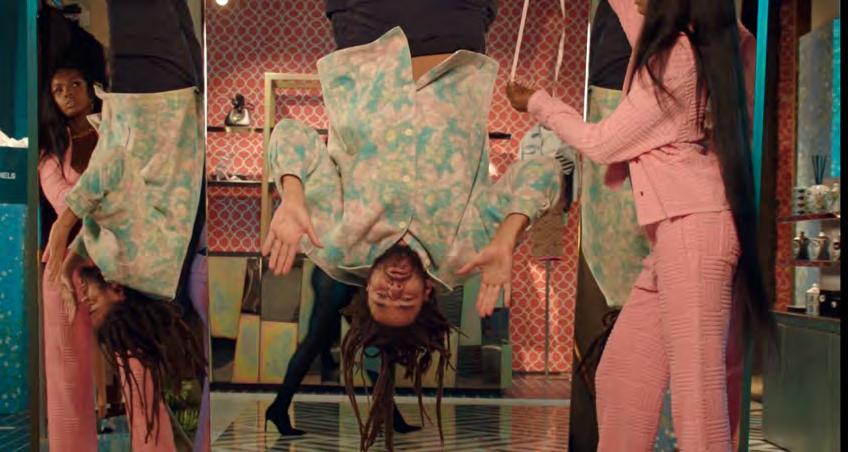
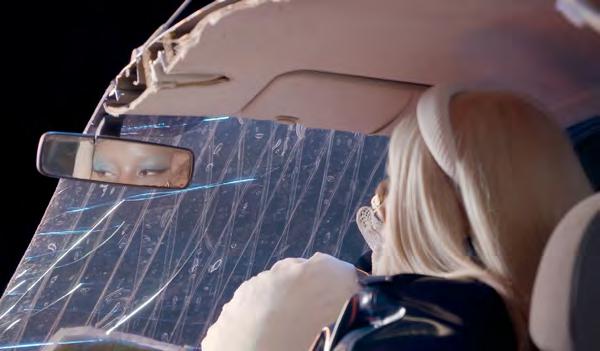

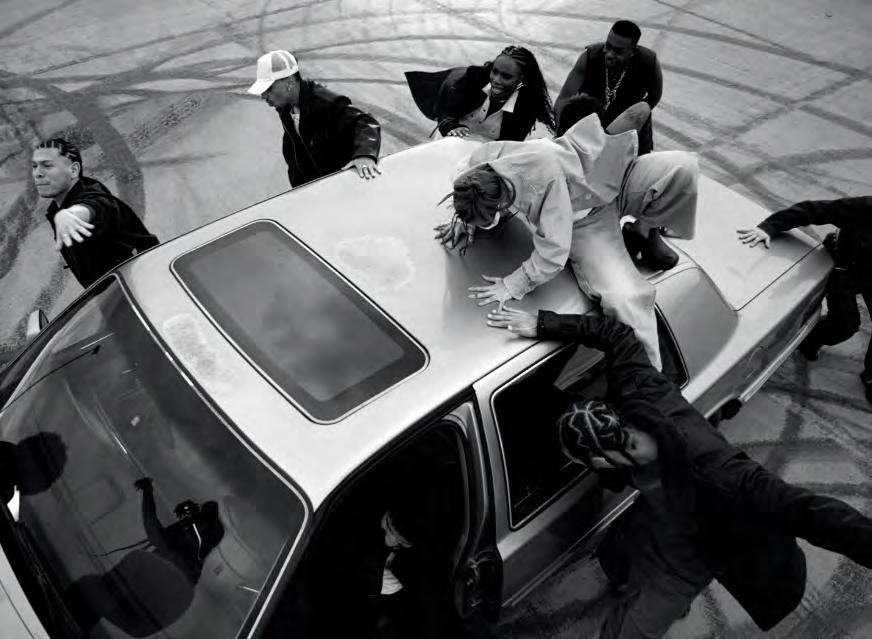
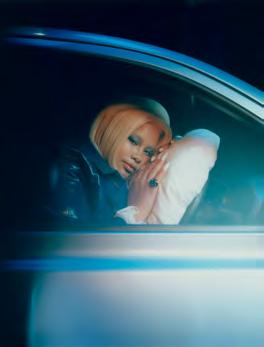

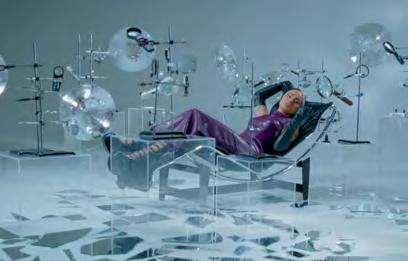
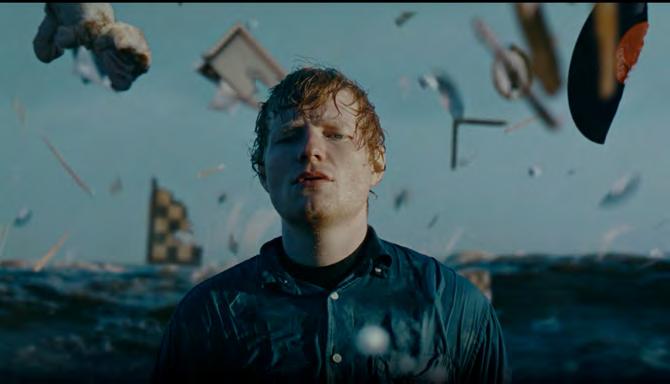

MATTEO EL KHODR

The Man With The Voice
Matteo El Khodr-Slimi, born in Beirut and of Greek heritage, embodies a multifaceted artistic spirit. As an opera countertenor, he explores the rare and enigmatic realm of male opera vocals. Beyond opera, he delves into acting, painting, and co-owns Nomades Home Art, a home decor gallery. Rooted in his upbringing amid art and culture, El KhodrSlimi’s journey began with mimicking cherished singers and Disney characters. Piano lessons nurtured his talent, leading to a contract with Universal Music France after a captivating performance in Beirut. A stint on Voice France was transformative, affirming his passion for music. Khodr-Slimi’s artistry resonates globally, bridging cultures through his emotive voice and eclectic repertoire.
You were drawn to the arts from a young age, from old black and white movies to classical music. Do you remember a moment that made you think, “Yep, this is what I want to do”?
This is true, I think I was born in the wrong era, or the other option is that I must have been reincarnated from a 19th century diva or a 1950 movie star from Cinecitta in Rome or Hollywood! I was completely fascinated by this vintage, beautiful world: From the architecture, to art, to furniture or movies or music, this was my world, too! I started playing piano and ballet lessons at age nine. Then singing a few years later, imitating voices like Maria Callas, Dalida in her early career with the Barclay years, or even Disney
THIS IS YUNG THE MOOD
28-29

princesses such as Aurora or Cinderella. It was not even a hobby, it was my life, and I couldn’t but think that this was my normal: No other job was an option.
Your parents seem super supportive, even getting you piano lessons. What’s the best piece of advice they gave you, and what would you say to parents who have kids with unique interests?
Indeed, my parents are maybe the most supportive parents in the world. They played a big role, if not the biggest, in my thriving life. They made me who I am and keep on believing in me and in every step or new adventure I dive into! The best piece of advice they gave me? “Always remember who you are, where you come from, and be true to your personality and your talent.” I am a genuine person. I really am!
You’re one of the rare countertenors in the world, and one of only ones in the Middle East. What’s the coolest or most challenging thing about having one of the rarest vocal ranges? How did you discover this talent? Being a countertenor goes directly with being a rare breed! I am one of the most famous ones in the Middle East, yes, because I was the first to introduce this voice to the region! Let’s say that since then, a thriving baroque scene is emerging and we can hear new countertenors in the area and I am delighted!
The most challenging thing is to always be avant gardiste and to always reinvent yourself. Being a countertenor does not stop with only doing baroque concerts, but nowadays, we have to explore new horizons, the risks, always meet the needs and taste of your audience and most of all: Shock them with new things! Dazzle them!
What’s a piece you’ve performed that you feel only you could bring justice to, given your unique vocal range?
Let’s say that I will never compare myself to Fayrouz, nor anyone, but my rendition of ‘Aatini Al Nay wa ghanni’ is one of the most exquisite versions ever recorded of this legendary piece: Being the first countertenor in the world to do it in this vocal range? That was a challenge!
So, you were just 18 when you signed with Universal Music France. How did that opportunity come about, and what were your initial thoughts and feelings when it happened? Can you recall the first song you recorded under them and what it meant to you?
Yes! I was the only one with Yasmine Hamdan to have signed with Universal at that time! The opportunity came by itself when I was singing for my mum’s birthday in a restaurant in Beirut and people suggested that I record a demo. A month later a contract was handed to me by this big production house and the decision has been made: I was moving to Paris where I found my hobby turning into a career!
The first song was COLD GENIUS! You can find it on Youtube, the music video is quite intense! :)
Your time on The Voice France sounded like an emotional rollercoaster. How did you prep for that blind audition, and how was it different from your usual gigs? My God! I will never forget that moment! I represented Lebanon in The Voice France in 2020. I was expecting one of the jury to turn of course, my voice is not a common one, but to see the four of them turn? It was out of this
world. My country was passing through turmoil and horrible times between the economic collapse, the revolution, and I believed I did mine on the stage of The Voice, my country needed me, all Lebanese people needed this moment to feel proud again! And I am happy they did.
I sang one of the hardest pieces ever: Sung beautifully by Maria Callas, the piece “Ebben, Ne android Lontana” for La Wally by Catalani was not a piece of cake. The preparation was very intense and a rollercoaster of fear, adrenaline and stress! It’s a soprano’s aria that a countertenor is singing! Can you imagine?
Besides being an opera singer, you’re also an actor, a painter, and the owner of an art gallery. How do these different artistic avenues and roles intersect and influence your work as a countertenor?
For me, being an artist is a full time job. And an artist cannot be put in one case or drawer. I have always been multidisciplinary, but for 15 years I have let my voice be the leader in my career. After Covid, when I couldn’t sing any more, all my concerts and contracts were canceled, I needed to be creative or else I would fall into a void of depression: Painting made a comeback! And here I am!
You’ve mentioned that your inspirations come from your travels, the people you meet, and the experiences you live. Can you share a recent experience that has inspired your current or upcoming work?
Of course, and I believe in it! In February I was invited by Fondation Boghossian in Brussels to do a two-month art residency. I was panicking and looking for inspiration and as soon as I landed in Brussels and settled in: Beirut started to be on my mind, a lot. I was missing home. I decided to paint a collection: A tribute to the city I miss and love. And my models were not photographs: It was how I remember Beirut when I am far from it!
You were recently involved in an Arabic adaptation of “Chicago.” How did you prepare for this role, and what challenges did you face in adapting such an iconic play to a different language and culture? Chicago was a big surprise lately! The role of Mary Sunshine was offered to me because it needs a countertenor to sing it. But the cast of Chicago, and the producers, took Chicago in Arabic to the next level: We created icons! From the biggest role to the tiniest, this version of the most played and famous musical of all time is maybe one of the most successful worldwide, and I am so proud to play the role of Nour El Shams, the transvestite journalist, fabulous, hilarious and iconic! The challenges were huge: The translation, to be able to adapt the situation from the city of Chicago to Beirut, with Lebanese inside jokes, with gorgeous big Lebanese hair and fabulous make up (talking about my character!) and WE DID IT!
What’s next?
My God! There are always MANY nexts! I cannot even fit them in this paragraph! Let’s start with a big tour with Chicago the Musical in the Gulf and Arab countries, my first solo exhibition, soon in February, and maybe a movie? Fingers crossed: Matteo is always full of surprises! Lately people discovered in the newspaper that I am an excellent chef! [Laughs!] ■
photography SUPPLIED BY TALENT
SHADEN SAFIEDDINE TAZI
Cinematic Brilliance
Shaden Safieddine Tazi is a Lebanese-Moroccan director, model, and creative. From her childhood fascination with storytelling to her deep-rooted connection to cinema, Safieddine Tazi’s profound inspirations fuel her creative expression. As the co-founder of The Soho Film Club, she cultivates a vibrant community for film enthusiasts to explore and discuss independent cinema. Through her filmmaking and editing endeavours, Safieddine Tazi navigates the realms of fiction and documentary, embracing the essence of storytelling with authenticity and depth.
How did you first embark on your journey into filmmaking?
I’ve always been an observer of people, time and movement. I grew up writing down the sentences and observations that struck me, and imagining the world that would emerge from them. In that sense, cinema has always felt like the most natural medium I could express myself with. I’ve always been drawn to artists who had their own universes, like Tim Burton, Fellini or even Kid Cudi, and spent my teenage years in Morocco immersing myself in these. I try to think of filmmaking as the expression of my own universe, a collection of everything that’s moving me. In that sense I consider cinema to be the strongest relationship I have with myself and the world. I still have a lot to learn and nurture.
My journey into filmmaking began with a deep-seated fascination for the interplay of people, time, and movement, which is in essence, what cinema is about. Making up stories in my mind is kind of a second nature, for better or worse, and it soon became clear that cinema was the most natural medium to express myself. I’ve always been inspired by artists who were able to make people enter their own universe and I can spend days immersed in their worlds. I see filmmaking as the expression of my own universe, a mosaic of influences that shaped me and the way I see the world. I still have a lot to learn and explore, but I consider cinema to be the most beautiful relationship I have with myself and the world, so I’m not in a rush.
As the founder of The Soho Film Club, what motivated you to establish the club, and what role do you see it playing in the film community?
I joined the film club at my highschool in Casablanca when I was 15 years old and felt intimidated by the cinephiles around me, throwing the big Italian and Russian names here and there. I was often too shy to ask questions and felt so stupid each time I found the courage to raise my hand, and of course ending up mispronouncing the name of every major film director. But when I studied Film at university, the environment was way more mature and discussions were such a fun and enriching part of the moviewatching experience.
When I graduated, I found myself watching mind-blowing films alone on my laptop or at the movie theatre alone, and really missed having a community to discuss film with. So very naturally I gathered a couple of friends who brought their own friends and
started a film club, a safe and chill space for everyone to discover, explore and discuss films and independent movie theatres together. The Soho Film Club was New York-based and since I moved to Paris, I’m now working on expanding it here.
Can you highlight a project or film that you’re particularly proud of, and share the inspiration behind it?
“Un jour tout va disparaitre” (Everything will disappear) is definitely the work I’m proudest of, my first short film and most personal work. It’s a 17-minute short film that revolves around Amira, a 21-year-old who returns to her hometown in Marrakech after years of absence and must reunite with her Alzheimer’s-diagnosed grandfather before it’s too late. I started writing this film when Morocco closed its borders during the pandemic, and I was away from home.
I fictionalised my biggest fear, which was to be forgotten by my grandfather as his health was declining. Making this film made me understand the magic of cinema even more, the process of going from the very solitary and individual process of screenwriting to becoming a human adventure, backed by a wonderful cast and crew that trusted me based on words written on paper. I’m so grateful to everyone who was involved in this project. Postproduction is done and the film is now off to the festival circuit, fingers crossed!
How have your experiences as a Lebanese-Moroccan artist in the film industry shaped your views on diversity and representation?
As a Moroccan-Lebanese artist deeply connected to both cultures, I’ve always appreciated the richness and complexities of the Arab World. But it’s fascinating to observe the ironic dichotomy at play: While the western world often perceives us as a homogeneous entity, we, in turn, sometimes lean towards nationalism, focusing more on our differences than our commonalities. In my work, I enjoy building bridges between Morocco and Lebanon, not as activism but simply as the reflection of my cultural heritage. For example, in my short film “Everything Will Disappear,” the soundtrack features Roger Fakhr’s voice, a prominent Lebanese artist, set against the backdrop of Moroccan landscapes. In that sense, I don’t try to consciously push forward diversity but it’s simply the natural reflection of my own background and education. ■
photography SUPPLIED BY TALENT THIS IS YUNG THE MOOD 30-31

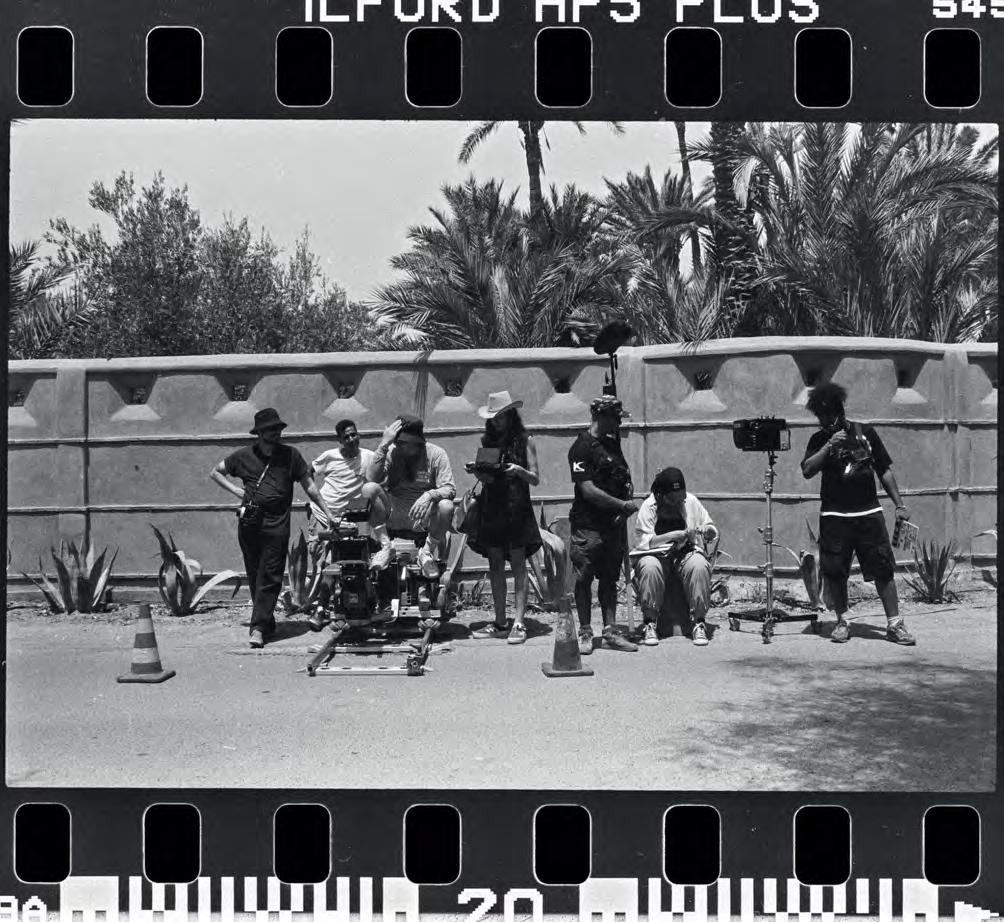
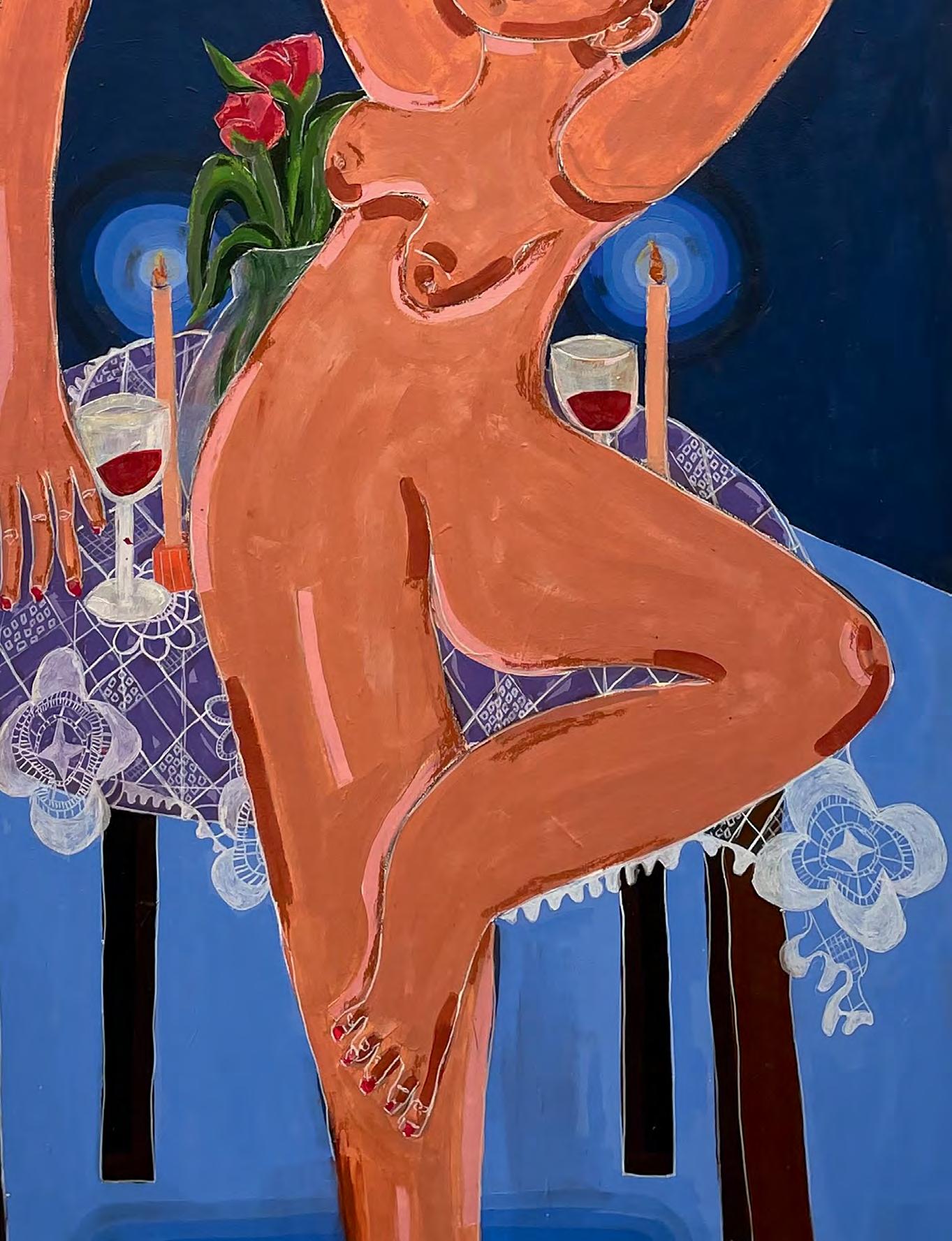

THIS IS YUNG THE MOOD 32-33
MAYS AL MOOSAWI
Unveiling Narratives
Omani artist Mays Al Moosawi views her art as a medium for sharing untold stories and expressing concealed emotions, fostering solidarity rather than engaging in battles. Having embarked on her artistic journey at a young age, Al Moosawi has carved a distinctive path by profoundly exploring the female figure, which serves as her signature subject. Through her work, she offers a unique perspective on gender dynamics and societal narratives, using the female experience as a central theme to challenge stereotypes and contribute to a more nuanced understanding. Her art becomes a platform for personal and collective storytelling, encouraging empathy and connection among viewers who resonate with her narratives.
Your artistic journey began at a young age and has led you to pursue a Bachelor of Arts in Illustration. Can you share a pivotal moment or experience that ignited your passion for visual art?
My journey into art was more of a gradual process. Being raised in a family of artists meant that creativity was a constant presence in my life. With my mum and aunts all being artists, I was immersed in an environment where art was just a part of everyday life. Over time, this immersion shaped my own artistic sensibilities—it almost felt like art seeped into me naturally.
Why did you choose to focus on the female figure in your art, and how do you represent the stories and challenges faced by women in your community?
I never consciously chose to focus on the female figure in my art. Initially, my creative journey led me to sketch various subjects, from animals to animations and everything in between. However, during a life drawing class at university, I found myself particularly drawn to capturing the human form. It resonated with me in a way that other subjects hadn’t, and I soon began to incorporate what I learned from that class into evolving my figures in my artwork. This shift allowed me to explore and convey the stories and challenges faced by women in my community with greater depth and authenticity. Drawing inspiration from personal experiences, conversations, and observations, I strive to authentically capture the complexities of women’s lives, shedding light on their struggles and moments of resilience and joy.
Your work is known for its spontaneity and is often driven by emotional states. Can you walk us through your creative process?
How do you channel your emotions into the creation of your art?
I find inspiration in the simple moments of everyday life, like washing my hair or sharing conversations with loved ones. These seemingly mundane experiences often stir emotions and ideas that find their way into my artwork, adding layers of depth and authenticity. I feel like planning an artwork takes away the soul of the process, it doesn’t make it pure. So what I do is I would have an idea and go sketch it or go directly to the canvas and start working. This spontaneous approach allows me to stay true to the emotions and impulses that drive my creativity, resulting in art that feels raw and genuine.
As an artist amplifying women’s voices, have you encountered any personal challenges or moments of empowerment in your own journey that significantly influenced your perspective on
women’s experiences?
I’m keenly aware of the immense responsibility that comes with representing or speaking for other women in my community or family. While I may not have experienced exactly what they have, I can empathise and relate to their emotions and struggles on a human level. At the core of it all, there are universal aspects of the human experience—love, joy, loss, and struggle—that connect us all. I aim to create art that resonates with a wide audience by focusing on these shared experiences. My approach reflects a deep understanding and respect for the diversity of human experiences, emphasising empathy and integrity as an artist.
Can you share an artwork that holds a special place in your heart or has a particularly meaningful backstory?
‘She’s flower and fire’, as it was the first painting I did after moving to London. In my previous works, I often depicted women in comfortable and uncomfortable situations. However, with this piece there’s a shift. While you can still sense some discomfort in her expression, the overall feeling is one of freedom.
As an Omani artist, how do you find that your cultural background influences your artistic choices and themes? Are there elements of Omani culture that consistently find their way into your art?
As an artist hailing from both Oman and Iraq, my diverse heritage is a profound wellspring of inspiration. While deeply influenced by my cultural roots, I intricately weave their essence into my art, allowing elements to organically emerge from my subconscious. This process imbues my creations with unparalleled depth and personal significance.
If your art studio could magically transport to any location in the world for a day, where would you choose, and how do you think the change in environment would affect your creative output?
I’ve experienced a similar transformative effect recently when I moved from Oman to London. This change opened my mind to new perspectives and a greater sense of acceptance, which has had a profound impact on my work. I strongly believe that change is essential for an artist’s development and growth. But right now I’m longing for the warmth of the sea. Creating by the sea in 30-degree weather would be the ultimate dream for me right now—just being there in a little ceramic studio. ■
photography SUPPLIED BY TALENT
MAITHA ABDALLA
Vulnerable Beauty
Maitha Abdalla is a versatile artist from the UAE whose practice encompasses film, photography, sculpture, painting, drawing, and performance. Abdalla utilises the theatrical and constructed elements of performance to explore a variety of themes, including folklore, mythology, gender dynamics, social conditioning, and psychology. Through her art, she confronts and challenges aspects of her social environment, memories, and fantasies from an objective standpoint. Her imaginative scenes oscillate between abstraction and representation, charged with both drama and melancholy. Abdalla’s work represents an ongoing exploration of the self, often manifesting in characters constrained within intimate domestic spaces, revealing their vulnerability.
Take us through your creative process from concept to final work.
The driving force behind my art is always the concept, yet there are certain elements that remain constant. One such element is the theatrical stage, which serves as a foundational motif in my work. Whether manifested directly on canvas, through film, or in bronze sculptural pieces in conversation with other mediums, I consistently construct scenes that reference theatricality.
My inspiration is fluid and ever-evolving. It may stem from a dream, a memory, or an internal conflict that I seek to resolve through my art. Sometimes, it emerges from a recurring icon or idea that captivates my mind. For instance, in a recent body of work, I found myself drawn to the concept of the dark forest and the idea of an endless journey. These themes persisted in my thoughts and ultimately materialised in my art, reflecting my ongoing exploration of narrative and symbolism.
Your work delves into themes ranging from folklore to gender and psychology. How do these themes manifest in your art, and what draws you to explore them?
My fascination with folklore and mythology traces back to my childhood, when I was captivated by the tales passed down to me by family members, particularly my grandmother. In Emirati culture, these narratives are often transmitted orally from one generation to the next, offering connections across age groups.
As I grew older, my interest in folklore expanded beyond the local context to encompass global explorations. What intrigues me most about these tales are the intricate constructions of morality—how they delineate concepts of right and wrong, sin and purity. Through these narratives, we shape our perceptions of ourselves and our behaviour, yet I’m fascinated by how these notions, seemingly fixed, can vary significantly based on context and societal values.
Can you discuss a specific piece or project that holds particular significance to you, and share the inspiration behind it?
My video performance Too Close To The Sun from 2021, explored the untamed essence of women, a quality often suppressed by societal pressures. Inspired by the ideas of American psychoanalyst Clarissa Pinkola Estes, who emphasised the innate wildness within every woman, I delved into the concept of a primal force within, brimming with instinct, creativity, and timeless wisdom. Estes’ term “Wild Woman,” suggests the woman is a powerful yet endangered entity, a notion that I connected to. I aligned with Estes’ vision, highlighting the struggle to preserve and celebrate the untamed spirit of womanhood.
How does your hands-on painting technique, using fingertips and gestural smears of charcoal, contribute to the intimacy and narrative in your art?
It blurs the boundary between the self and the work, merging the body with the backdrop. For me, there’s a palpable energy transfer during this process, allowing me to forge a deeper, more intimate connection with the artwork. This intimate engagement contributes to compositions that encapsulate my emotional state in that particular moment, infusing the work with personal resonance.
How does your Emirati background influence your artistic expression, shaping themes and stories in your artwork? Like many artists, my early works were influenced by my context and surroundings, in my case this was the folklore and memories that characterised my youth. However, as I’ve grown older, travelled, and engaged with diverse people and places, my artistic perspective has evolved and expanded, it’s an ongoing process. My experiences and encounters have subsequently broadened my artistic concerns.
If you could have dinner with one artist, alive or deceased, who has inspired your work, who would it be?
Francis Bacon or Paula Rego.
What one word would you choose to sum up your artistic journey?
Role play. ■
THIS IS YUNG THE MOOD 34-35
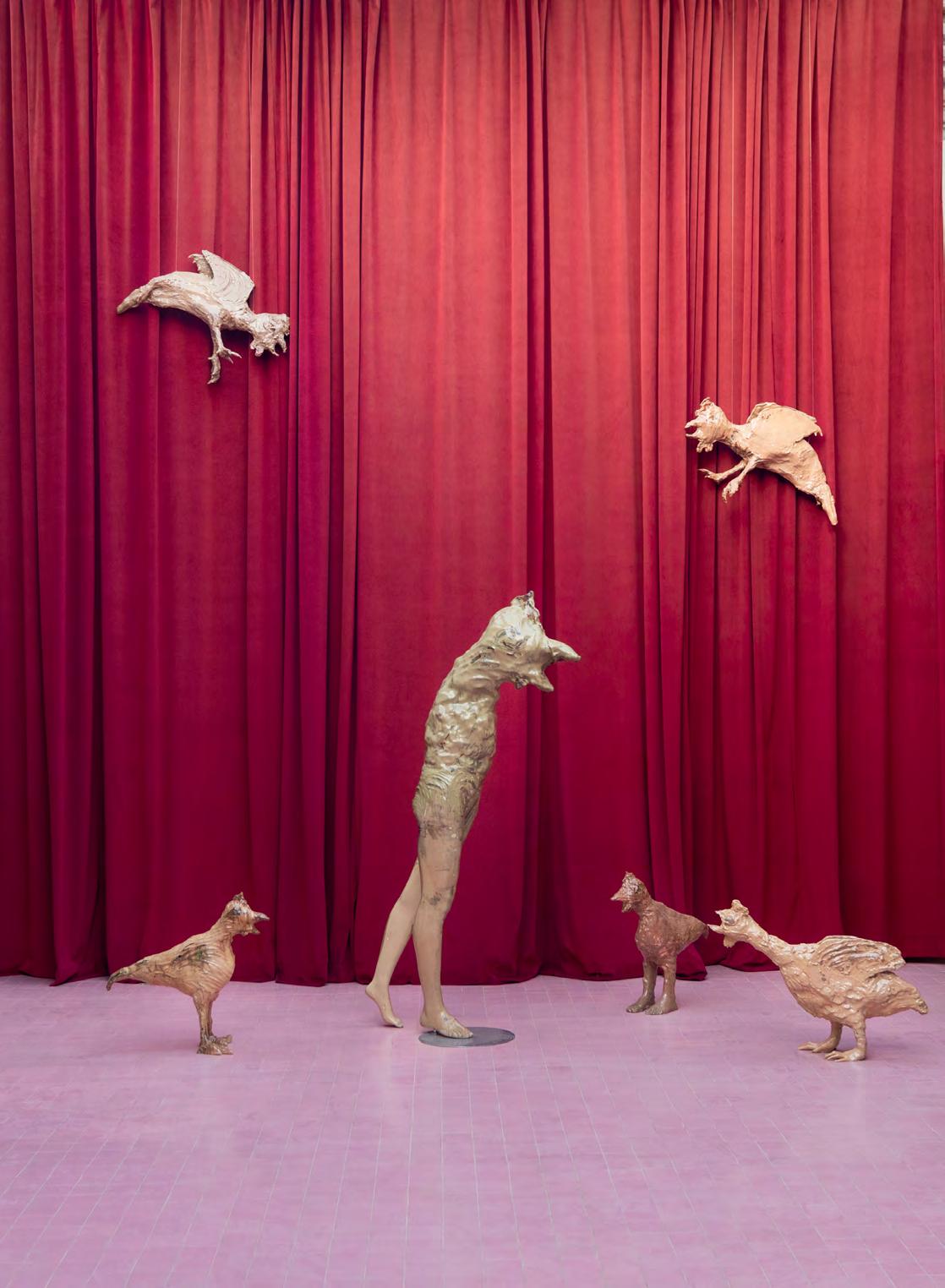
photography SUPPLIED BY TALENT
TAREK ELKASSOUF
Stone and Gold
As an artist, Tarek Elkassouf deftly navigates the realms of balance, loss, and cultural identity through his craft. From his childhood fascination with textures to the pivotal moment that ignited his passion for sculpture, Elkassouf shares the twists and turns of his artistic journey. Drawing inspiration from Beirut’s poignant narratives, he articulates the unseen through light and shadow, inviting viewers to partake in a shared emotional landscape. Through collaborations with iconic brands like Cartier, Elkassouf bridges tradition with innovation, crafting pieces that echo the sacred language of stone and gold.
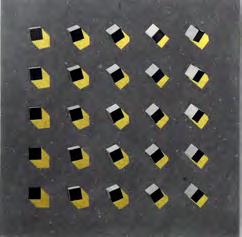

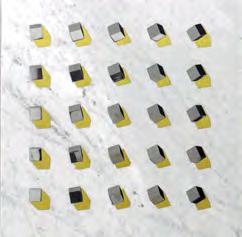

As you reflect on your artistic journey, could you share the pivotal moment or inspiration that led you to embark on this path into the world of arts?
As a child, I would walk in town always touching the stone. Feeling the texture. Fascinated by how things were built. At 12 years old I knew I wanted to be a sculptor. So I journeyed through life studying, learning, and practising: Architecture, design, and urban planning. However, I gave that all away to return to the heart of my 12-year-old self, who knew so clearly, so absolutely what he wanted.
Your art delves into the concept of balance after loss, exploring the invisible and the exchange between empty and full. How did you discover this approach or theme?
It all started with Beirut’s tragic descent into absurdity in 2020. Trying to find balance was needed to process personal and collective traumas, and to try to seek healing. This offered me the gift of exploring the rich amalgam of human emotions, while often invisible, it united me with others in a shared journey of life.
Traditional craftsmanship plays a significant role in your art. How do you blend centuries-old techniques from Southwest Asia with contemporary ideas, and what challenges or rewards do you find in this fusion of tradition and modernity?
My art is also about the dialogue between the sound of the machine and the contemplative silence of the man. The balance between how we are sculpting and how we are creating. I identify as a sculptor with a thousand hands. I like to celebrate the hands that worked.
I always seek to understand the stories and wisdom encoded in the expressive gestures of the hands. The untold stories, the unexpressed feelings, the unseen efforts.
How do you manifest the unseen in your artwork, and what role does the viewer’s interpretation play in bringing the invisible to life within your creations?
I manifest the unseen in my work by focusing on the interplay between light and shadow, presence and absence, and the balance between different energies.
There is an invitation for the viewer to interpret my work by creating a bridge that makes the unseen into a visible and tangible experience. An interpretation that involves the viewer’s imagination, personal history and the emotional landscape that was intentionally left to be filled in the work. The viewers will engage with the unseen and try to bring it to the light.
And this is when the audience becomes the artist.
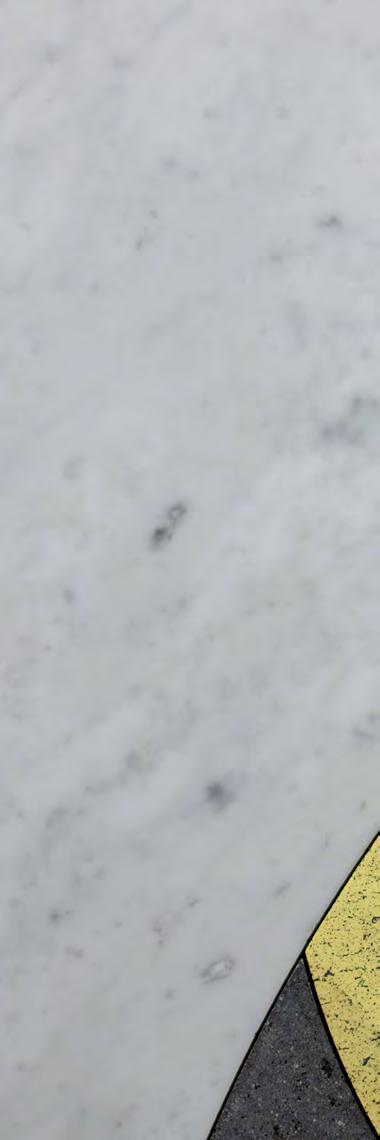
THIS IS YUNG THE MOOD 36-37
How do you draw from your Lebanese-Australian background, and the cultural and geographical influences around you, to infuse your work with a sense of identity and universality?
My journey across cultures speaks to the universal search for meaning and place in the world. The contrast between the layers of cultural and historical complexities and instabilities found in Lebanon and the vast landscapes with a backdrop of stability in Australia, enriches my understanding of home and identity. My work is a constant invitation to reflect on the common threads that bind humanity.
Working in the UAE, a place that embodies a unique blend of tradition and modernity, how has the local environment influenced your artistic perspective and the themes you explore in your work?
Working at a global crossroads for ideas and cultures offers me to engage with a diverse range of perspectives and an opportunity to write a new narrative. A narrative that will be shaped by the hands of Arab artists themselves, in stories exploring regional identities in a global context.
During my time in the UAE, I will be seeking to understand how our cultural heritage can be maintained and adapted in the face of change. Perhaps by looking at personal and collective stories that are rooted in authenticity and selfrepresentation that might redefine the cultural landscape.
Precision is a key element in your craftsmanship. Can you walk us through your creative process, particularly the meticulous techniques you employ to convey your thoughts and emotions?
The creative journey begins with writing, a practice that allows me to explore the conceptual framework of my work. I later transition to drawing where I start exploring the physical manifestation of my ideas. Sculpting represents the culmination of my creative journey where I can touch my thoughts, through precision.
Of the many brands you’ve collaborated with, which presented the most significant challenges, and how did you navigate those obstacles to achieve a successful collaboration?
My most successful collaboration to date was with Cartier. The main challenge was to maintain a clear and distinct voice while engaging with the brand’s iconic legacy. This was overcome through an open conversation and shared commitment to innovation, crafting pieces that create a dialogue. I was able to share with people how I see beauty in details, in the small things in life. That we don’t pay attention to.
If your art studio had a soundtrack, what three songs would be on it, and how do they encapsulate the creative energy of your workspace?
That’s probably the hardest question so far, each day has its own story, each chapter has a different soundtrack. Starting my writing with ‘Le Pas du Chat Noir’ that is composed by Anouar Brahem, it infuses my writing with a sense of serenity. It has a contemplative and an introspective soundscape. As I move to the drawing stage with Flavien Berger, ‘Gravité’ shifts me into new territories without fear. An exploratory and poetic journey. When I begin to sculpt, Fairuz brings a sense of purpose through her ‘Beiteddine Opening’ of the year 2000. But my favourite soundtrack will be for the chapter that I didn’t write yet. ■

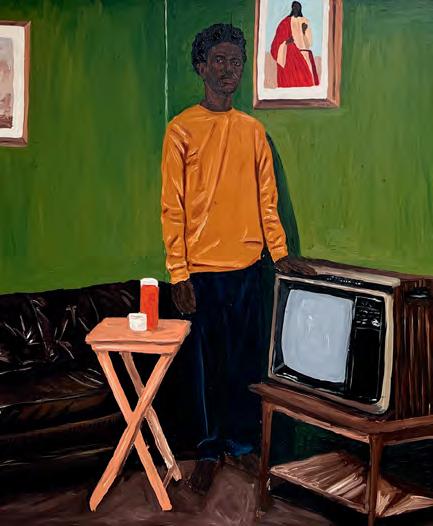

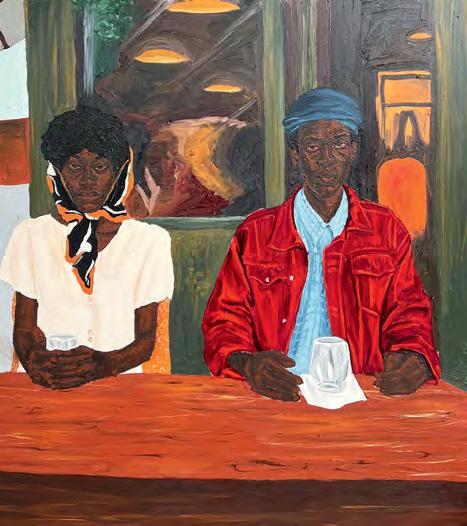



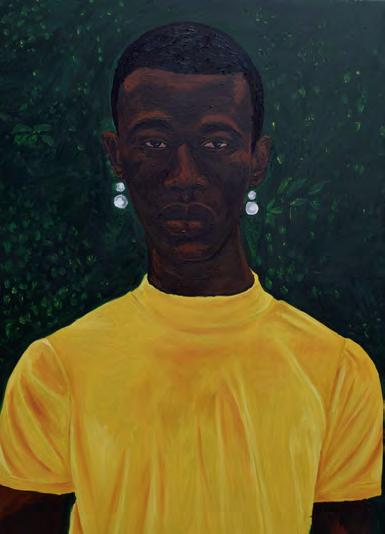

THIS IS YUNG THE MOOD 38-39
MATTHEW EGUAVOEN
A Change in Values
Matthew Eguavoen, born in 1988 in Edo State, Nigeria, is a contemporary artist based in Lagos. Despite earning a civil engineering degree from the University of Port Harcourt, he discovered his passion for art during his final year. Now a full-time painter, Eguavoen employs oil and acrylic paints, charcoal, and graphite pencils to portray figurative and portrait subjects. His works delve into societal, economic, and political themes, exploring the complexities of Nigerian life. Eguavoen’s art highlights the impact of slavery, the erosion of traditional African values, and the influence of Western culture. His pieces adorn collections across West Africa, the USA, Europe, and North America.
What inspired your shift from civil engineering to art during your final year at university, and how has your engineering background shaped your artistic perspective?
I really did not see myself working a white-collar job, throughout my studies I had anxiety of what I would do with my life after graduation, so when I started art in my final year, I just knew it was my way out and paid more attention to it.
How do you choose and utilise various mediums like oil and acrylic paints, charcoal, and graphite pencils in your work to convey emotions in different pieces?
When I start a new painting, I usually begin the sketch with either charcoal or graphite pencil, afterwards I stain the canvas, work out the background and clothes with oil, then lastly, I work on the skin of my models with acrylics
Your paintings delve into the emotions and societal complexities of your subjects. Can you walk us through your creative process, from the initial concept to the final brushstroke, and how you capture the essence of human experiences?
I use my works to address issues in my country and in Africa at large, so when there are issues I want to draw attention to, I put together a photoshoot session with my friends sometimes, and try to create an emotional response to the issue via the demeanour of the models, after that is done, I use those images as reference for my paintings. Most of the time these are issues that directly affect the models themselves so it is easier to convey those emotions, directly or indirectly.
How do you convey societal, political, and economic imbalances faced by Nigerians in your art, and what impact do you aim for in shaping viewers’ perceptions of these challenges?
Art is my way of speaking up, it is my voice. When I create a painting, my aim is to ensure it conveys a message, from just looking at the painting, to the title of the painting and its description, you cannot miss it. I am from Nigeria and I live in Nigeria, I see these issues first hand, they are part of my experiences, So, when I create these works, it is me sharing my side of the story as an artist from Africa.
Being based in Lagos, how does the cultural and artistic landscape of Nigeria influence your work, and are there specific aspects of Nigerian society that consistently find their way into your paintings?
Lagos is mostly a chaotic place, if you go out on a daily basis, you are definitely coming back home swamped with stress from either work, traffic or just from leaving your house. It is this stress you can see on the faces of my models in most of my works. Amidst the chaos, Lagos is also a beautiful place, I show that with the colour in my work.
What role do you believe art plays in sparking conversations or fostering change in society, particularly in the context of Nigeria? Art provides another way of portraying feelings, ideas and arguments to an audience, especially politically, it is also a way or medium to appreciate life’s beauty amidst all the ugliness the government has plunged the country into recently.
Your paintings have been collected across West Africa, the USA, Europe, and North America. How does it feel to see your art resonate globally, and what do you think draws people from different parts of the world to your work?
I see my work as a message in an envelope shipped across the world, so when they find their way to a different continent, It makes me happy, because it means my message has been successfully delivered. I put a lot of time into creating them and they all have a piece of me in them, so when it is appreciated, It means I am appreciated and I think it is because of this, being able to connect with my works that draws people in.
Music often sets the mood in creative spaces. What kind of music do you listen to while painting, and do you find it influences the tone of your work?
I usually listen to R&B/Soul music, they help me think better.
If you were to collaborate with a musician or band to create an artinspired album cover, who would be your dream collaborator, and what kind of visual style would you envision for their music?
Kanye West, it would be a cover that expresses self-confidence.
If you could encapsulate the essence of your artistic journey in a single sentence, what would it be, and what legacy do you hope to leave through your work?
The ability to use my art as a voice, to inspire critical thinking and be able to connect with people. I want my works to still be relevant 50 years from now, also being able to use my works to spark conversations that would lead to solutions to human challenges, that keeps me going. ■
photography
by ABIFOLA OLORUNLANA
AYA HAIDAR
Cultural Echoes
Aya Haidar’s artistic journey is deeply rooted in her Lebanese heritage and the complex history of the Middle East, which significantly influences her multimedia practice. Although based in London, where she was raised, Haidar’s work delves into poignant inquiries surrounding memory, loss, migration, and language. By reexamining existing objects and offering alternative interpretations, she endeavours to present fresh narratives that contribute to broader discussions on remembrance, shared stories, and identity.
Can you share with us how your journey as an artist began?
I don’t think there was a starting point, per say. It’s always been innate. The only way I ever functioned. This way of processing the world around me into a visual language by making something using my hands and offering new perspectives.
Your emphasis on the limitations of visual language in fine art is intriguing. How do these constraints influence your creative process?
I think language in general is extremely powerful. Be it through words or conveyed in images. I work a lot with memory and I am interested in the selectivity of this. The details we choose to remember, and what we shut out. When my mother tells me a story from her youth growing up in the war, some details she cannot provide, which I fill with my own imagination i.e.: What colour socks she might have had on that Tuesday morning or whether the cushion on the couch was to her left or right when I depict it. So these constraints allow for freedoms.
How do your chosen objects contribute to exploring themes like labour, displacement, domesticity, womanhood, and memory, especially in the context of the Middle East?
All the materials that I use have had a previous purpose. For instance, in the large tapestry I produced which boldly stated ‘A WOMAN’S PLACE IS IN THE REVOLUTION’, I tore up my curtains and bedsheets and dishrags and children’s clothes to stitch together the lettering on that piece. The materials that have historically kept women within the confines of the home have been repurposed to boldly state a truth!
How do you see your art contributing to alternative perspectives on global cultures, media, and questions of identity, both on a national and personal level?
So much of my work pieces together my heritage and regional politics through my matrilineal lineage. I also work very, very closely with displaced communities, minorities and women. So many of their stories and voices are silenced and never allowed to surface. My work contributes to creating an arena for discussion, all the while expanding and diversifying truth and discourse.
What draws you to explore womanhood and memory in your art?
The strong hand my grandmother and mother had in my upbringing. The stories they always recounted, their strength, resilience, hardships and the piecing together of my history through their memories.
Can you elaborate on the concept of generational craftwork in your projects?
From a very young age I would sit with my grandmother as she
sewed and told me stories. This is how I pieced together my heritage, where I am from, why they were forced to leave, notions of what hope looks like. I think deeply about the hand of women, who stitch and sew collectively as they share stories and converse. As the primary caregivers in their communities with their children at their feet, these stories get absorbed by them and passed on. Women preserve history and heritage. Our cultures are kept alive by women and craft projected women onto the expressionist stage well before society ever gave them a voice.
What challenges have you faced in initiating debates about the globalised world through your art?
My main challenge is audiences that feel the stories I share are too difficult to hear or see and don’t want to be faced with them. They opt out of the discourse. For me, it highlights the privilege we have to choose to look away, when for so many enduring it that is not an option. There needs to be a level of discomfort to address realities and work towards resolution.
What’s the most unexpected or unusual material you’ve ever used in one of your art projects, and how did it contribute to the overall concept?
I suppose it would be the overlooked everyday materials in and around the home that would ordinarily just be discarded. In Highly Strung, I made a record of an act of invisible labour, one for each day of the year (anything from wiping snotty noses, to scrubbing poop off pants, renewing library books, breastfeeding, cooking dinner et cetera.) All the multiple things I do in a day as a mother and a woman, but I chose to isolate one per day. The result is 365 individual acts that are carefully hand embroidered onto items from the domestic [world], be it dish cloths, a pair of socks, a towel, a cleaning rag... and formed a large scale installation where all these items hang on clothing lines. The aim is to visually quantify, in a physical, tangible form, the invisible labour that women -especially mothers- do in their every day. The work was priced at minimum wage x 24hrs x 7 days a week x 365 days a year in a bid to question the monetary value of a woman’s relentless and invisible labour over the course of a year in the only financial language we understand in our societies. This entire body of work has been acquired by the Guggenheim (Abu Dhabi) for their permanent collection to engage audiences about notions of labour and women’s roles.
If you could collaborate with any artist, dead or alive, who would it be and why?
Mona Hatoum without a doubt. Her work is so layered and poetic, yet not didactic. She is the lens through which art connected the world to me. ■
THIS IS YUNG THE MOOD 40-41
photography ELLE WHITE


THIS IS YUNG THE MOOD 42-43
photography by SARAH LASHEEN
LAMIA RADY: RIGASH
Intimate Connections
Lamia Rady, a Cairo-based multidisciplinary fashion designer and visual artist, embarked on her creative journey at the age of thirteen, driven by a passion for design and sewing. Self-taught, she honed her skills, later pursuing a Visual Arts degree to refine her craft. Following a year-long program at York University, Canada, and graduating from the American University in Cairo, Rady delved into creative direction and styling, shaping the aesthetic of her brand, RIGASH. In 2020, she unveiled her debut womenswear collection, exploring the connection between individuals and their bodies. Inspired by minimalism and her Egyptian heritage, Rady’s designs blend form, texture, and a muted colour palette.
Can you share the story behind the creation of RIGASH? What inspired you to venture into the world of fashion design and to establish your own brand?
At the age of 13 I taught myself sewing. My love for fashion and sewing fueled my desire to have a brand. I established the brand and launched my first womenswear collection in 2020. I experiment with form and texture, whilst keeping a minimal colour palette and aesthetic to my pieces. I primarily derive inspiration from my experiences and relationship to my own body, tied with the aesthetics of the minimalist movement.
What inspired the choice of the name ‘RIGASH’ for your brand?
I pretty much knew at an early age that I would open my own brand. I named the brand after watching one of my favourite cartoons.
As a self-taught fashion designer, how has your unique journey shaped the aesthetic and vision of RIGASH ? Are there specific challenges or advantages you’ve encountered along the way?
The brand’s core identity revolves around a minimalist aesthetic with a sharp edge, mixing art and fashion. This philosophy translates into wearable art pieces, drawing inspiration from my background in visual arts. RIGASH embodies this vision by playing with textures, cuts, and prints, all while maintaining a clean and minimal aesthetic. This is present through the brand’s signature elements: Broad shoulders, structured shapes, and cinched waists, making each piece a canvas for artistic expression and individual style. One of the struggles I faced earlier on was having an autoimmune disease called Crohn’s, which shaped the relationship to my own body and how I express it through my designs.
Can you walk us through your creative process? How do you come up with new designs, and what elements do you prioritise to ensure each piece aligns with the RIGASH brand?
The creative journey behind the FW’23/24 collection, for instance, was followed by a predetermined concept. This season’s inspiration bloomed through fabric exploration. The captivating 3D textures captured my imagination, sparking possibilities for unique designs. Staying true to the brand’s ethical commitments, faux and vegan leathers were chosen to incorporate beloved animal prints without compromising my values. This aligned with my personal passion for using responsible materials. While venturing into exploring more vibrant hues, the colour palette remained minimal. This ensured that

the new collection resonated with the brand’s signature aesthetic while offering a fresh and exciting dimension.
Could you discuss the inspiration behind your Inside Out collection and elaborate on the unique choice of using metal cutlery as the primary element in your designs? The inspiration came from appropriating the function of the cutlery. These metal sharp objects are regarded as safe tools used to feed and nourish one’s body. The tools are trusted inside our mouths, a sensitive organ which acts as a gateway of nourishment to the rest of our organs. Yet a sense of discomfort is evoked when these metal objects are stripped from their actual function and gathered outside the body with a metal wire. The collection aims to highlight our comfort to utilise dangerous objects to nourish us, in contrast with our discomfort to utilise them as wearable objects.
Are there particular materials or techniques that you find yourself constantly drawn to in your designs? How do these choices contribute to the overall feel and quality of RIGASH’s creations? While I embrace clean cuts and minimalist structures, I use leather to add a distinctive edge, creating a sense that defines the brand’s unique aesthetic. It’s not just about form, but about showcasing personality into each piece. Beyond the visual impact, leather embodies a duality that resonates with RIGASH’s philosophy. Its edge mirrors the confidence RIGASH aims to empower in its customers. Yet, the material’s unexpected softness embraces sensuality. In addition, leather’s ability to hold form and structure elevates RIGASH’s designs. Its sculptural quality allows for exaggerated silhouettes and dimension. Each piece becomes a bold statement thanks to this versatile material.
How do you see elements of your Egyptian identity weaving into the fabric of RIGASH’s designs, and are there specific aspects of Egyptian culture that consistently influence your creative choices?
RIGASH designs don’t directly reflect my Egyptian identity, but rather they draw inspiration from the rich heritage of Egyptian craftsmanship and materials. I emphasise the use of natural fabrics like linen and cotton, honouring the long history of textile production in Egypt. These natural fibres also align with our commitment to sustainability, a value extremely essential in today’s world. ■
MARIAM EL GENDY
Cairo Unfiltered
A London-based Egyptian photo artist and stylist, holding a degree in Fashion Art Direction from Polimoda, Mariam El Gendy views Cairo not merely as a place on the map, but as a vibrant source of inspiration that drives her artistic endeavours. Through her lens, she captures the essence of Egyptian society, particularly focusing on empowering women and helping them to assert their presence and voice. Her documentary-style photography sheds light on various aspects of Egyptian culture, from the intersection of Islam and femininity and across a rich tapestry of human experiences. Blending elements of Western visual culture with her native background, she seamlessly weaves together editorial narratives that offer a fresh perspective on the complexities of Egypt’s societal landscape.
Cairo seems to hold a special place in your creative journey. Can you share specific experiences or aspects of the city that continually inspire and shape your photographic documentation?
Despite having lived abroad for a significant portion of my life, Cairo will always be my biggest muse. The nuances of everyday life in the city fuel my work; every sight, sound, and sensation carries a story. I’ve always been an observer, and Cairo is the best place to people-watch. Egyptians have such a distinctive way of being which I find to be so beautiful. There’s something special about the way Egyptians navigate their collective existence, it’s as if everyone already shares a sense of understanding. For me, it’s the seemingly ordinary, mundane moments that hold the most significance. Whether it’s through witnessing a mother’s kiss to her son, observing a man deep in prayer on the sidewalk, or catching an intimate moment between a couple by the Nile.
Your work emphasises the empowerment of women by providing them with ongoing representation. How do you see photography as a tool for empowering voices and challenging societal norms, particularly in the context of Egypt?
Photography has become a powerful means of storytelling, and an alternative form of journalism. Growing up, I was inspired by many female Arab photographers. Seeing their work made me feel connected and understood, like I wasn’t alone in my experiences. It was comforting to know that there are other women who are navigating similar challenges and joys, and photography has this profound ability to bridge these connections. It’s a tool which helps us rejuvenate our community through shared stories and experiences, giving a platform to those who often go unheard.
The documentary style of your photography spans various themes, from Islam to the broader culture of Egypt. Could you elaborate on your choice of these subjects and the stories you aim to tell through your lens?
What inspires me most is my community. I try to focus on topics that I can personally relate to, which often involves exploring different aspects of my identity. My practice became a way for me to connect with my faith, culture, and the individuals in my community. Conversations with friends, family, and even strangers fuel my work, exposing me to
new perspectives and ideas. This essence is mirrored in my documentary work. Through it, I have the privilege to engage in important conversations with my subjects, learning from their stories, and hopefully sharing their experiences with others.
Could you share insights into your creative process when working on editorial projects, especially in finding the balance between cultural authenticity and the influence of western visual culture?
When I shoot editorials, I approach them much like my documentary work. I like my editorials to tell a story - I aim to weave narratives that are not only exciting to me, but also relatable to others. I always seek to incorporate elements of my culture that fascinate me; sometimes the concept begins with a particular location while other times it’s inspired by a specific protagonist. What I love about editorials is the freedom they offer for imaginative storytelling. Unlike documentary photography where I capture what already exists, editorials allow me to create a fantasy. This often involves integrating external influences, many of which draw on Western references. Respecting my culture and people is essential in my editorial work, as sometimes these projects can feel intrusive. I always aim to approach them with sensitivity, ensuring they honour the fabric of my culture.
Your work extends beyond photography to styling. How does your styling approach complement your photographic storytelling, and how do these elements intertwine to create a cohesive narrative?
My styling doesn’t directly impact my photography work, but I apply a similar methodology in both areas. I try to create the perfect composition, piecing together different elements that bring to life the image in my head. While they’re different mediums, I view styling as another outlet for creativity. Over the past eight years I have been collecting vintage clothing, and through that I have become obsessed with styling. In my editorials, I view my subjects as characters and the clothes become an extension of the storytelling. Each piece becomes essential in creating fluidity within the narrative, bringing all the components together. ■
photography SUPPLIED BY TALENT THIS IS YUNG THE MOOD 44-45
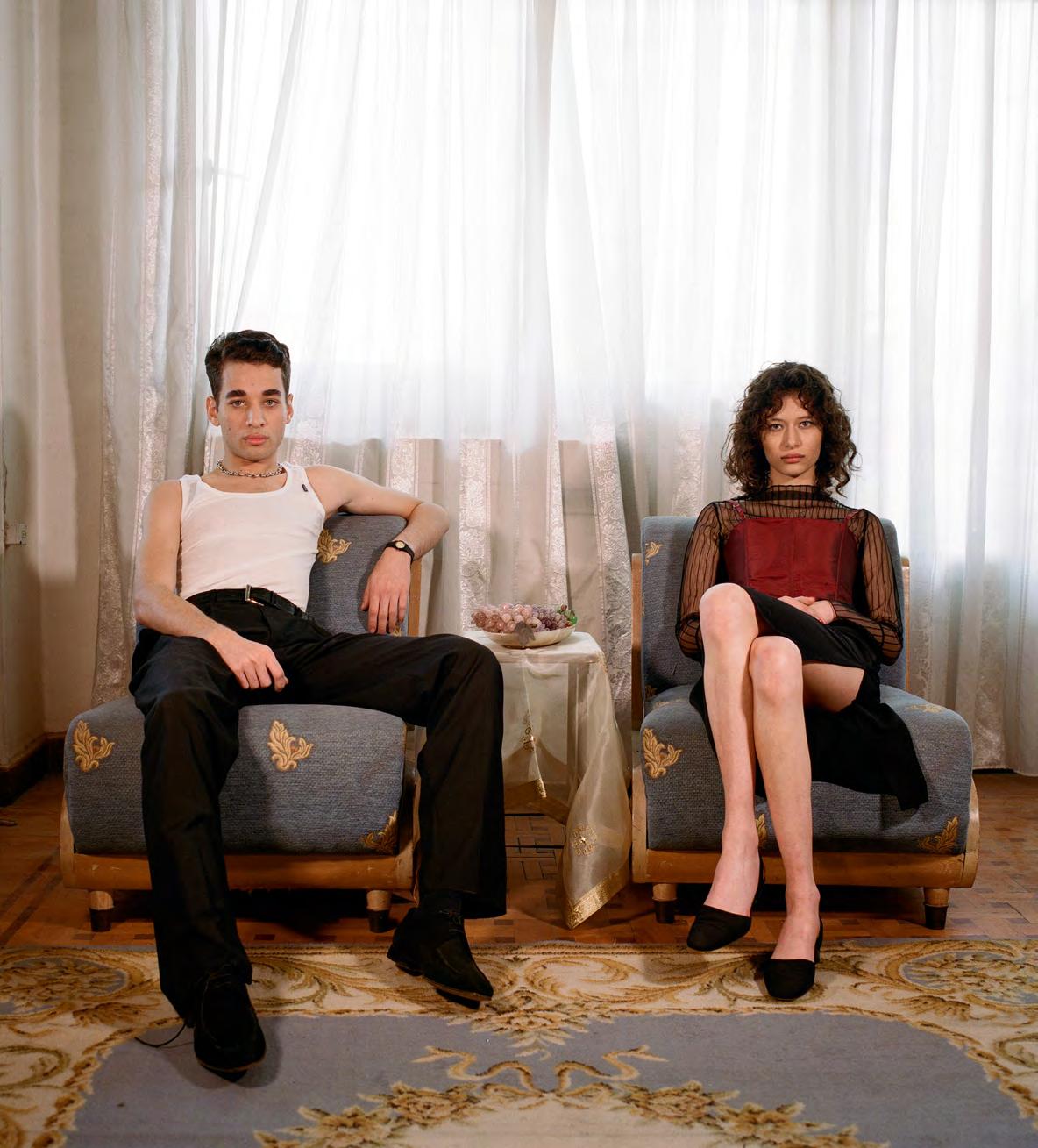


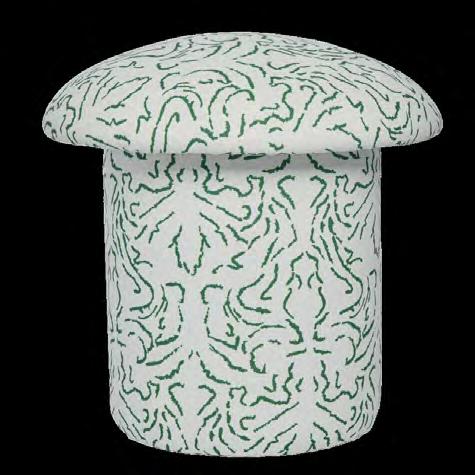
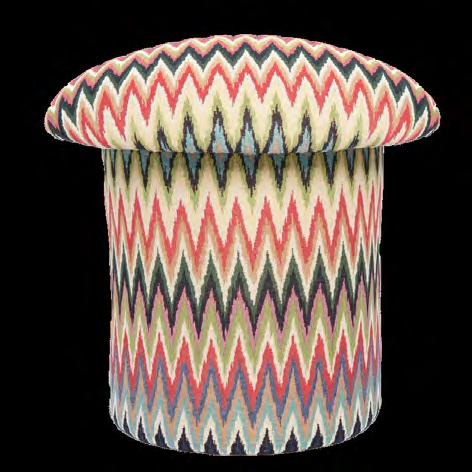
THIS IS YUNG THE MOOD 46-47

ASSIEDS-TOII
New Life
Assieds-Toii, an interiors brand, reimagines vintage furniture with a fashion-forward twist. It’s founders believe that homes should reflect personal tastes, not societal norms. Furniture should facilitate conversations, laughter, and love, serving as a conduit to life’s moments. Co-founders Haya and Isabella bonded over shared interests in fashion, art, and design, which inspired their venture. Amid the pandemic, they found solace in reviving forgotten pieces, sourcing fabrics from esteemed brands like Colefax and Noblis. Their journey began at an antique market, where they discovered a dilapidated conversation chair, igniting their passion to breathe new life into timeless designs. Assieds-Toii epitomizes vintage furniture reimagined with contemporary flair.
Your brand, Assieds-Toii, embodies a delightful charm. What is the meaning behind the name, and how does it capture the essence of your brand?
Assieds-Toii, meaning “have a seat” in French, was chosen for its catchy, playful nature, reflecting comfort. As a homeware and lifestyle brand inspired by the fashion world, our aim is to embody delightful charm. The addition of two “I”s symbolises us, the founders.
Can you share the story behind the inception of AssiedsToii?
Assieds-Toii’s inception stems from our passion for rejuvenating overlooked pieces. It all began with the idea of reupholstering vintage chairs with fashion focused textiles. Our journey is centred around transforming spaces with items that people need for the home that are difficult to source. Assieds-Toii is our commitment to crafting designs that cater to socialising and cultivating a cosy home environment.
The mushroom stools seem to be a signature of AssiedsToii. Can you share the inspiration behind this distinctive design, and what drew you to create these unique pieces?
We initially began with antique upholstery and observed people’s love for them, but space constraints were a challenge. The concept of mushroom stools emerged from our desire to craft functional yet stylish pieces. Drawing inspiration from the 60s and 70s, we stumbled upon an old campaign featuring mushrooms as a style element on the floor. That sparked the idea to transform them into functional and playful additions to interior spaces.
The use of top-tier fabrics like Colefax and Noblis adds a fashion-focused touch to your pieces. How do you go about selecting these fabrics, and how do they contribute to the overall aesthetic and quality of your transformed furniture?
We approach the fabric sourcing process with the same care and attention as selecting an outfit. This allows us the freedom to choose fabrics that resonate visually with us. With our differing styles, we ensure our collections boast a diverse array of colours, textures, and patterns. Bold and bright hues have always been our go-to, and our inclusion of animal prints consistently garners high demand, often leading to quick sell-outs. Recently, we experimented with dead stock cashmere in neutral and dark shades which drew an amazing response. There is a huge parallel to the trends happening within the fashion world that we are able to incorporate with our personal styles. We are always
striving to offer pieces that resonate with our clientele while remaining ahead of the curve. Colour trend forecasting is key for us.
Reviving forgotten vintage designs is a core aspect of your brand. What challenges do you face in this process, and how do you balance honouring the heritage of the original pieces while infusing contemporary elements? It’s a delicate dance between honouring history and adapting to modern preferences. The biggest hurdle is locating genuine materials and understanding the consumers’ behaviours and what part of antique pieces people are after. There is so much history so it can be overwhelming to dive into. While vintage designs may be visually striking, they may not always meet the functional needs of contemporary use. It is important to us to carefully analyse how the original design can be updated to enhance usability without compromising its historical significance. Incorporating contemporary elements such as sustainable materials, ergonomic improvements, or technological advancements can help make the revived pieces more appealing to a modern audience without diluting their nostalgic charm.
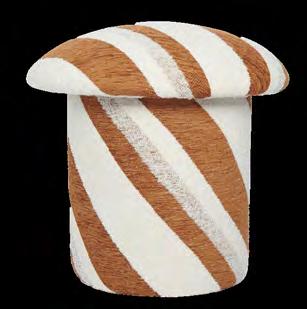
If you could time-travel to a specific era in furniture history and bring back one piece to revamp, which era and piece would it be?
If we could time-travel to a specific era in furniture history, I think we both would choose the Art Deco period of the 1920s and 1930s. This era was characterised by its bold geometric shapes, luxurious materials, and innovative designs. One piece we would love to bring back and revamp is the iconic “Cloud” armchair designed by French furniture designer Émile-Jacques Ruhlmann
If you could give your younger selves advice that would benefit your current journey with Assieds-Toii, what would it be?
We would emphasise the importance of patience, persistence, and adaptability. Persistence is definitely key when being faced with challenges as there will always be setbacks and moments of frustration! It is so rewarding to stay committed to your journey and to work through difficulties as this will ultimately lead to growth and success. Being adaptable is crucial. Our direction has evolved since the beginning which has taught us to be open and flexible with our expectations. Lastly, being patient is important to allow yourself to make mistakes and learn along the way. ■
photography by LUKE HUTSON-FLYNN
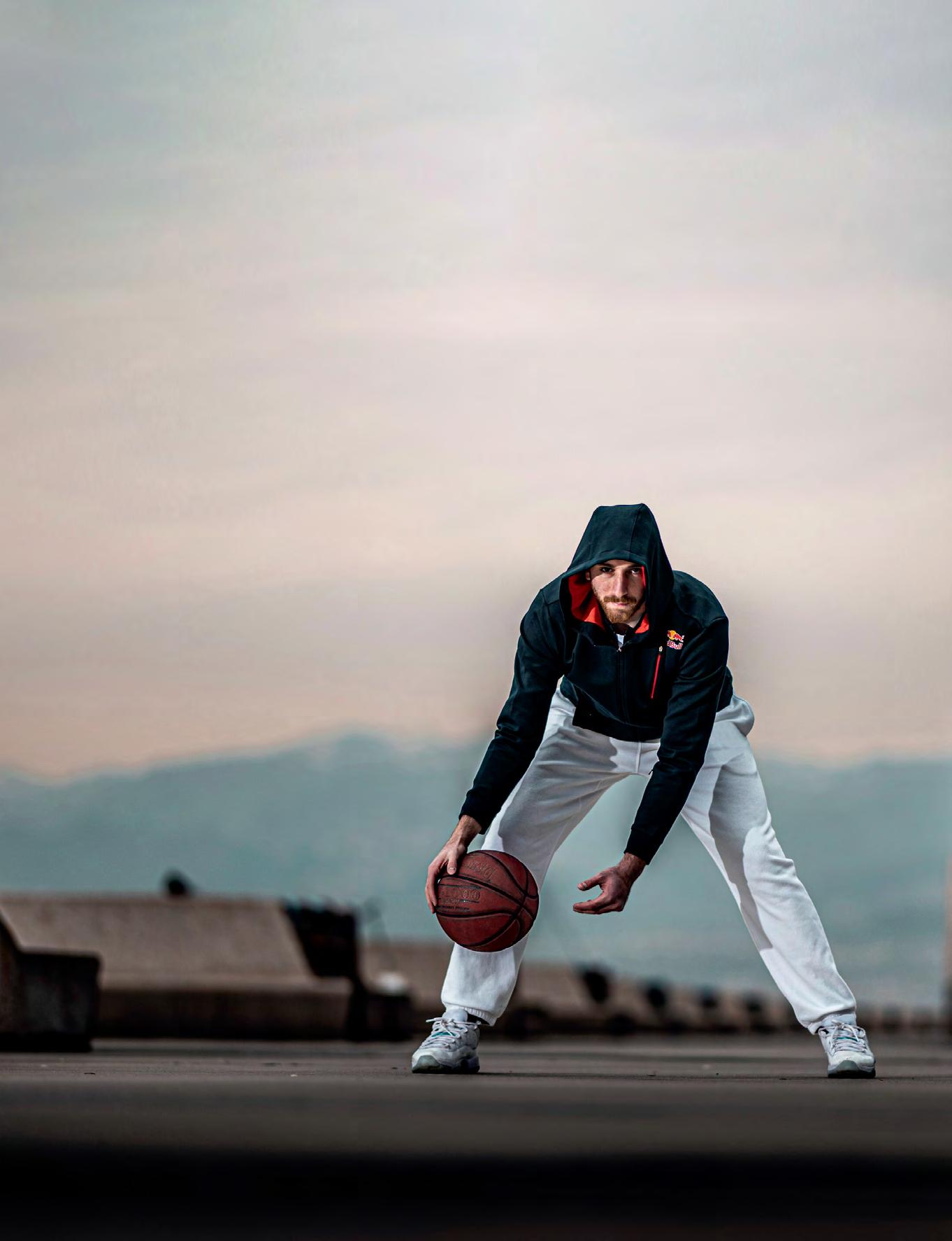
WAEL ARAKJI
Basketball Brilliance
Wael Arakji, the 29-year-old Lebanese basketball sensation, has taken the sports world by storm with his remarkable talent and leadership. His standout performances at the 2023 Men’s Basketball World Cup, securing victories for Lebanon, showcased his exceptional skills. Additionally, Arakji played a pivotal role in Al Riyadi’s success in the West Asia Super League. Notably, he was named as the Best Player for the Year 2023 in Asia, a testament to his growing influence and stellar contributions to the sport. Arakji’s journey continues to inspire fans globally, solidifying his status as a rising star in the basketball scene.
THIS IS YUNG THE MOOD 48-49

Could you share your earliest memory of the sport and the moment that sparked your interest, ultimately leading to your start in playing professionally?
I have played basketball ever since I was a little boy… aged four or five. I have loved the game ever since I can remember, and I was lucky that my parents spotted my passion and talent at an early age and enrolled me in a basketball academy. Although I wasn’t tall, and actually started gaining height at the age of 15, I was always very much into basketball, and wouldn’t miss one training or practice. But I must say that Harlem and Al Riyadi had a massive role to play in my growth as a basketball player, and so have the coaches that never stopped pushing me.
How do you maintain consistency and adapt your playing style for different competitions and teams, both internationally and with Al Riyadi?
Whether on an international level or with a specific team like Al Riyadi, it requires a combination of versatility, strategic awareness, and effective communication, like establishing strong team chemistry to enhance coordination and cohesion on the court, and being flexible and receptive to the coaching staff’s guidance and, most importantly, to develop a mental resilience to adapt to situations quickly and not get too emotional depending on how the game is going… but where it has to go. The challenges to being part of a Lebanese team aren’t from the nationality itself, but by the lack of support and commitment from the Lebanese authorities and government. As players, and with the support and love of Lebanese communities around the world, we are surrounded, protected and loved. As players, and as Lebanese communities and the diaspora, we make sure we are close to each other and want to reach the same goal. This is why I was emotional this year, and even cried in the post game interview against France. We are doing our best, we want the flag to be on the highest podium, we want the anthem to be on the loudspeakers in the final game, but what “tries” to slow us down is from within… and this is what, sadly, it comes down to sometimes when playing for Lebanon…
Securing victories against Ivory Coast and Iran in the 2023 World Cup was a major achievement. Can you briefly share the emotions of representing Lebanon on the global stage?
In my case it was always challenging because most of the time I was the point guard to players that were 8, 10, 15 years older than me, so I had to show a strong and confident character. Otherwise no one would take me seriously.
As a point guard, leadership is integral to your role on the team. How do you foster a sense of unity and motivation within your team, both at the national and club levels?
My job as a point guard is to make sure everyone is aligned and going as planned. It’s always easier to lead when we all have the same goal and with time and experience your maturity grows and dealing with different players and characters gets easier and smoother.
As a professional basketball player with a demanding schedule, how do you unwind during a chill afternoon?
Usually afternoons are all for practice and training… Unwinding comes usually on Sunday (when there are no games scheduled). I love playing video games and am very competitive at it, too! Spending time with my family, watching a series with my wife, quality time with friends…
Reflecting on your journey, from playing in the NBA Summer League to achieving success in Asia, what lessons have you learned that you would share with aspiring young basketball players?
To all young athletes my advice is to be confident and believe in your abilities and capabilities. Every injury is a lesson, and every setback has an amazing comeback, don’t let anything or anyone stop you.
These votes and awards always hit differently. They are voted for by the fans, the basketball world, the passionate ones watching… And it is not limited to Lebanon or Al Riyadi fans, it is beyond the club, or the country, or the region… It can’t get better than being voted Asia’s Most Valuable Player… or also being voted Asia’s Player of the Year! It is a massive responsibility, yet a very humbling one as well. It is not only for me, but for everyone who has helped me get to where I am now, whether it is by supporting me or by challenging me, or by standing in my way! They all contributed to where I am now… so yes, it is a thank you to all, the ones that support me, and also to the ones that dont! ■
SUPPLIED
photography
BY TALENT
COVER
THIS IS YUNG COVER STORIES 50-51
photography OTTO MASTERS styling NUJOUD OWEIS makeup LIZA MARTINS, BROOKE SIMONS, SOPHIE DOUGLAS; hair WILSON FORK, LEWIS PALLETT, ALEX SARGHE; lighting assistant ELLA COSTACHE; styling assistant SANA JAMALI; production LANA SHASH; production assistant OMAIA JALLAD, MAYA DAMIRJI, MOHAMMAD AL NATOUR
STORIES

TUNI SIA’S FIN EST
The making of an icon.
words MENNA SHANAB
THIS IS YUNG MYRIEM BOUKADIDA: TUNISIA’S FINEST 52-53
 necklace, rings, watch, BULGARI. blazer, TOM FORD
necklace, rings, watch, BULGARI. blazer, TOM FORD
bracelet, ring, watch, BULGARI. top, skirt, BOTTEGA VENETA
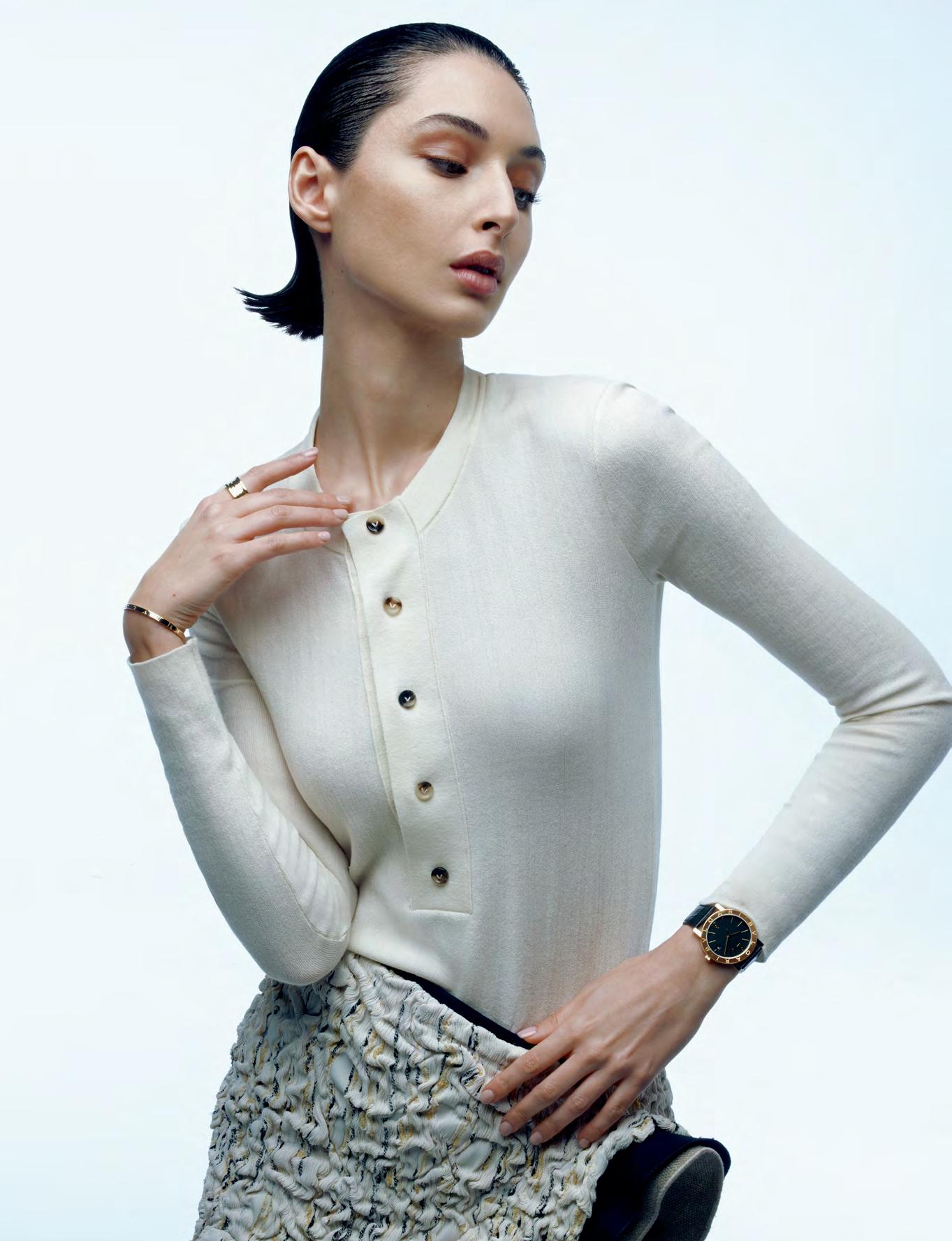
THIS IS YUNG MYRIEM BOUKADIDA: TUNISIA’S FINEST 54-55
“One
word that describes the essence of Bulgari Studio is revolutionary.”
“It’s cool to find yourself in unexpected places,” reflects Tunisian model and actress Myriem Boukadida on the time she was scouted by one of the biggest modeling agencies in New York at just 15. She was initially visiting the Big Apple with her mum to look into acting schools when destiny redirected her path. “In one moment, a whole different life path unfolded in front of me.”
It’s a good thing it did. Or maybe those Ford Models scouters had a keen eye for talent, because the Tunisian-born model would go on to take the global fashion world by storm. This twist of fate propelled her into a flourishing career, gracing runways and starring in campaigns for some of the biggest names in the game. A decade later, now 24, Boukadida has built an impressive portfolio. She journeyed from her debut show with Agnès b to dominating the runway for Dolce & Gabbana and becoming a muse for brands like Guess and L’Oréal USA. Over the last decade, she has cultivated an audience that looks up to her not just for her aesthetic appeal but for the authenticity and grace she brings to her work.
Although the head-start has its advantages, juggling the demands of a burgeoning career with her education was no small feat for a 15-year-old Boukadida. “I grew up faster,” she admits, reflecting on the maturity and organizational skills she had to develop early on. “Normally, I should be studying and not thinking about anything else. Eventually it got easier with time.”
Yet, amidst the glamour and the hustle, she holds dear her simple, joyful childhood in Sousse, Tunisia, which remains a touchstone and grounding force in her fast-paced life. “Growing up in Sousse meant spending endless days with my group of friends by the beach. It was a really pleasant coastal life. I have a lot of memories with my friends there and until this day, they’re my closest friends. They’re the ones I can always count on for everything.”
Her globe-trotting, jet-setting life has whisked her away from the sandy shores of her childhood but Boukadida always finds her way back, no matter how far she roams. Her connection to her roots is deep and meaningful, yet she chooses to honour it in a subtle, personal way—wearing the ‘Hand of Fatima’ necklace as a symbol of protection and a nod to her heritage. For Boukadida, staying connected to her origins isn’t about specific rituals, “it’s a state of mind, a feeling of attachment, the pride of belonging or, just a desire to represent my heritage everywhere I go,” she explains. “That’s how I stay connected to my roots.” Boukadida’s work is another avenue through which she celebrates her background. “I let my work do the talking,” she notes. “That’s the best way to do it – to let your work speak for itself.’
In the swirl of haute couture and glossy magazine covers, Boukadida finds a way to shine distinctly, channeling a unique magnetism that established her as a genuine icon in a realm of transient trends and fleeting fashions. From opening the Georges Hobeika Haute Couture Spring 2024 show to her visually-striking presence on Vogue Arabia’s September 2023 cover and a myriad of editorials and campaigns, Boukadida narrates a story of a woman effortlessly celebrating her North African beauty with the world. Through these projects, she continues to let her work speak on its own, subtly placing Tunisia in the limelight of the international fashion industry.
Then came a moment that lingered, a jewelry shoot with Vogue Arabia that would ripple across the fashion world and beyond. She reminisces about the unexpected impact: “During that time, I never imagined the engagement and interest that would generate globally. I was so impressed and proud to see how widely it was shared everywhere. And what people loved was the authentic representation of the Arab features, my Arab nose. And honestly, that has made me love my nose even more. And has made me see it more as a strength.”
Her vision extends beyond personal triumphs. She wants to be a catalyst for change. “I want to break down barriers by proving that there’s beauty and strength in diversity,” she shares. “I want to inspire confidence and self-belief in all the young women out there and encourage them to pursue their passions and dreams, no matter how big their dream is. If you work hard enough embrace your unique identity, I think you’re capable of achieving anything you set your mind to, regardless of any challenges you may face.”
She’s heartened by the strides made toward inclusivity in fashion but remains candid about the gaps that remain. “From my perspective, there has definitely been a shift towards greater inclusivity in the fashion industry, with many brands including models or talents from diverse backgrounds in their campaigns and fashion shows,” she notes. “But honestly, there’s still progress to be made there. Especially the North African and Middle Eastern models, we’re still very underrepresented in global campaigns. What I would like to see here more consistent and genuine commitment to all kinds of diversity.”
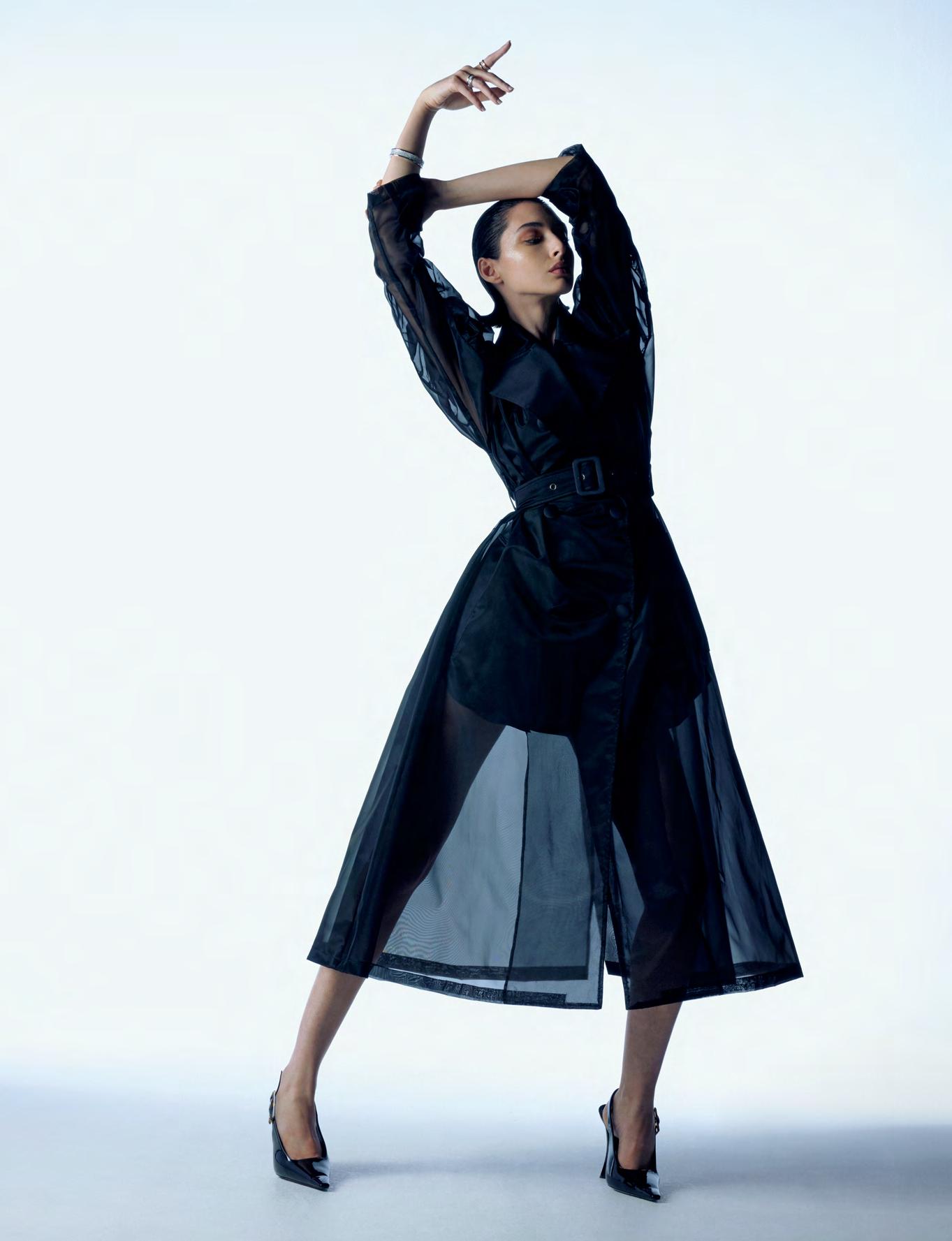
THIS IS YUNG MYRIEM BOUKADIDA: TUNISIA’S FINEST 56-57
bracelet, rings, BULGARI. coat, DOLCE & GABBANA. heels, SAINT LAURENT


THIS IS YUNG MYRIEM BOUKADIDA: TUNISIA’S FINEST 58-59
necklaces, rings, BULGARI. top, pants, RALPH LAUREN
“What people loved was the authentic representation of Arab features, my Arab nose. And honestly, that has made me love my nose even more. And has made me see it more as a strength.”
In her narrative, she passionately points out the progress made in the local sphere, but she dreams bigger, envisioning a ripple effect that spans the globe. “It needs to be not only on a local level, but on a global level,” she states. “On a local level, we’re actually doing incredible work. It’s amazing what we’re doing,” she acknowledges, “but it just needs to reach more people.” Her words paint a picture of a future where our local wins are more than just that. They’re the spark for worldwide change.
While Boukadida’s modeling career soared from the start, it was her interest in acting that was the real driving force behind her initial visit to New York. In the city that never sleeps she walked down a path straddling two worlds— gracing the catwalks and refining her acting skills. Enveloped in the artistic fervor that courses through New York, Boukadida found a second home at the Stella Adler Studio of Acting. But she didn’t limit her talents to the American stage, she also made a handful of appearances on Tunisian television back home.
“I love doing both,” she shares. “They’re very similar. It’s in the artistic expression. When you’re in front of the camera, it’s a way for you to discover yourself and express yourself in different ways, especially since you’re bringing a creative vision to life.” Her passion for both is rooted in the art of expression. This is what drives her at the core. Blurring the lines between the model and the actress, each role she takes on is a new canvas for her creativity.
Diving deeper into the realm of acting, Boukadida, an explorer at heart and equipped with a voracious creative appetite, embraces every character with open arms. “I view each role as an opportunity for growth and exploration. My goal for the future is to really play and embody as many different roles as possible.” She’s not one to shy away from any genre, always on the lookout for a role that challenges her and adds a new layer to her evolving artistic persona.
“ I’m really open to everything, as long as there’s a good story line.” But among the roles she dreams of, stories of revenge and action have a special allure to her. It’s those gritty tales of revenge and high-octane action flicks that get her heart racing, tapping into the intensity she loves to explore on screen. Currently, Boukadida’s artistic curiosity is piqued by an upcoming project that hits home with her personal history. “At the moment, a story that I feel drawn to is that of Antoine Fuqua’s new movie about the Carthaginian general Hannibal. The reason I’m drawn to this is I just feel that the story, it’s kind of part of my heritage and part of where I’m from. It feels almost natural to be drawn to it. “
Off the screen and away from the cameras, Boukadida presents a contrast to the characters she portrays. In her daily life she’s known for her infectious smile and quick wit, a stark difference from the serious, focused professional the audience sees on screen. “I would describe the two versions of myself, on camera and offscreen, as distinct. I’m fun but when it’s time to focus, I’m laser-focused on my work. That’s where the difference is.”
At her core, Boukadida is a proud Tunisian, deeply connected to her heritage and eager to represent her roots through her work. “I’m Boukadida. I’m from Tunisia. I’m a human being that loves life— that is always motivated to do better,” she states. She’s a Tunisian powerhouse. Her commitment to her roots is not just a facet of her identity but a driving force in her career. “I love representing where I’m from, my heritage,” she says. ■

THIS IS YUNG MYRIEM BOUKADIDA: TUNISIA’S FINEST 60-61
sunglasses, bag, BULGARI. dress, CELINE. heels, PIFERI
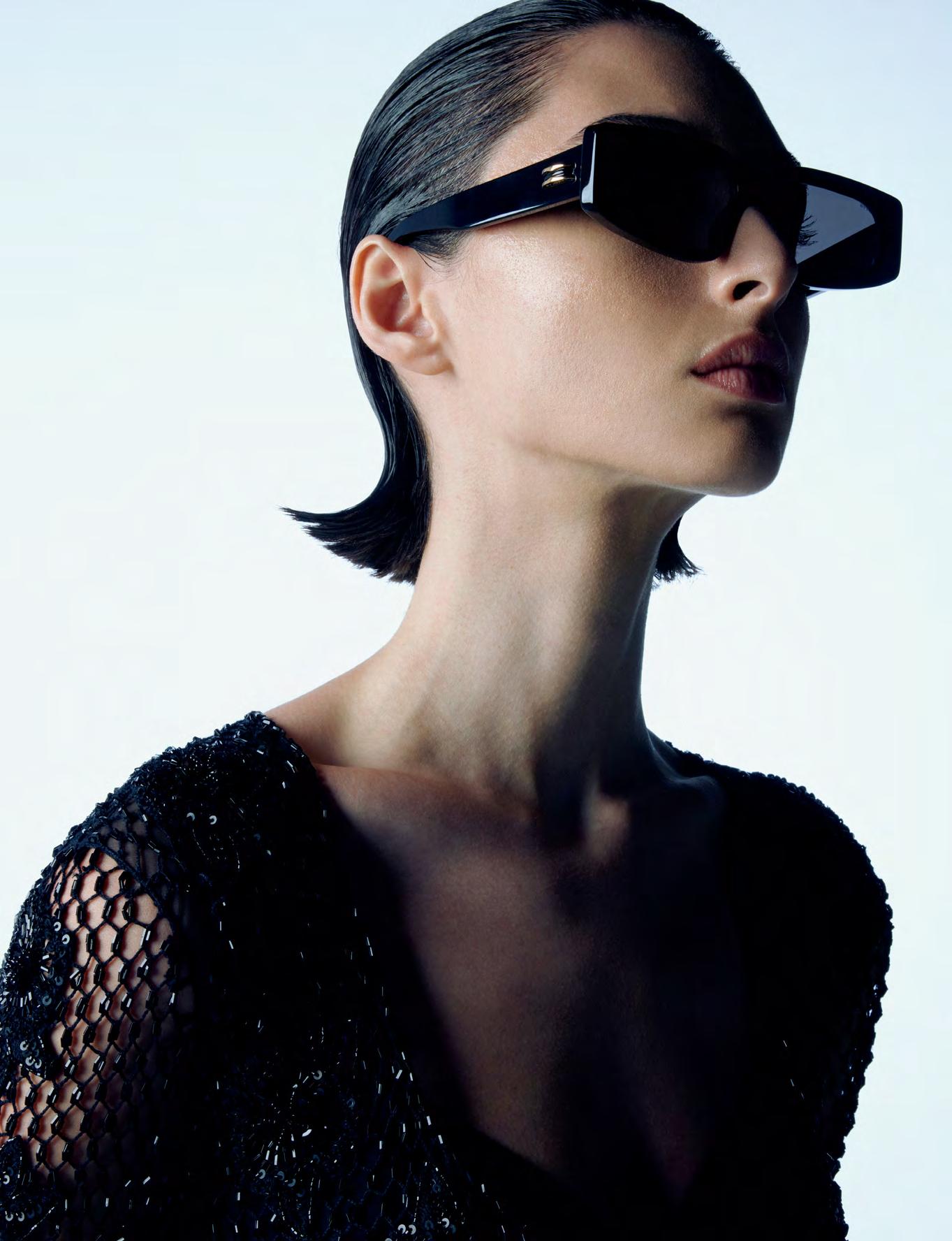

“From my perspective, there has definitely been a shift towards greater inclusivity in the fashion industry, with many brands including models or talents from diverse backgrounds in their campaigns and fashion shows. But honestly, there’s still progress to be made there.”
THIS IS YUNG MYRIEM BOUKADIDA: TUNISIA’S FINEST 62-63
 earring, necklace, rings, BULGARI. dress, LOEWE
earring, necklace, rings, BULGARI. dress, LOEWE

STO RYTEL LING IN FABRIC
Meet the future of couture.
THIS IS YUNG JAD HOBEIKA: STORYTELLING IN FABRIC 64-65
words MENNA SHANAB
 rings, bracelets, BULGARI. blazer, pans, shirt, tie, GEORGES HOBEIKA
rings, bracelets, BULGARI. blazer, pans, shirt, tie, GEORGES HOBEIKA
“The essence of Bulgari Studio? Effortless luxury.”
At Maison Georges Hobeika, a fashion legacy interlaces through generations, from Georges, who was nurtured in the art of couture by his mother Marie, down to Jad Hobeika, who grew up in a world of glamourous runways and fantastical designs. This lineage of couture craftsmanship set the stage for Jad, who, after studying at the prestigious École de la Chambre Syndicale de la Couture Parisienne, joined forces with his father to inject a fresh, innovative spirit into the family’s fashion house.
With a childhood during which he had an array of interests, from drawing to creating, Jad’s path to fashion was not a straight line but a meandering journey teeming with exploration and discovery. His story begins not with a singular spark of ambition, but with the magic of creation itself. Unlike many dawn to specific design elements, Jad found himself captivated by the transformative power of creating something entirely new. “It wasn’t something I ever actively pursued,” he reminisces. “It was more like I just fell in love with the entire process. The way you can change someone’s look, just by creating a piece with fabric, it’s incredible. It holds so much power.” This innate love for creation, more than just a career choice, became an undeniable calling for Jad.
Drawn into the creative orbit of his father’s fashion house, Jad developed a deep appreciation for the meticulousness of couture, not just as an observer, but as a participant. Watching his father, Georges Hobeika, sculpt fabrics into wearable works of art instilled in Jad a deep appreciation for the dedication and precision required in fashion’s most prestigious realm.
Born from the glamorous energy of Beirut in 1995, Maison Georges Hobeika has become synonymous with red-carpet glamour with its exquisite couture gowns gracing the world’s most recognizable women. Steeped in rich heritage, the House is a family affair and it has blossomed under George’s meticulous eye for detail. On the cusp of its 27th anniversary, Maison Georges Hobeika opened a new chapter, officially naming Jad Hobeika as Co-Creative Director in 2022. With Jad’s youthful energy and contemporary perspective, the House promised to retain its signature DNA while venturing into new unchartered territories.
But Jad had already been an integral part of the brand’s development for six years. In 2016, he found himself drawn into his father’s fashion house, not with the intention to lead, but simply to contribute. “I wasn’t supposed to do anything specific,” he recalls. “I just started offering ideas, mixing this and that.” This collaborative spirit marked the beginning of his formal foray in fashion, shaping his role within the brand. He began giving his input and helping to create the collections in order to expand the House’s audience to a younger, more fashion-forward clientele and evolving the brand in a step to becoming more internationally recognized.
“There was never a grand plan, nothing premeditated,” Jad explains, emphasising the organic nature of their collaboration. “One day, I found myself in the studio, surrounded by everyone working on their designs for the next collection. It felt... stagnant. I looked at George and said, ‘What if we shake things up? What if we try something different?’”
This collaboration is a delicate dance between experience and fresh perspective. Georges, a veteran in the industry, embodies the brand’s heritage and signature, while Jad brings a youthful spirit and an eye for contemporary trends. Well, actually as Jad put it, “The Maison doesn’t chase trends. We focus on what resonates with us, what we feel is relevant, not just for the world right now, but for what the world should be wearing. It’s about the emotions, the stories behind the clothes, even the little details.”
Their contrasting approaches, far from creating conflict, fuel a dynamic creative process. “We sit together, brainstorm, and see how we can merge these two worlds,” Jad explains. “Sometimes we compromise. If I have an idea that doesn’t seem as impactful as his, I’m happy to step back and support his vision. It’s a constant conversation, an ongoing dialogue that ultimately breathes life into the collection.” This collaborative spirit ensures that the Maison Georges Hobeika legacy not only endures, but continues to evolve with each new collection.
THIS IS YUNG JAD HOBEIKA: STORYTELLING IN FABRIC 66-67
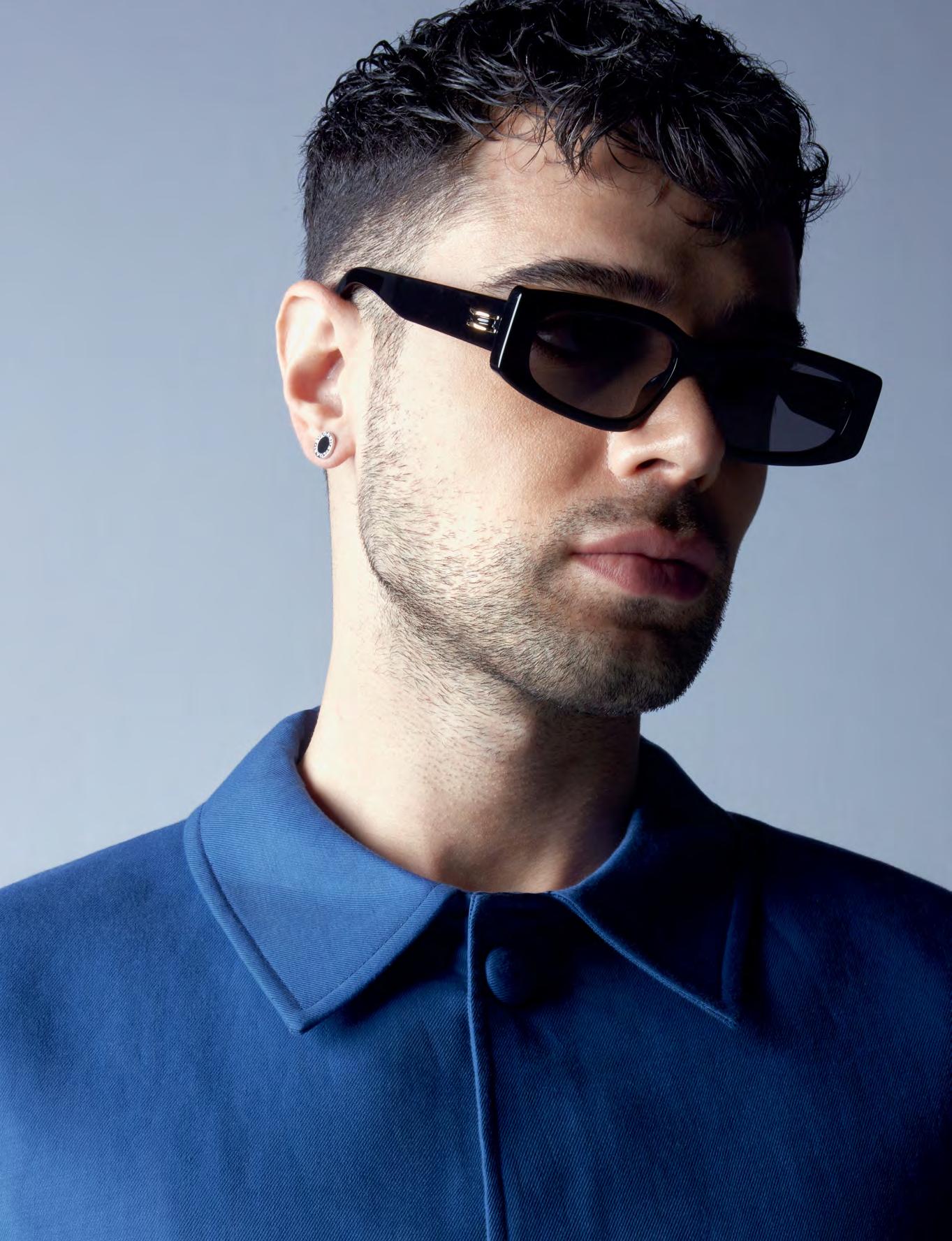 earring, sunglasses, BULGARI. jacket, GEORGES HOBEIKA
earring, sunglasses, BULGARI. jacket, GEORGES HOBEIKA


THIS IS YUNG JAD HOBEIKA: STORYTELLING IN FABRIC 68-69
necklaces, BULGARI. jacket, vest, pants, GEORGES HOBEIKA
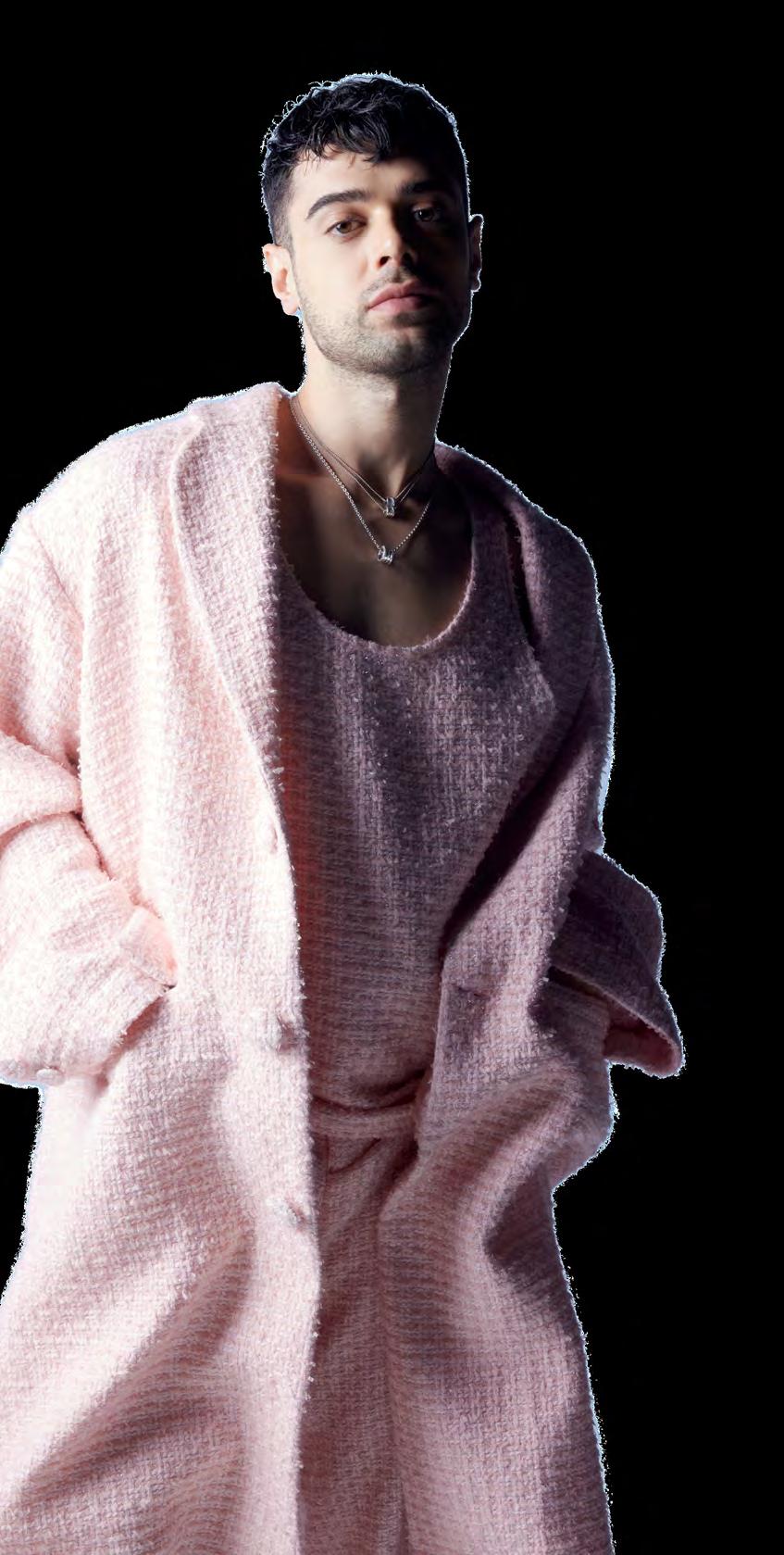
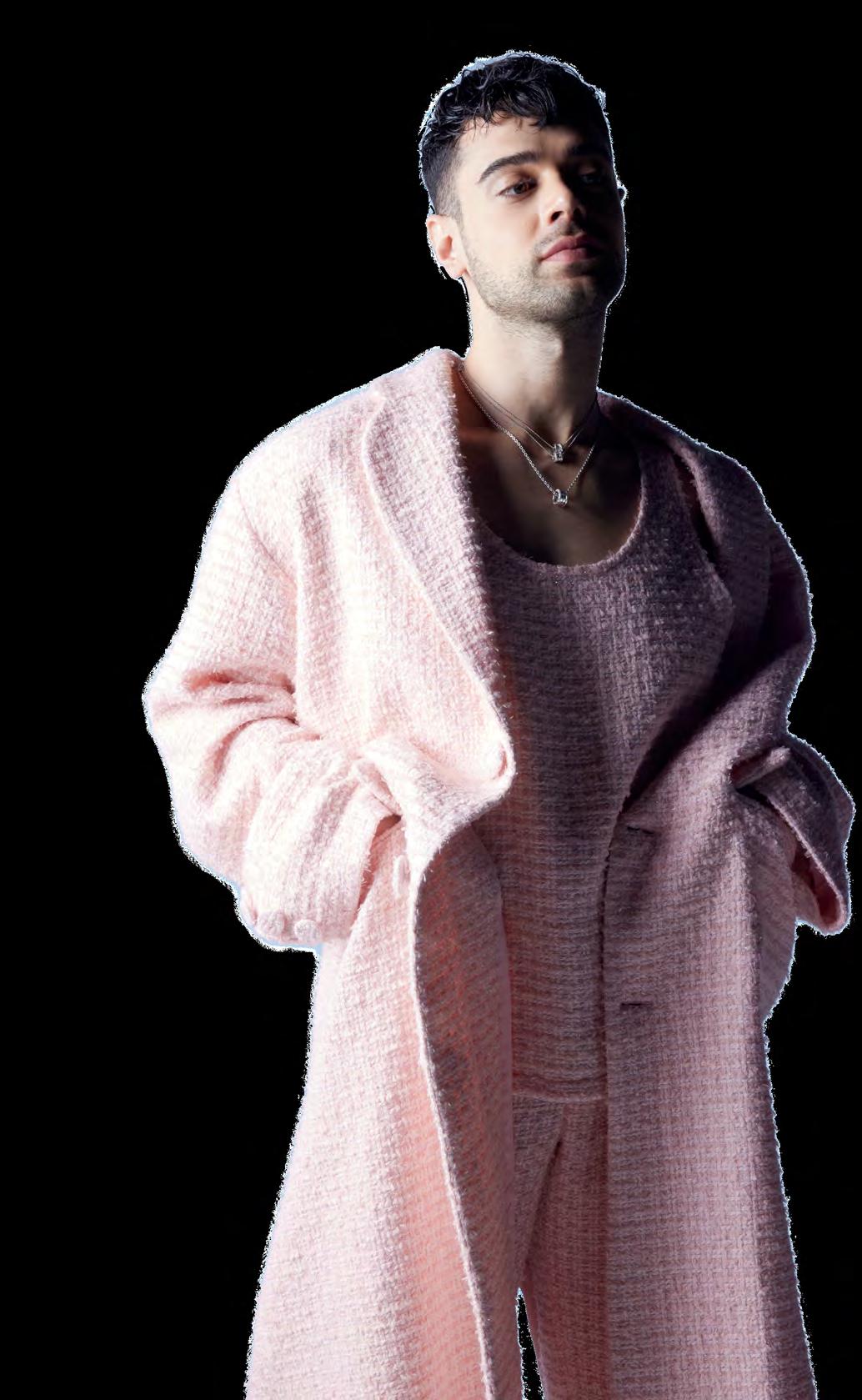
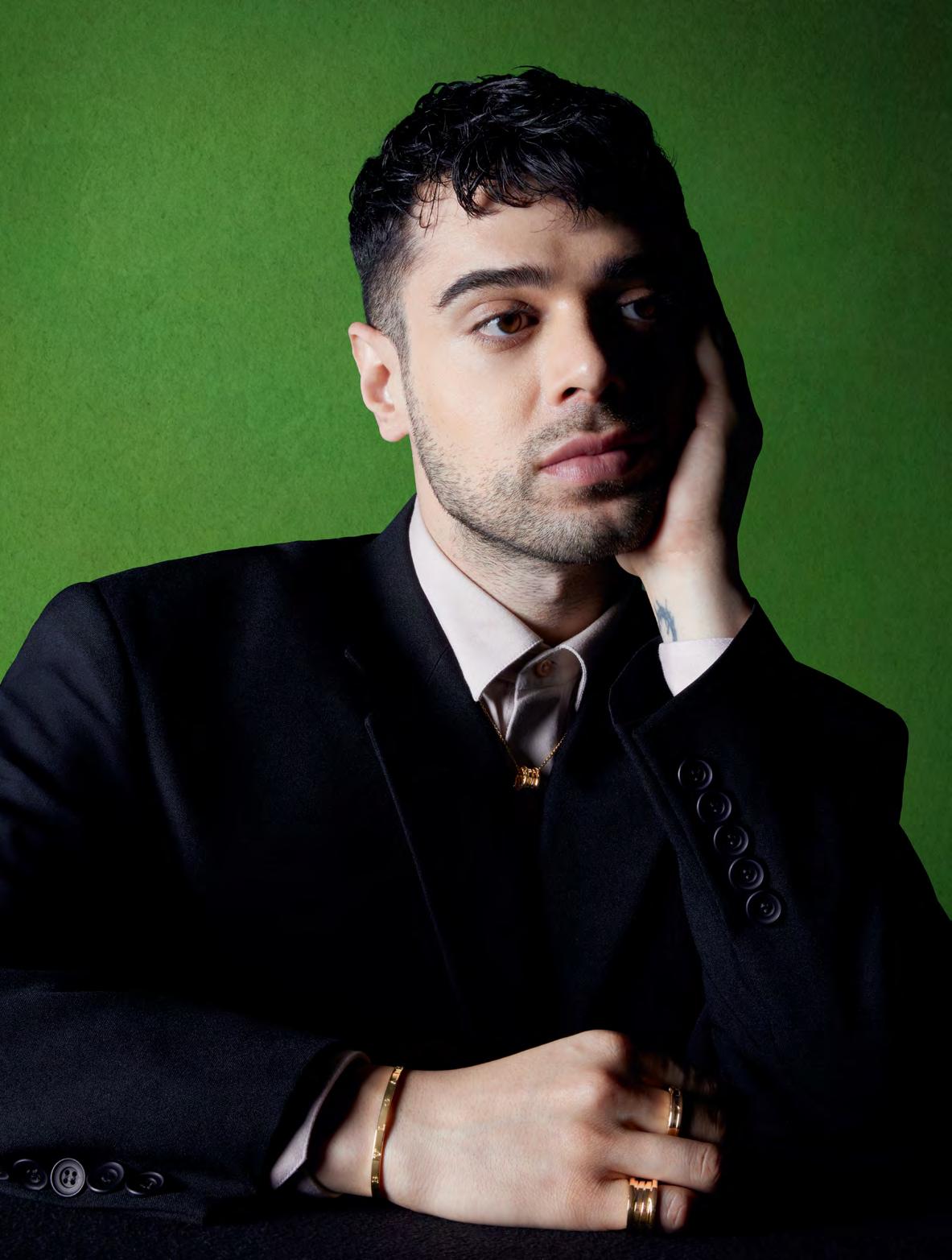
THIS IS YUNG JAD HOBEIKA: STORYTELLING IN FABRIC 70-71
necklace, rings, bracelet, BULGARI. blazer, shirt, GEORGES HOBEIKA
“It represented that feeling of raw power, that sense of being almost invincible. I translated that emotion into the collection, using the vampire as a symbol.”
This partnership translates into collections resonating with both their shared and individual perspectives. “The Spring 2024 collection,” Jad explains, “is really about the Arab world, showcasing a sense of nostalgia and a glimpse back in time – kind of like revisiting Lebanon’s Golden Age. I wanted to explore this theme for a long time, and I finally brought it up, feeling it was long overdue. We’d never really focused on the world and brand together. You know, I’m deeply proud of our culture, and memories from my childhood fueled the love for this idea.”
His father’s response exemplifies their collaborative spirit. “’What if we incorporated the gloves we were already considering for the collection?’ he suggested. ‘It could be a subtle nod to the era, like saying ‘Hey, remember the gloves they wore in the 50s and 60s?’” This idea intertwined beautifully with the Arab world theme. “We discussed it further,” Jad continues, “and creating a single colour that would seamlessly flow from the gloves to other pieces was another idea we explored and developed together.”
Balancing his personal aesthetic with the brand’s established identity presents its challenges. Jad describes his style as “very human, very conscious of comfort” favouring comfort and a blend of modern and vintage elements. Integrating this into Maison Georges Hobeika’s more glamorous, embroidered designs requires a delicate dance of respect for tradition and a push toward innovation. Jad treasures the advice his father has given him, especially the reminder to “study your look” and not to get too caught up in taking things too seriously. This perspective has allowed him to navigate the fashion world with a sense of joy and authenticity.
The first collection co-designed by father and son, Fall-Winter 2019, showcased their contrasting yet complementary vision. It was a great success and set the tone for the future of their creative collaborations. A-list actresses including Lily Collins and Jennifer Lopez adopted key looks for their red carpet appearances. While Georges’ near 30 years in the industry provides a wealth of experience, Jad’s youthful perspective and uninhibited spirit inject fresh energy into the Maison, taking it forward into the future. The first collection presented by the two Co-Creative Directors was the Fall/Winter 2022 collection which showed in Paris. They presented a collection that celebrated “self-confidence, femininity, and the power of dreams,” featuring bolder colours and, for the first time, menswear. This spirit of inclusivity and experimentation continues to define their work, as seen in the use of plus-size models and a drag queen on the runway.
While some designers find inspiration in fleeting moments, Jad’s creative spark ignites with a feeling for shape and colour. He then translates this initial vision into a flurry of sketches, relentlessly refining them until a novel theme emerges, blossoming into a full-fledged collection. Take the “VAMPS” collection, for example. Inspired by his own exploration of anxiety, Jad envisioned the collection through the powerful image of a vampire. “We were discussing anxiety, and somehow, the image of a vampire just emerged,” Jad explains. “It represented that feeling of raw power, that sense of being almost invincible. I translated that emotion into the collection, using the vampire as a symbol.”
Jad’s approach to design is deeply personal. From exploring anxieties through the metaphorical power of a vampire to honouring the Arab world’s golden age, his collections transcend mere garments. Each piece becomes a character in a larger narrative, brought to life through his dedication to storytelling. “I love to tell a story,” Jad shares. “About a woman, or an idea, or something I’m going through, whatever it is. The story just makes sense and translates itself into clothing. Whenever I have a story in mind, or I’m going through something, I create a character that embodies that specific feeling or that specific way of dealing with things. It’s literally a character that gets invented, created, or becomes reality.”
However, Jad’s greatest sense of fulfilment transcends the accolades and industry recognition. It lies in the transformation he witnesses in the women who wear his designs. “The most rewarding thing? Seeing women empowered by what you create,” he says. “Seeing them wear your clothes with pride, feeling confident and strong. That’s the ultimate reward.” This desire to empower and redefine beauty is evident in his bold choices, like introducing menswear, plus-size models, and a drag queen to the brand’s runway shows. “These weren’t just decisions,” Jad enthuses. “They were statements. Because for me, the Maison Georges Hobeika is more than just a brand; it’s a state of mind, a platform to celebrate individuality and share personal stories. ■

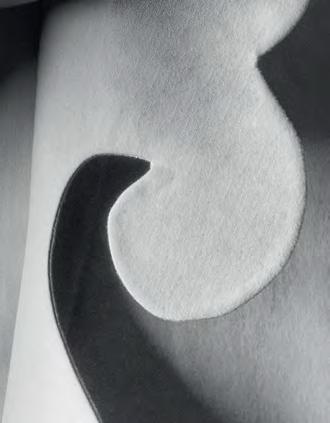
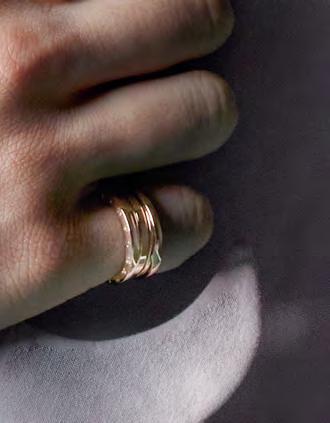






THIS IS YUNG JAD HOBEIKA: STORYTELLING IN FABRIC 72-73
necklace, rings, BULGARI. jacket, shirt, GEORGES HOBEIKA

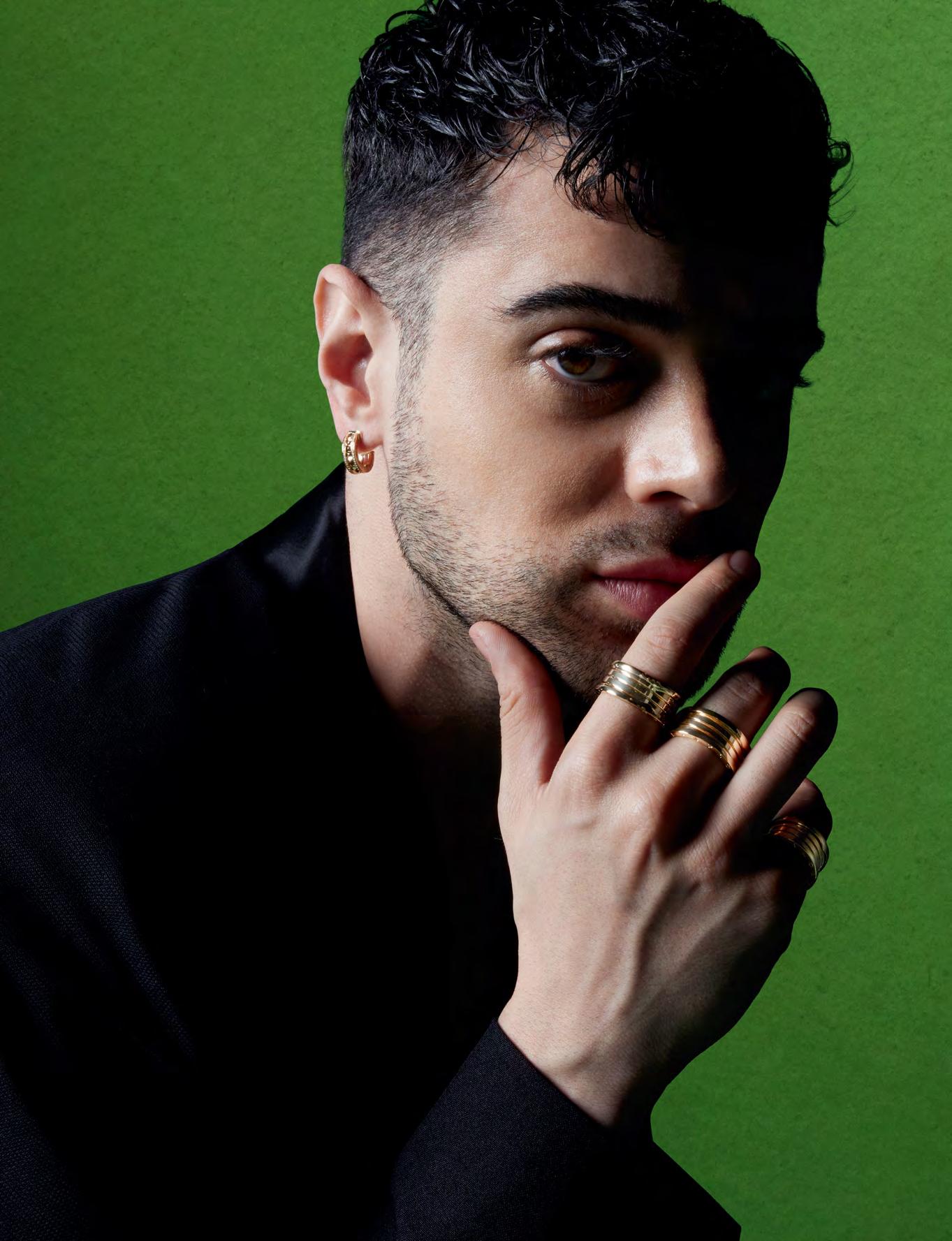
THIS IS YUNG JAD HOBEIKA: STORYTELLING IN FABRIC 74-75
rings, earring, BULGARI. blazer, GEORGES HOBEIKA

“It wasn’t something I ever actively pursued,” he reminisces. “It was more like I just fell in love with the entire process. The way you can change someone’s look, just by creating a piece with fabric, it’s incredible. It holds so much power.”
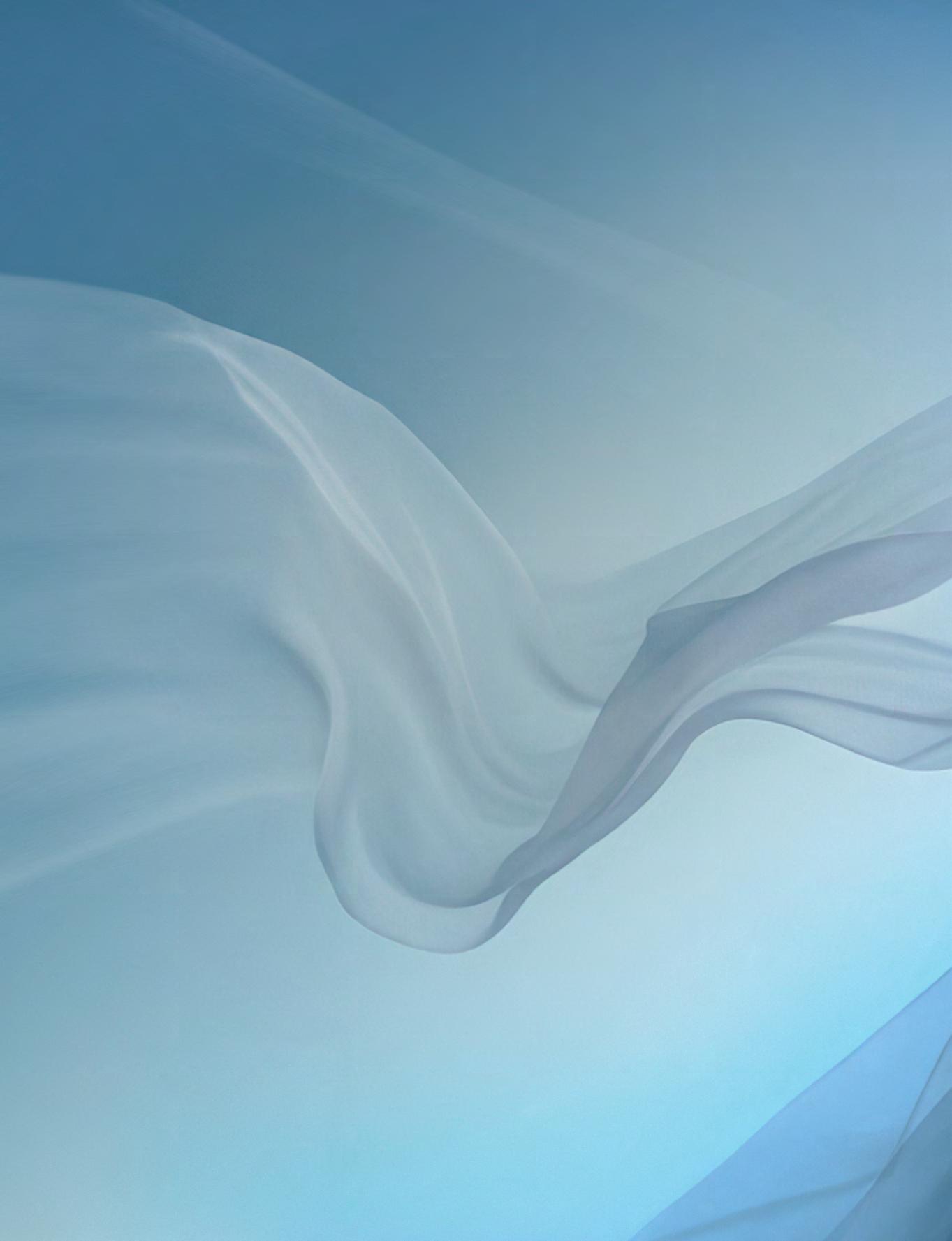
A RIS ING STAR
Championing diversity, representation, and empowerment.
THIS IS YUNG THALIA ELANSARI: A RISING STAR 76-77
words MARIANA BAIÃO SANTOS
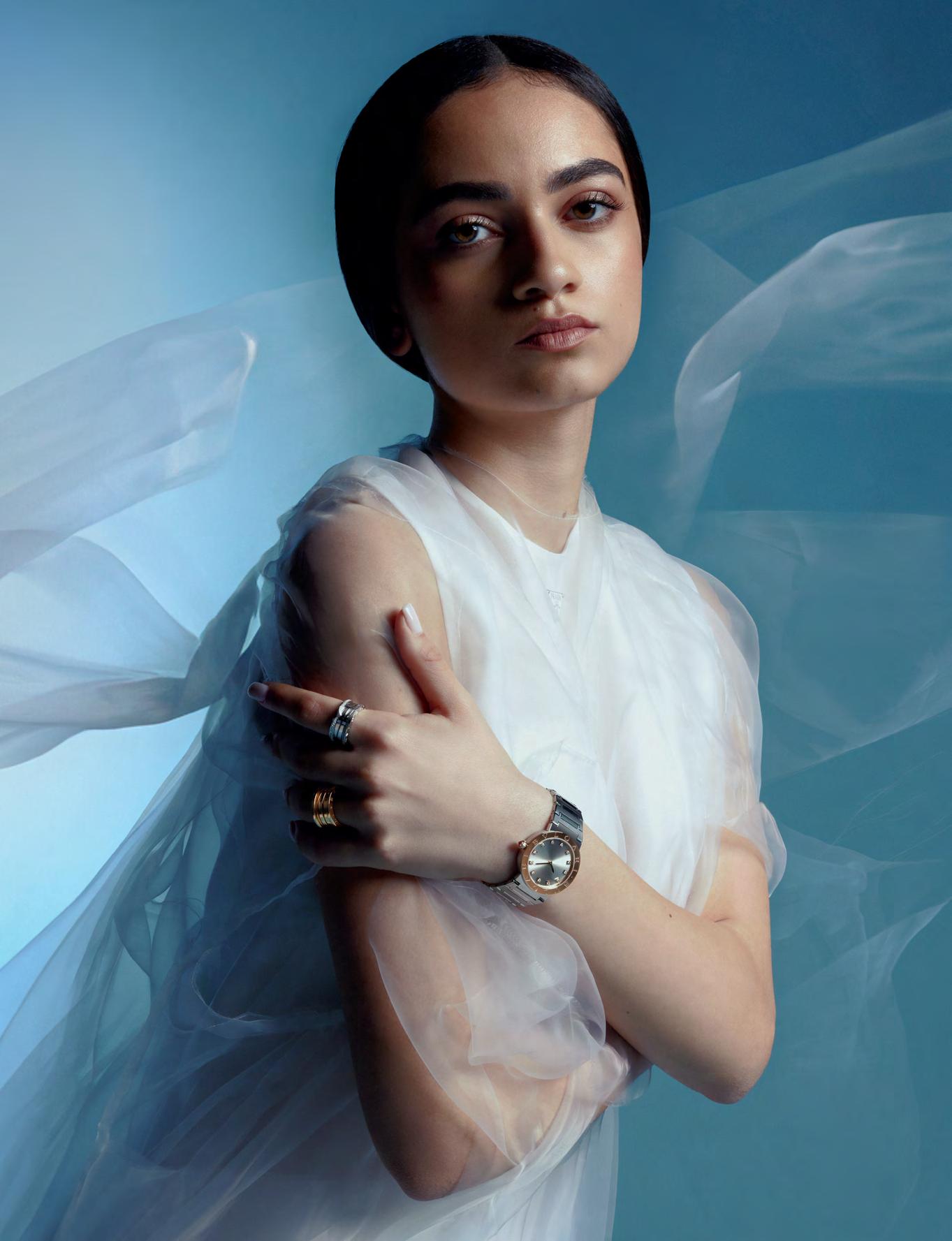 rings, watch, BULGARI. dress, PRADA
rings, watch, BULGARI. dress, PRADA
Thalia Elansari is a rising star of the entertainment industry, celebrated for her breakthrough role in ‘AlRawabi School for Girls Season 2, a tremendous young talent, yet it is her passionate advocacy for diversity and empowerment that captivate attention.
As Jordan’s burgeoning entertainment landscape continues to evolve, with “AlRawabi School for Girls” topping the charts on Netflix, Thalia Elansari’s ascent stands as a testament to talent, resilience, and the pursuit of excellence. Rising through Amman’s vibrant cultural scene, her journey to prominence has been nothing short of remarkable, marked by her standout debut performance as Shams in the acclaimed second chapter of the series.
For Elansari, the journey into acting was serendipitous, marked by an opportunity seized with steadfast determination. “To be honest, it was something new to me. I stumbled upon it,” she reveals with disarming honesty. “I took it as more of a challenge, like, ‘Okay, this is something that’s out of my comfort zone.’”, this drove her ambition further rather than hold her back. Recounting the moment she learned of her casting, Elansari’s excitement is palpable “It was crazy,” she recalls, her eyes sparkling with nostalgia. “Oh, my God, there’s no way. And I shared that moment with my mum, because I was on the phone in the kitchen. I was like, ‘Do you hear this, right?’”.
“One word that describes the essence of Bulgari Studio is individuality.”
As Shams, the actress’ portrayal captivated audiences with its depth and authenticity, earning her widespread acclaim. Yet, amidst the glitz and glamour of the entertainment industry, Elansari remains grounded, balancing filming with studying. Shooting occurred alongside her Year 11, and she returned to class the days she was not required on set, “My life was just two things: acting and studying; there was no time for any other interactions”, a disciplined attitude enabled her to allocate her time efficiently, and it’s paid off. “I’m very happy,” she shares.
Despite the initial challenges of portraying a character whose mannerisms and behaviours contrasted with her own, Elansari delved deep into Shams’ psyche, constructing a rich backstory to inform her performance. By exploring Shams’ family dynamics, past traumas, and daily interactions, Elansari cultivated a profound understanding of her character’s motivations and complexities. This process allowed her to authentically inhabit Shams’ persona, ensuring a nuanced and compelling portrayal on screen, she talks about the use of lookbooks and playlists to help her get into character. As much as Elansari poured into Shams, the roles also reversed as she tells us enthusiastically about her newly acquired video skills and the purchase of her first camera, saying “I also did not know how to ride a bike, so I had to learn, and now I bought my own bike and I’m like: this is actually fun”.
Elansari’s face lights up as she recalls one of her most cherished moments on set. “There was this skateboard scene in episode four that I absolutely loved. The vibes of that day were astronomical, because everyone had their own specific thing, there were dancers and skateboarders. It was such a fun atmosphere.” Asked about her skateboarding skills in the scene, she chuckles, “I didn’t have much experience before, I guess back in 2020, there was this phase where everyone would learn how to skateboard and I got deeply invested in that, but I never could get past this one move - which was an ollie, so I got stuck and just gave up eventually,” she laughs.
THIS IS YUNG THALIA ELANSARI: A RISING STAR 78-79
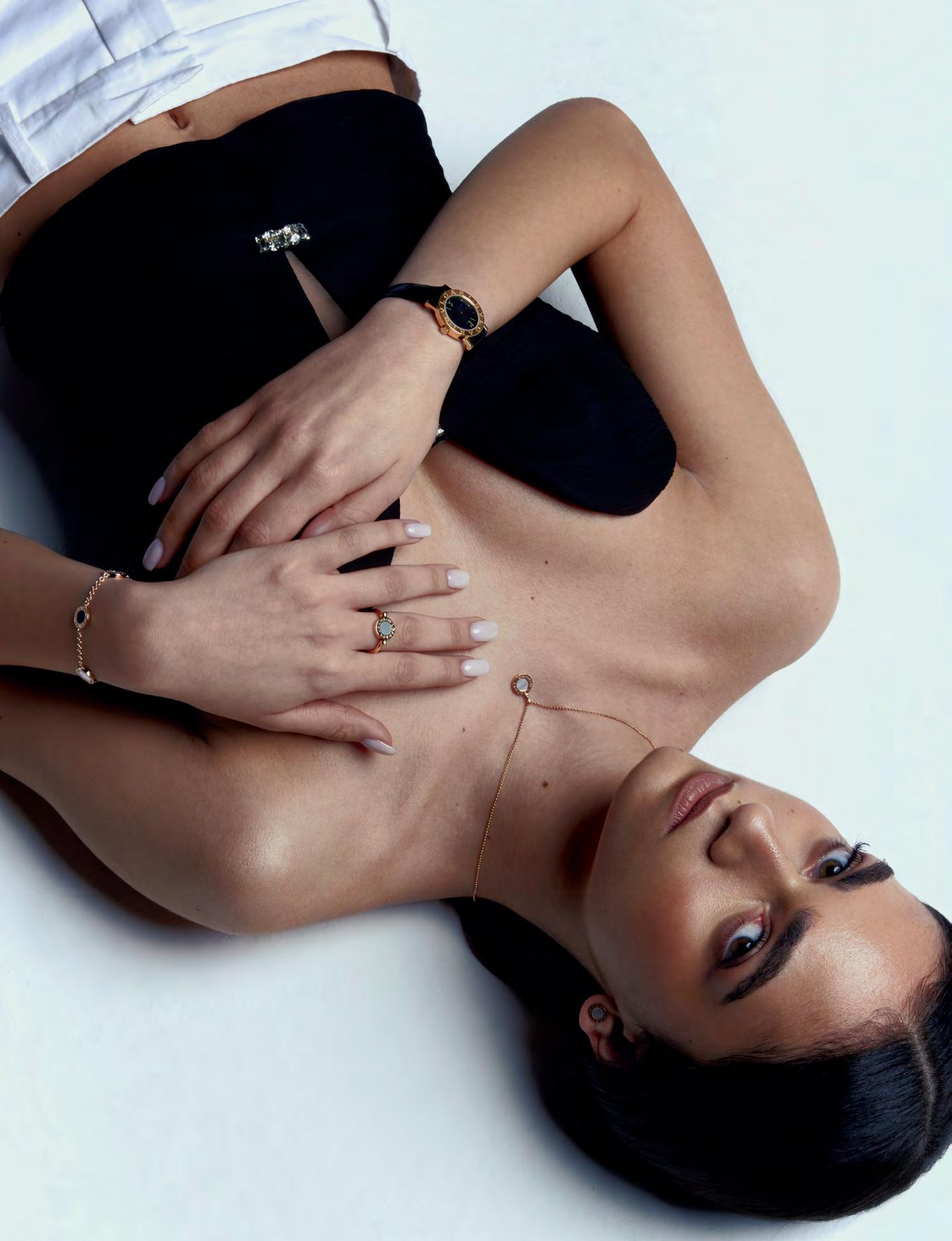 ring, watch, bracelet, necklace, earring BULGARI. top, NAFSIKA SKOURTI. skirt, VALENTINO
ring, watch, bracelet, necklace, earring BULGARI. top, NAFSIKA SKOURTI. skirt, VALENTINO

THIS IS YUNG THALIA ELANSARI: A RISING STAR 80-81
rings, bracelet, BULGARI. dress, CELINE
With a promising future ahead, both in the realm of entertainment and beyond, Elansari stands poised to leave an indelible mark on the world stage.
“Jordan is small, so everyone knows everything,” she says. The impact of starring in a series, especially as a newcomer to the acting scene, can be monumental, both personally and professionally. Elansari, reflecting on her experience with the series, shares about the whirlwind of emotions she experienced as it premiered. Despite the nerves and uncertainties that accompanied her debut, the overwhelmingly positive response from viewers served as a validation of her talent and dedication. Elansari recounts how she returned to school the day after the series premiered, bracing herself for the reactions of her classmates - the reception exceeded her expectations, with an outpouring of supportive comments and messages. This flood of encouragement bolstered her confidence and solidified her resolve to further pursue acting. As she navigates her final year of school alongside her new career, Elansari finds herself at a pivotal juncture, poised to embrace the opportunities that lie ahead.
Created by the renowned Tima Shomali, AlRawabi School for Girls explores uncharted territory within the Arab world, building upon the themes of teenage girlhood explored in its previous season, the show continues to shed light on narratives often overlooked by mainstream media. Elansari views her portrayal of Shams as an important opportunity to authentically represent the struggles and triumphs of young women.
“It honestly feels like an honour,” she muses, her words laden with humility and sincerity. Alongside her gratitude lies a fervent determination to utilise her platform for meaningful impact, with a keen awareness of the struggles faced by teenage girls, Elansari is resolute in her mission to advocate for their empowerment and well-being. Drawing from her own experiences, she is acutely attuned to how the series’ themes resonate beyond the borders of Jordan and the Middle East. As she envisions the far-reaching impact of her portrayal, Elansari emphasises the universality of the show’s message, transcending cultural boundaries to affirm the inherent worth and solidarity with all girls.
She underscores the significance of AlRawabi School for Girls in presenting nuanced and multifaceted female characters. Moreover, she lauds the gender diversity within the crew, noting the substantial representation of women both behind and in front of the camera. This commitment to inclusivity and gender equality represents a pivotal shift in the landscape of Arab cinema. “Women, we can also do this,” Elansari continues, saying that by showcasing the talents and contributions of women in all aspects of production, the series not only challenges entrenched gender norms but also amplifies the voices of underrepresented storytellers. In championing the notion that women possess the same creative prowess and leadership potential as their male counterparts, the series serves as a beacon of progress and empowerment in entertainment, she says.
Elansari’s impassioned plea for aspiring actors resounds with a powerful call to embrace challenges and step out of one’s comfort zone. In her words, she implores young talents to navigate discomfort with resilience, recognising that having to endure challenges is a precursor to attaining enduring comfort. Drawing attention to the all-too-familiar narrative of talented individuals abandoning their aspirations due to self-doubt, she urges against surrendering to such internal conflicts. Elansari advocates for seizing every opportunity, wholeheartedly investing oneself in the pursuit of the dream without reservation. Her advocacy extends beyond the confines of gender or geographical location, emphasising that the path to success in the acting and film industry is, and should be, equally open to all.
Shomali’s insights and writing around social media, which inform much ofSeason Two of AlRawabi School for Girls, resonate deeply with Elansari’s observations on the topic. The show delves into the darker aspects of social media, illustrating how it can perpetuate negative emotions such as obsession and envy, and lead to online bullying. By depicting the blurred lines between characters’ lives and their online personas, the series challenges the notion that everything presented on social media is authentic. This narrative mirrors Elansari’s concerns about its impact on young girls’ self-esteem and identity formation, “Social media and its impact on young girls’ lives can be quite degrading. Just opening those apps, you see women portrayed as champions, but it’s hard to be certain about what’s real. Are these images edited?”
“Social media and its impact on young girls’ lives can be quite degrading. Just opening those apps, you see women portrayed as champions, but it’s hard to be certain about what’s real. Are these images edited?”
Elansari acknowledges that her increased visibility and success have heightened her sense of responsibility to promote representation and serve as a role model for others. Amid the flood of sweet and thoughtful messages from fans, she recognises the weight of responsibility that comes with her growing influence. Steering clear of the pitfalls of comparison culture, Elansari aims to use her voice to guide her followers in a more empowering direction. She refuses to be seen merely as an idealised figure to be emulated, advocating instead for authenticity and self-acceptance. With a desire to address important issues such as mental health, Elansari is poised to leverage her growing platform to inspire positive change in her audience.
The actress is overwhelmed by the outpouring of creativity and kindness from fans of the show. She marvels at the talent of artists who have shared their illustrations inspired by her character and the series, sparking a desire within her to explore her own artistic skills. “People have been so kind”, the heartfelt messages and words of encouragement from fans reaffirm her belief in the positive impact of her hard work. Elansari expresses her gratitude for the supportive community that has formed around the show, emphasising her admiration for each fan who has reached out to share their appreciation for the series.
Discussing her future aspirations with both ambition and determination, she says, “Looking ahead, there are a lot of things I want to accomplish in my life,” she shares. “First off, I do want to explore acting more, I want to build an acting career for myself.” Despite her budding success in film, Elansari remains grounded in her academic pursuits. “I do want to finish school and I want to go to university,” she affirms. “Because I’ve worked so hard, I’m not going to throw that away. I’m going major into PPLE, which is Politics, Philosophy, Law and Economics,” she says of her plans come September.
Thalia Elansari emerges not only as a talented actress, but also as an inspiration for aspiring artists and young women alike. From her breakout role in AlRawabi School for Girls to her impassioned advocacy for gender equality and mental health awareness, Elansari ‘s journey reflects a blend of determination, resilience, and a commitment to personal growth. Her ability to seamlessly embody complex characters on screen is matched only by her genuine desire to make a positive impact on the world around her. As she navigates the intersection of fame, academia, and societal expectations, Elansari remains unwavering in her pursuit of excellence, embracing challenges with grace and enthusiasm. With a promising future ahead, both in the realm of entertainment and beyond, Elansari stands poised to leave an indelible mark on the world stage. “And as I said, I like challenges now.” ■
THIS IS YUNG THALIA ELANSARI: A RISING STAR 82-83
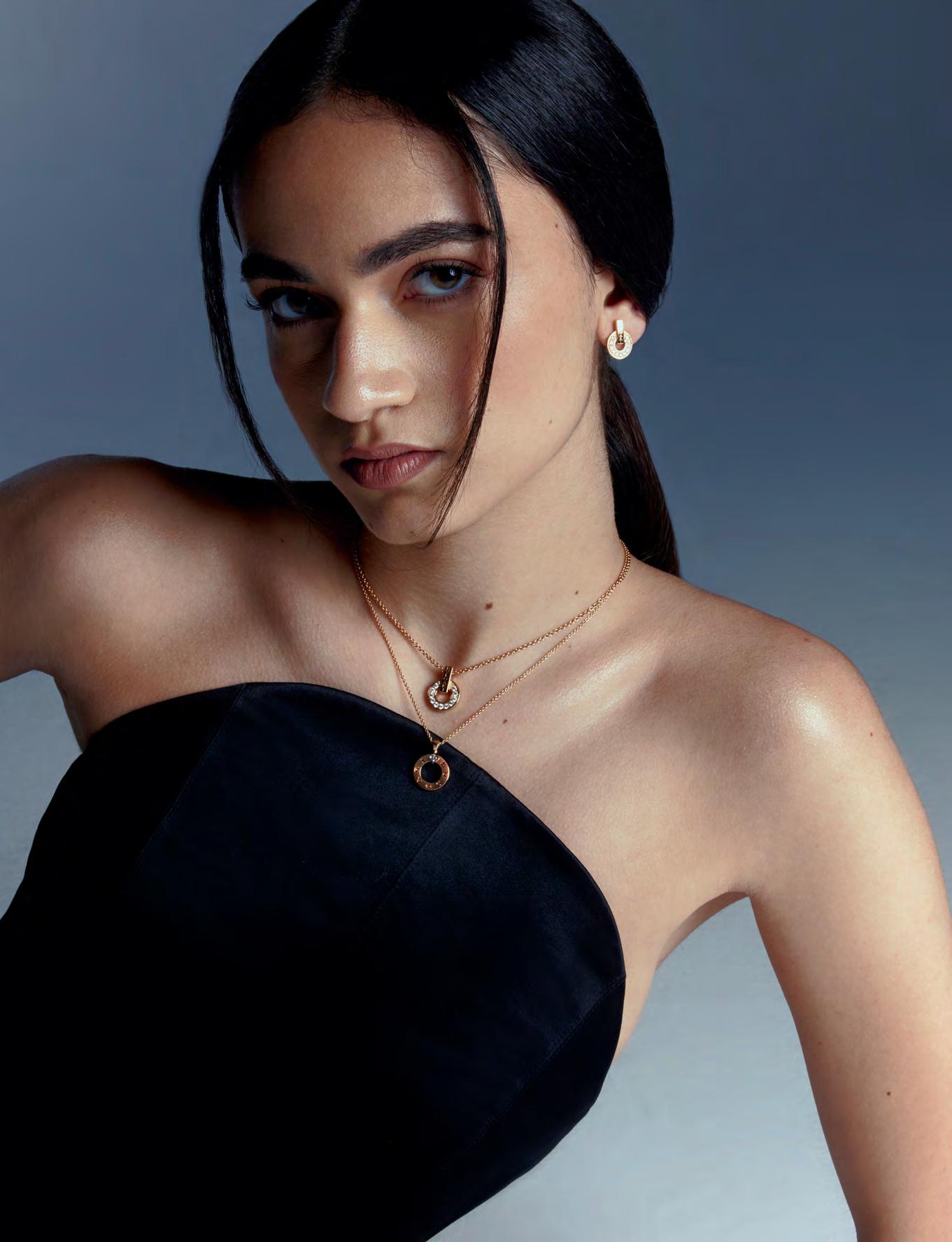 earring, necklaces, BULGARI. top, NAFSIKA SKOURTI
earring, necklaces, BULGARI. top, NAFSIKA SKOURTI

THIS IS YUNG THALIA ELANSARI: A RISING STAR 84-85
necklaces, rings, BULGARI. dress, BOTTEGA VENETA
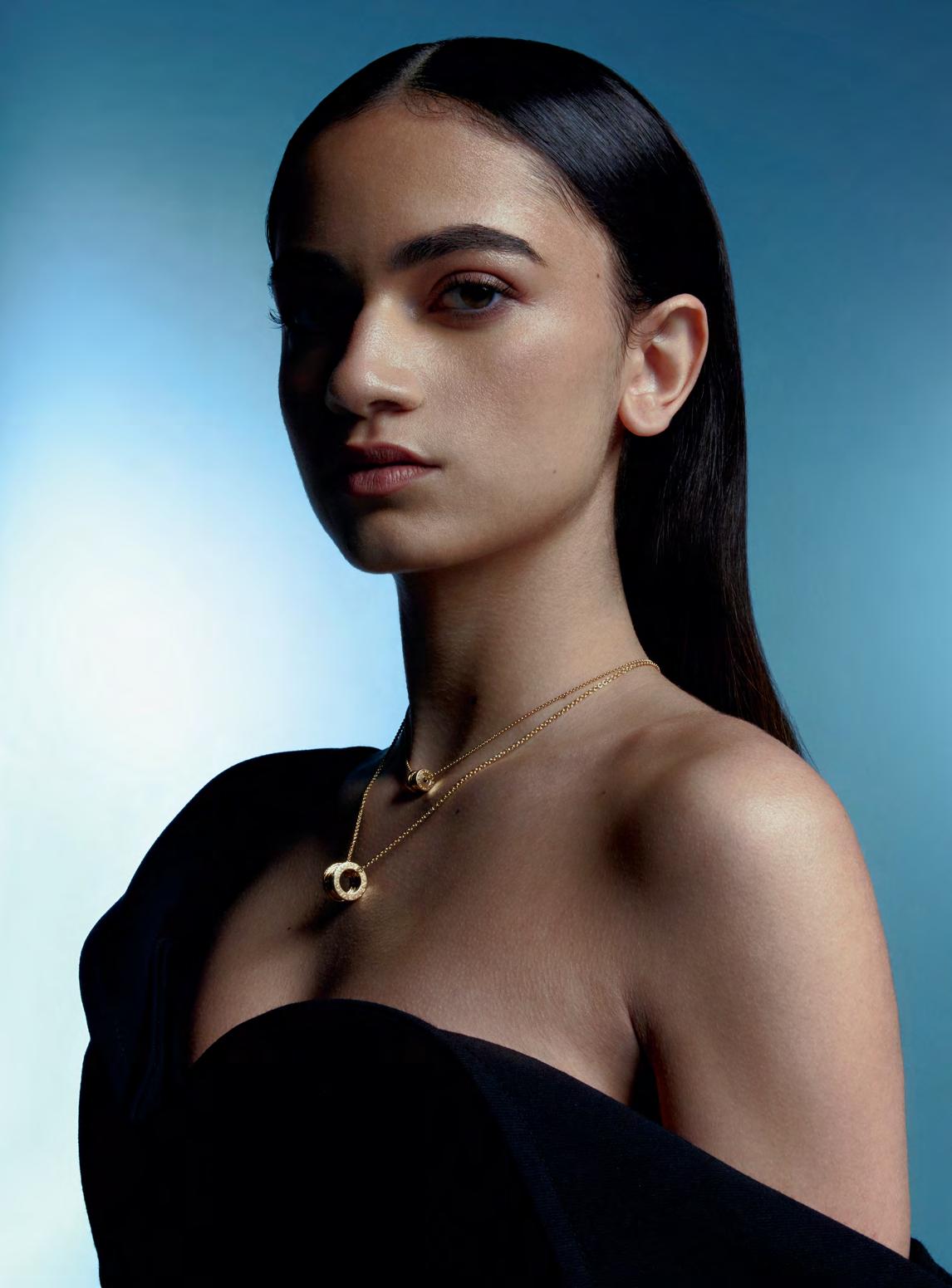 necklaces, BULGARI. dress, BOTTEGA VENETA
necklaces, BULGARI. dress, BOTTEGA VENETA

THIS IS YUNG THALIA ELANSARI: A RISING STAR 86-87
necklace, rings, BULGARI. top, jacket, skirt, TOD’S

“Looking ahead, there are a lot of things I want to accomplish in my life; first off, I do want to explore acting more, I want to build an acting career for myself; and I do want to finish school and I want to go to university. Because I’ve worked so hard, I’m not going to throw that away.”
Bayou has been crossing borders his whole life and he intends to do the same thing with his music.
UN FIL TE RED
BAYOU
words MENNA SHANAB
THIS IS YUNG BAYOU: UNFILTERED 88-89

watch, BULGARI. top, TOD’S

top, TALENT’S OWN THIS IS YUNG BAYOU: UNFILTERED 90-91
ring, bracelet, watch, BULGARI. coat, BOTTEGA
VENETA.
Lyrical messages of love come in all shapes and sizes, spanning genres, slipping into different forms, central to countless albums and songs, but when it comes to matters of the heart, nothing does it quite like R&B. With its rich cadences and soulful tempos, the genre has always been the perfect canvas for artists to paint out their deepest emotions – it’s a perennial favourite for those with who wear their hearts on their sleeves.
Velvety vocals, heartfelt lyrics and sensual rhythms, R&B has been the soundtrack to countless romantic encounters. No one knows more about this than Egyptian singer Bayou, certified lover boy and sweet-talking crooner: “I live an R&B lifestyle,” he says with a smirk. “I also experienced love and emotion in an Egyptian context back home.” Swimming in tender lyrics and soul-stirring vocals, navigating between wildly different worlds, Bayou has all the ingredients to make that timeless R&B sound we all love, one that still feels right at home in this age of hyper-globalisation.
He speaks its universal language— talking in codes underpinned by love, intimacy, desire and affection. Much like Drake’s candid lyrical narratives, Bayou also takes his listeners behind the scenes – a sneak peek into his emotional landscape. There’s this candidness. He’s not spinning tales of fiction or fantasy. Bayou’s lyrics are a reflection of his reality, there’s no fabrication, they’re genuine expressions of his feelings. “As a child, I was always so hyper, so when a feeling would hit me, it would hit me really hard. If it was anger, I couldn’t keep it in. If it was love, I had to sing,” he says, revealing the intensity with which he experiences and channels emotions into his music. A release. “In middle school, I’d be writing love songs for girls. It was almost like I wasn’t writing it for them, I was writing it for me. To get it out of me. I’m like what am I gonna do with all this love?”
“One
word to describe Bulgari Studio’s essence
would be innovative.”
He took this whirlwind of feelings and poured it into his music, turning what was inside out and into melodies and lyrics that hit home for anyone who listens, crafting a novel yet familiar iteration of R&B. With robust backbeats, syncopated rhythms, and often dominant bass lines, R&B exudes a groove that’s hard to resist. Bayou taps into that with effortless finesse, infusing it with Middle Eastern motifs to fit his unique cultural experience. But R&B is no stranger to change. As a genre, it has evolved over the decades, incorporating elements of funk, soul, hip-hop and pop, shifting from jazz to hip-hop, becoming more synth-heavy, dancey, futuristic, melding decades’ worth of sounds together.
Bayou, who has navigated multiple cultures throughout his life, embodies this evolution. His personal exploration of R&B showcases how the genre’s universal language of love and intimacy can be adapted to reflect a diversity of cultural influences, while remaining true to its soul. Born in Saudi Arabia, raised in Dubai, with roots in Egypt and now based in the U.S, Bayou has been crossing borders his whole life and he intends to do the same thing with his music.

THIS IS YUNG BAYOU: UNFILTERED 92-93
rings, bracelet, BULGARI. top, BOTTEGA VENETA
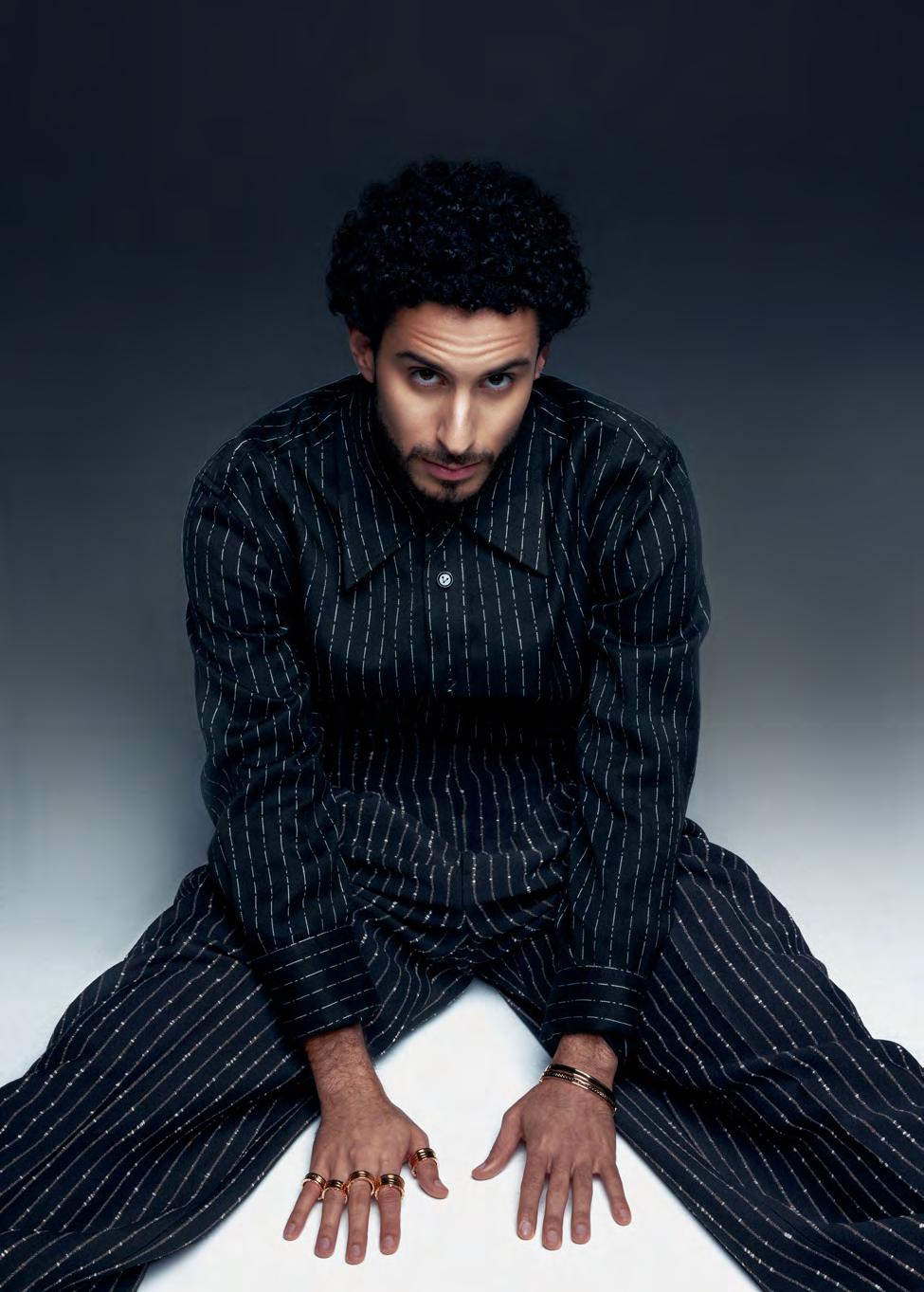 rings, bracelet, BULGARI. top, pants, BOTTEGA VENETA
rings, bracelet, BULGARI. top, pants, BOTTEGA VENETA

rings,
BULGARI. vest, PRADA THIS IS YUNG BAYOU: UNFILTERED 94-95
bracelets, neklaces,

Initially on a path to professional football, Bayou’s career took an unexpected turn due to a torn ACL, leading him to trek down the music path. With the same intensity and dedication he applied to sports, Bayou now invests his efforts into honing his musical talents.

THIS IS YUNG BAYOU: UNFILTERED 96-97
necklaces, ring BULGARI. jacket, LORO PIANA
From writing love ballads to girls in Middle School, to touring the world with his music, love remains the central theme of Bayou’s sonic adventures. Weaving heartfelt moments with sounds from back home, he is moulding a distinct musical identity with bold experimentation and a vision that truly transcends traditional boundaries and genres. But, he has a sweet spot for R&B. “I love the way you can get lost in it. R&B artists create music that becomes your world. You listen to it and you’re in their world,” he muses. “It has that soul to it. It’s very emotional. Subject matter-wise, if you love in English and experience love in English, then R&B draws you in more, naturally. So I think even as an Arab kid, since I was English-speaking, it hit home with me because this is how I experienced love,” he reflects.
A true third culture kid, Bayou represents a generation of younger Arabs who are blurring the boundaries of culture to make music that still feels like home. As he explains it: “There’s three nodes to my music. There’s R&B. There’s the Egyptian pop side of it and there’s the identity part, me as the third culture kid. Clearly I’m an Arab man, living in the West, Egyptian passport. There’s two characters. It’s the east meeting the west. It’s my life.”
Navigating the fusion of different cultural sounds, Bayou approaches the challenge with precision. It’s a delicate dance, channelling this third culture kid experience, while trying to not veer into clichés or tropes, especially when it comes to fusing Middle Eastern motifs with western sounds. “When you’re trying to mix cultures together, you walk a really thin line. You can be cringe for both sides. I work with MENA-based producers who are about the culture, living in the region. So, they always keep the vibe in check. I try my best to stay in touch and understand both sides and the current state of the culture.”
This cultural interplay is also reflected in Bayou’s deep fascination with the power of the voice as an instrument that can convey a vast array of emotions across different cultures. His artistic expression is influenced by this fascination, exploring the voice’s capability to echo the human experience in music. This exploration, rooted in his affinity for R&B, indie, and the “moody” soundtracks of his formative years, mirrors the wider emotional spectrum that today’s youth express through various music genres, from the aggressive pulse of drill music to the introspective depths of emo. “Because this is what life feels like,” he explains. “So, growing up it was always about gravitating towards the extremes.”
Initially on a path to professional football, Bayou’s career took an unexpected turn due to a torn ACL, leading him to trek down the music path. With the same intensity and dedication he applied to sports, Bayou now invests his efforts into honing his musical talents, He openly admits, “I didn’t always have a nice voice. I just enjoyed singing,” It was never about stardom or global reach for him. “Every artist, it doesn’t matter if they want to give it to the world or make it for themselves, they want to make something that they can be proud of eventually. Most people’s artistic goal is to make something they feel is worthy,” he says.
“There’s two characters. It’s the east meeting the west. It’s my life.”
One ACL down, and many serendipitous sessions in the studio later, music eventually crept its way in and became a powerful tool for Bayou. “Through music, I’ve become closer to myself. It is introspective. I learned how to communicate in a language that made sense to me.” He not only refined his artistic voice but also uncovered a deeper sense of self and identity, oh and he also made a string of hits that went global, earning the love of fans both in the East and West. His breakout moment came in 2019 with the release of ‘Moonlight,’ immediately catapulting him into the spotlight. Bayou’s discography includes standout tracks like ‘Dodi and Diana,’ as well as ‘Egyptian Wifey’ and ‘Casablanca.’
And collaboration, for Bayou, is more than just the merging of musical styles; it’s about the mutual exchange of ideas and experiences. He seeks out collaborators who reflect a piece of himself, aiming for a synergy that transcends the sum of its parts. “I need to see myself in them. And for them to see themselves in me. If I see something in them that is better than me and they see something in me that is better than them, then it’s a true mutual exchange of knowledge to build something greater than us, greater than you and me. That’s always what I look for in a collaboration. It doesn’t matter how big or small, it’s about what they can bring to the table in the session.”
This ethos of connection isn’t confined to the studio. It extends to his interactions with fans, whose dedication completes this circle of creative communion. “I’ve had many beautiful experiences. I’ve had multiple shows in the U.S. and Europe where fans would make the trek from other cities, states, and countries to come and see me. That’s so beautiful.” Bayou’s words go beyond simple thanks; they acknowledge a mutual journey with his fans, with his live performances creating a bond that surpasses geographical and cultural boundaries, uniting everyone involved. ■
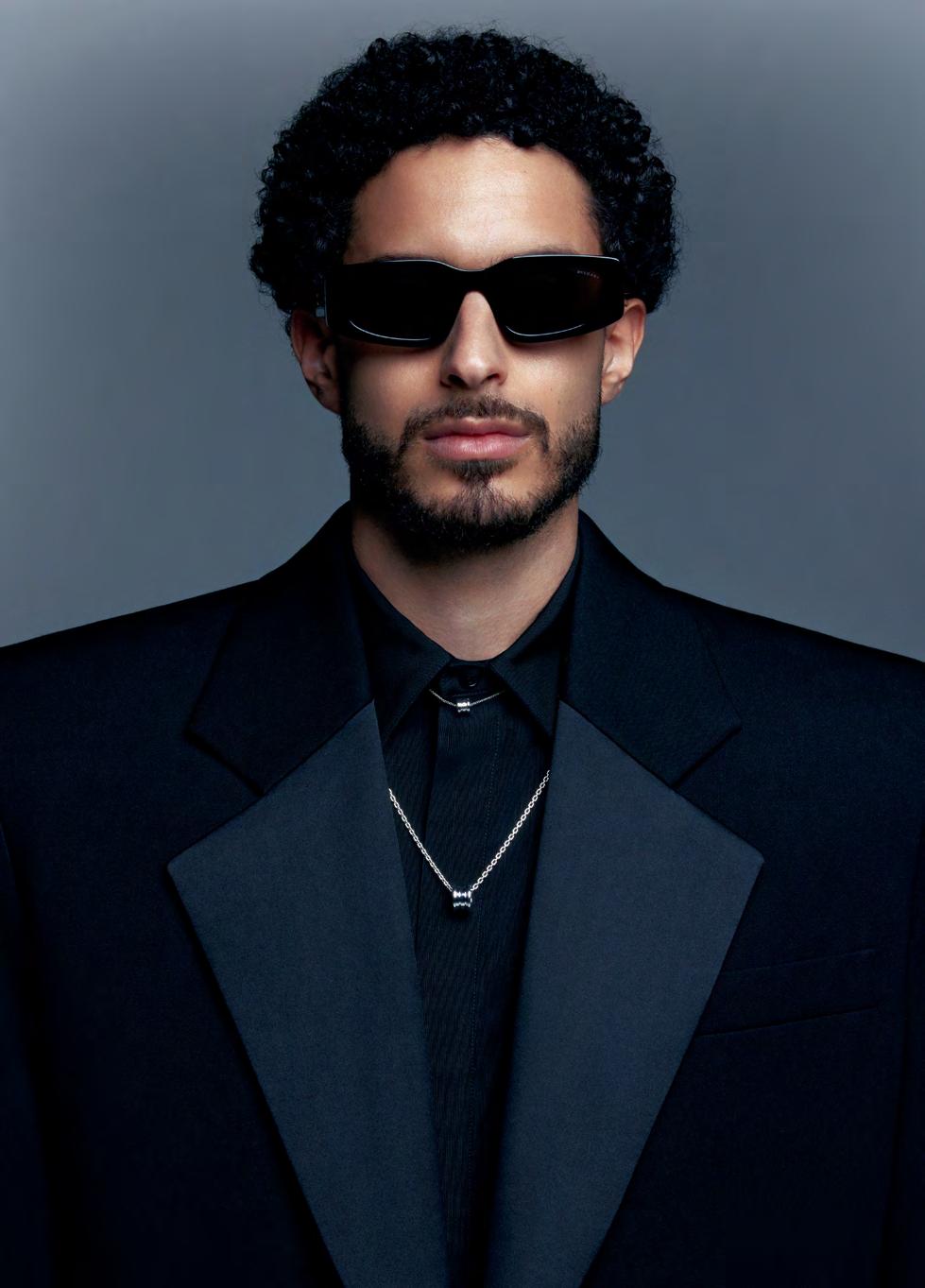
THIS IS YUNG BAYOU: UNFILTERED 98-99
sunglasses, necklaces, BULGARI. blazer, shirt, SAINT LAURENT
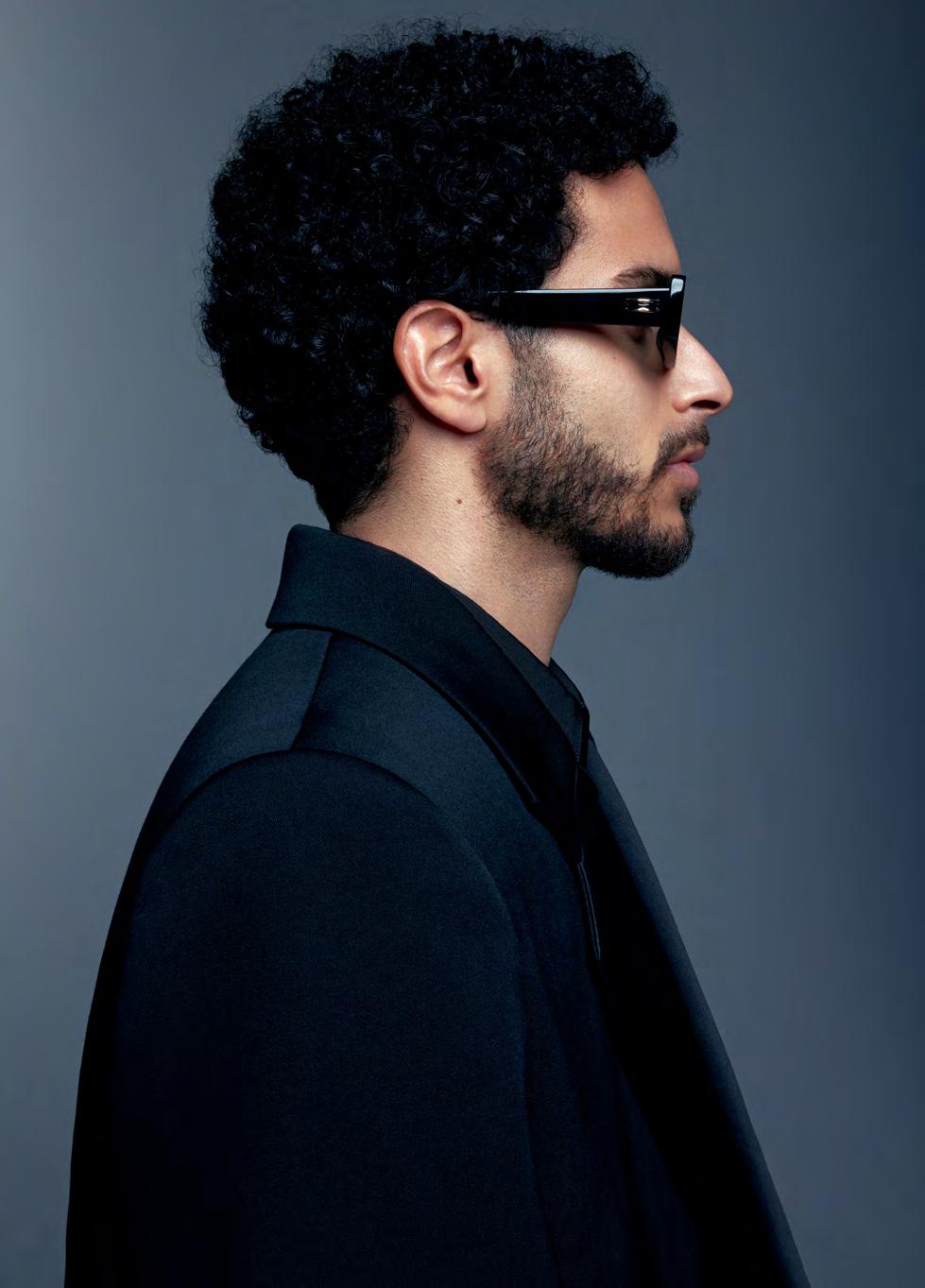
FASHIONTHIS IS YUNG FASHION & BEAUTY 100-101
& BEAUTY

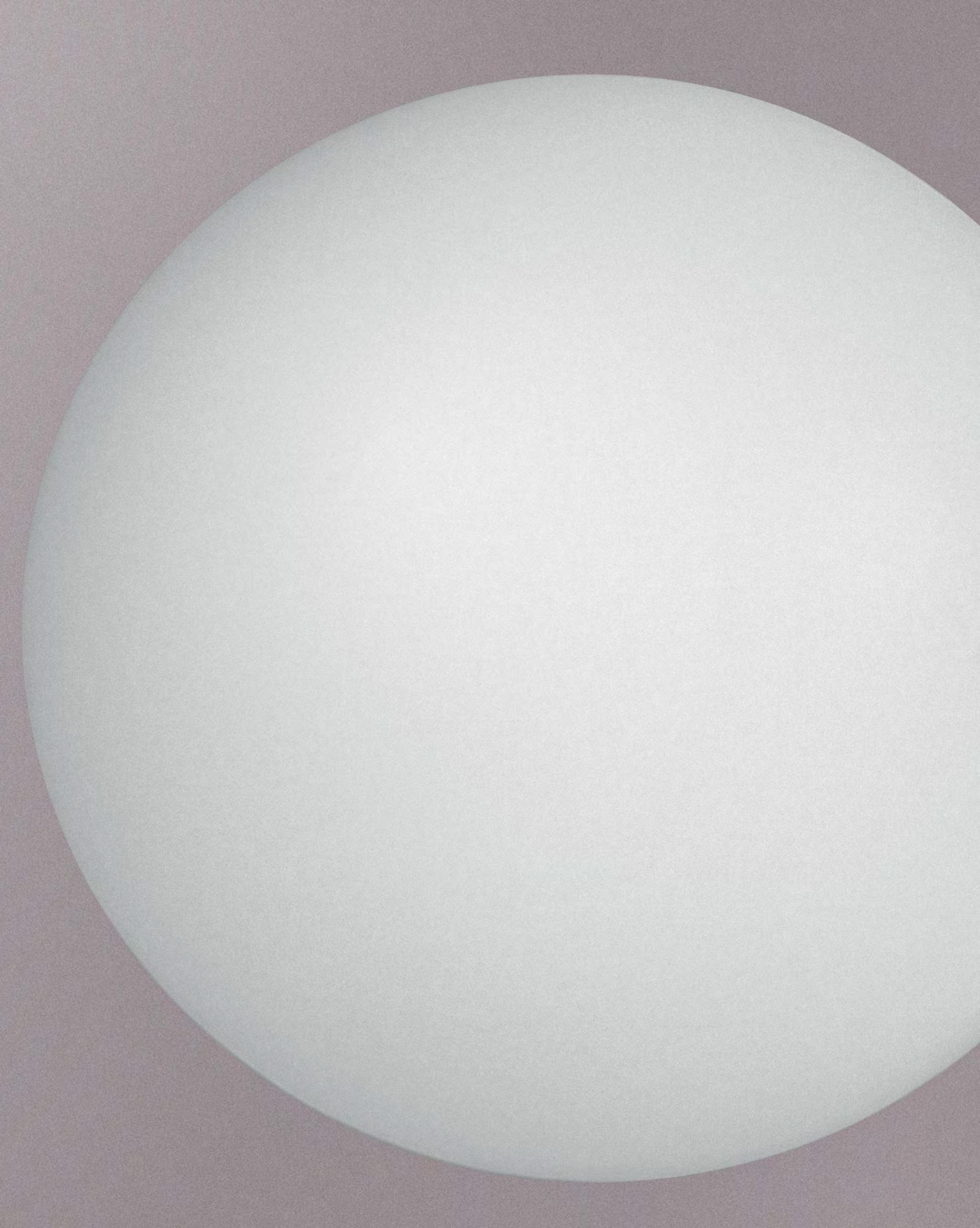

THIS IS YUNG GRAVITATIONAL ATTRACTION 102-103
 dress, VALENTINO. earrings BEA BONGIASCA
dress, VALENTINO. earrings BEA BONGIASCA
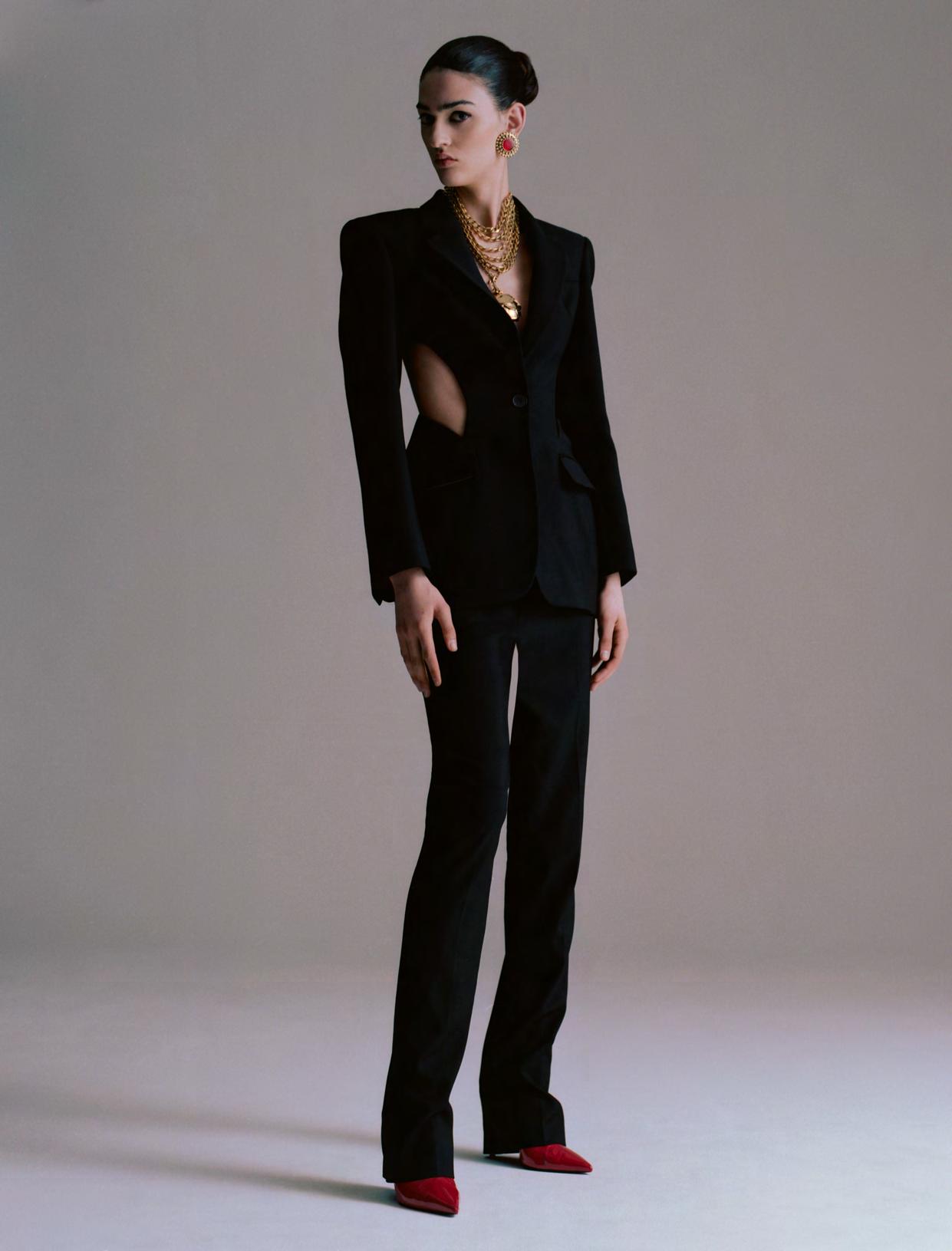 blazer, trousers, heels, rose necklace
ALEXANDER MCQUEEN.
blazer, trousers, heels, rose necklace
ALEXANDER MCQUEEN.
THIS IS YUNG GRAVITATIONAL ATTRACTION 104-105
earrings, chain necklace, STYLIST’S OWN
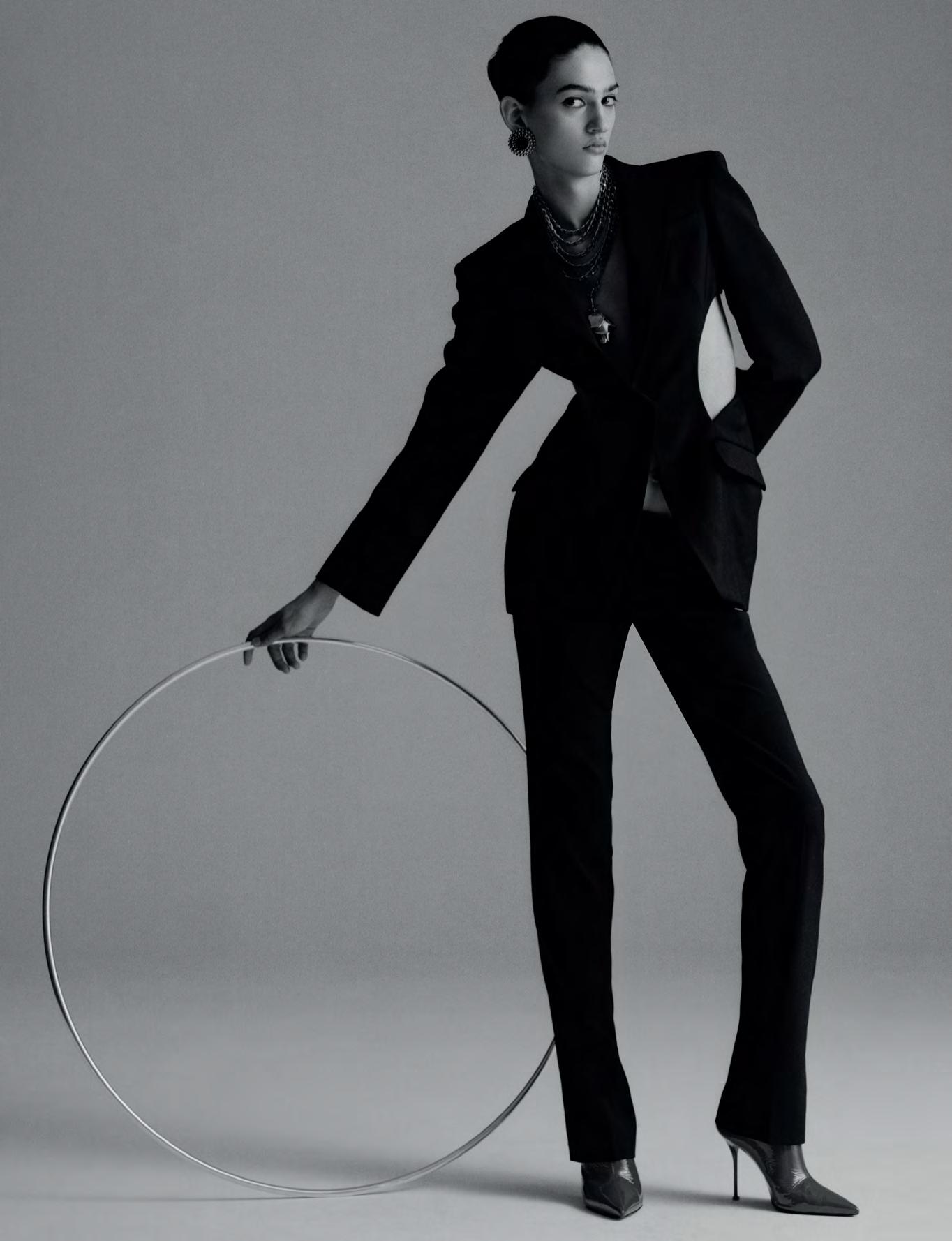
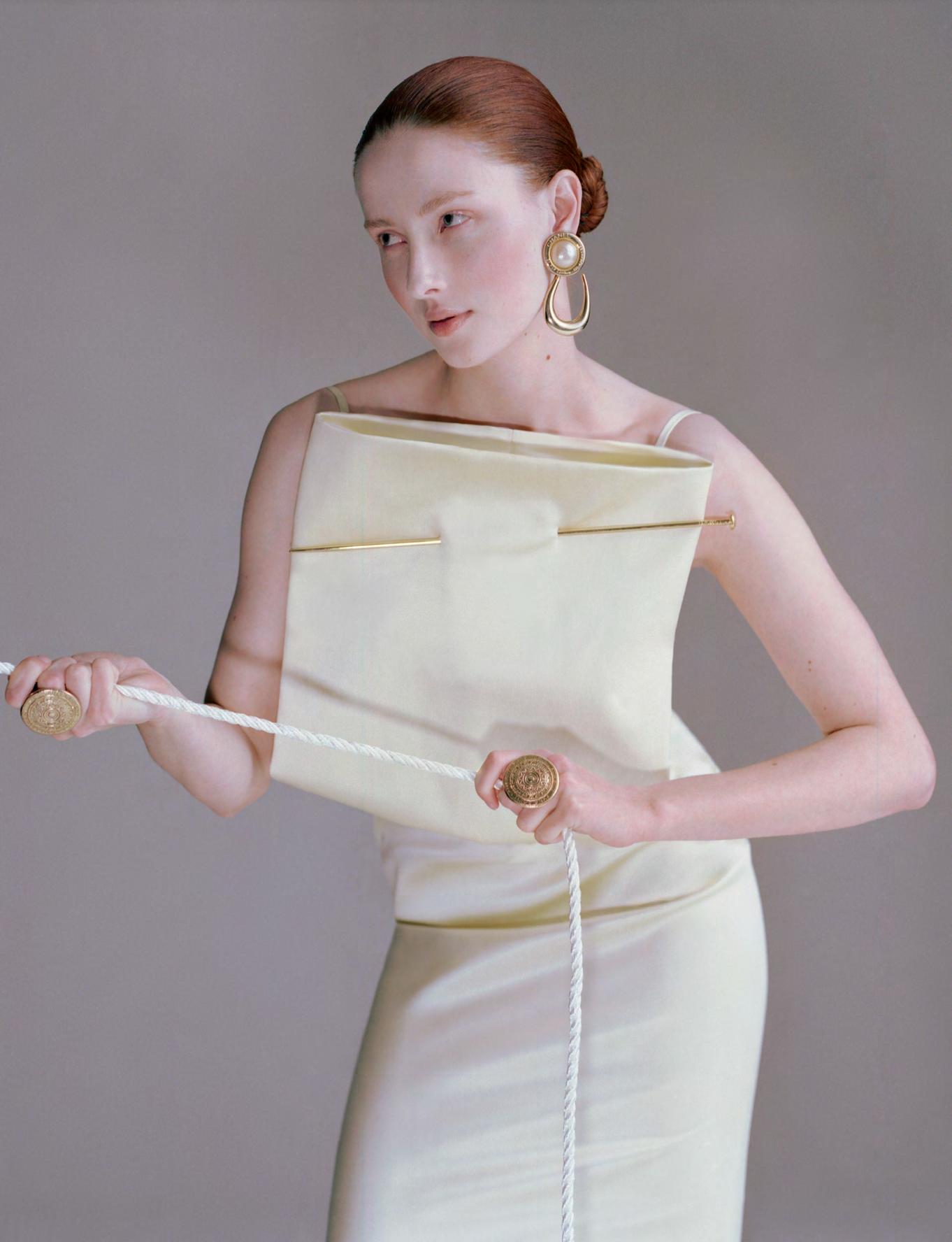
THIS IS YUNG GRAVITATIONAL ATTRACTION 106-107
dress, LOEWE. earrings, rings, STYLIST’S OWN
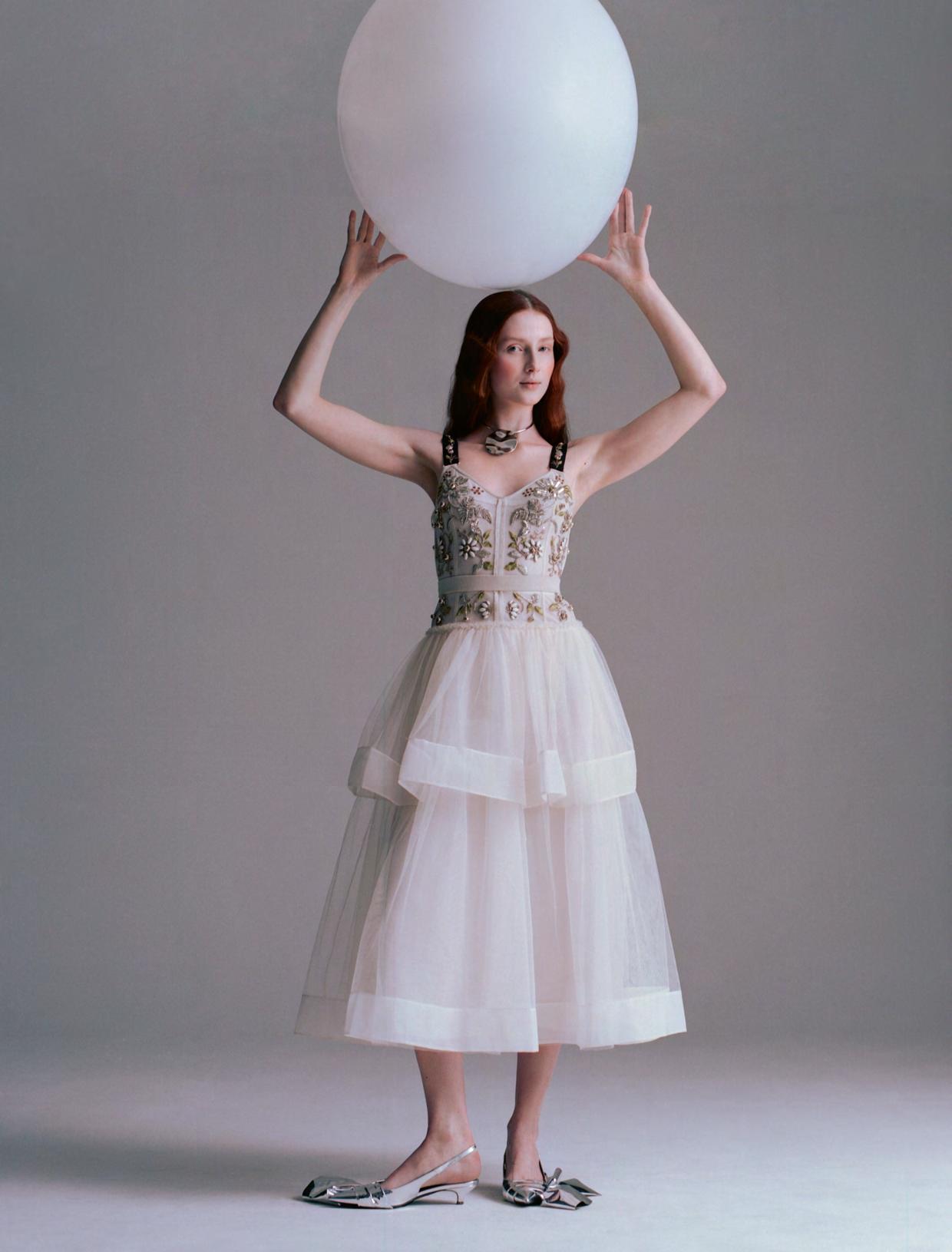 dress, heels ERDEM. necklace STYLIST’S OWN
dress, heels ERDEM. necklace STYLIST’S OWN

THIS IS YUNG GRAVITATIONAL ATTRACTION 108-109
dress, bag, heels, BOTTEGA VENETA. necklace, tights STYLIST’S OWN
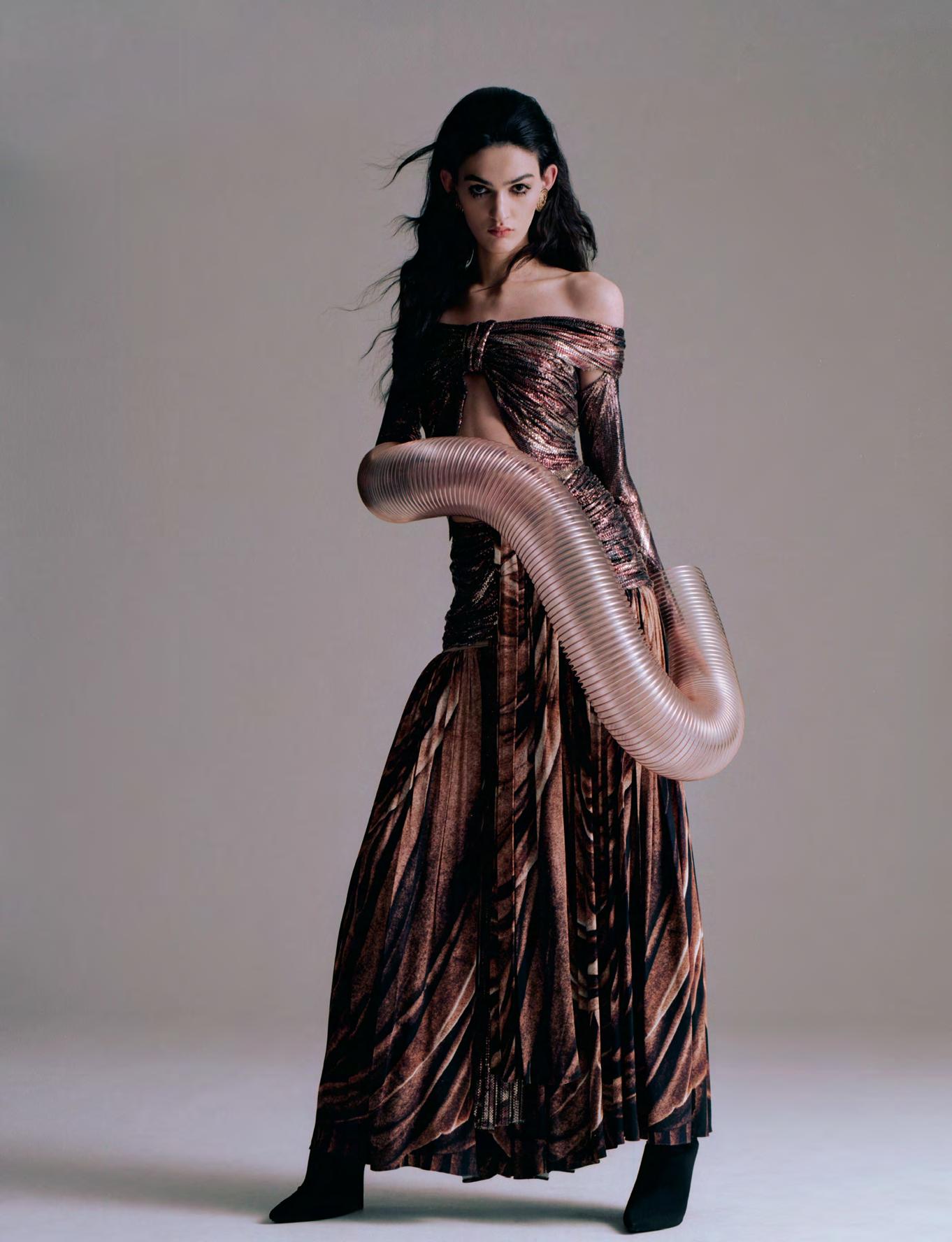 top, skirt, RABANNE. heels, earrings, STYLIST’S OWN
top, skirt, RABANNE. heels, earrings, STYLIST’S OWN

THIS IS YUNG GRAVITATIONAL ATTRACTION 110-111
dress, ERDEM. necklace STYLIST’S OWN
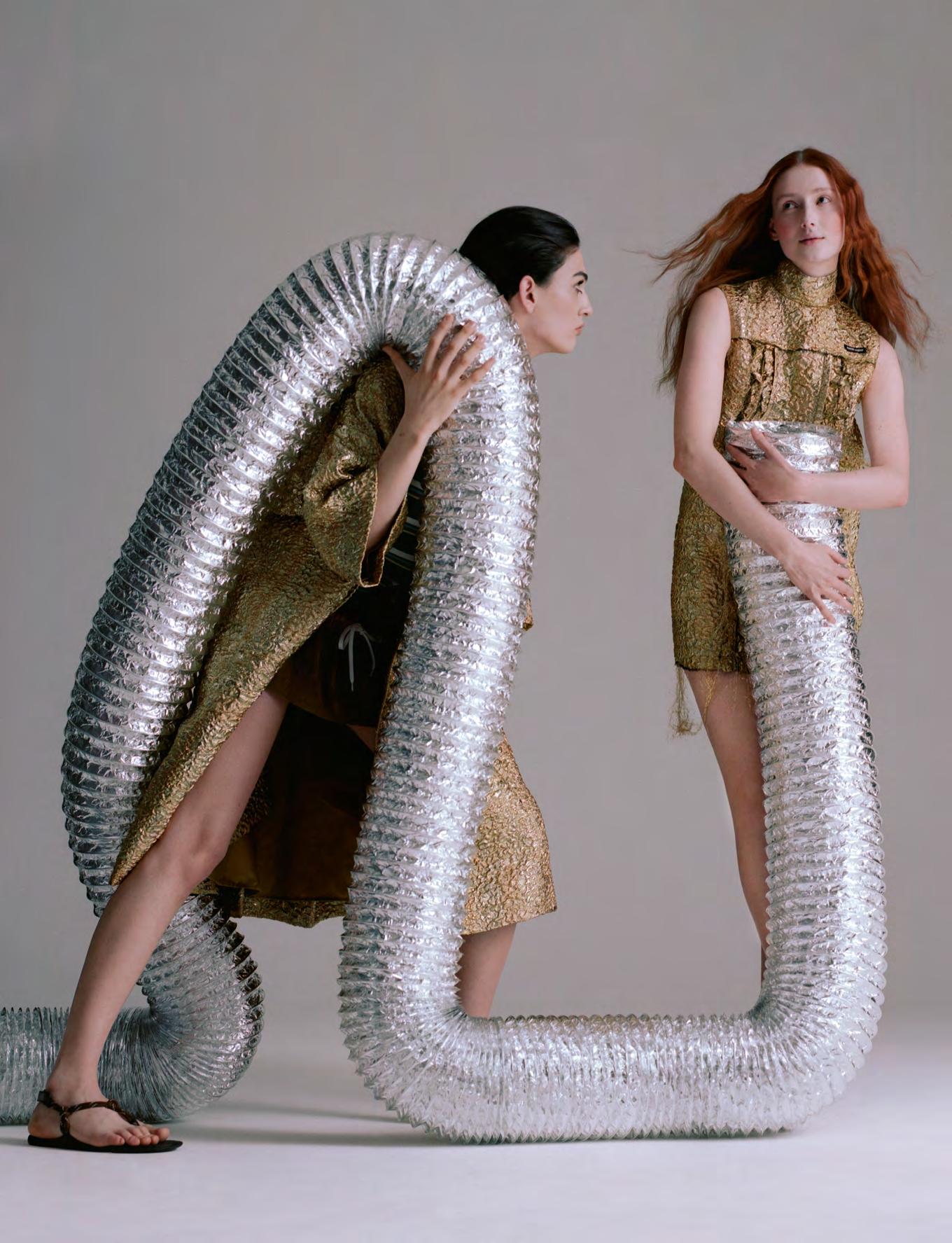
L: full look, MIU MIU R: full look, MIU MIU
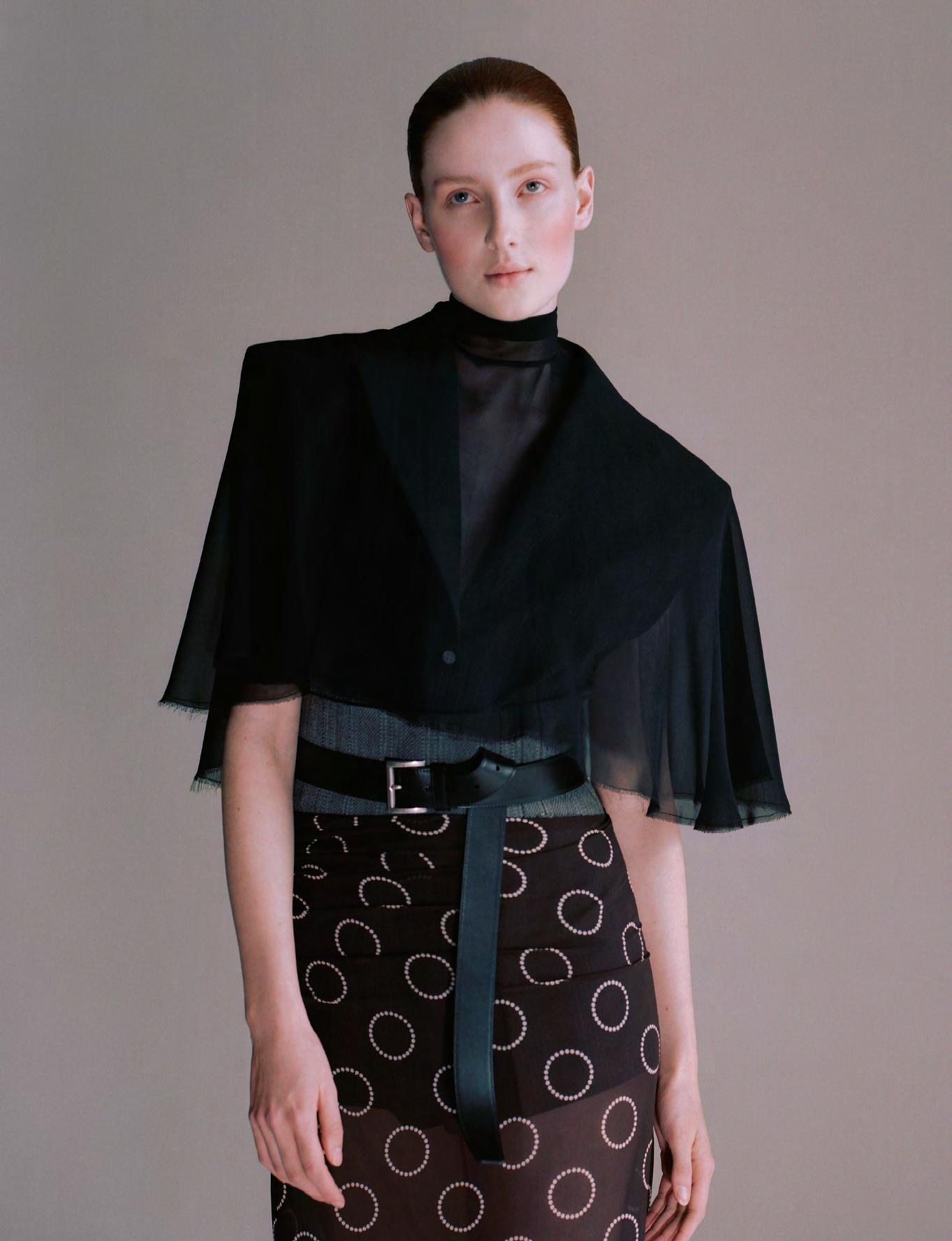
full look, PRADA THIS IS YUNG GRAVITATIONAL ATTRACTION 112-113

full look, PRADA

THIS IS YUNG GRAVITATIONAL ATTRACTION 114-115
dress, MIU MIU

LESLEY VYE, PATRICE HALLIGAN; hair JASON GOH; models LEVANT SUER at MODELS1, ALICE DE CHERADE at PRM AGENCY; lighting assistant SIMON LESLEY; set design CHLOE RAFFERTY; retouching KATY SIMS; production LANA SHASH and SAOIRSE TOUMEY, MARTA GONZALES at JJ MEDIA
dress, GUCCI makeup
GLENN’S DIESEL
words SAIF HIDAYAH
YUNG sat down with Glenn Martens, the creative mastermind behind Diesel, as we dished about all things fashion and the exciting Dubai-exclusive capsule collection.
THIS IS YUNG GLENN’S DIESEL 116-117
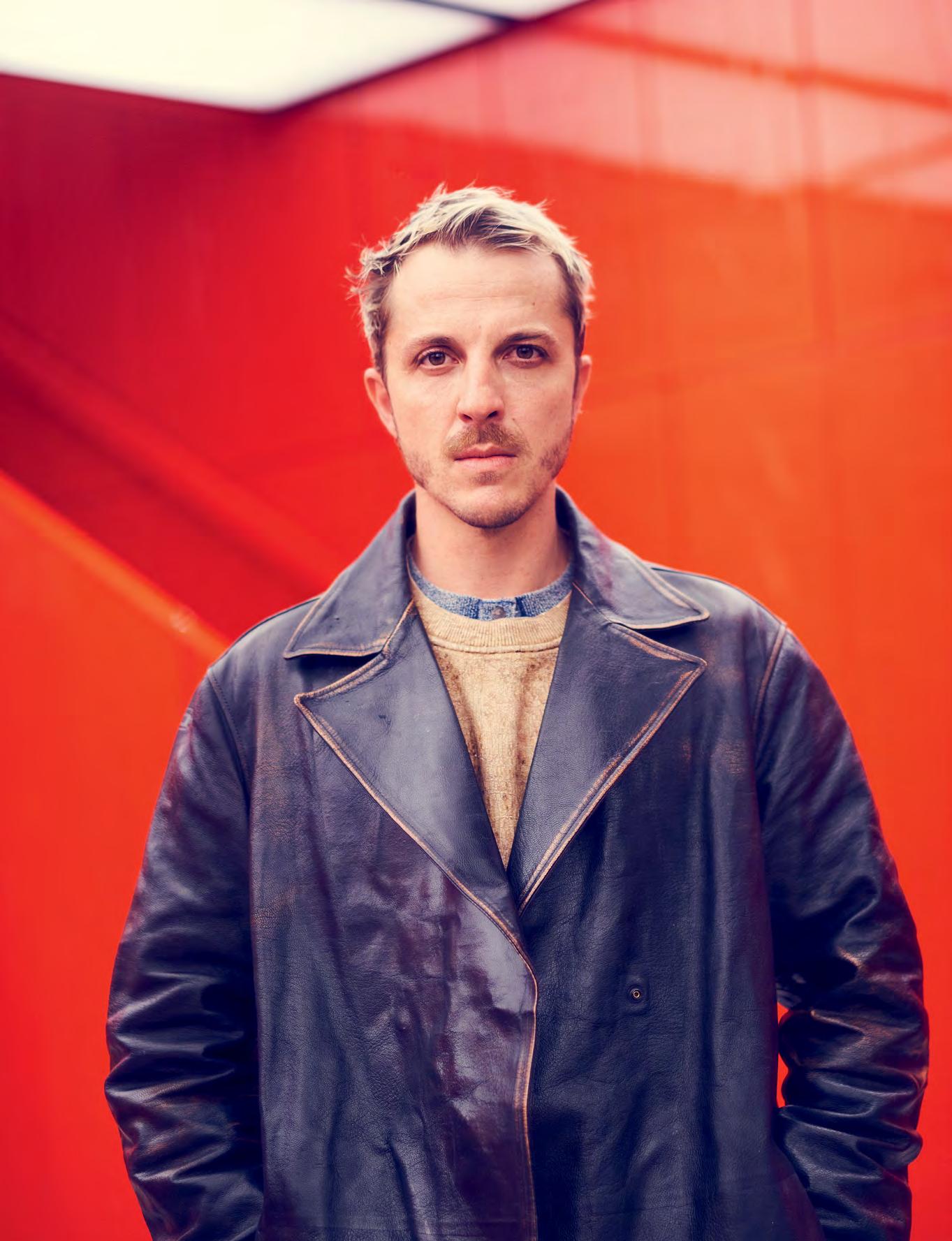
Hailing from Bruges, Belgium, Glenn Martens emerges as a beacon of creative metamorphosis. Celebrated for his bold ingenuity and penchant for defying conventions, Martens is currently at the helm as creative director at both Y/Project and Diesel. With each new collection, he commands the attention of the fashion world, leaving an indelible mark as a trailblazer in the industry.
Diesel’s recent launch of an exclusive Dubai Capsule Collection marks a significant moment in the brand’s storied history. With a bold fusion of identity, individualism, freedom, and irreverence, the collection embodies Diesel’s unmistakable spirit. Celebrating the reopening of its regional flagship store at The Dubai Mall, a renowned shopping destination, Diesel pays homage to the vibrant culture of Dubai while staying true to its global identity. Under the visionary creative direction of Martens, Diesel’s brand essence has undergone a renaissance, captivating a new generation of fashion enthusiasts. The redesigned store, situated on the Mall’s ground floor, serves as a testament to Diesel’s creative philosophy, featuring iconic red accents and industrial metal billboards that reflect the brand’s ethos. This immersive retail experience seamlessly integrates with Diesel’s global network, offering customers a captivating journey into the heart of the brand’s innovative design ethos.
The exclusive capsule collection highlights some of the brand’s timeless classics alongside contemporary updates. The collection showcases iconic denim pieces such as the revered 2010 D-MACS and the timeless 1969 D-EBBEY, each featuring a dedicated Diesel Dubai flag and jacron patch. Complementing these staples are a range of tees, hoodies, and caps adorned with a unique ‘Dubai For Successful Living’ logo, encapsulating the city’s dynamic spirit. The collection’s pièce de résistance is the luxurious 1DR bag, embellished with a crystal-encrusted Oval D in the vibrant hues of the United Arab Emirates’ flag, epitomising Diesel’s fusion of style and sophistication.
You’ve been tasked with refuelling Diesel, a legacy denim brand, by bringing it back into the spotlight. What was that process like?
At Diesel I didn’t change the aesthetic because it is completely based on the DNA of the brand, I was just reconnecting to it; after 40 years of collections sometimes you can be lost in the translation. At the beginning it was really easy for me to understand what the brand is about so I just embodied it, put a lot of accent on it and made sure that everybody could understand what Diesel is and what Diesel stands for. Everything is really based on the brand’s DNA.
Could you share a particular project or collection that holds a special place in your heart, and why it stands out among the rest?
I grew up wearing Diesel, so for me, Diesel has always been part of pop culture. It is immediate, rebellious, full-on and with the volume turned up loud. Pop culture at Diesel is also provocative, and socially responsible.
Do you have any favourite materials or techniques that you enjoy working with?
Diesel invented distressed denim in the 1970s, and today the Diesel design studio is constantly experimenting with new disruptive ways to distress. I am so excited by their work and you can see it through the whole collection.
“Diesel invented distressed denim in the 1970s, and today the Diesel design studio is constantly experimenting with new disruptive ways to distress.”
What do you see as the most significant challenges in the fashion industry today, and how do you navigate them as a creative director?
I’m really enchanted and happy to see that people connect to garments and to the essential part of fashion, which is really the drawing and the design of real clothes.
Over the years, the fashion industry has undergone significant changes. How do you perceive the evolution of the industry, and how do you adapt to these changes?
Fashion is a never ending, changing industry; it goes extremely fast, so you can only be excited about tomorrow because you have no idea what’s happening later.
How do you balance the need for commercial success with maintaining your artistic vision and creative integrity?
We are pushing deeply in the major storylines: Denim, utility, pop and artisanal are always there, and we push experimentation with each of them. The creative focus for Diesel is really on the surface, on the experimentation of materials, colours, graphics, but trying to keep shapes as simple as possible, to let people be able to wear the collection easily, but we also like to play at Diesel, and we are serious about it. Have fun, respect each other, be safe is what Diesel stands for.
Looking back on your career, what impact do you hope to leave on the fashion industry, and what legacy would you like to create?
I think the biggest challenge ahead of me is being aware of the responsibility we have, speaking to multitudes, being engaged in society, and making sure you can accelerate the change you want to see. One thing I wish is that we can keep on growing and doing what we do and be more and more directional. ■
THIS IS YUNG GLENN’S DIESEL 118-119
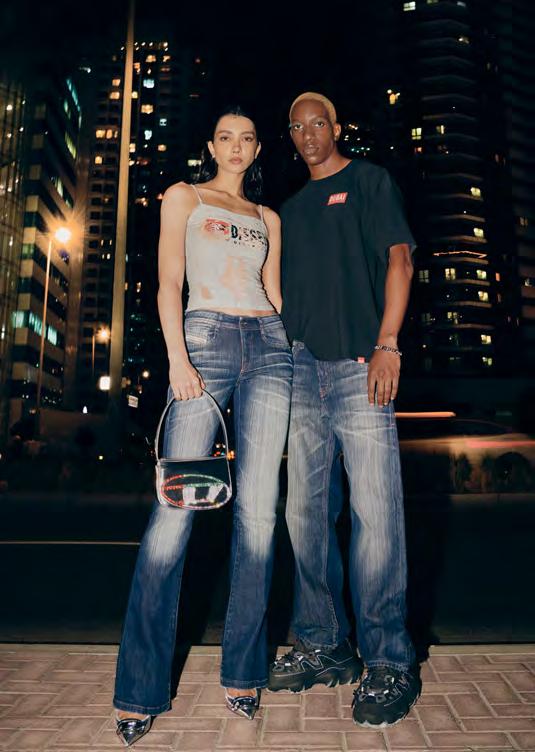



Classic elegance intertwines seamlessly with contemporary artistry, weaving together soft textures and muted tones to craft a timeless masterpiece. When deployed with such skill, the use of makeup often employs subtle creams, powders, and delicate textures reminiscent of a more refined era. This editorial transcends the mere application of makeup —it’s a journey into the sophistication of bygone eras. From Gatsby-inspired glamour to Old Hollywood sophistication, here we find white texture makeup imbued with vintage charm, celebrating grace, subtlety, and enduring beauty. It whispers of a time when every detail was a masterpiece, and every glance held a story, making it a timeless choice for those seeking to capture the essence of bygone elegance.
W HI TE
photography KATERINA KIRTOKA makeup SHARBEL HASBANY
THIS IS YUNG WHITE 120-121
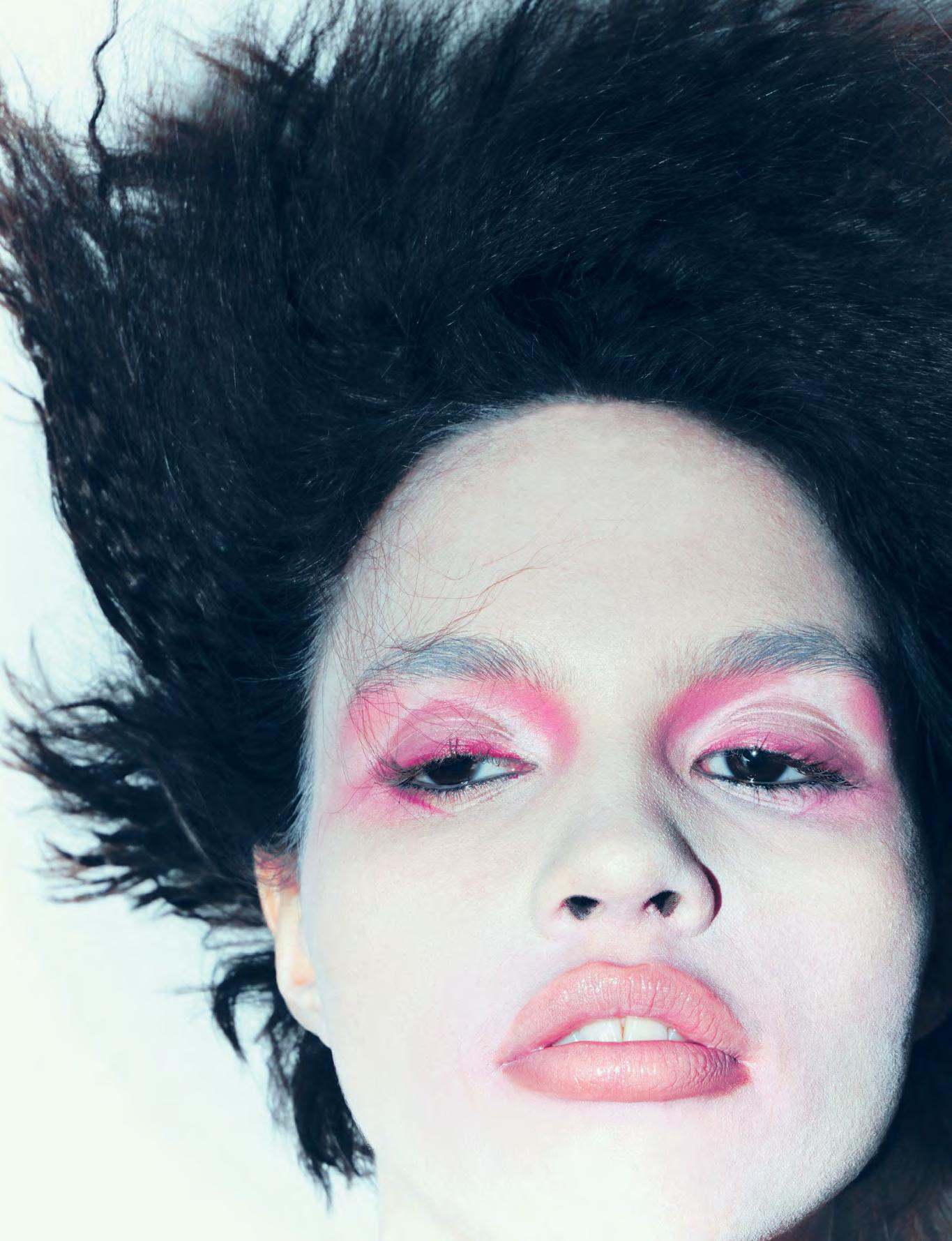
base: liquid metal shot, colorshot 69 1969, RABANNE BEAUTY.
lips: famous lipcolor matte 350jai un crush, RABANNE BEAUTY.
eyes: famous mascara, famous lipcolor matte 350 - jai un crush, RABANNE BEAUTY

base: liquid metal shot, colorshot 69 1969, RABANNE BEAUTY.
eyes: famous mascara, color shot 03 friend zone, 60 sunset flare, RABANNE BEAUTY
THIS IS YUNG 122-123 WHITE
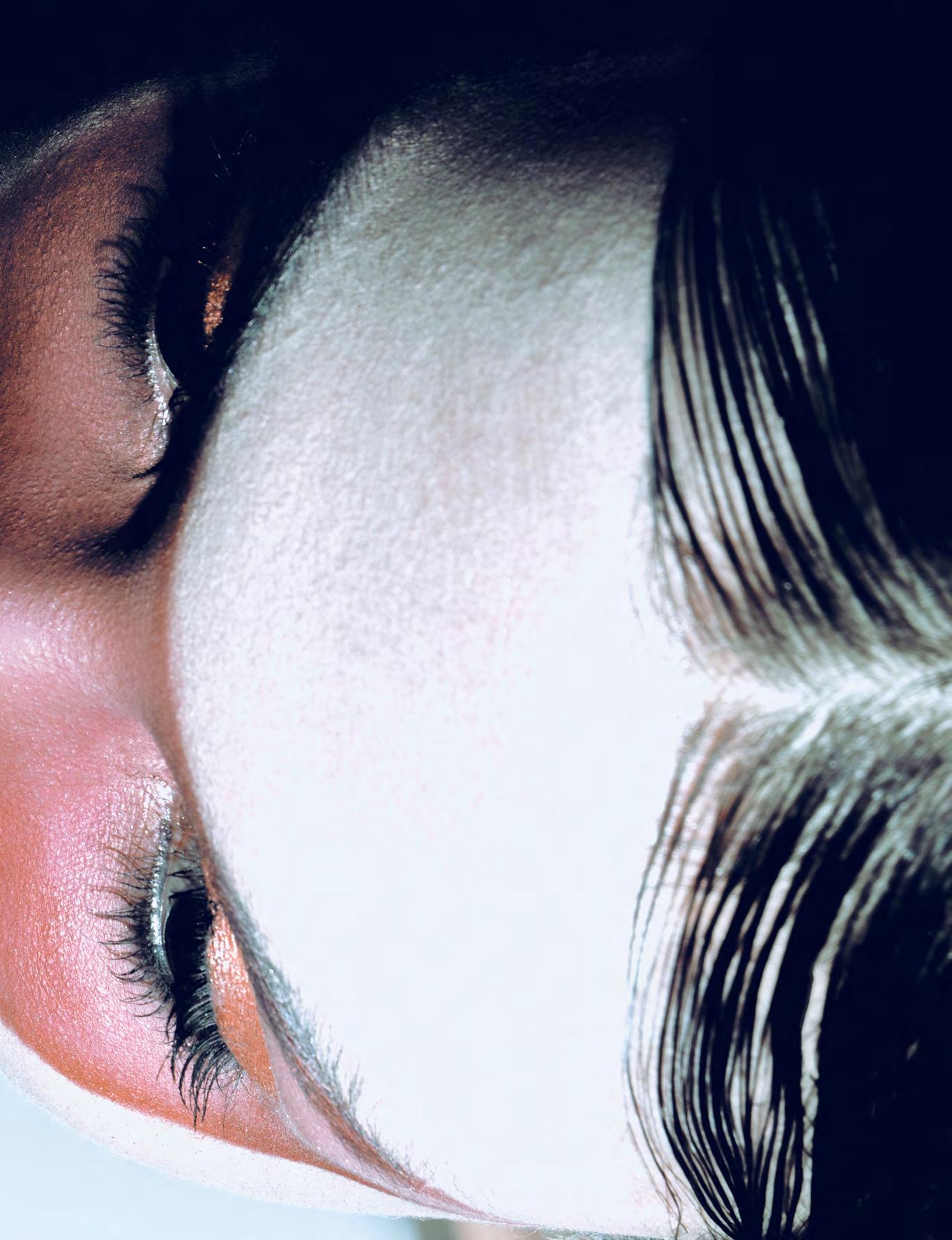

THIS IS YUNG WHITE 124-125
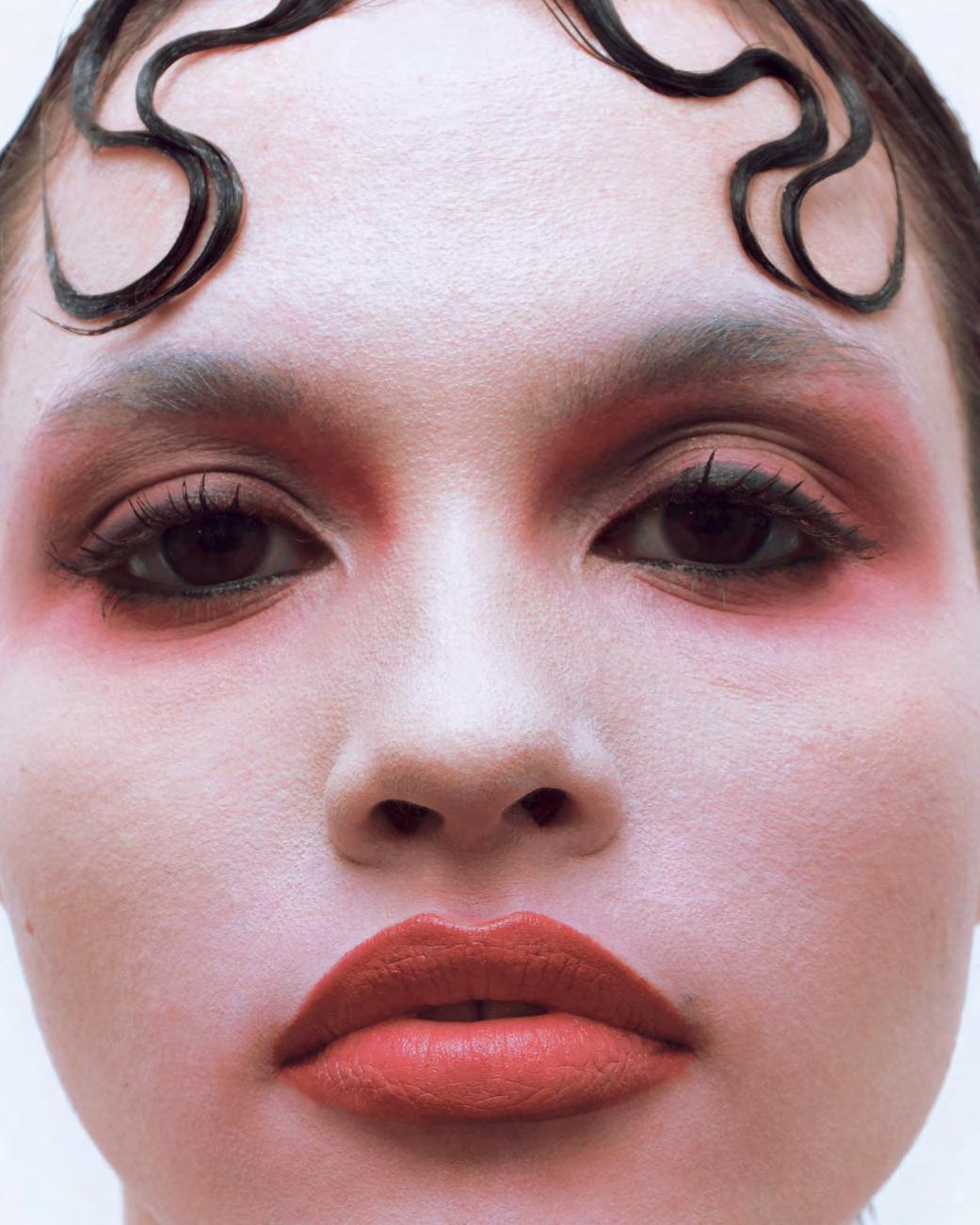
base: liquid metal shot, colorshot 69 1969, RABANNE BEAUTY. lips: famous lip color matte 689 - red realness, RABANNE BEAUTY. eyes: famous mascara, handbag palette - no more drama, unnatural palette, RABANNE BEAUTY

base: liquid metal shot, colorshot 69 1969, RABANNE BEAUTY.
lips: famous lipcolor matte 350jai un crush, RABANNE BEAUTY.
eyes: famous mascara, famous lipcolor matte 350 - jai un crush, RABANNE BEAUTY
THIS IS YUNG 126-127 WHITE



THIS IS YUNG WHITE 128-129
base: liquid metal shot, colorshot 69 1969, RABANNE BEAUTY. lips: famous lip color matte - 110 idée fixe, liquid metal shot, RABANNE BEAUTY. eyes: famous mascara, color shot - 03 friendzone, RABANNE BEAUTY model AMELIA at IZAIO MANAGEMENT

COME INTO LIGHT
photography FOUAD TADROS styling AHMED RASHWAN
THIS IS YUNG COME INTO THE LIGHT 130-131
In this special Chanel feature, we’re shining a light on some dazzling fine jewellery pieces from Chanel’s Coco Crush 2024 collection, N°5, alongside the stunning Première Édition Originale timepiece.
The Coco Crush collection is all about careful craftsmanship. Each piece tells a story of elegance and sophistication, with clean lines and graceful curves blending strength with delicacy, simplicity with luxury, and softness with precision.
Check out the latest additions, like mini bracelets available in beige gold, yellow gold, or white gold, with or without sparkling diamonds. They feature a unique coco twist clasp for easy opening and closing, offering endless possibilities.
COME INTO THE LIGHT
Chanel’s Fine Jewelry Creation Studio takes things up a notch by adding diamonds to highlight the iconic number 5, a symbol close to Gabrielle Chanel’s heart. This editorial features the Extrait De N°5 necklace, made of 18K beige gold and adorned with stunning diamonds, reflecting the House’s bold spirit.
The Première Édition Originale watch isn’t just an accessory; it’s a statement. Inspired by Chanel’s timeless style, its design is reminiscent of the N°5 fragrance bottle stopper. The chain bracelet woven with leather pays homage to Chanel’s iconic handbags. And the black-lacquer dial with golden hands, without any numbers, captures Chanel’s spirit of freedom and audacity.
Watch as the light comes into play, each piece shining through to tell its unique story.
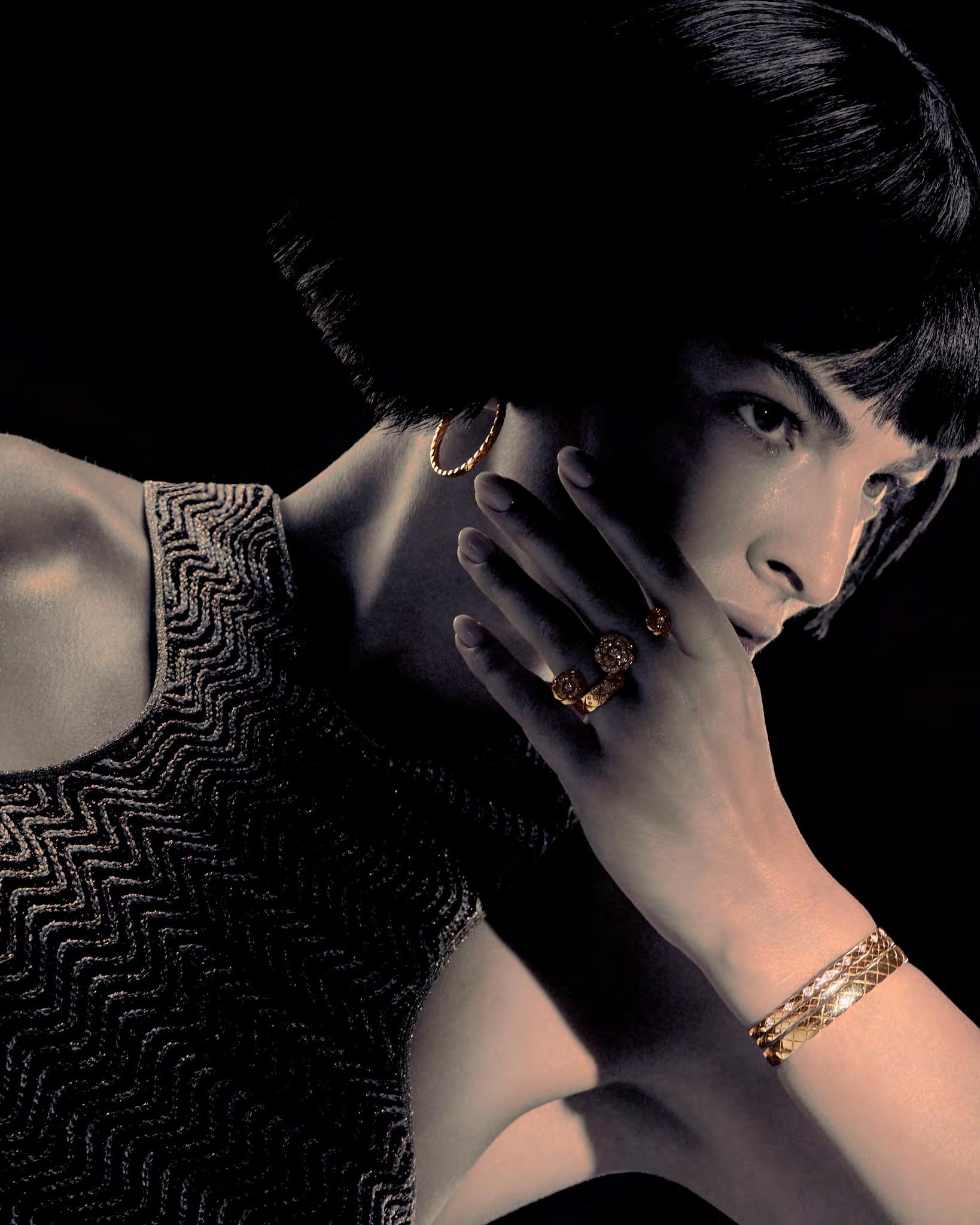
THIS IS YUNG COME INTO THE LIGHT 132-133
“EXTRAIT DE CAMÉLIA” transformable ring in pink gold and diamonds, “COCO CRUSH” earrings, rings and bracelets in yellow gold and diamond, all CHANEL FINE JEWELRY
 “COCO CRUSH” necklaces in yellow gold, white gold and diamonds, all CHANEL FINE JEWELRY
“COCO CRUSH” necklaces in yellow gold, white gold and diamonds, all CHANEL FINE JEWELRY
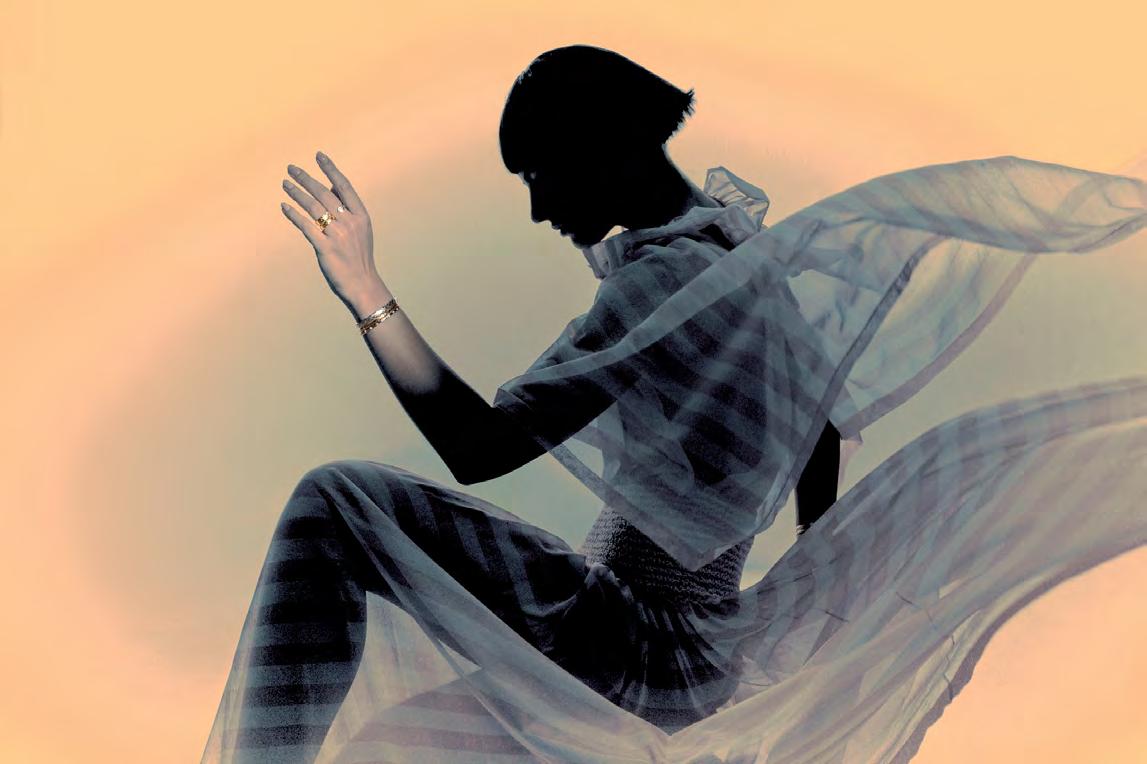
PREMIÈRE ORIGINAL EDITION”
watch, CHANEL WATCHES.
THIS IS YUNG COME INTO THE LIGHT 134-135
“COCO CRUSH” rings and bracelets in yellow gold, white gold and diamonds, all CHANEL FINE JEWELRY
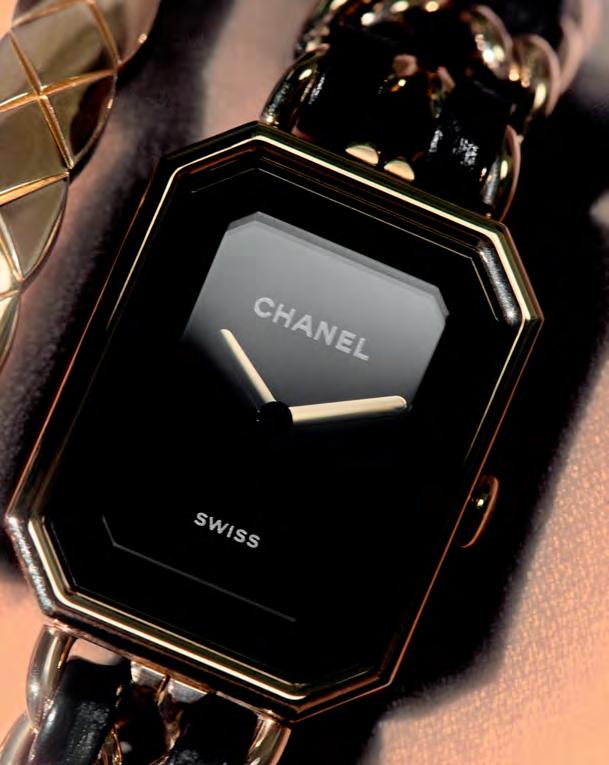
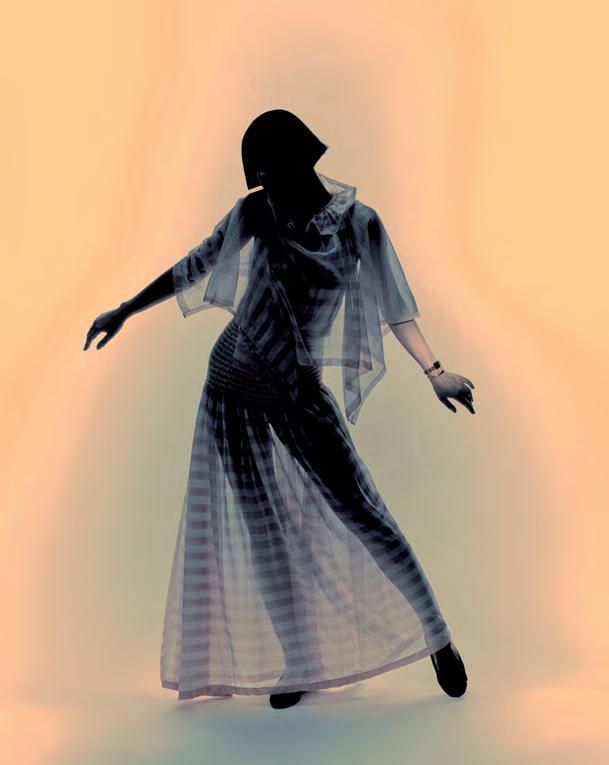

THIS IS YUNG COME INTO THE LIGHT 136-137
“COCO CRUSH” and “ETERNAL N°5” necklaces and earrings in beige gold, yellow gold and diamonds, all CHANEL FINE JEWELRY
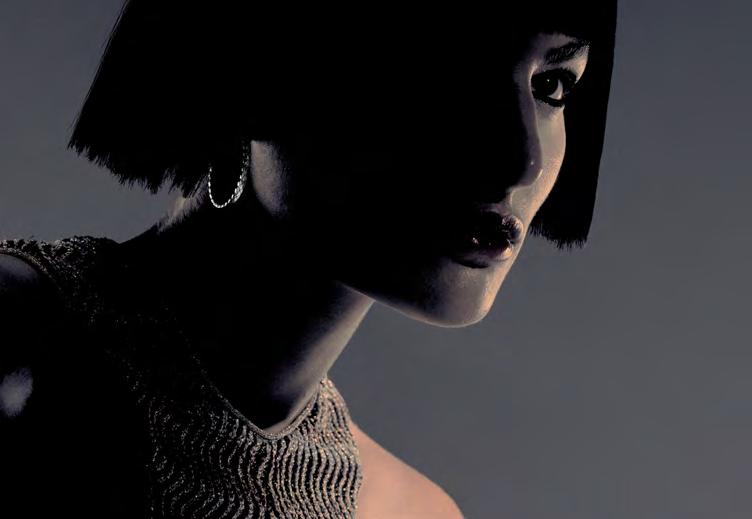

 “COCO CRUSH” rings and earrings in white god, yellow gold and diamonds, all CHANEL FINE JEWELRY
“COCO CRUSH” rings and earrings in white god, yellow gold and diamonds, all CHANEL FINE JEWELRY
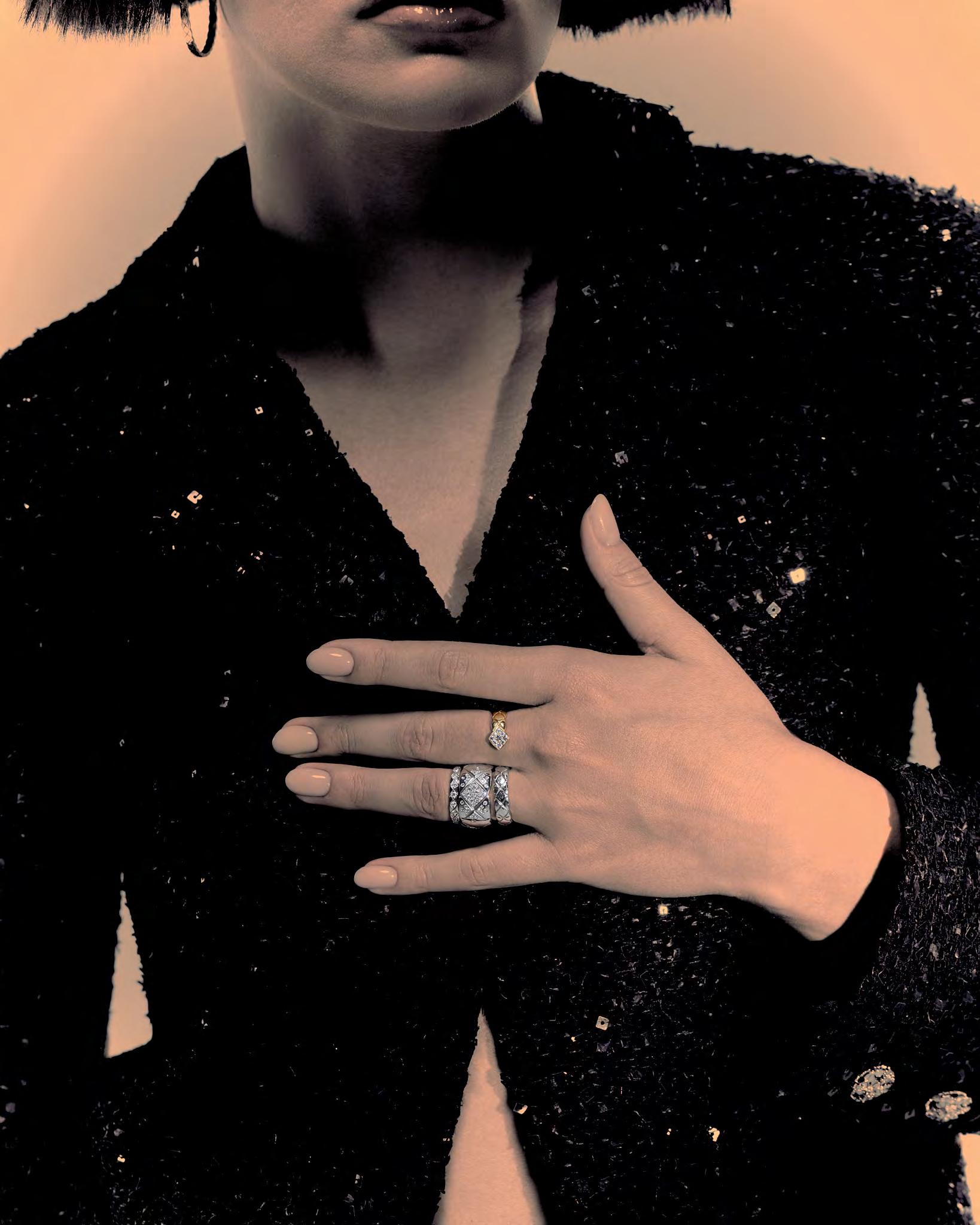
THIS IS YUNG COME INTO THE LIGHT 138-139
“COCO CRUSH” rings and earrings in yellow gold, white gold and diamonds,all CHANEL FINE JEWELRY
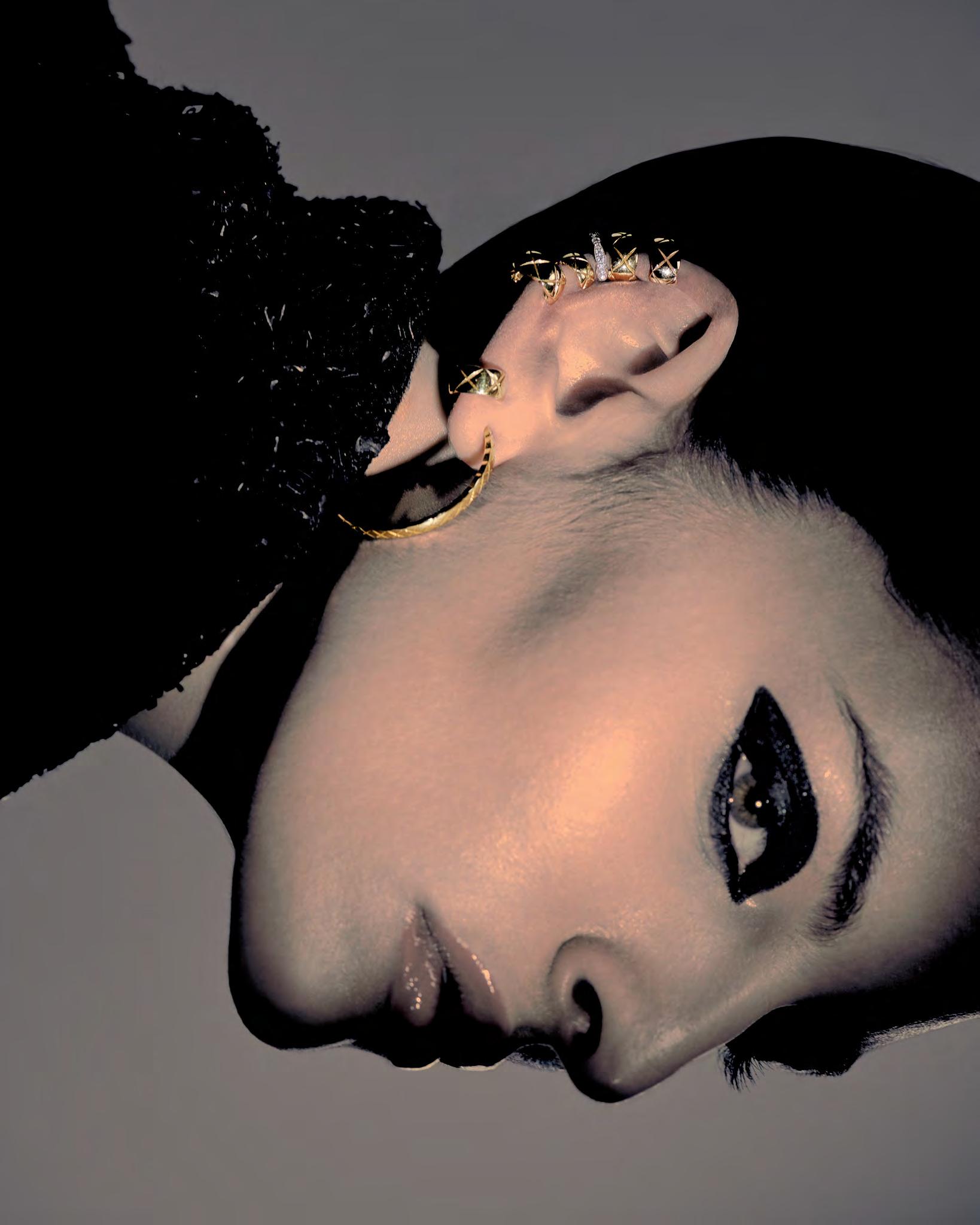
Spring-Summer 2024 Ready-to-Wear Collection”
“COCO CRUSH” earrings in yellow gold and diamonds, all CHANEL FINE JEWELRY creative direction SAIF HIDAYAH; makeup MICHEL KIAWARKIS; hair DEENA ALAWAID; model LIGA LIEPINA at MICHELLE HAY MANAGEMENT; photography assistant JAMES AQUILLANO; styling assistant OLIVIA GRANBERG; fashion:
“CHANEL
ON THE MO VE
Three men are on the move, each navigating a whirlwind of tasks dressed in designers including Fendi, Dior, Versace, Prada and Ferragamo. From boardroom meetings to gym sessions, they seamlessly blend work and personal commitments. With confidence and purpose, they master the urban landscape, redefining success through ambition and adaptability. In their dynamic lives, they exemplify the modern multitasker, proving that amidst the chaos, there’s the opportunity to excel in every aspect of life.

THIS IS YUNG ON THE MOVE 140-141
photography JACK CHIPPER styling SAIF HIDAYAH
 vest, shorts, DOLCE & GABBANA. gloves, STYLIST’S OWN
vest, shorts, DOLCE & GABBANA. gloves, STYLIST’S OWN

full look, VALENTINO THIS IS YUNG ON THE MOVE 142-143

full look, VALENTINO

full look, LOEWE THIS IS YUNG ON THE MOVE 144-145
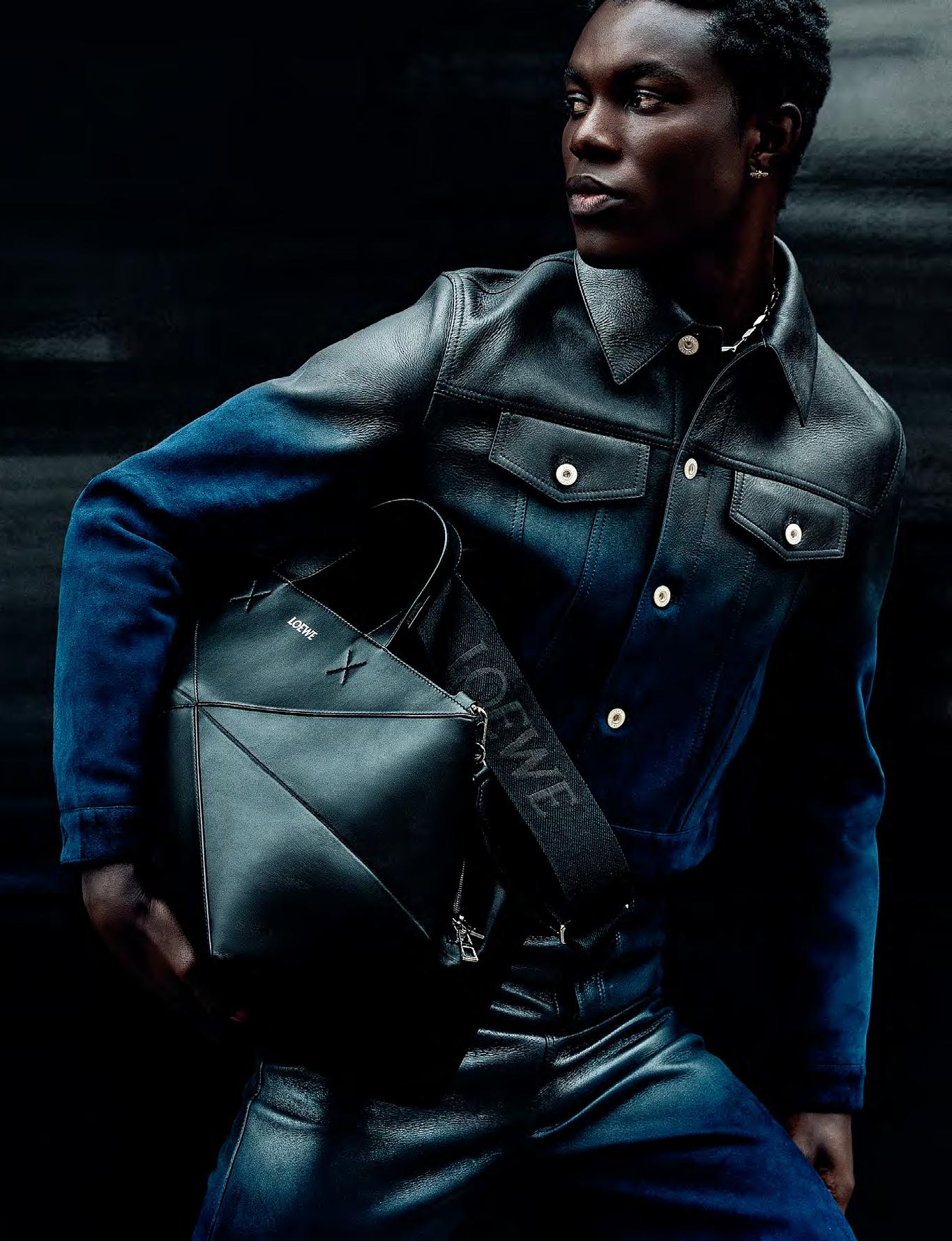
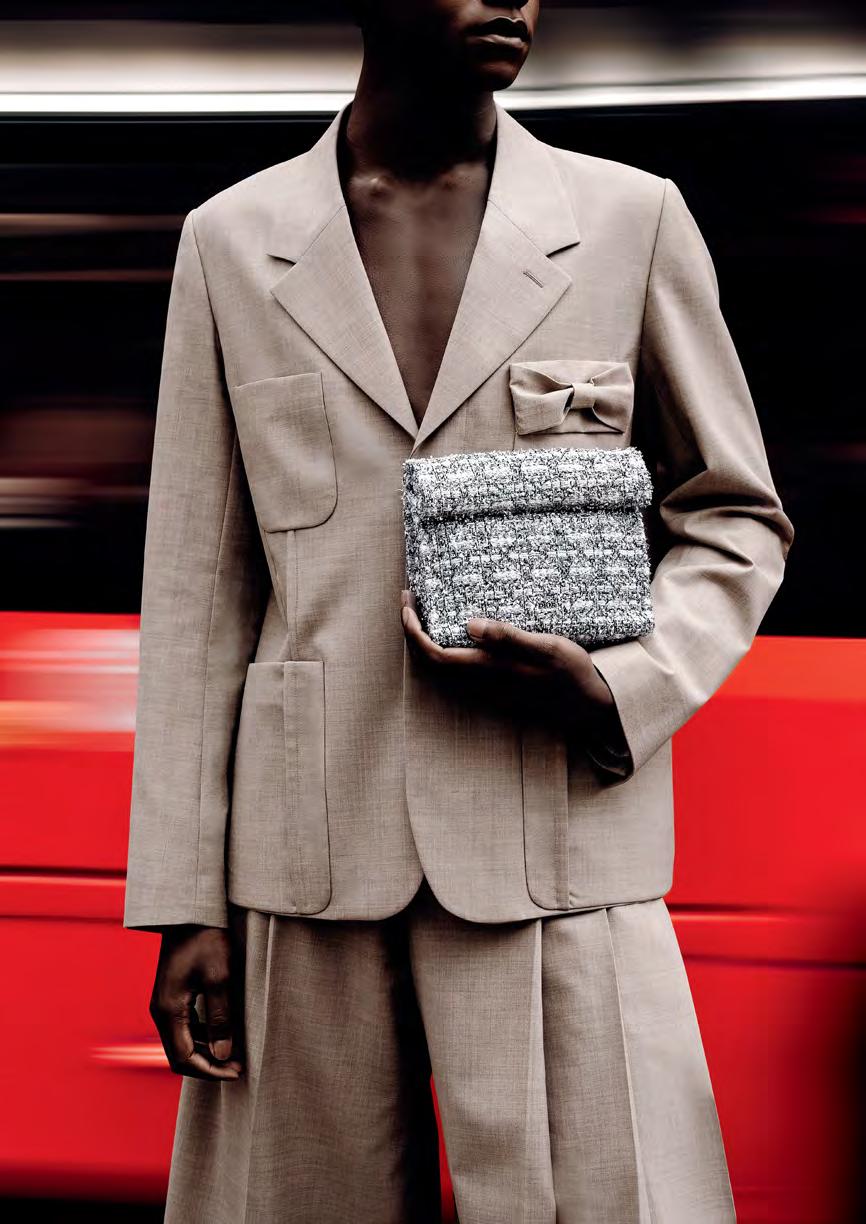
look,
THIS IS YUNG ON THE MOVE 146-147
full
DIOR


full look, FENDI THIS IS YUNG ON THE MOVE 148-149
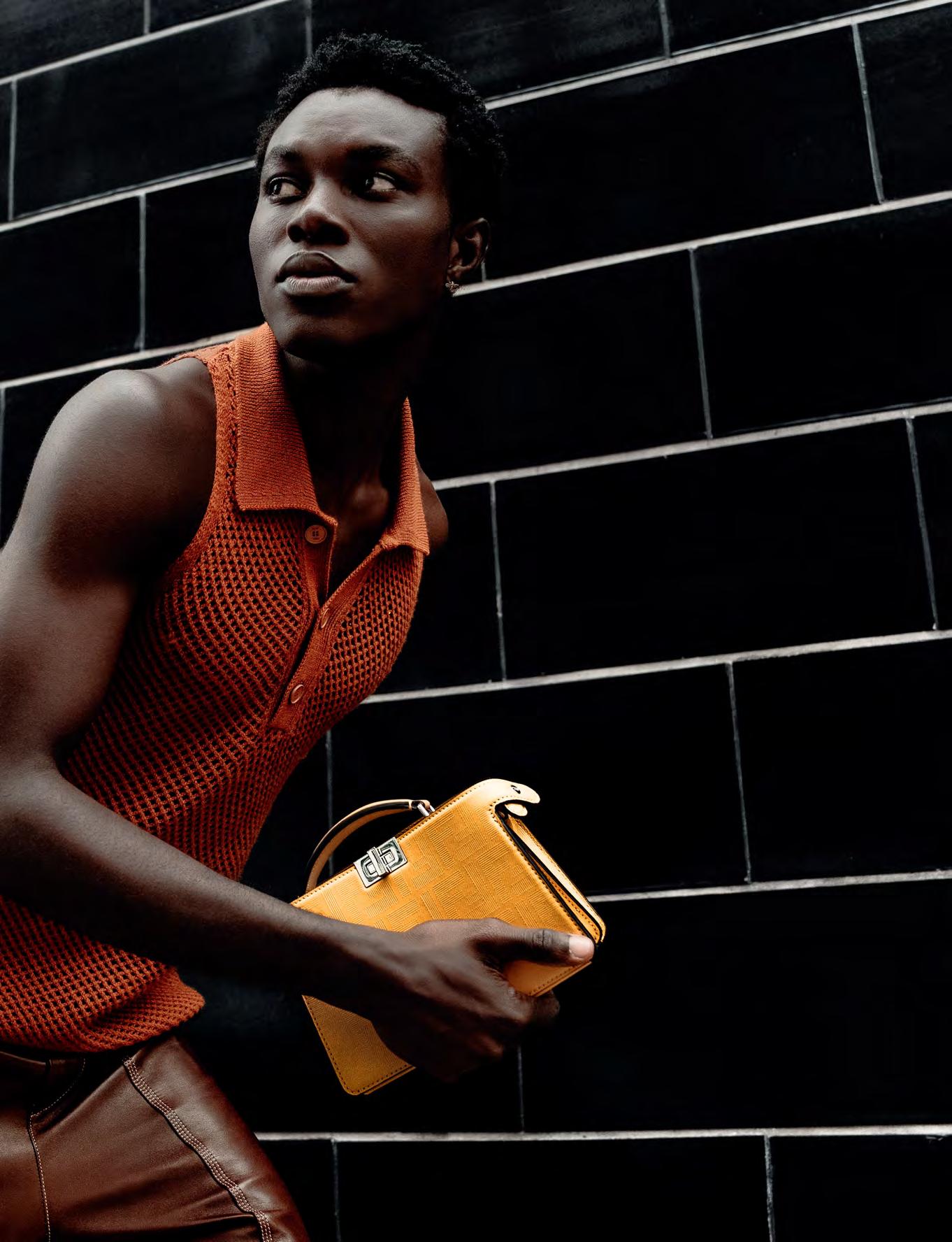

THIS IS YUNG ON THE MOVE 150-151
top, VERSACE. sunglasses, GENTLE MONSTER
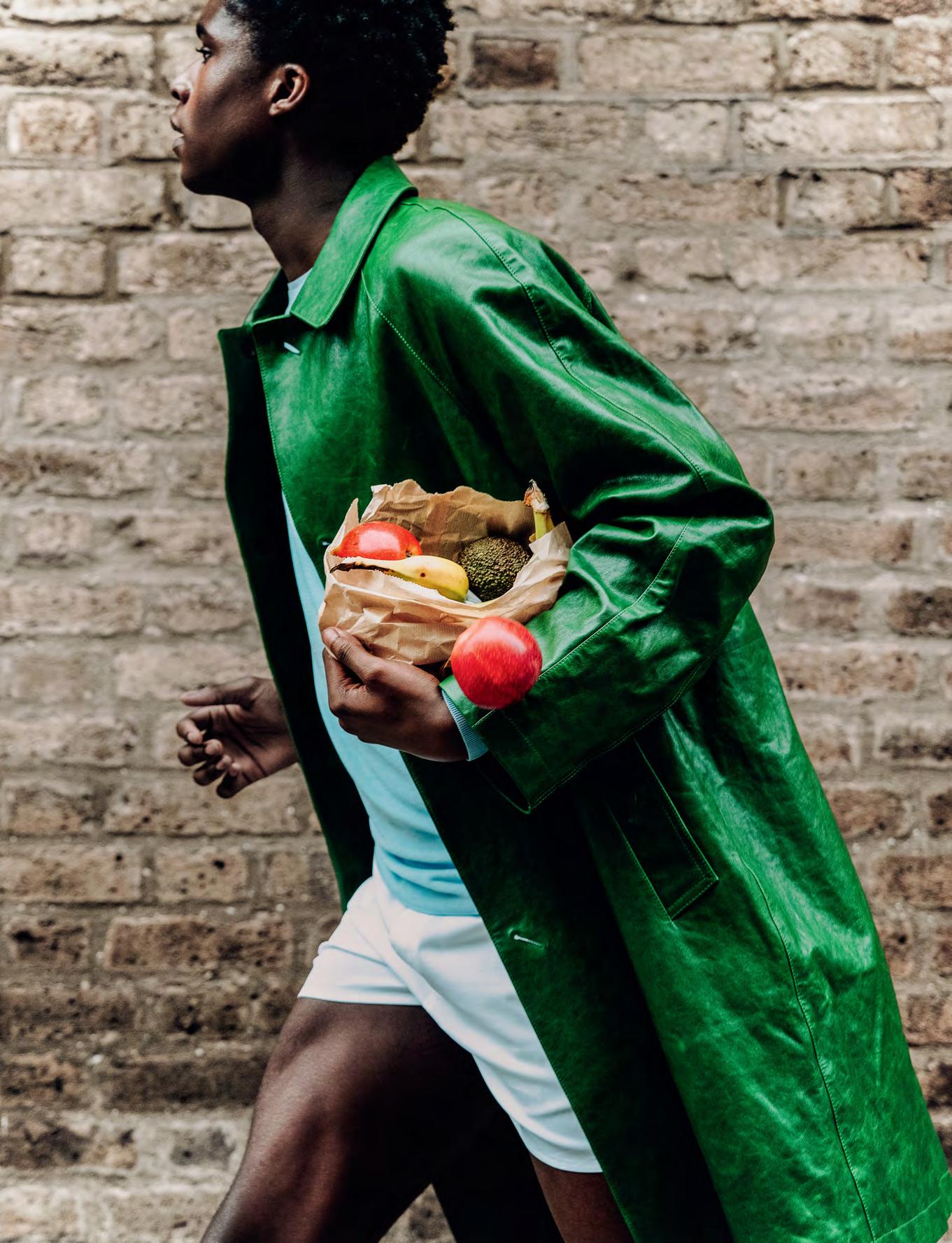
full look, FERRAGAMO
L: shorts, shirt, shoes, socks, PRADA. sunglasses, GENTLE MONSTER
R: shorts, shirt, shoes, socks, PRADA. sunglasses, GENTLE MONSTER x MAISON MARGIELA
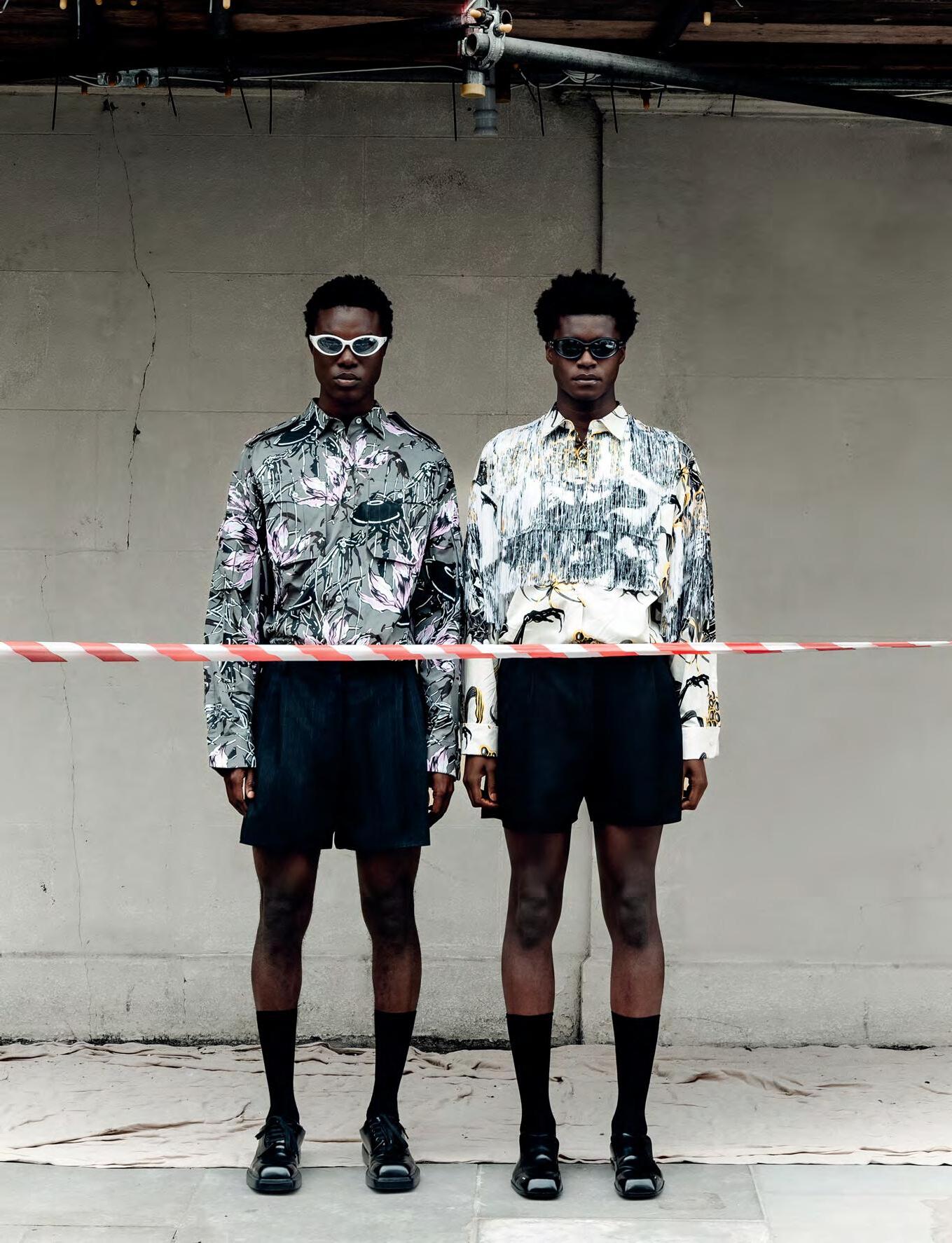
THIS IS YUNG ON THE MOVE 152-153
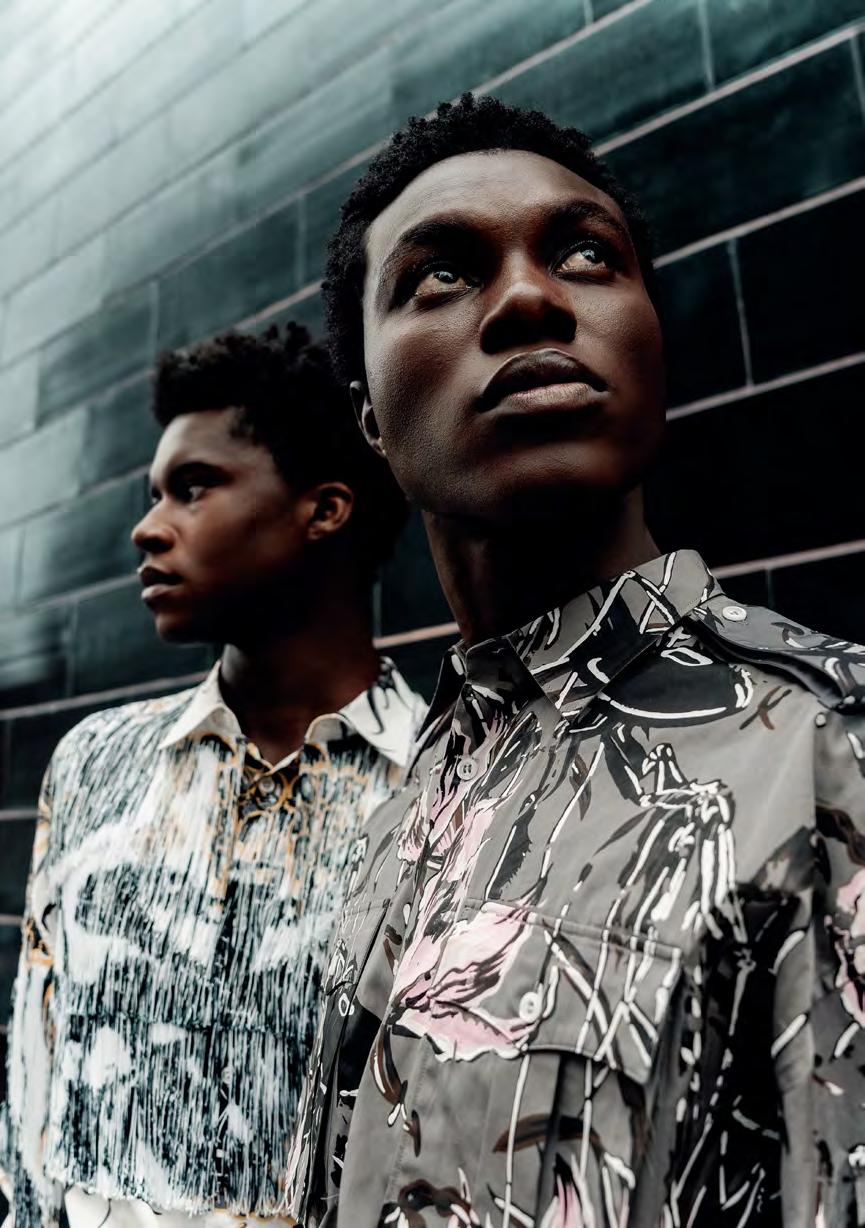
R: shirt, PRADA
L: shirt, PRADA

full look, BOTTEGA VENETA
THIS IS YUNG ON THE MOVE 154-155
makeup MARISA TIPKANOK; hair CHIKAKO SHINODA; models BENJAMIN MENSAH, BENJAMIN SHERERL at SUPA MODEL MANAGEMENT, JAYDAN DAVIES at NEVS MODELS; styling and production assistant SANA JAMALI; production LANA SHASH
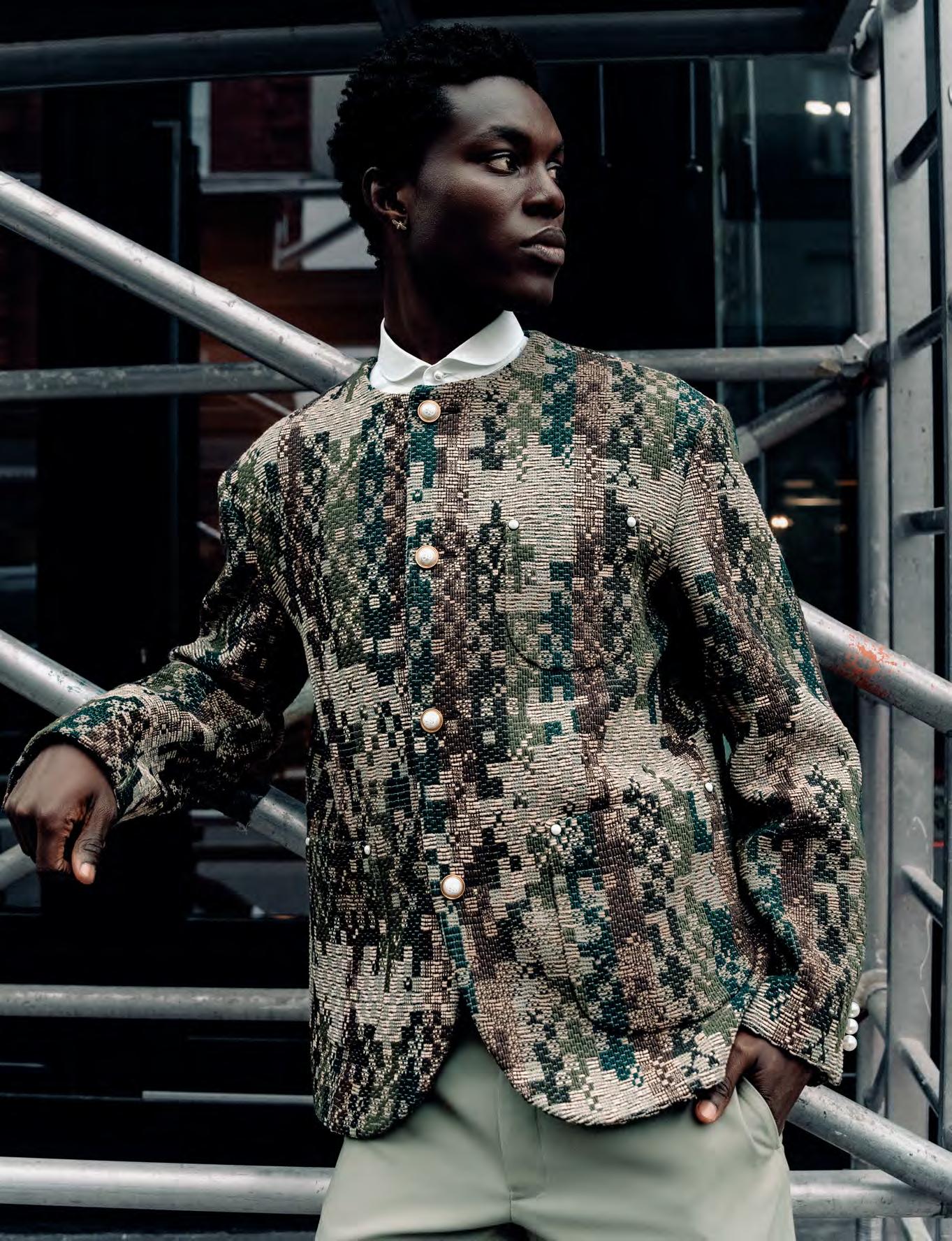
full look, LOUIS VUITTON
The Retro Revival editorial showcases SS.HH.A.N.A, the Lebanese singer and songwriter, adorned in the latest accessories from Tod’s Fabrica Women’s SS24 Collection. Featuring iconic bags like the Di Bag and T Timeless, as well as new additions such as the Tod’s T-Box and modeled shopping bag, the editorial captures the minimalist yet vintage charm of Tod’s Fabrica. Drawing inspiration from the male wardrobe and 1990s minimalism, the collection infuses a contemporary edge while maintaining a sense of softness and fluidity.
RE TRO RE VIVAL
Tod’s celebrates the timeless elegance of “Made in Italy”, a cornerstone value that has long defined the brand’s commitment to excellence, and which is showcased in the pieces seen here. The editorial invites audiences to rediscover the beauty and sophistication of an era defined by its minimalist sensibility and vintage appeal, offering a modern and contemporary reinterpretation.
THIS IS YUNG RETRO REVIVAL 156-157
photography SAM RAWADI styling NUJOUD OWEIS
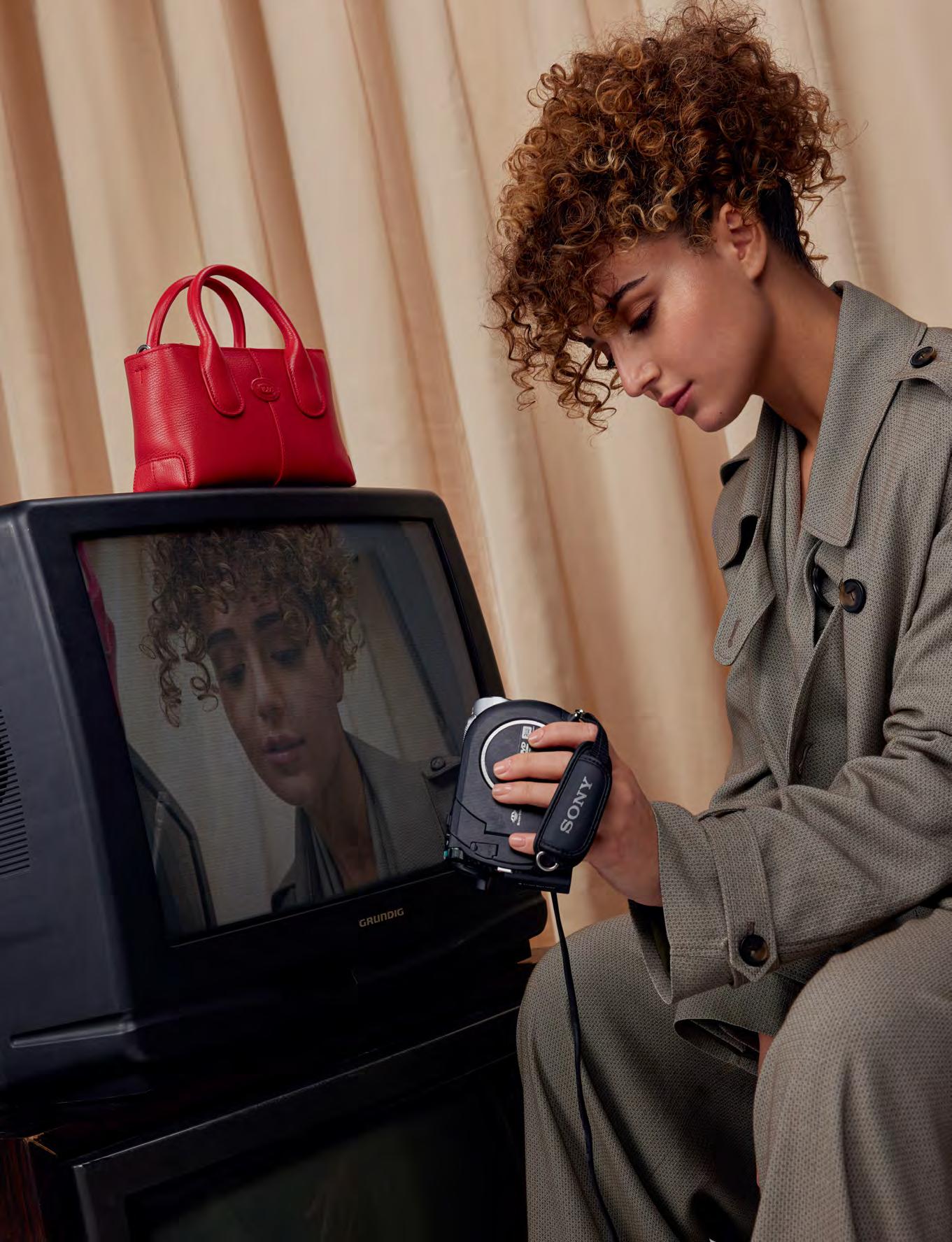
Tod’s
Di Bag, full look, TOD’S

THIS IS YUNG RETRO REVIVAL 158-159
Tod’s Di Bag, full look, TOD’S
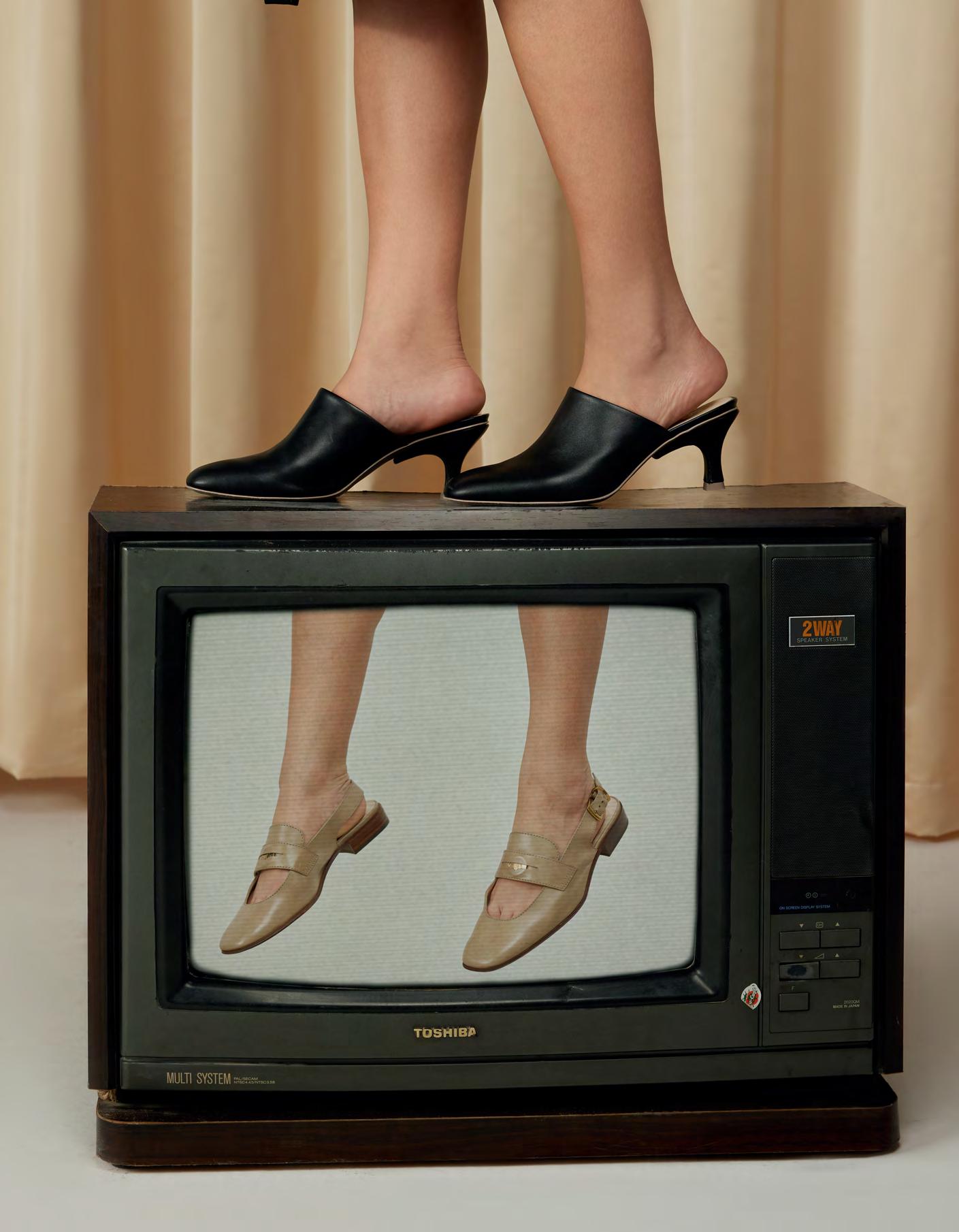 Tod’s Mules, Tod’s Slingback Loafers, TOD’s
Tod’s Mules, Tod’s Slingback Loafers, TOD’s

THIS IS YUNG RETRO REVIVAL 160-161
Tod’s Di Bag, Tod’s Belt, Tod’s Slingback Pumps, full look, TOD’s
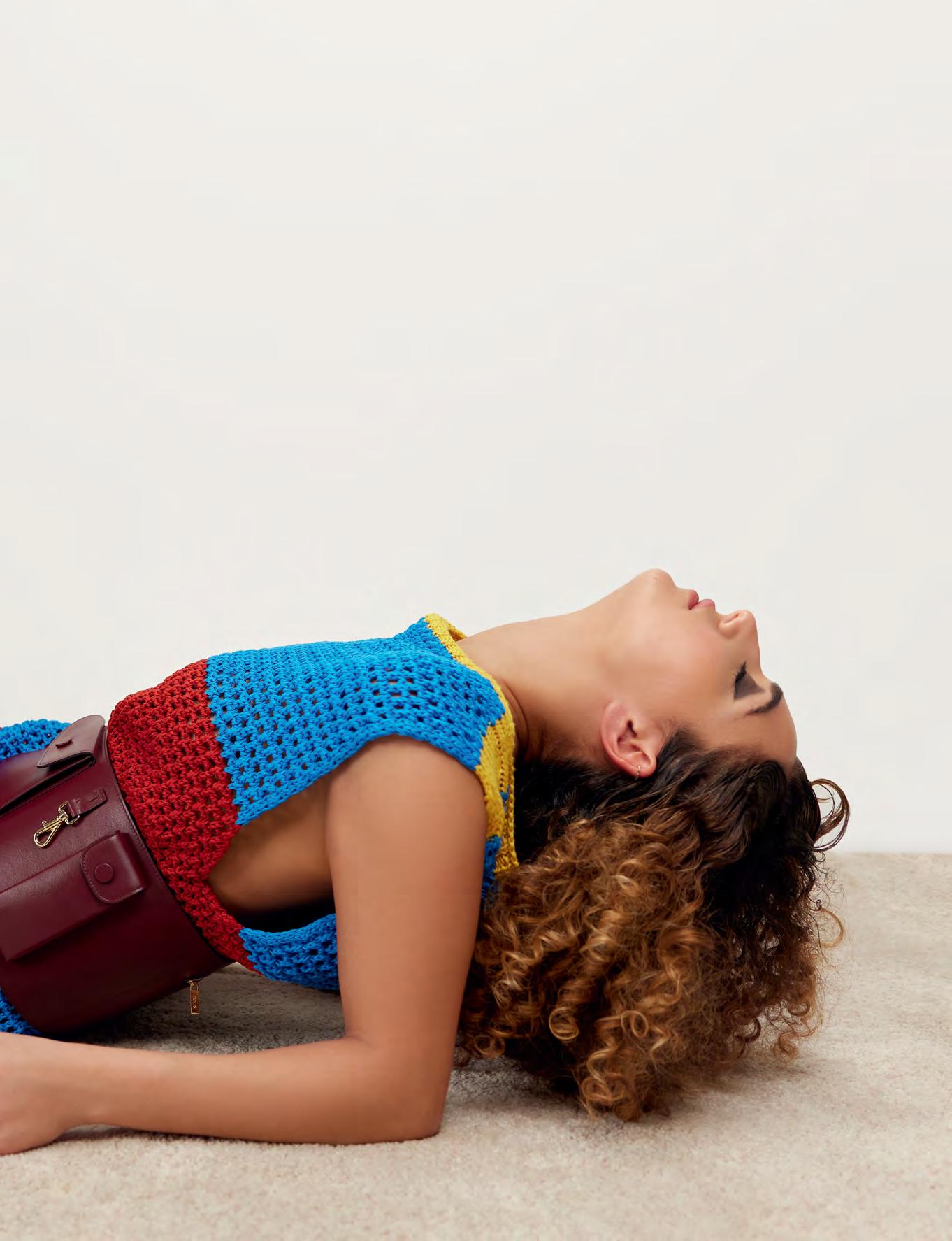

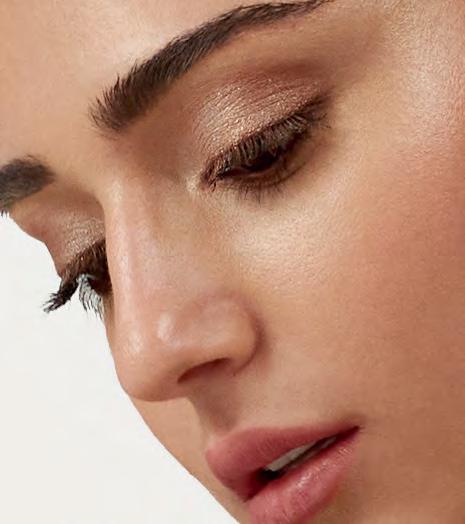

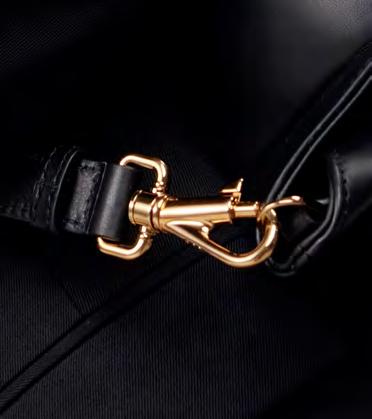
THIS IS YUNG RETRO REVIVAL 162-163
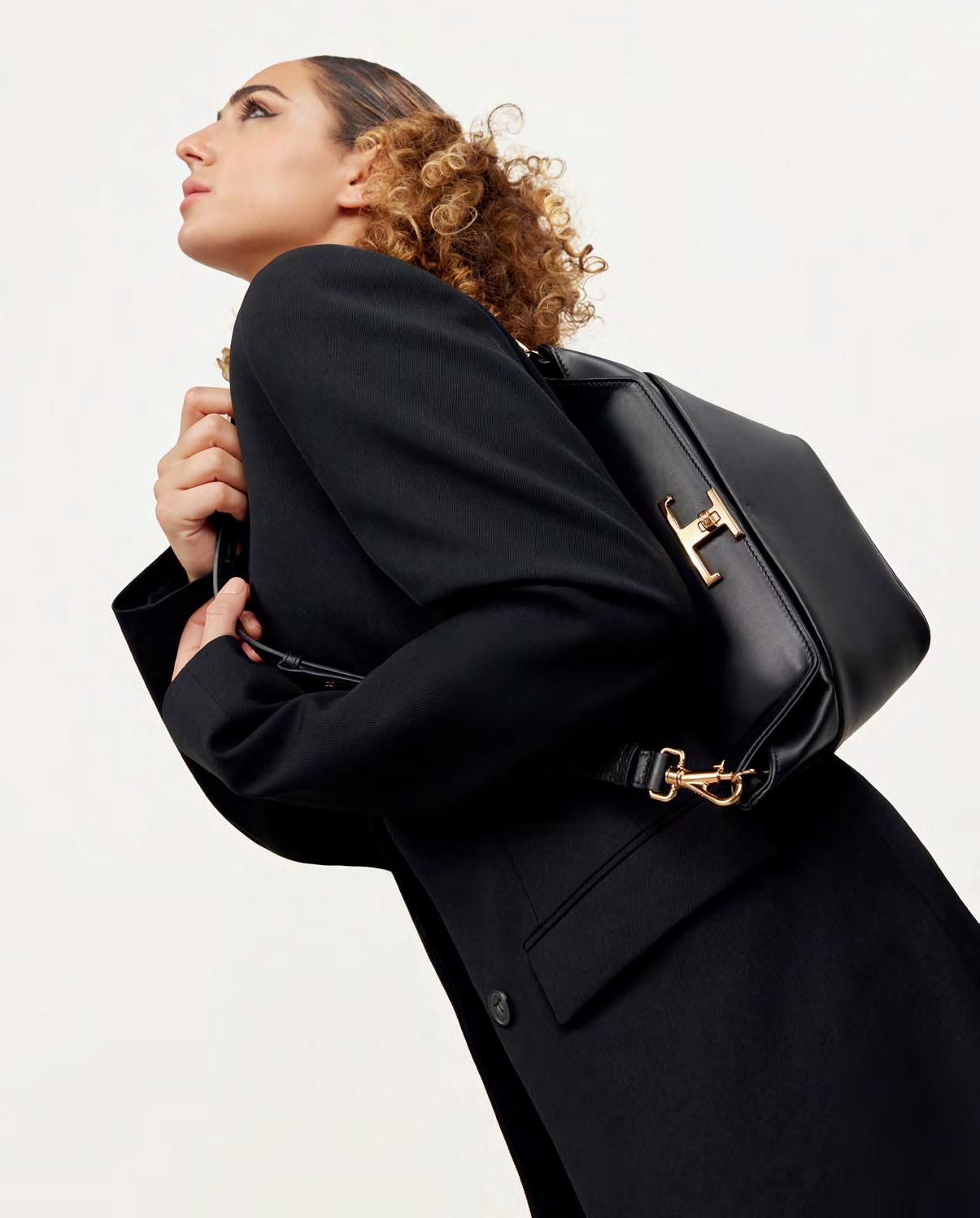
Tod’s T-Box Bag, full look, TOD’S
 set design
YEHIA BEDIER; makeup
JEAN KAIROUZ; hair SHENEM FUAT; styling assistant AMY TAPPIN; production LANA SHASH
set design
YEHIA BEDIER; makeup
JEAN KAIROUZ; hair SHENEM FUAT; styling assistant AMY TAPPIN; production LANA SHASH
THIS IS YUNG RETRO REVIVAL 164-165
Tod’s Di Bag, Tod’s Slingback Pumps, full look, TOD’S
 Tod’s Di Bag, Tod’s Mules, full look, TOD’S
Tod’s Di Bag, Tod’s Mules, full look, TOD’S
photography LESHA LICH styling NUJOUD
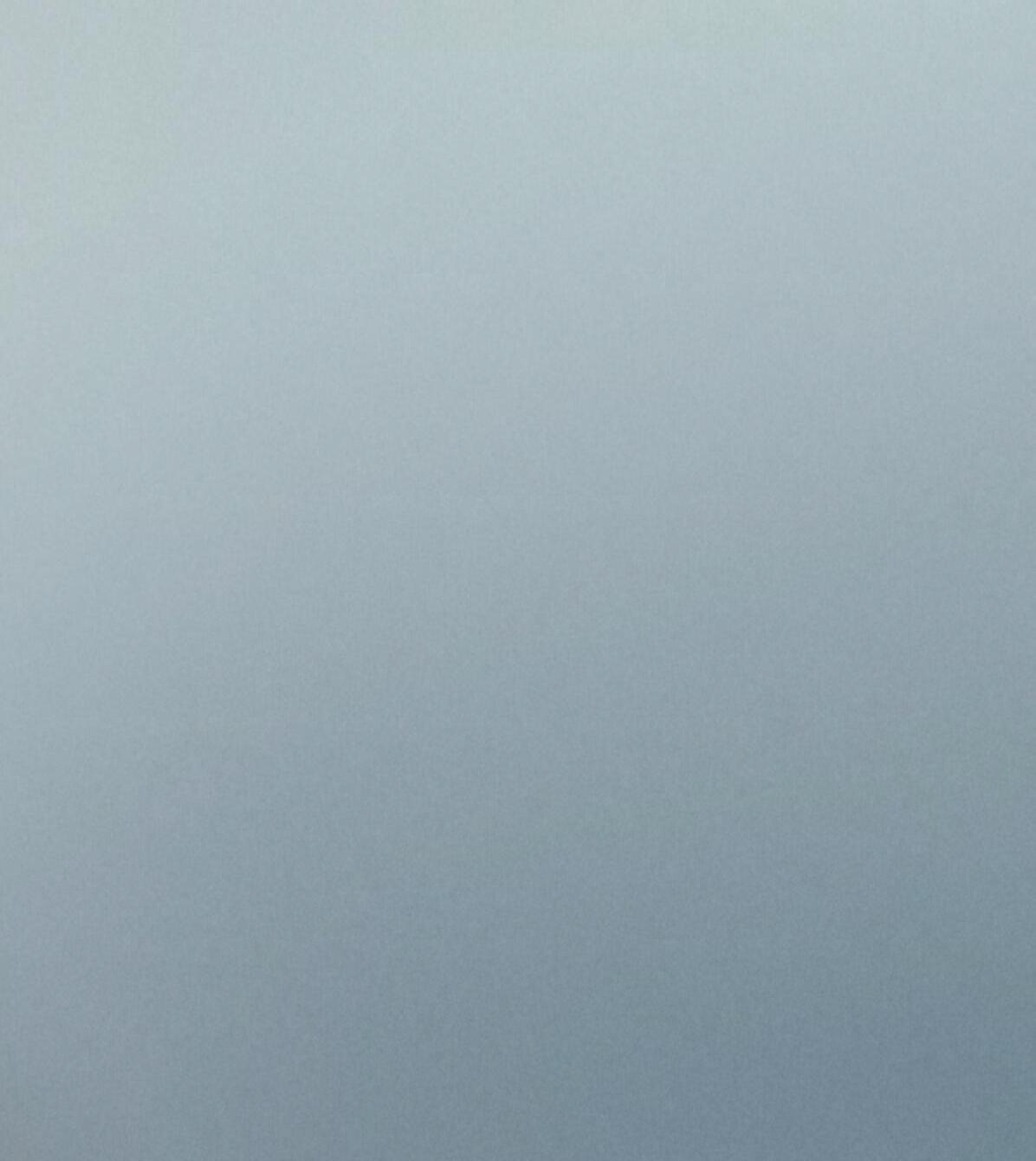
Join us on a futuristic voyage with The Giving Movement – the homegrown, Dubai-based powerhouse where athleisure and streetwear meet purpose, charity, and sustainability. Born from the vibrant spirit of the local community, every thread of their apparel tells a tale of positive impact, sourced and crafted locally in the UAE. Embracing an eco-conscious ethos, they meticulously curate fabrics and production processes to minimize their ecological footprint.
Step into a movement that transcends fashion – welcome to The Giving Movement.
OWEIS
THIS IS YUNG THE FUTURE IS HERE 166-167
 L: top, shorts, THE GIVING MOVEMENT. R: top, pants, THE GIVING MOVEMENT
L: top, shorts, THE GIVING MOVEMENT. R: top, pants, THE GIVING MOVEMENT
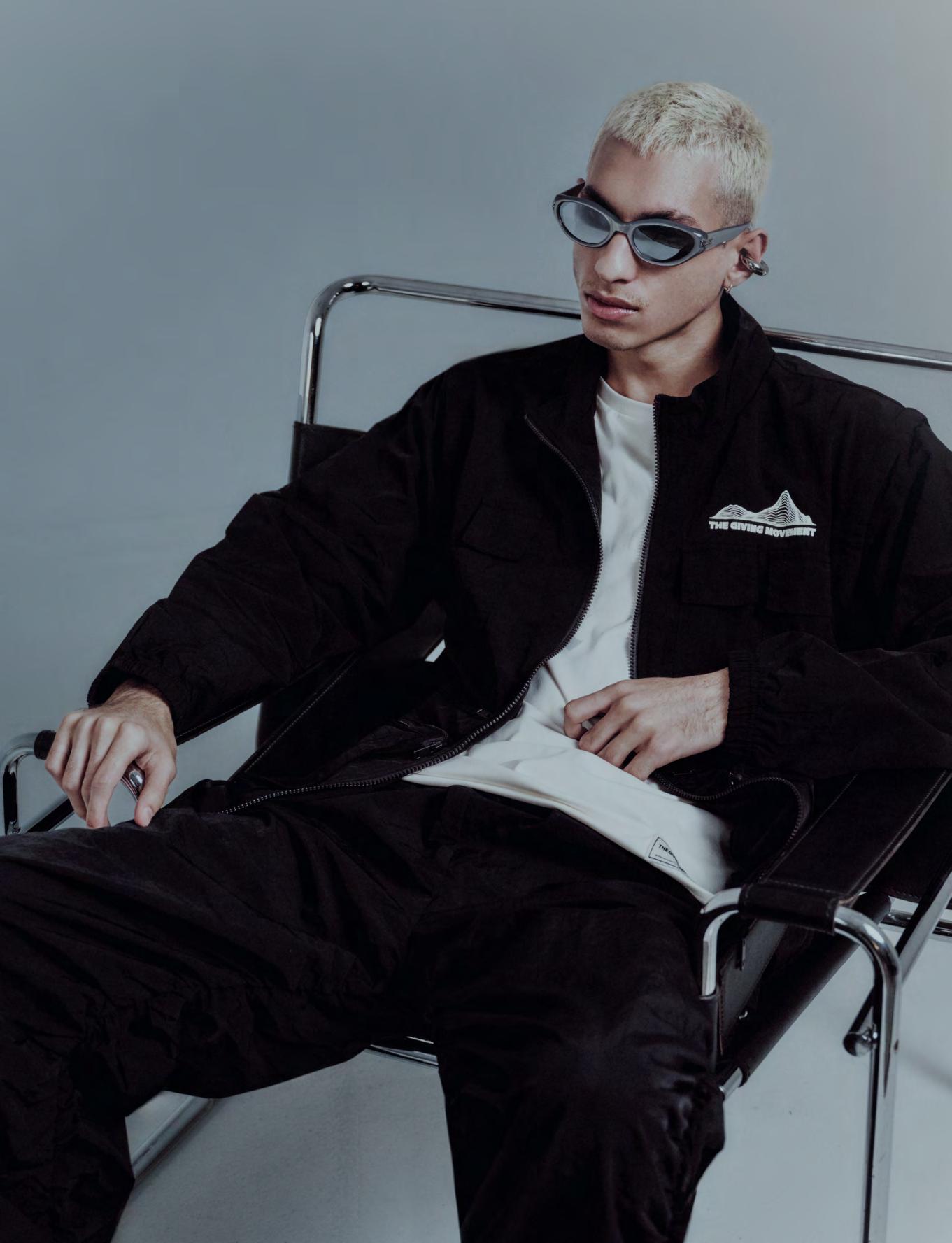
top, pants, jacket, THE GIVING MOVEMENT THIS IS YUNG THE FUTURE IS HERE 168-169

top, THE GIVING MOVEMENT
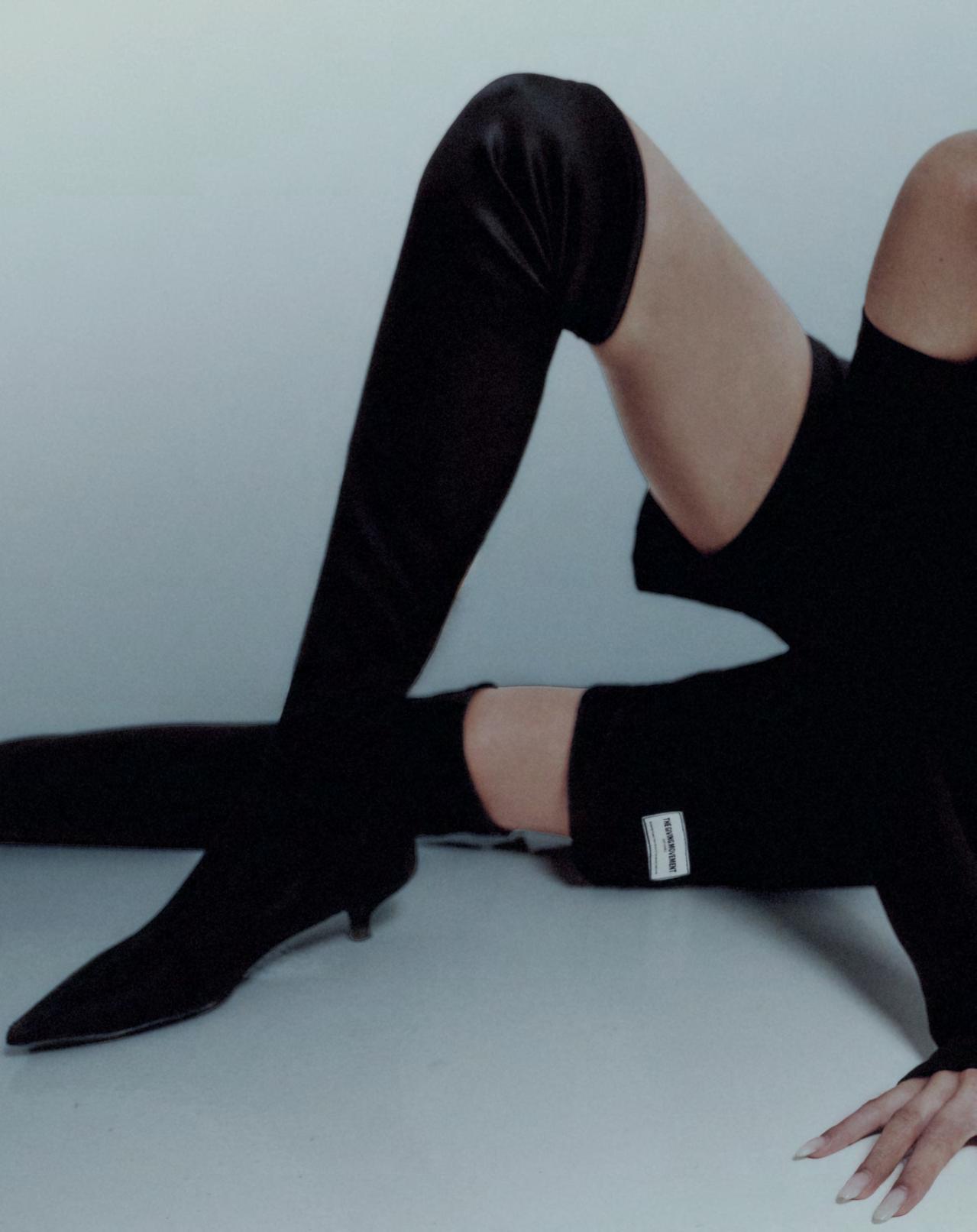
THIS IS YUNG THE FUTURE IS HERE 170-171
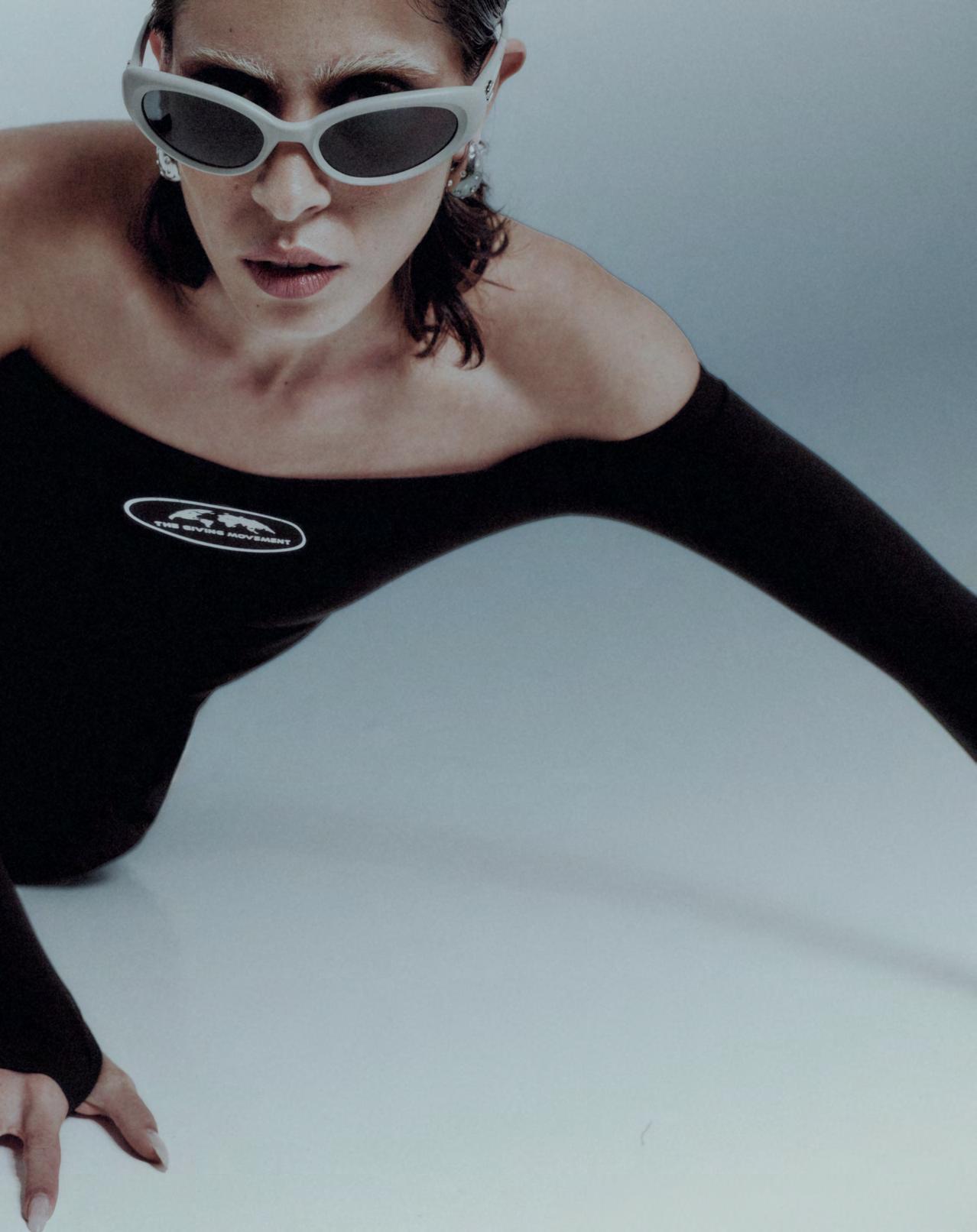
top, shorts, THE GIVING MOVEMENT

L: top, pants, THE GIVING MOVEMENT. R: top, pants, THE GIVING MOVEMENT THIS IS YUNG THE FUTURE IS HERE 172-173

hoodie, THE GIVING MOVEMENT
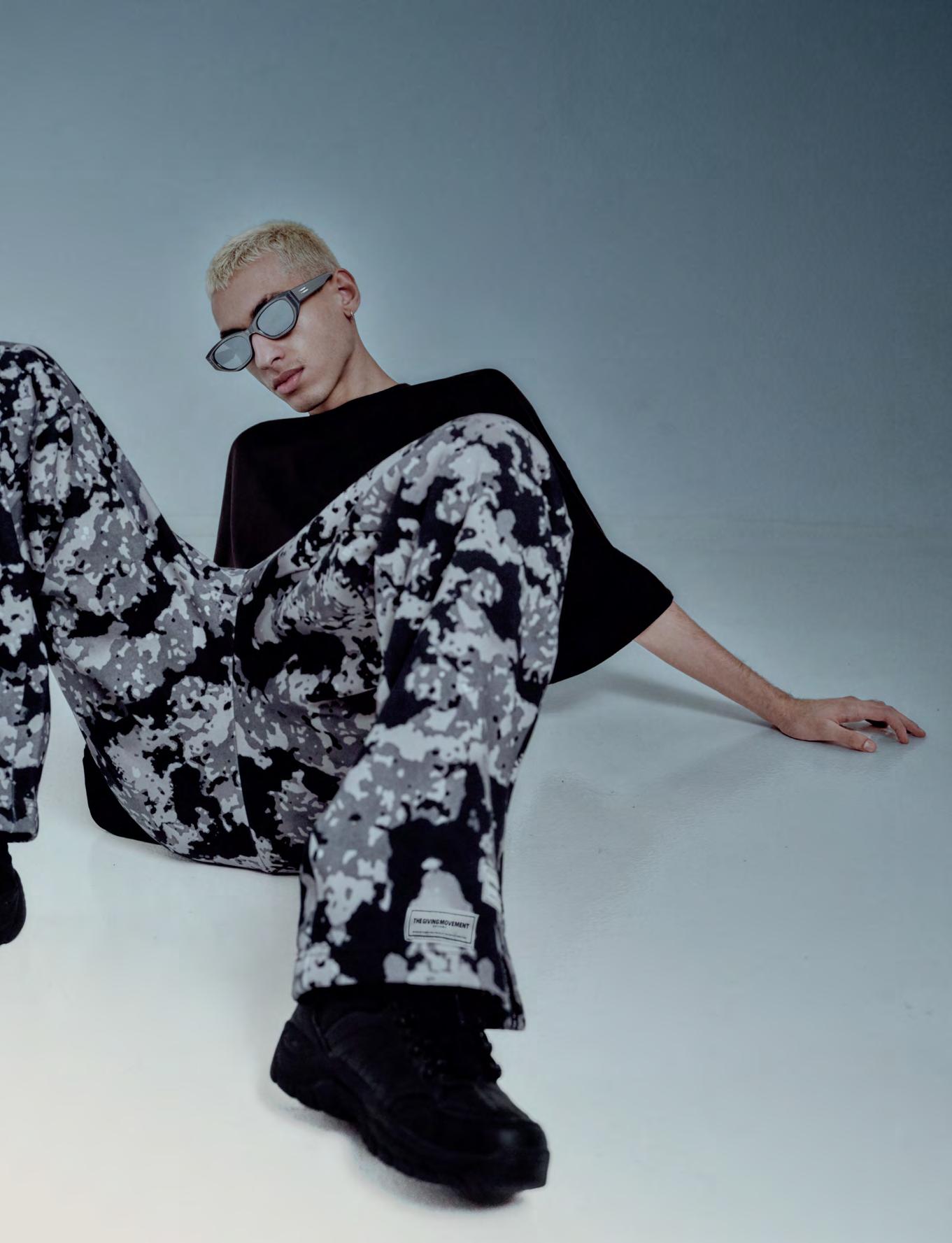
top, pants, THE GIVING MOVEMENT THIS IS YUNG THE FUTURE IS HERE 174-175
 MODELS SOHAILA KANDIL, ADAM JEMAME; PRODUCTION LANA SHASH bodysuit, THE GIVING MOVEMENT
MODELS SOHAILA KANDIL, ADAM JEMAME; PRODUCTION LANA SHASH bodysuit, THE GIVING MOVEMENT
THE BLACK LINER
Sharbel Hasbany, a Beirut-born Lebanese makeup artist and beauty director, is a creative force in the beauty industry. Graduating from Atelier Maquillage Paris Modèles in 2013, he embarked on a professional journey which saw him collaborate with some of the region’s most renowned industry figures. With an adventurous spirit, Hasbany expanded his artistic footprint across the Middle East and Asia, undertaking projects in India, South Korea, Thailand, and Indonesia. In 2018, he was appointed to the prestigious role of Ambassador for Marc Jacobs Beauty, a testament to his exceptional skills and influence. Renowned for his daring approach to beauty, Hasbany has curated striking covers and editorials featuring the region’s top celebrities and influencers. His versatile portfolio extends from fashion and beauty to jewellery, men’s grooming, bridal, and commercial projects, showcasing his ability to bring creativity and innovation to every facet of the beauty realm.
photography LARA ZANKOUL makeup SHARBEL HASBANY
THIS IS YUNG THE BLACK LINER 176-177
Marc Jacobs Ambassador Sharbel Hasbany is taking the makeup world by storm.

base: vitamin enriched face base primer, BOBBI BROWN. colorfix matte 24-hour cream, color (lift),
MYRICKS BEAUTY mascara: lash sensational sky high mascara cosmic black, MAYBELLINE. a star is born mascara, VERA MILANO BEAUTY eyes: dual edge eyeliner,
DANESSA
BASSAM FATTOUH. beauty colorfix matte 24 hour cream color (blackout), DANESSA MYRICKS BEAUTY
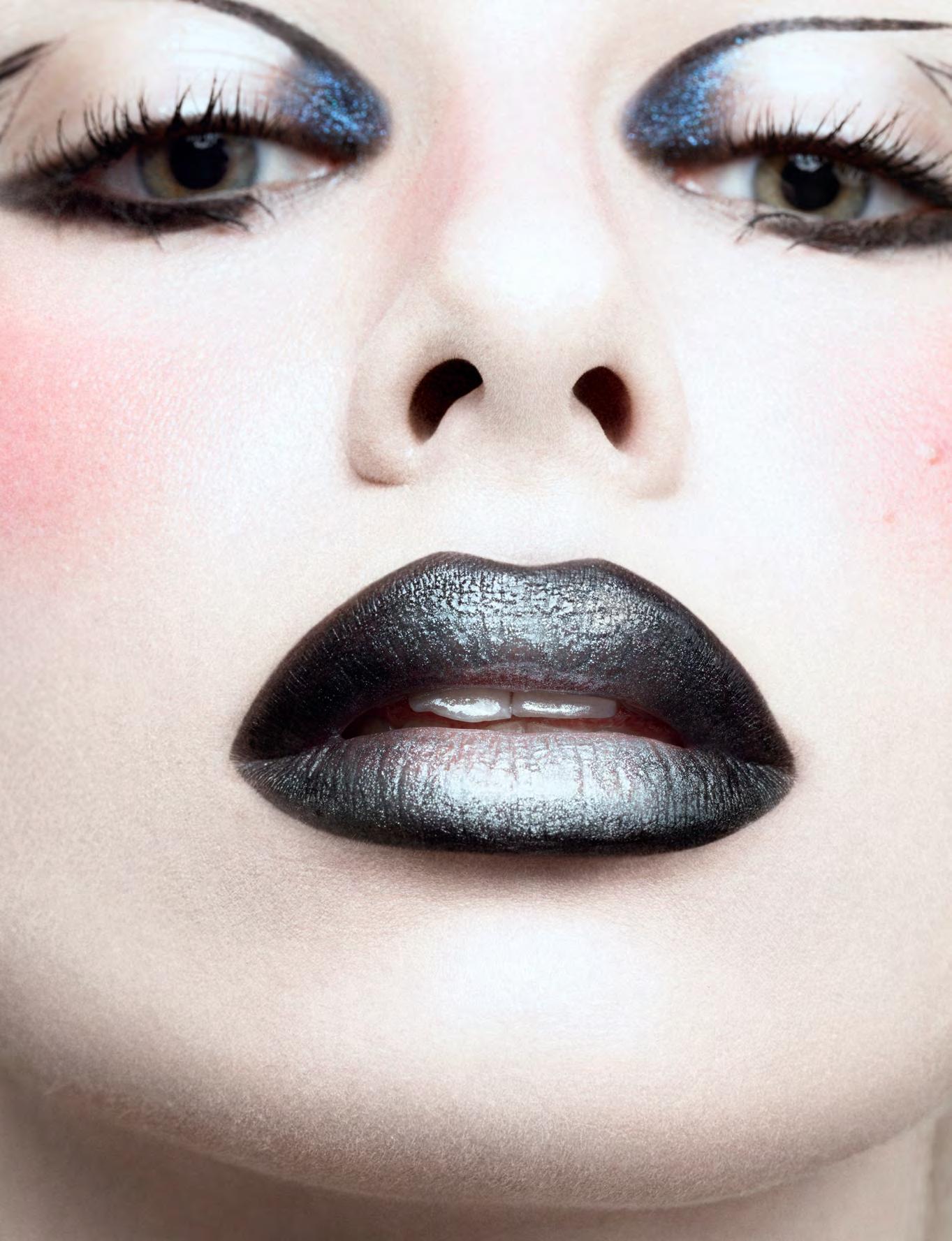
base: vitamin enriched face base primer, BOBBI BROWN. colorfix matte 24-hour cream, color (lift), DANESSA MYRICKS BEAUTY mascara: lash sensational sky high mascara cosmic black, MAYBELLINE. a star is born mascara, VERA MILANO BEAUTY blush: backstage rosy glow rouge in 001, DIOR BEAUTY eyes: permagel ultra – (kajalstift), PAT McGRATH LABS. mothership palette (subliminal), PAT McGRATH LABS lips: permagel ultra – (kajalstift), PAT McGRATH LABS. mothership palette IV decadence, PAT McGRATH LABS
THIS IS YUNG THE BLACK LINER 178-179
In this spellbinding editorial, Sharbel Hasbany redefines the timeless Black Liner, transforming it from a makeup staple that’s taken for granted into a canvas of artistic expression. With innovative flair, Hasbany invites us to explore the versatility of the black liner, challenging conventional notions that dictate perfection.
By creating diverse looks with the black liner at the forefront, this editorial serves as Hasbany’s declaration of confidence, a subtle yet powerful assertion of “I’ve got this.” Embracing imperfections, this editorial reframes them into bold statements, encouraging us to wield the black liner with authority. As we venture forward, imperfect yet winged and ready for the future. Hasbany’s artistic prowess inspires a fresh perspective on beauty - one that celebrates individuality and self-assurance.
What is your earliest memory related to make up, and what inspired your decision to pursue it as a career?
My earliest encounter with make up involved raiding my friend’s make up bag. Smudged eyeliner and too much blush whenever we want to party, or even doing some iconic fashion statement back in Beirut.
Against the current of family expectations, my stubbornness silently steered me toward considering a different path. Their resistance made me reflect, and, almost inadvertently, the idea of becoming a make up artist took root. It’s funny how defiance can lead to discovering one’s true calling
Can you tell us about a particularly memorable or influential project that helped shape your career?
Teaming up with MIA while I was in my beginnings in Mumbai, the Indian singer was a game-changer. Her vibe injected fresh energy into my work, making it more exciting and dynamic. It wasn’t just a collaboration; it was a shift that’s made me love what I do even more.
How has exposure to different cultures impacted your artistic style, and do you draw inspiration from specific regions?
Interacting with different cultures has had a direct impact on my artistic style. It’s like adding various colours to a canvas – each experience contributes something unique. The result is a more diverse and enriched creative approach that reflects a blend of global influences.
South Asia and Amazonia have a big influence in that respect.
What is a unique technique that you often find yourself employing in your work?
Crafting a flawless canvas. Prepping the skin is the foundation of a seamless makeup look. Hydrate, prime, and let your skin glow – the key to achieving a flawless finish. It’s not just about covering; it’s about enhancing your natural beauty and creating a masterpiece that lasts all day.
What, in your opinion, are the advantages and challenges of being a male in this industry?
Navigating the beauty industry as a male isn’t just about make up and skincare; it’s about challenging preconceptions, fostering inclusivity, and amplifying the message that beauty is a universal language. By embracing authenticity and promoting diversity, we’re not just applying products, but also breaking down barriers. The impact goes beyond the surface, shaping a future where everyone feels seen, accepted, and empowered to express their unique beauty, regardless of gender norms.
What intrigued you about the black liner, a common item in many makeup bags, and why did you choose to make it the focal element in this particular shoot?
Proving them wrong: Remember when my eyeliner wasn’t ‘perfect.’ Well, now I wield that black liner like a boss. It’s my way of saying, ‘I’ve got this,’ turning what used to be criticism into a confident statement in my makeup game. Imperfections? It’s already in the past.
What challenges did you encounter in creating diverse looks while ensuring they still harmonised with the overall theme?
I’ve struck the right balance, keeping my makeup looks reliably cohesive without getting too stuck in an oriental theme. It’s about authenticity and versatility – telling a beauty story that’s both dependable and creatively diverse.
Creating a natural-looking white skin tone was a challenge, needing precision to avoid any gimmicky appearance.

base: vitamin enriched face base primer, BOBBI BROWN. colorfix matte 24-hour cream, color (lift), DANESSA MYRICKS BEAUTY mascara: lash sensational sky high mascara cosmic black, MAYBELLINE. a star is born mascara, VERA MILANO BEAUTY blush: backstage rosy glow rouge in 001, DIOR BEAUTY eyes: permagel ultra – (kajalstift), PAT McGRATH LABS. mothership palette (subliminal), PAT McGRATH LABS
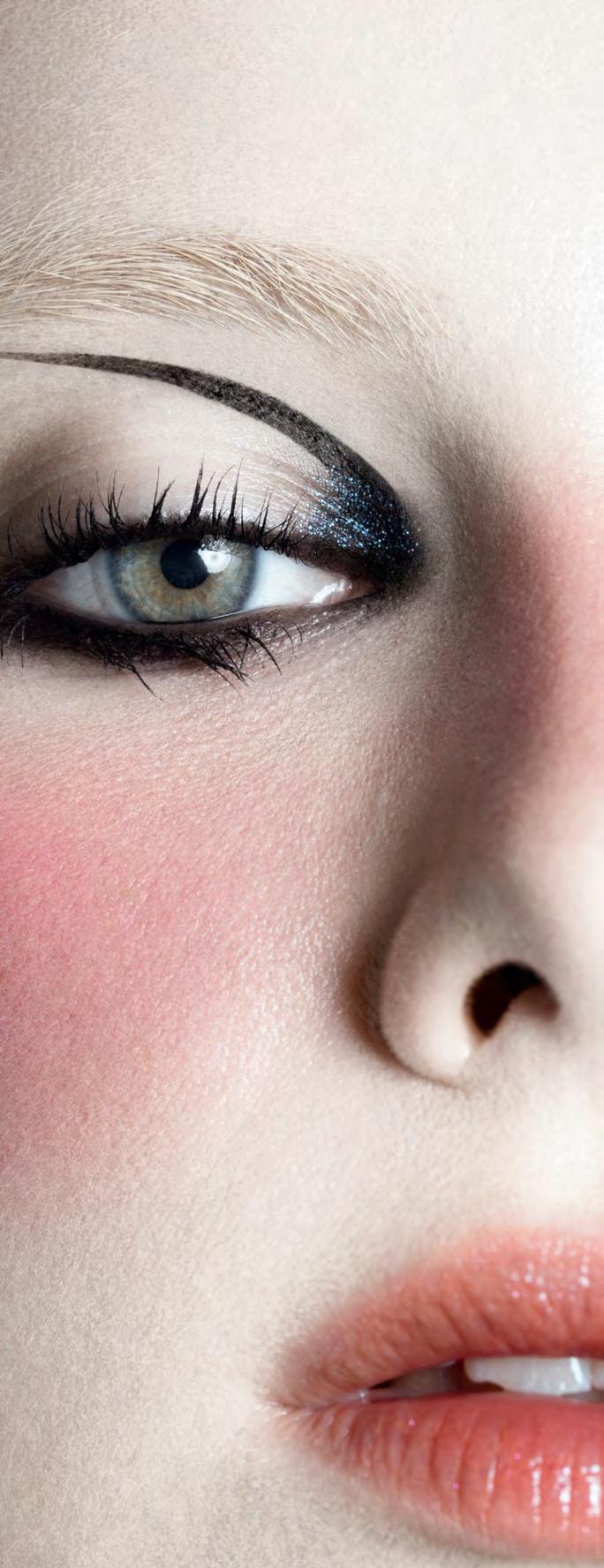
THIS IS YUNG THE BLACK LINER 180-181


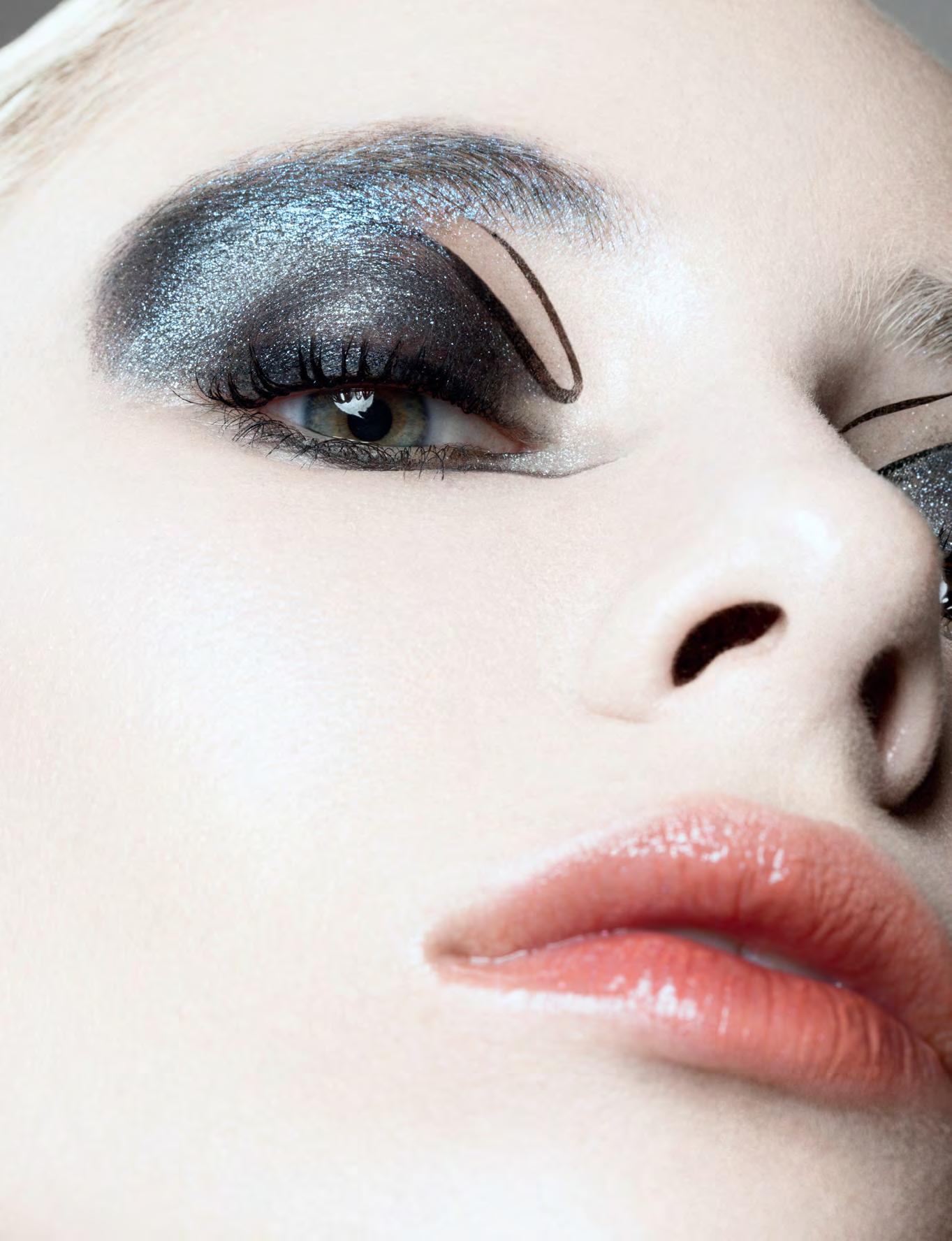
base: vitamin enriched face base primer, BOBBI BROWN. colorfix matte 24-hour cream, color (lift), DANESSA MYRICKS BEAUTY mascara: lash sensational sky high mascara cosmic black, MAYBELLINE. a star is born mascara, VERA MILANO BEAUTY blush: backstage rosy glow rouge in 001, DIOR BEAUTY eyes: mothership palette (subliminal), PAT McGRATH LABS. dual edge eyeliner, BASSAM FATTOUH
THIS IS YUNG THE BLACK LINER 182-183
base: vitamin enriched face base primer, BOBBI BROWN. colorfix matte 24-hour cream, color (lift), DANESSA MYRICKS BEAUTY mascara: lash sensational sky high mascara cosmic black, MAYBELLINE. a star is born mascara, VERA MILANO BEAUTY blush: backstage rosy glow rouge in 001, DIOR BEAUTY
eyes: dual edge eyeliner, BASSAM FATTOUH hyper easy liquid liner, MAYBELLINE
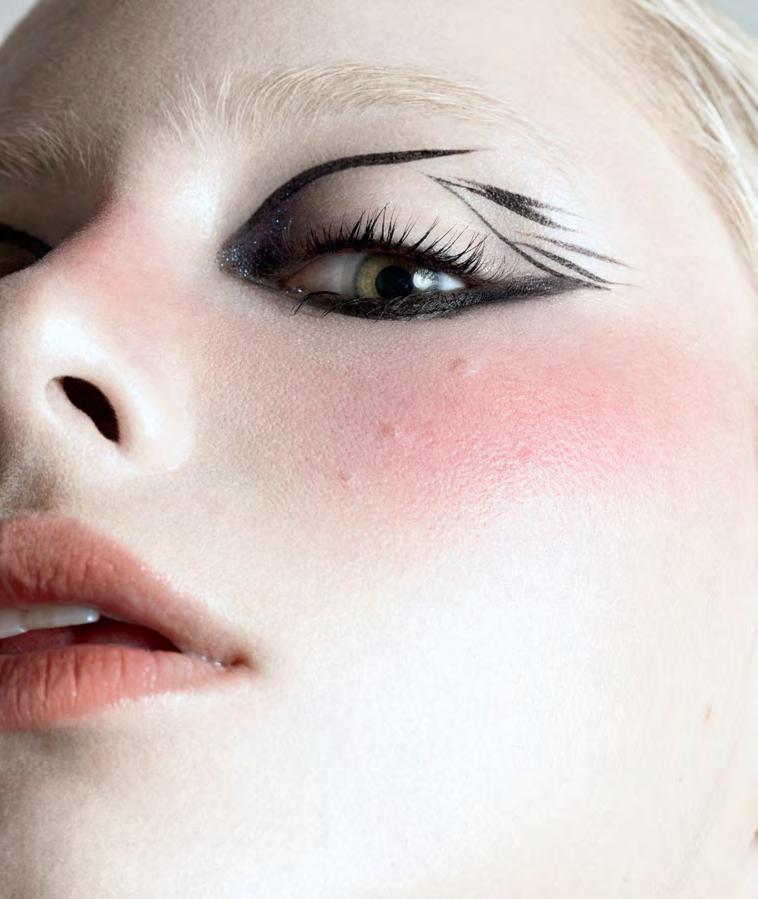
“Creating a naturallooking white skin tone was a challenge, needing precision to avoid any gimmicky appearance.”
If you had to sum up this shoot in three words, what would they be?
Consistent - Experimental - Brave
With your daring approach to beauty, how do you stay innovative and continue pushing creative boundaries in an ever-evolving industry?
Constantly inspired by life’s and architectural elements, I experiment with new techniques privately while being quiet about my future plans. Working with diverse individuals from photographers to stylists, to creative directors adds a crucial dimension to my skills in the make up industry. It’s a continuous exploration and growth process. ■
A LITTLE PUNK
Burberry releases an instant classic: The Burberry Box Sneaker.
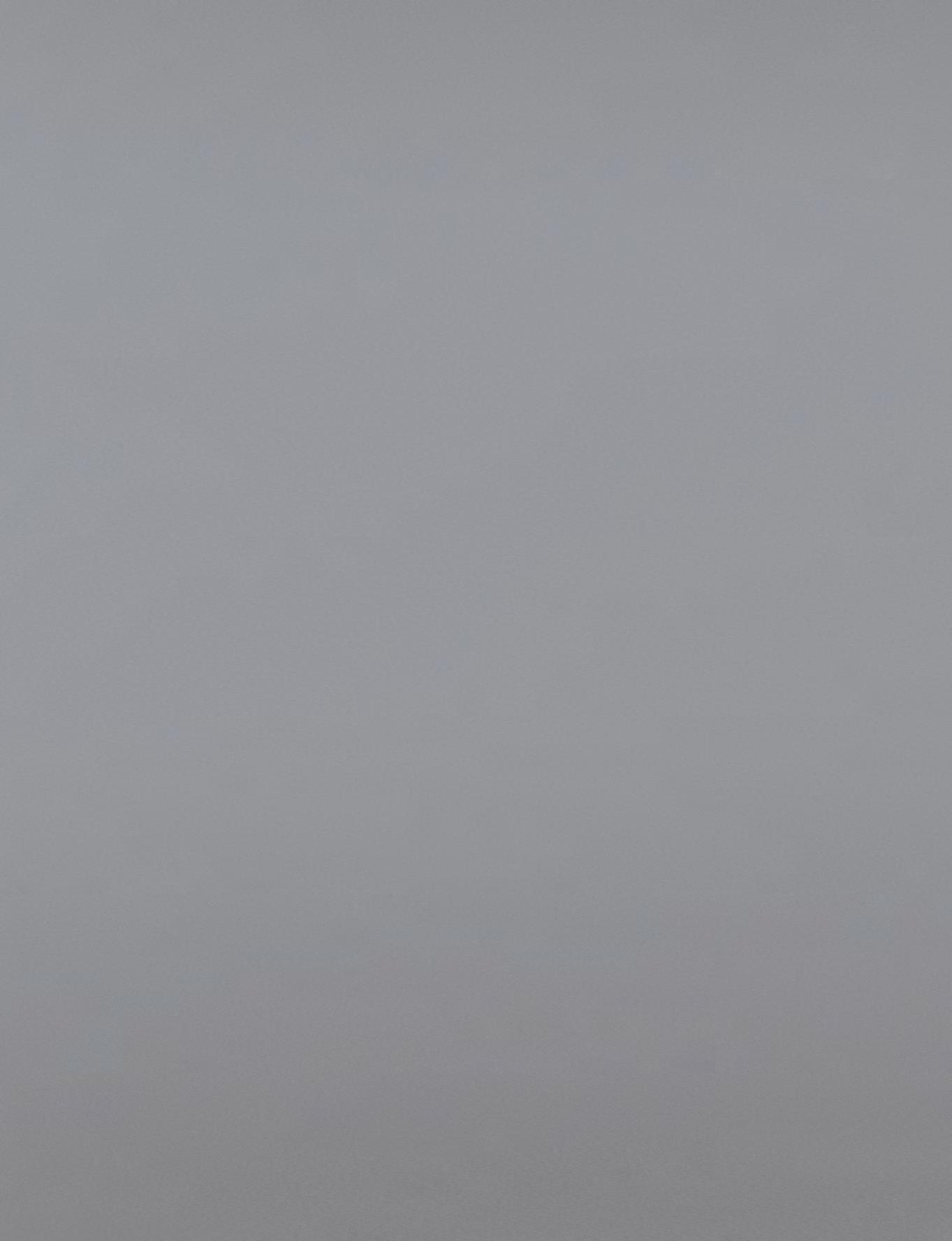
Burberry has done it again. The ever-fresh House has just released the Burberry Box Sneaker and it’s sure to be a classic. New for Spring 2024, the shoes are pared back, simple, yet strong, with clean lines, bold colours and an over the top silhouette.
The calf leather sneakers are clean, with their uppers offering fresh details upon closer inspection. The wire hardware is inspired by punk culture and the wide laces add a touch of the street.
It wouldn’t be Burberry without some check and stretch-knit elements and sure enough, they’re here, marrying perfectly with the shoe’s form.
All this sits atop a chunky, moulded rubber sole with the House’s logo embedded in the tread in a contrasting Knight blue.
Contemporary, young, but intimately Burberry, the Box Sneaker might just be a classic.
photography JACK CHIPPER styling SAIF HIDAYAH
THIS IS YUNG A LITTLE PUNK 184-185
 sneakers, BURBERRY
sneakers, BURBERRY

sneakers, BURBERRY THIS IS YUNG A LITTLE PUNK 186-187
 sneakers, BURBERRY
sneakers, BURBERRY

sneakers, BURBERRY THIS IS YUNG A LITTLE PUNK 188-189
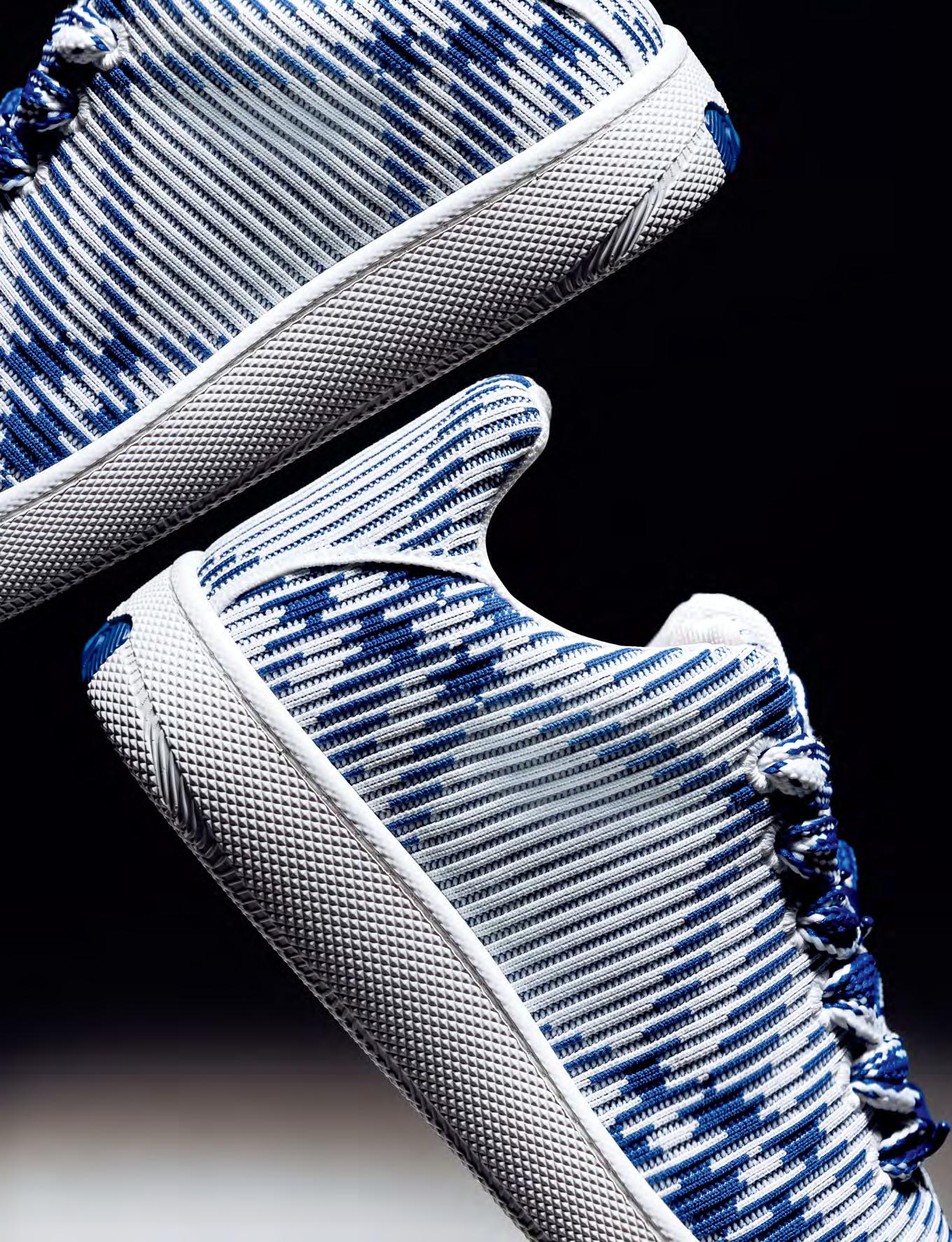 sneakers, BURBERRY
sneakers, BURBERRY

THIS IS YUNG A LITTLE PUNK 190-191
sneakers, BURBERRY
 sneakers, BURBERRY
sneakers, BURBERRY
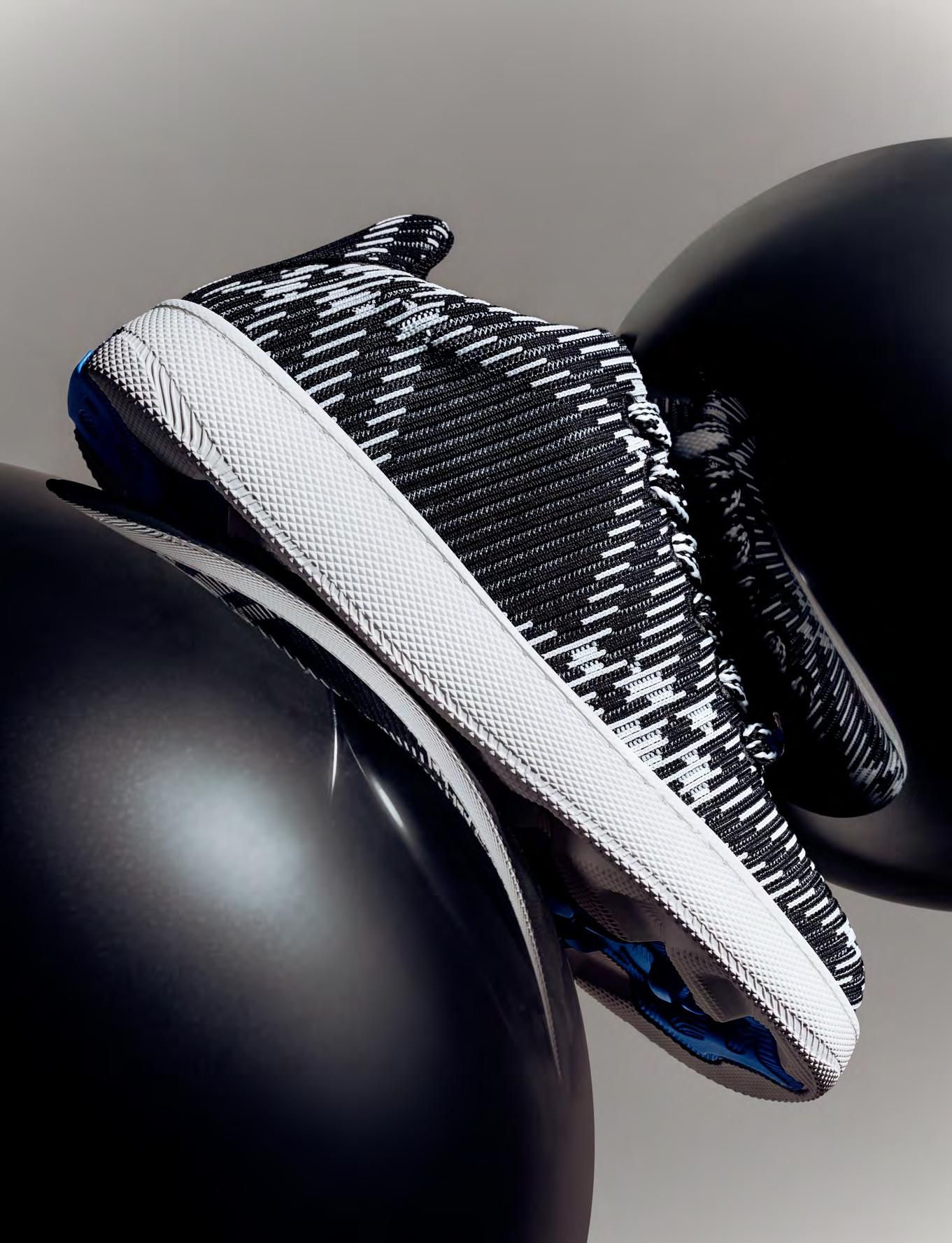
sneakers, BURBERRY THIS IS YUNG A LITTLE PUNK 192-193
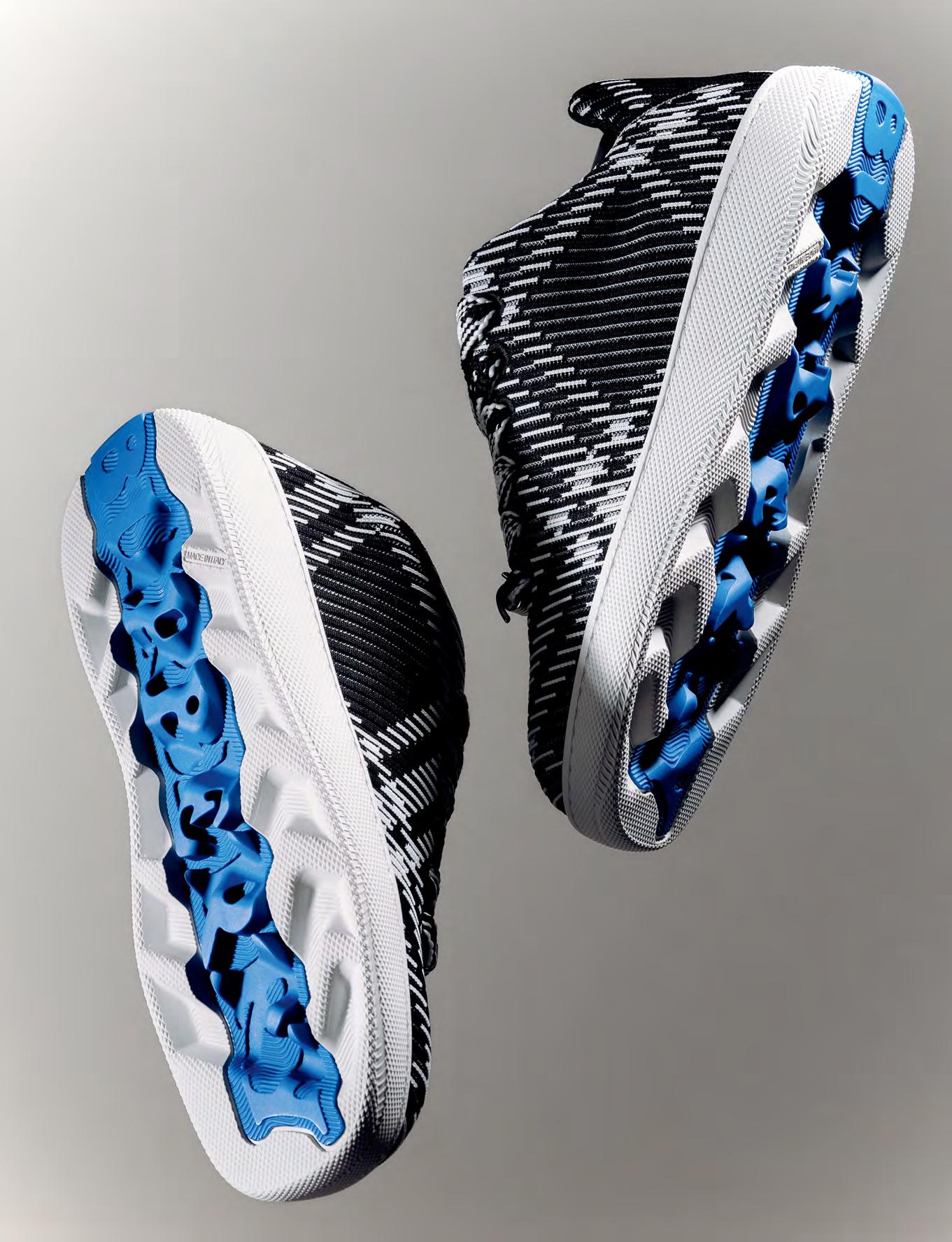 production assistant SANA JAMALI
sneakers, BURBERRY
production assistant SANA JAMALI
sneakers, BURBERRY
Here, fine and fashion jewellery seamlessly blend, creating a mesmerising tapestry of colours and textures. Chunky styles intertwine delicately with fine craftsmanship, reshaping jewellery wearing.
BEY OND THE SUR FACE
Each piece tells its own unique story, echoing the individuality of its wearer. Explore brands like Tiffany & Co, Cartier, Van Cleef, Chopard and Boucheron alongside Bottega Veneta, Sarah Noor and Monies, each offering a unique narrative.
photography SIMON MCGUIGAN styling NUJOUD OWEIS
THIS IS YUNG BEYOND THE SURFACE 194-195
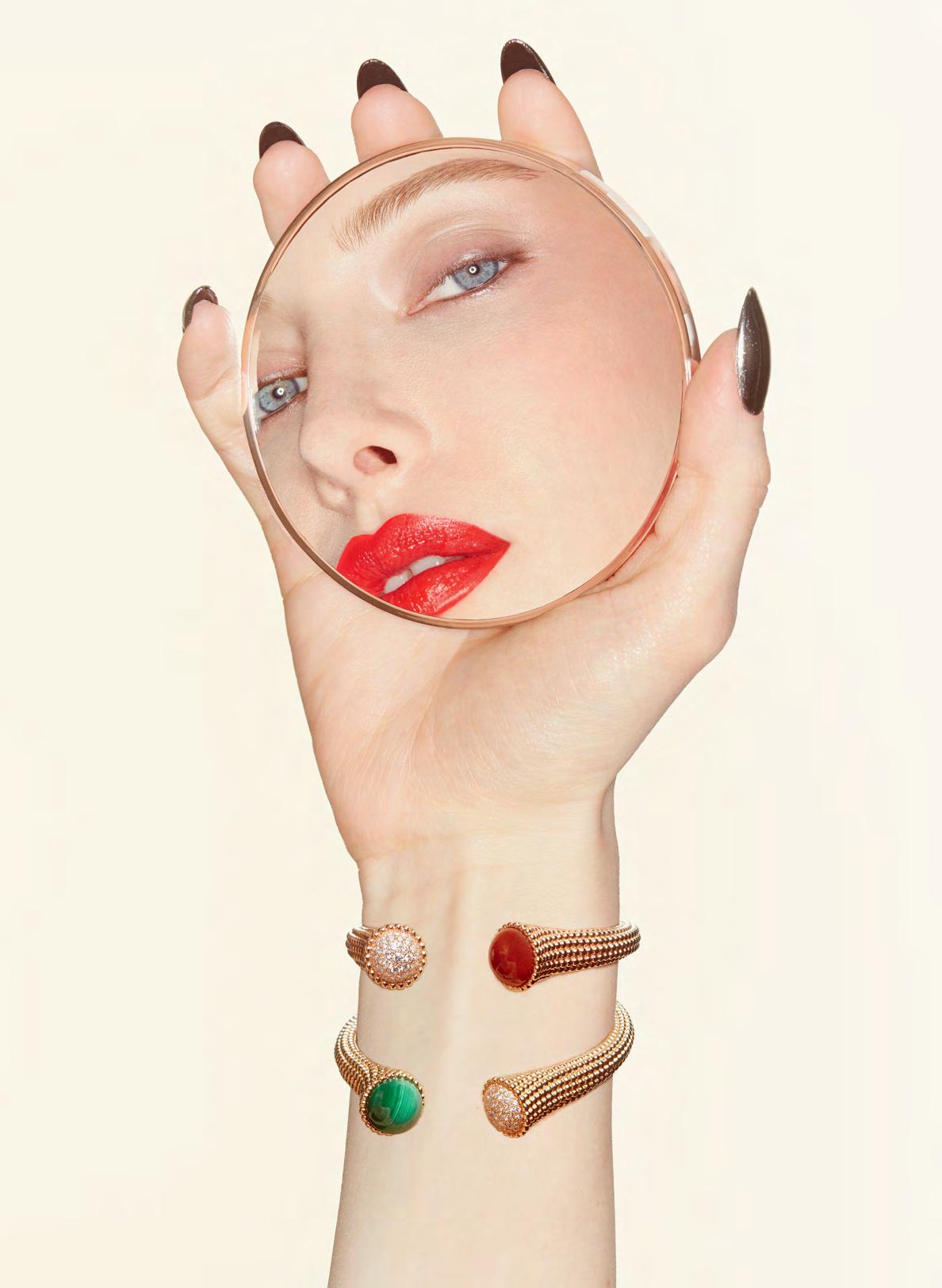 bracelets, VAN CLEEF & ARPELS
bracelets, VAN CLEEF & ARPELS
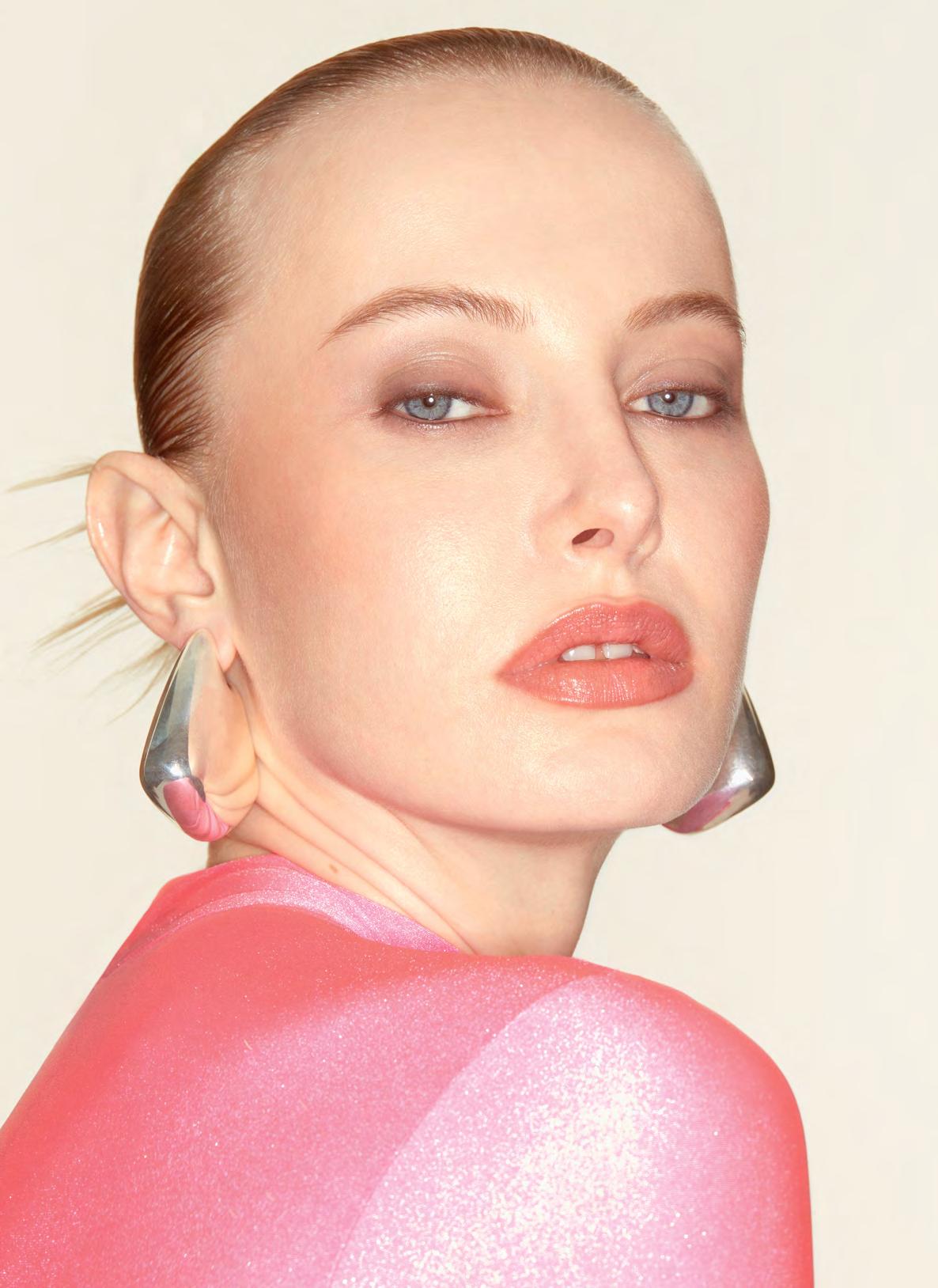
THIS IS YUNG BEYOND THE SURFACE 196-197
earrings, BOTTEGA VENETA. top, ZIYAD BUAINAIN
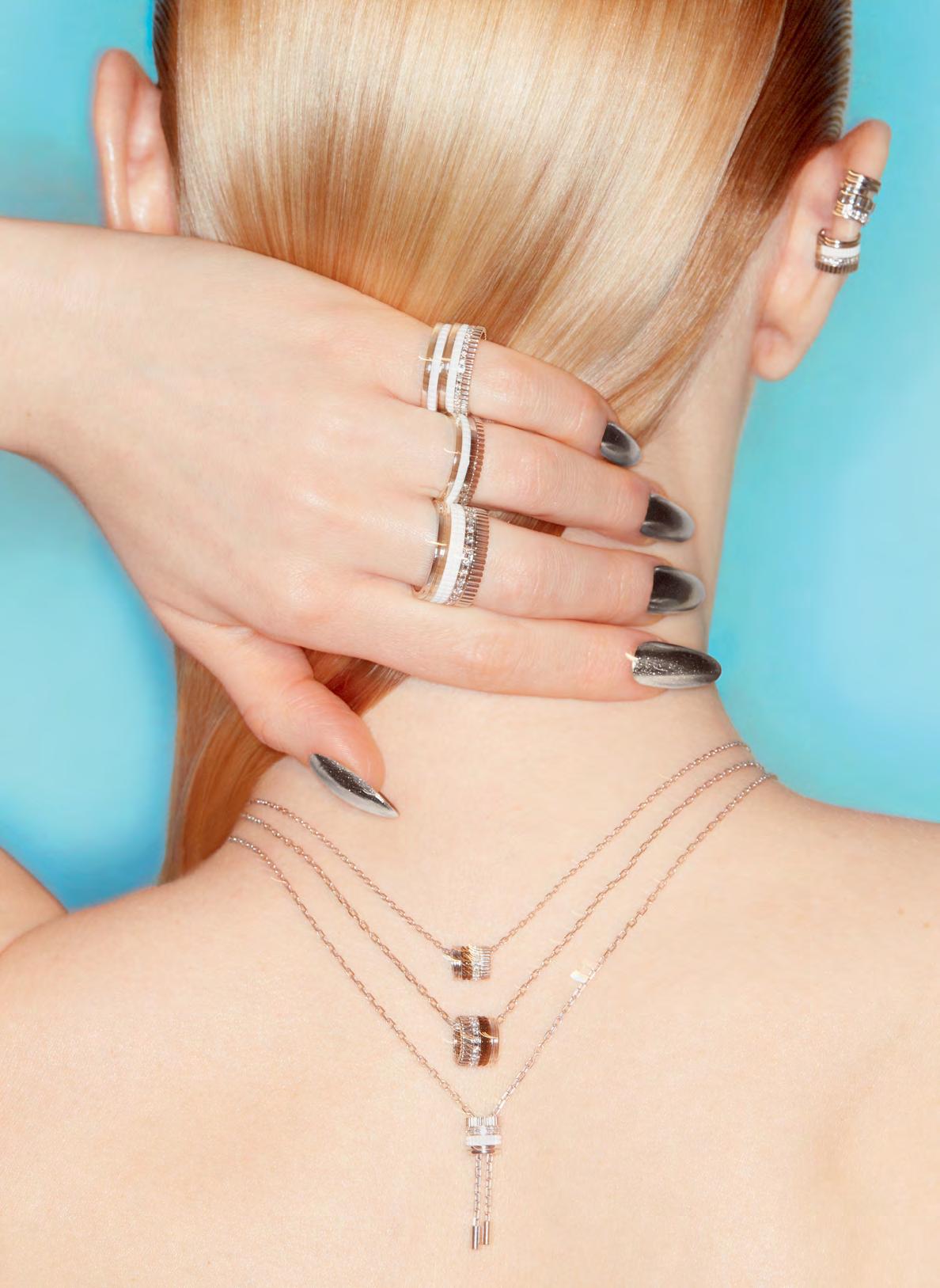
rings, necklaces BOUCHERON

THIS IS YUNG BEYOND THE SURFACE 198-199
bracelet, necklace, earrings, MONIES


THIS IS YUNG BEYOND THE SURFACE 200-201
bracelet, rings, SARAH NOOR JEWELLERY. stockings ZIYAD BUAINAIN. heels, STYLIST’S OWN
 ring, bracelets, necklace, earrings, CARTIER
ring, bracelets, necklace, earrings, CARTIER

THIS IS YUNG BEYOND THE SURFACE 202-203
earring, CHOPARD
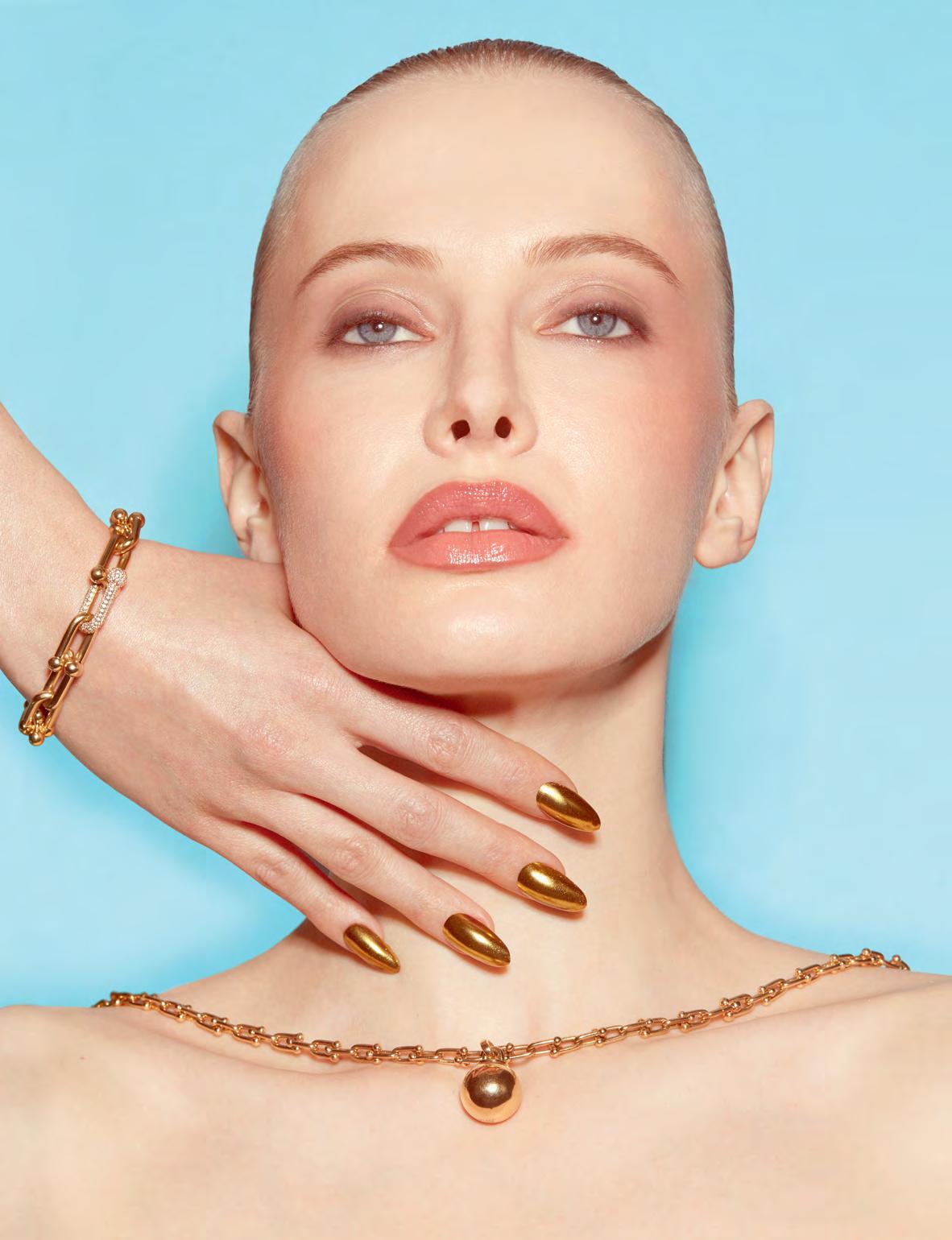 bracelet, necklace, TIFFANY & CO.
bracelet, necklace, TIFFANY & CO.

rings,
BOUCHERON
THIS IS YUNG BEYOND THE SURFACE 204-205
makeup BROOKE SIMONS; hair LEWIS STANFORD; model LENA NETREBI at BODY LONDON; producer LANA SHASH
 earrings, necklace, CHOPARD
earrings, necklace, CHOPARD
Revolutionising Radiance
Welcome to “Revolutionising Radiance,” an exclusive exploration of the dynamic world of beauty in the Middle East. Join us as we delve into avant-garde brands from the region that are setting trends for the new generation. In this feature, we not only decode the unique messages these brands convey to the evolving sensibilities of a new era, but also spotlight the distinctive attributes that set them apart in the competitive beauty market.
Beyond the surface, we uncover how these brands redefine standards and cater to the diverse needs of the modern consumer, unveiling their stories, philosophies, and innovations that position these luminaries as trendsetters in the ever-evolving landscape of beauty and skincare.
words NUJOUD OWEIS
THIS IS YUNG 206-207 REVOLUTIONISING RADIANCE
ASTERI BEAUTY
DINAÏA
SESH
HUE
BY MINA AL SHEIKHLY
SESH Natural, Safe
The local beauty brand dedicated to organic, chemical-free products.
Founded by Mariam Mallawany in 2022, SESH is dedicated to those who seek the utmost quality, care, and a steadfast commitment to wellness. The brand’s mission is to offer Safe, Effective, Smart, and Happy (SESH) products that elevate and enhance the beauty experience for its customers.
SESH places an emphasis on safety, subjecting all products to rigorous stability testing to confirm their non-toxic, paraben-free, and 95% organic composition. Prioritising customer satisfaction, SESH products boast high concentrations of premium active ingredients, ensuring optimal effectiveness and enduring results.
SESH strives to turn skincare routines into delightful experiences, leaving customers with radiant, happy faces. SESH’s formula for success lies in creating effective, and intelligent products, ensuring optimal results and infusing joy into every step of the skincare journey.

In your eyes, what does Sesh truly mean to you?
I came to realise that each day presents us with a series of decisions that collectively shape our identity. For me, the essence of leading a fulfilling life lies in adhering to four fundamental pillars of self-care: Safe, effective, smart, and happy—which spells SESH. These principles aren’t just abstract concepts; they’re deeply ingrained in every facet of SESH, from our products to our marketing ethos. Our commitment to providing safe, transparent formulas, leveraging cutting-edge science for effective results, and embracing new technologies to offer efficient, streamlined packaging. Above all, SESH embodies the pursuit of happiness. It’s about finding joy in every moment, celebrating life’s little victories, and embracing authenticity in everything I do.
If Sesh were a superhero in the beauty world, what Middle Eastern beauty challenges would it tackle to save the day? Well, the first and arguably the most significant challenge is the Sun. It’s like that toxic relationship you just can’t get enough of. We adore it, we love basking in its warmth, and it makes us feel alive. But then it comes around and slaps us in the face with some serious hyperpigmentation, sun damage, and premature ageing. And yet, we keep coming back for more. Enter SESH, our superhero. With specially formulated broad-spectrum sunscreens designed to protect you in your toxic relationship that, let’s be honest, you’re not about to neglect anytime soon!
Our lightweight, non-greasy formulas ensure you stay protected no matter what.
THIS IS YUNG REVOLUTIONISING RADIANCE 208-209
What gaps in the market did you wish to fill when launching Sesh?
Health and wellness have always been top priorities for me, especially when it comes to skincare. However, upon returning to Egypt after my studies in London and work in Paris, I was struck by a disappointing reality: Despite Egypt’s rich history as the birthplace of skincare and self-care rituals, the options available did not resonate with me. It became apparent that Egyptian cosmetics, despite their ancient heritage, were lagging behind, lacking in luxury, effectiveness, and practicality.
Our name, “SESH,” originates from the ancient Egyptian word for “scribe,” individuals who preserved knowledge, magic, and spirituality of self-care by writing on walls; it was a communal practice for all.
What is your ultimate morning SESH skin care routine? Talk us through it.
As soon as I wake up, I give my already clean face a quick rinse with water and then grab our trusty Simply One Ultra-Fluid Sunscreen. This product is an absolute must-have in my routine. I then use our Simply Rinse Oily Cleanser, specially formulated for oily and combination skin.
Now, let’s talk wrinkles. Those weightlifting faces we all make? Yeah, they’re not exactly doing us any favours in the anti-aging department. That’s why I prioritise our anti-aging line to keep those lines at bay.
I begin with our Ready in Action Serum. This product is truly like magic in a bottle. It instantly firms, plumps, and smooths out those forehead lines. Then, I follow up with our Effective Boost Anti-Aging Cream. Packed with cell-building proteins and vitamins, it provides nourishment, strength, and deep hydration to my skin.
Last but certainly not least, sunscreen –round two. Rain or shine, I never leave the house without it. Skipping sunscreen is like making a cake and forgetting to bake it. Be sure to choose a product with broad-spectrum protection against both UVA and UVB rays, with an SPF of 50 or higher.

“[The Sun is] like that toxic relationship you just can’t get enough of.”
If SESH were a beauty guru giving advice to the younger generations, what slogan or advice would it be?
SESH would proudly chant our slogan, “Simply SESH, Simply You.” Why? Because, amidst the myriad of advice out there, it’s easy to feel overwhelmed and lost. You might hear one expert recommend focusing solely on gut health to cure acne, another suggest Botox, and yet another will swear by a chemical peel. While it’s important to consider advice from various sources, ultimately, it’s about experimenting with different products, routines, and techniques until you find what truly resonates with you. Your skin, your body, your journey—You know You Best. ■
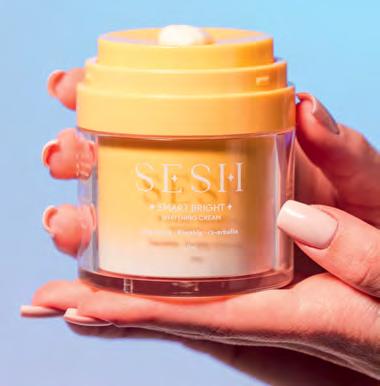
DINAÏA Clean Beauty
Dinaïa embraces nature to provide clean, natural hair care designed for Arab women.
Dinaïa is rapidly making a name for itself as a distinguished clean hair care brand, celebrated for its refined sophistication and steadfast commitment to natural, bio-active ingredients. Rooted in the natural potency of oils, the brand’s vegan and cruelty-free formulations embody a harmonious blend of tradition and innovation. Founded by Dina Shaban, the brand aims to serve health conscious Arab women and offers premium, personalised hair care products that not only cater to individual hair types, but that also pay homage to cultural heritage.
What does the concept of clean beauty mean to you?
It’s about looking beyond the surface benefits to what’s inside the bottle and considering the entire lifecycle of the product, from its creation to its impact after use. It embodies a holistic approach to caring for yourself and the environment, with the emphasis on natural ingredients, cruelty-free testing, and no harmful chemicals. It also means embracing sustainability throughout every step of the process, alongside transparent brand communication and honest marketing.
Was there a market gap that you wanted to fill through Dinaïa?
With Dubai’s harsh weather, I encountered a personal struggle: Finding affordable haircare products that effectively tackled dryness and frizz while aligning with my preference for clean, natural ingredients. I also noticed a gap in the market for hair care products tailored specifically to the needs of Arab women. Our hair textures and the environmental challenges we face are unique, yet existing
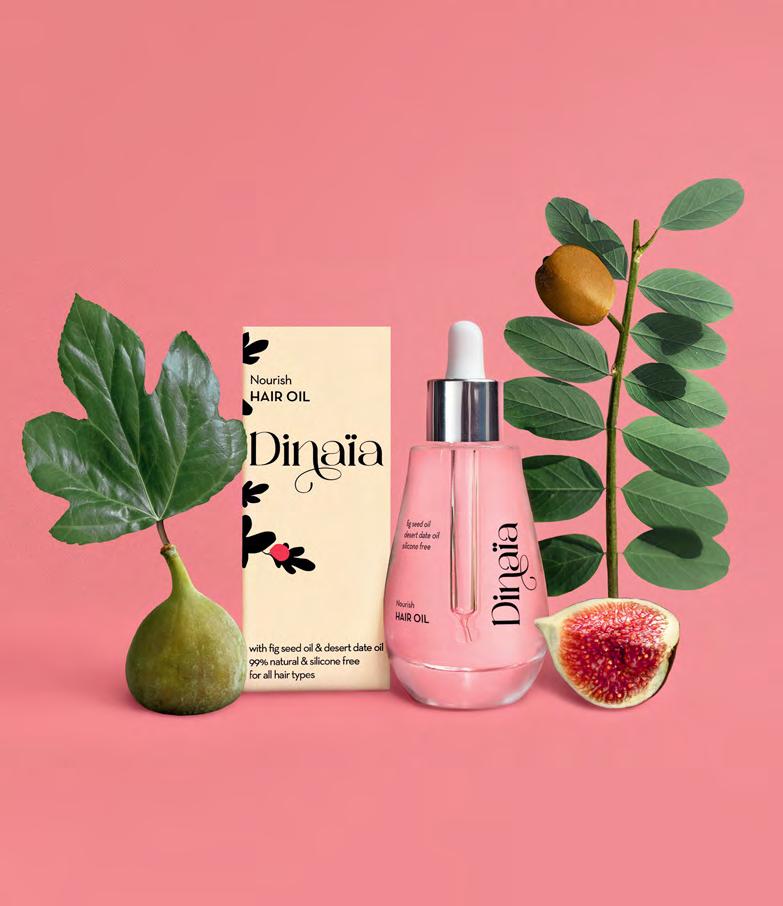
clean hair care brands mainly cater to European or African hair types, leaving Arab hair somewhere in the middle, overlooked.
Founded by an Arab woman for Arab women, our brand utilises ingredients inspired by the region to offer clean and effective hair care formulas tailored to Arab hair types. However, Dinaïa isn’t just about products, it’s also about fostering a sense of community. I envisioned Dinaïa as a platform for like-minded women to connect, share self-care tips, and nurture holistic wellness and empowerment.
If you could choose anyone to experience your products, who would it be?
My late grandmother. I inherited her hair so I would’ve liked to hear her feedback on my products. She was also super honest and transparent and I always respected her opinion. When it comes to beauty, she’s the inspiration that comes to mind. I remember watching her during my childhood as she applied her creams and masks before bed.
What message do you aim to convey regarding women and their holistic wellbeing through the Dinaïa brand?
Our message at Dinaïa about women and their overall wellbeing is one on empowerment, self-care, and embracing natural beauty. Speaking from my own experience, my hair texture ranges from wavy to curly, depending on the day, and throughout my teenage years and into university, I was fixated on straightening it, influenced by prevailing beauty standards heavily shaped by Western media. While many Arab women still lean towards heat styling and permanent straightening treatments like keratin, there’s a growing awareness of the damage they can cause to our hair. We’re beginning to appreciate and celebrate our natural waves and curls more. Our aim is to emphasise that true beauty comes from within, nurtured through mindful practices that prioritise both physical and emotional wellbeing.
THIS IS YUNG REVOLUTIONISING RADIANCE 210-211
Can you share some of your favourite ingredients that you have incorporated into Dinaia products and elaborate on why they hold significance for you?
In our Nourish Hair Oil, my favourite ingredient is desert date oil, due to its lightweight nature, effectiveness, and sustainability. In our Nourish Skin Oil, I’m obsessed with olive squalane and watermelon seed oil, which were chosen with my Palestinian roots in mind. Olive squalane, derived from olives, helps replenish the skin’s moisture barrier, while watermelon seed oil, with its high concentration of linoleic and oleic fatty acids, hydrates, nourishes, and soothes the skin, leaving it feeling smooth and silky. The olive tree, deeply rooted in Palestinian culture, symbolises resilience and connection to the land, while the watermelon’s colours, resembling those of the Palestinian flag, serve as a reminder of steadfastness and resistance in the face of ongoing occupation and apartheid.

“The ideal Dinaïa woman is someone who cares about her health and understands the importance of self-care as an essential aspect of her overall wellbeing.”

What advice would you give to the younger generation to maintain a clean skincare and beauty lifestyle?
Use SPF! I cannot reiterate this enough! Growing up I wasn’t that aware of the extent of damaging effects of the sun, so if there’s one skin care product to pick over others, it would definitely be sunblock. Stay hydrated too, especially in those scorching hot months. I’d also recommend consulting a dermatologist for any skincare concerns instead of impulsively buying products. It’s crucial to choose products tailored to your skin type. ■
HUE
Shades of Inclusion
In an industry dominated by restrictive tones, local makeup brand HUE is changing the game.
Meet HUE, the revolutionary skincare brand that transcends traditional beauty norms, celebrating the deep connection between unadorned skin and vulnerability. Founded by Mona Haidar and Hani Hassan, HUE is dedicated to embracing the transformative influence of love as a sanctuary for genuine self-expression. At the heart of HUE’s philosophy, love emerges as the key to navigating the inherent complexities of revealing one’s true self, cherishing diverse expressions of love within the realms of sisterhood, romance, and friendship.

Can you share your inspiration and background as the co-founders of HUE?
Hani: Dark skin is structurally and biochemically different to white skin and has different needs. There’s very little skincare that acknowledges this. I had spent thousands on my skin. On lotions and creams, on expensive facialists and private dermatologists. Barely anything worked, and anything that did, was hard to come by and expensive. Being a doctor empowered me to take this issue into my own hands. I extensively studied the scientific literature and came up with an evidence-based skincare routine for acne and hyperpigmentation in dark skin. The results were excellent.
But I felt strongly that you shouldn’t have to be a doctor to be able to know which products will work for your skin. Coupled with the fact that there was very clearly an unmet need for skincare for People of Colour - I felt keenly that it was time to take things into my own hands!
Why did you believe it was the right time to introduce HUE to the market?
Hani: Everyone should be able to access effective skincare, but skincare doesn’t include everyone. There were many reasons that made us feel it was the right time to launch HUE.
First, traditional brick and mortar infrastructure has historically made it challenging to supply long-tail offerings like skincare for POC. The changing digital landscape means that Millennials and Gen-Z consumers are both more informed about and better positioned to acquire products that are tailored to their specific needs. Secondly, the launch of Fenty Beauty in 2017 created a paradigm shift in makeup. Their campaign to deliver “beauty for all” with an extensive 40-shade foundation range became the biggest beauty launch in history and changed the landscape in beauty. We felt it was time to include skincare in this conversation.
THIS IS YUNG REVOLUTIONISING RADIANCE 212-213

“HUE is a skincare brand that does not seek to change people, but accept them as they exist.”
Mona: We sought to blur the false binary between science and art, exploring the path where form follows beauty while still serving its function. We believed that scientific rigour could be expressed through beautiful design. Our efforts materialised through various channels, including the development of our own typeface, “HUE Alif,” inspired by handdrawn lettering with serifs that gently drape. Our campaigns focus on honouring the craft of photography, crafting imagery that exudes tenderness and vulnerability. Our product design draws inspiration from traditional beauty rituals ingrained in our cultural practices.
Who is the ideal HUE woman?
Mona: Our aspiration for Hue is to cater to the diverse needs and skincare concerns of People of Colour, we aim to address the multifaceted needs and concerns of our customer. We understand that our communities are not homogeneous; they are richly diverse in their skincare requirements, media consumption preferences, tastes, and desired levels of engagement with brands. By acknowledging this reality, we can authentically serve our community by offering a range of products and experiences that resonate with their individuality.
We believe in seeing people as they are and acknowledging the diverse needs and preferences within our community. We believe in building complexity into our brand offering, recognizing that not everything is meant for everyone.
What is the core message that HUE aims to convey to its customers, especially the younger generations? How does the brand contribute to the empowerment and confidence of its users?
Hani: I think the core message of HUE is probably best embodied by our full title, HERE U EXIST. HUE is a skincare brand that does not seek to change people, but accept them as they exist. Beauty brands can sometimes harm self-image by presenting a normative standard of beauty, by representing ordinary people as imperfect, and by tokenistic representation of inclusivity. At HUE, we aim to showcase all kinds of beauty and self-presentation of people from all backgrounds.
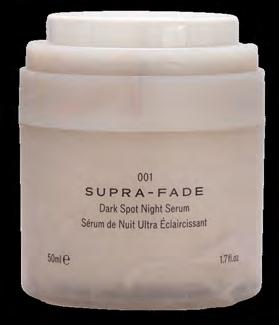
Mona: In reimagining skincare, we can confront and explore the various modalities of caring for our skin. It’s about recognizing that beauty in its definition is not a static concept but a dynamic process and approach—one that evolves with each individual’s unique journey. Perhaps to challenge traditional beauty standards is to abandon this redefining of beauty, and instead root our purpose in storytelling and emotional resonance.
HUE seems to embrace a broader definition of beauty. How does the brand contribute to challenging and reshaping traditional beauty standards, especially in the context of the new generation and their evolving perspectives on beauty?
The words of Hassan Fathy really resonate with me when reflecting on the interplay between tradition and creativity. “When the full power of human imagination is backed up by the weight of a living tradition, the resulting work of art is far greater than any artist can achieve when he has no tradition to work in or when he willfully abandons his tradition.” There’s profound beauty in the way we adorn our homes and dress our tables, like little cities we curate around our mirrors and in our spaces.
The architecture of our dressing tablesthese collections, passed down through generations, of intricately carved mabkharas, sculpted attar bottles, and delicately etched kohl vials, are not just objects—they carry a sense of permanence, a connection to a timeless collective memory.
Even now, as I observe my grandmother repurpose her supra-egg to store her bakhoor, I am reminded of the transformative power of creativity and heritage. ■
 BY MINA AL SHEIKHLY
BY MINA AL SHEIKHLY
Beauty’s Odyssey
By Mina Al
Sheikhly presents a luxurious beauty experience for a discerning clientele.
After a three-year odyssey around the globe and an unwavering quest for the quintessential formula, Mina Al Sheikhly proudly unveils her much-anticipated mascara line, nestled under the illustrious brand By Mina Al Sheikhly. Crafted and thoughtfully packaged in the heart of Italy, these meticulously designed mascaras epitomise a profound commitment to aesthetic excellence. The luxurious marbled packaging, gracefully presented in serene light turquoise and delicate rose hues, draws inspiration from semi-precious stones, which are celebrated for their innate positive energy.
Reflecting the brand’s lofty aspirations, By Mina Al Sheikhly’s mascara aspires to kindle a profound sense of refined elegance and confidence. With a discerning eye for detail extending seamlessly from packaging to branding, Al Sheikhly effortlessly integrates inspiration from the world of interiors, ensuring that every lash is not just adorned, but meticulously tailored and elevated. As Al Sheikhly embarks on this beauty journey, she envisions expanding beyond mascara in the near future, presenting a broader spectrum of meticulously crafted beauty essentials.

Was there a personal story about your own love for beauty that led you to launch your brand?
Absolutely, my journey into beauty started because I truly believe in the power of makeup to transform and boost confidence. I’ve always been fascinated by how it enhances people’s features. This passion, combined with my love for mascara, inspired me to create my own brand. It’s about sharing the confidence-boosting impact that good makeup, especially mascara, can bring to everyone.
As a beauty entrepreneur, what are your makeup essentials?
Mascara, lip balm, moisturiser, and concealer.
What inspired you to launch a mascara line after three years of global exploration and formula research?
It all began with my obsession as a Mascara Junkie. I travelled the globe in search of the perfect mascara formula. After three years of digging into the diversity of lash types through research, it became clear - everyone has different lashes and eyes. This realisation inspired me to develop a mascara line that caters to these variations. In my search for the right formula, existing options just weren’t cutting it. After three years of exploration and research, I recognized the need for a mascara that suits every lash and eye type. The result? A unique formula crafted to boost confidence without the need for fake lashes. What do I want you to feel when using my products?
Simple. Confidence. No need for those fake lashes. I used to apply makeup to friends, showing them how to use mascara and encouraging them to let go of the fake lash crutch. It’s about embracing and enhancing what you already have.
THIS IS YUNG REVOLUTIONISING RADIANCE 214-215
Do you plan to expand your product line further? If so, which products are you keen to explore?
Yes, definitely. Looking beyond the eyes.
What challenges did you face during the three-year journey, and how did these challenges shape the final outcome of your mascara line?
Standing out in a market full of similar products was tough. But we focused on making things good, improving our formula, and really understanding what people want. That made a big difference in shaping the final result.
Connecting with younger generations can be a wild ride. How do you keep things cool and relatable for the new generation?
Makeup is universal, catering to multiple generations. Whether you’re 16 or 45, everyone needs a good mascara.
Who is the ideal By Mina Al Sheikhly customer?
Someone willing to experiment with their looks; essentially, everyone.
You’ve gained a boost of confidence after applying your mascara; what event are you getting ready for?
Wearing it at work or a night out with friends. Mascara is versatile and suitable for any occasion.
What do you find special about precious stones that led to the creation of your luxe marble packaging?
The inspiration behind our luxe marbled packaging, featuring calming light turquoise and rose hues, comes from my genuine fascination with semi-precious stones. I’ve always believed in the positive energy these stones exude, and I wanted to mirror that uplifting effect in By Mina Al Sheikhly’s mascara. My background in interior design played a significant role in shaping every aspect of the packaging and branding. It’s a thoughtful and meticulous process to ensure that your lashes not only feel tailored, but are elevated to a new level of sophistication. The world of interiors has been a constant wellspring of inspiration for me, allowing me to infuse a touch of positivity and luxury into every detail of your beauty experience.
What advice do you have for young entrepreneurs wanting to start a beauty brand?
Do thorough research, prioritise quality over everything. A brand’s success lies not just in the name but in the quality that sets it apart from others. ■
“We focused on making things good, improving our formula, and really understanding what people want.”

ASTERI BEAUTY Generational Inspiration
Tailored to the harsh weather of the region, Asteri is a homegrown beauty brand with global appeal.
Originating in Saudi Arabia and founded by Sara Al Rashed, Asteri’s journey is a poignant testament to women’s empowerment, inspiring individuals to radiate their distinct light in the world. Steeped in the cultural richness of the Arab region, the brand is fuelled by the collective anticipation of a brighter future, echoing the resilience and determination of its roots. Recognizing the profound historical significance of makeup in the Middle East, Asteri assumes the role of a guardian, ready to share the beauty wisdom accumulated over generations.

What inspired you to create Asteri Beauty, and how does the brand reflect your personal journey and values?
It was a combination of things, really. Our lives as Arab women have become more hectic, and fast paced nowadays, we don’t have time to sit with a makeup artist every time we want to go out, we want makeup we can use easily, that looks good, professional and that is kind on our skin. And one of the things that pushed me is that there is the stereotypical look for Arab women and I wanted to show the differences in Arab women. I have also always struggled with skin issues growing up and it was always a struggle to find the right products that could give me the right coverage, but that also look like skin and that are easy to use. I guess the brand reflects my identity and values, it being clean, kind to skin, sustainable and vegan.

THIS IS YUNG REVOLUTIONISING RADIANCE 216-217
“I really believe in using makeup as a tool to self express and boost your confidence, but never to mask yourself or change the way you look. ”
Being born in Saudi Arabia, how has Arabia’s rich heritage influenced the formulation and ethos of Asteri Beauty?
It influenced everything about Asteri beauty. Names, formulas and design. We are a desert proof brand which tells you right away that our formulas were inspired by where we come from. The weather we live in has inspired us to create long lasting products that withstand the heat. We have infused our formulas with local ingredients such as moringa, date seed oil and pomegranate. Also the naming for a lot of our products comes from here, for instance the legacy lipstick shades are named after Saudi women. The design of our packaging and our stores are all inspired by Saudi nature and each store will be different, depending on the city it is in.
As a founder, what gaps did you identify in the region’s beauty market that Asteri Beauty aims to fill, especially concerning the needs of the younger generation?
For us, the weather is the most demanding need we have, and creating shades that are suitable for our skin ranges. Also a big part of Asteri is that we are created for the modern Arab woman, a woman who is on the go and always moving, but she always wants to look good.
As the company’s founder, what’s your go-to beauty routine using your own products, and can you share your favourite beauty combo?
To be honest, I use all our products and only our products, depending on the events I have, the product application varies. But I would say for my everyday go to I start with the Aura concealer, the Maha mascara, Archer brow pencil and gel, our Swoosh Blush stick, the universal lip liner and finish up with the Sweet Oasis lip gloss and then finish up with adding some of our Aria highlighter.
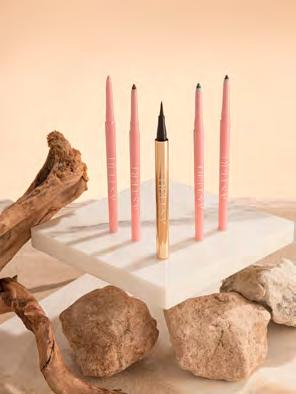
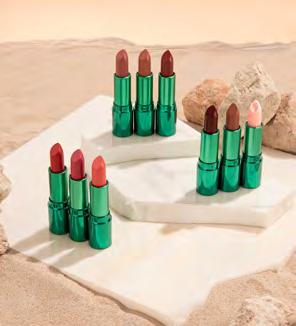
If Asteri Beauty collaborated with a public figure for a special edition product, who would it be, and what kind of beauty item would you create together?
There are a lot of beautiful and interesting figures that we would love to work with. For now, what I would love to do is a collaboration with a Saudi or Arab sports person to create something that works for sporty people. I think that would be the ultimate test.
As a founder with a passion for empowering women, how do you envision Asteri Beauty inspiring self-expression and creativity through make up for the younger generation?
I believe that makeup is a tool to express oneself, like fashion or art. It’s a beautiful way to express your personality. In my personal case, I put on my makeup depending on how I feel that day. I also use makeup to sometimes lift my mood if I’m feeling a bit down or if I feel I need to boost my confidence. I really believe in using makeup as a tool to self express and boost your confidence, but never to mask yourself or change the way you look.
What is one priceless beauty tip you would give for the younger generation?
Always hydrate your skin and use sunscreen. And if you have any skin issues, see a dermatologist. ■
WAT THIS IS YUNG WATCHES 218-219
CHES


THIS IS YUNG BULGARI STUDIO 220-221
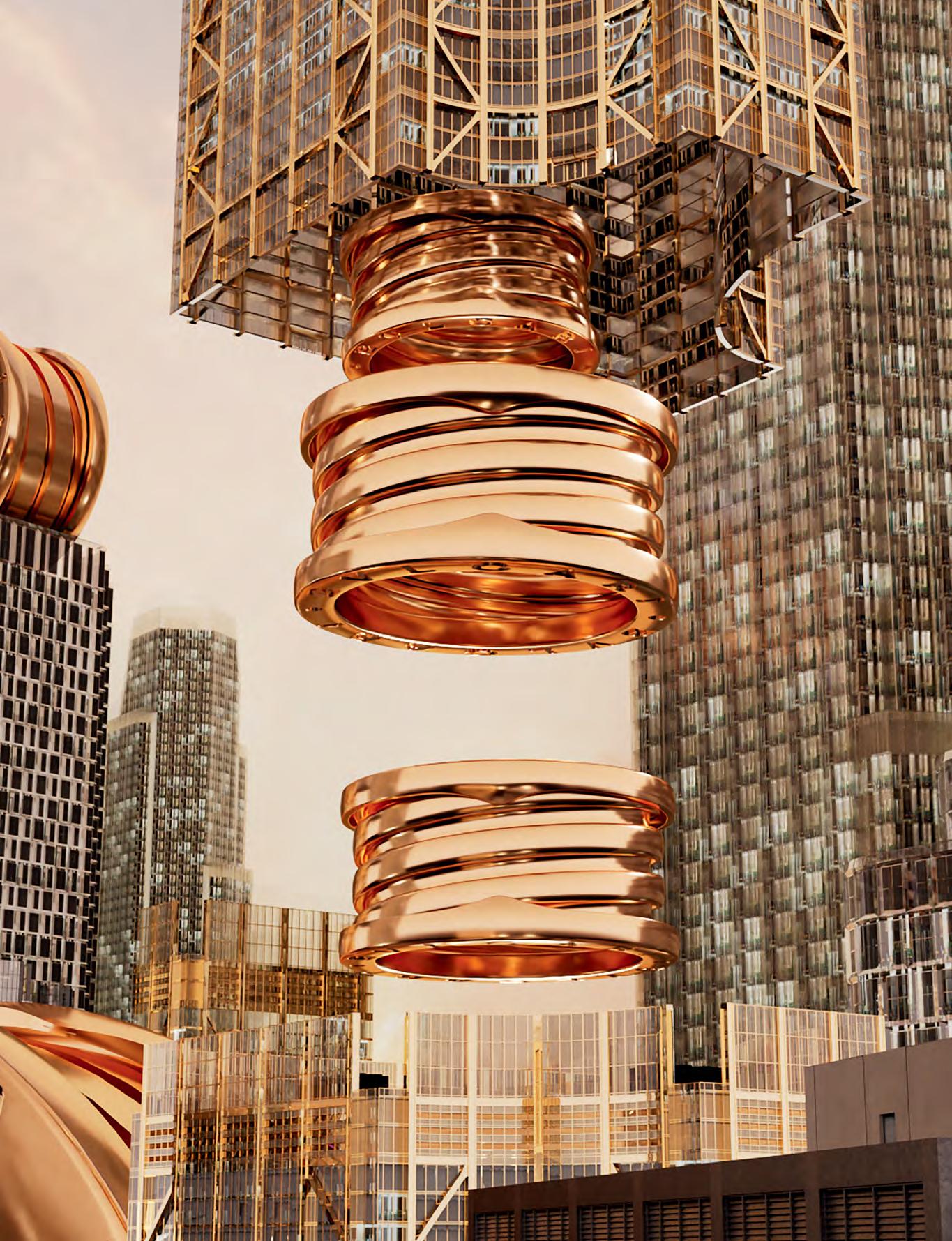

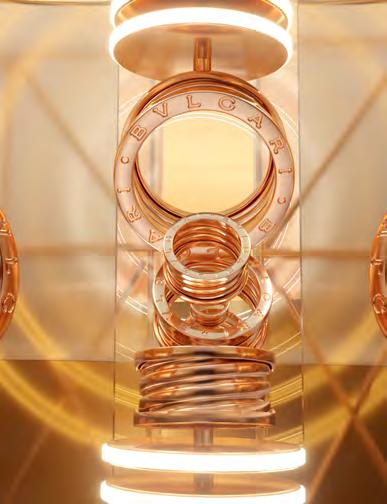

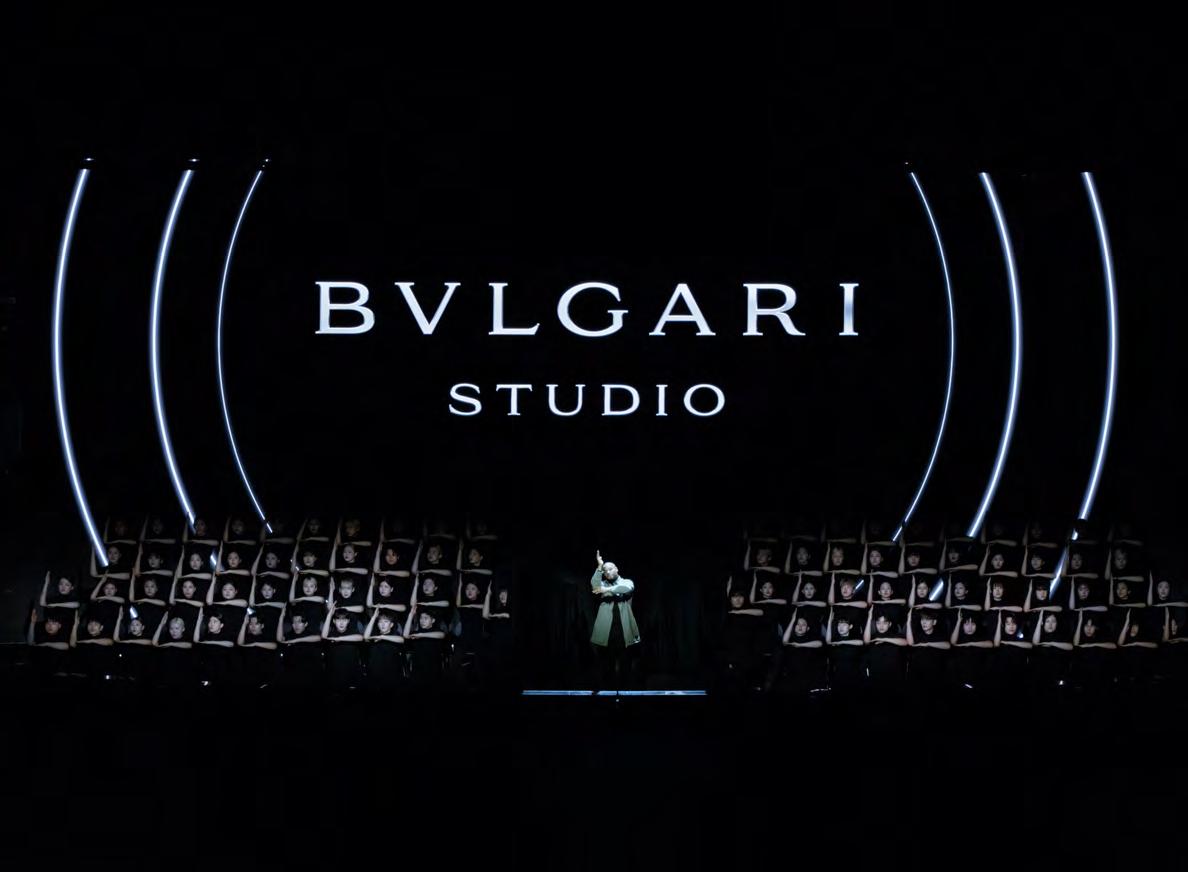
THIS IS YUNG BULGARI STUDIO 222-223
In
Seoul, Bulgari Studio launched at Théâtre des Lumières. Here, guests were immersed in a world where design, innovation, and creativity converge.
For over 140 years, Bulgari has stood as a shining example of Italian design genius, continually reinventing the very concept of luxury with its bold aesthetics and pioneering vision. Today, they chart a new course with Bulgari Studio, an ambitious creative platform designed for cross-pollination and exploration beyond the boundaries of art and design. This initiative represents a melding of Bulgari’s innovative spirit and the brilliance of contemporary creators, reinventing the narrative to create startlingly fresh, contemporary takes on the House’s icons.
Central to Bulgari Studio are three seminal pieces, each embodying the essence of daring, curiosity, and unbridled creativity. The B.zero1 ring, more than a mere jewel, is a mindset, an embodiment of self-expression. The Bulgari Bulgari collection transforms the Maison’s Roman-inspired logo into a distinct aesthetic emblem. And the Bulgari Tubogas, merging visual elegance with supreme wearability, showcases the Maison’s ingenious craftsmanship.
These icons serve as a platform, as muses for digital artists, designers, and visionaries, allowing them to explore their limitless imagination through new forms of creative expression. The aim is to shift the very concept of design and creativity in the fields of watches and jewellery through new, original forms of creation.
Seoul, a hub of creativity and innovation was chosen for Bulgari Studio’s debut. The city is a famed home to burgeoning creatives in the fields of art, fashion, design and more and it seemed a fitting site for Bulgari’s new venture. Attracting an international audience of young talents, trend-setters and curious minds, Seoul is the perfect setting.
In Seoul, Bulgari Studio launched Théâtre des Lumières. Here, guests were immersed in a world where design, innovation, and creativity converge, beginning with the versatile B.zero1 ring and extending to other emblematic creations like the Bulgari Roma bag and Bulgari Bulgari watches. The event underscored Bulgari’s commitment to an open-minded, interdisciplinary approach, encouraging visionary minds to enter a realm of shared experimentation and connection.
Bulgari Studio’s journey of
experimentation and global creative exchange is set to continue throughout 2024, engaging a diverse spectrum of creators.
Théâtre des Lumières witnessed the creative genius of the multi-disciplinary artist Anyma. Anyma presented an immersive audio-visual live show that transcended the boundaries between reality and imagination, bringing together his talents as a musician, futurist, and creative director. Combining art forms and mediums, Anyma created an immersive experience that spoke of B.zero1’s original design language while presenting contemporary developments and ideas. French choreographer Sadeck Berrabah, known for his visually stunning choreographies, created a performance in harmony with B.zero1’s aesthetic, symbolizing the power of human connection and individuality.
Central to the Seoul event, and placed in the center of the city, was an awe-inspiring installation depicting the iconic ring as an endless spiral. The installation offered a taste of the performance of a DJ-artist who carefully crafted sound and visuals by merging the creative universes of Anyma and B.zero1. The famed ring was presented in a never-ending spiral, neither horizontal nor vertical, the design pointed toward a future of endless possibilities for those bold enough to embrace it.
The global digital campaign, masterminded by Antoni Tudisco, debuted on March 1st. This unique project, focusing on the iconic B.zero1 ring, reimagined its distinctive features in a surreal, kaleidoscopic fashion, becoming both a teaser and a first experience of Bulgari Studio. The German-based Italo-Philippine artist captured the ring’s sculptural form in a metaphysical dimension, exemplifying the campaign’s theme: transcending the boundaries of imagination. Across the campaign, the ring fluctuates between the real and the virtual worlds, until it approaches the city of Seoul.
Bulgari Studio’s journey of experimentation and global creative exchange is set to continue throughout 2024, engaging a diverse spectrum of creators. The initiative not only highlights Bulgari’s enduring legacy in luxury, but also affirms its commitment to pushing the boundaries of art, design, and technology.
Bulgari Studio is more than a platform; it’s a testament to Bulgari’s legacy of innovation and a guide for future explorations in luxury and creativity. By engaging with artists, designers, and visionaries, Bulgari continues to redefine what is possible, blending tradition with avant-garde ideas to create something truly extraordinary. As Bulgari Studio evolves, it promises to keep us enthralled with its ever-expanding universe of creativity and luxury. ■
THIS IS YUNG BULGARI STUDIO 224-225
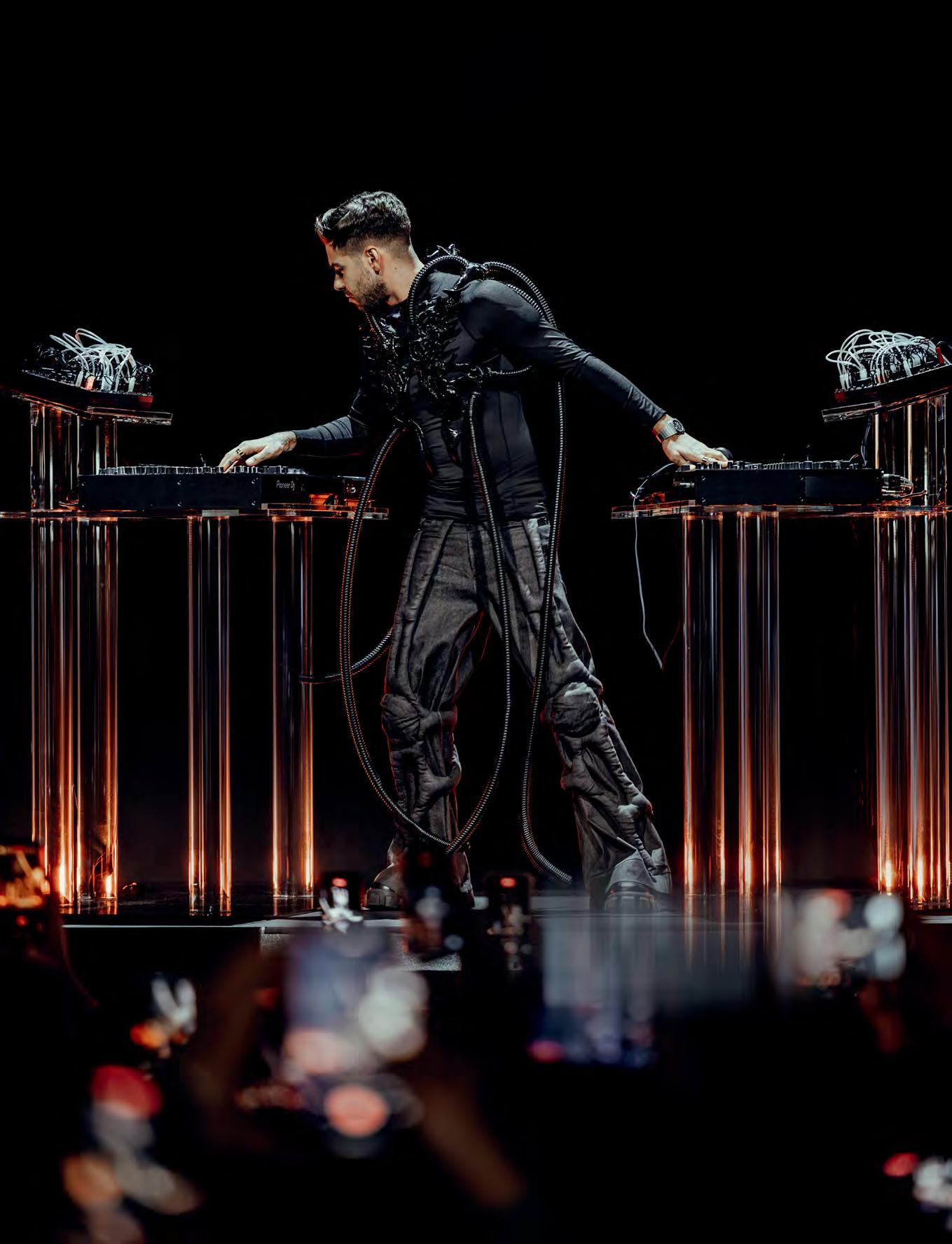
THE RE BIRTH OF AN ICON
Piaget’s famed Polo is reborn to celebrate the famed House’s 150th anniversary.
YUNG recently spoke to the luxury watchmaker’s CEO, Benjamin Comar, about the House’s iconic Polo ‘79, Piaget’s collaborations with local artists and how they intend to celebrate their anniversary.
SANDRA YEGHIAZARIAN
THIS IS YUNG THE REBIRTH OF AN ICON 226-227

In 1979, the world witnessed the birth of an icon: The Piaget Polo. In an era of glamour and high living, Piaget unveiled a timepiece that epitomized the spirit of the 1980s. Now, as Piaget celebrates its 150th anniversary, the Polo ‘79 makes a triumphant return, embodying the zeitgeist of today while paying homage to its illustrious past. Yves Piaget, the visionary behind the House, well understood the shifting landscape of luxury. “Our customers demand elegance, even in their sporting pursuits,” he declared at the time. The Piaget Polo was born—a fusion of sophistication and athleticism, crafted to withstand the rigors of both the polo field and pulsating nightlife.
Initially limited to 79 pieces, the relaunched Polo is remarkable. While technology has moved on, the challenges of creating an ultrathin, waterproof, resilient and beautiful piece remain, and the market’s expectations in terms of durability and lifespan have certainly become more demanding, “It’s a difficult watch to make, more difficult than we expected. The level of waterproofness of mechanical movements, with an 80-year guarantee, you know you’re asking it to be maybe more reliable than it used to be, so strangely enough it’s more difficult. It’s difficult, so it will always be a limited product and we’re happy about that. That’s what luxury is about,” said Comar. While another set might be made, the Polo is never going to a regular production.
Difficult or not, the Polo is a stunning piece that straddles the lines, it’s both an everyday wear, and a sophisticated piece for an evening, and dare to think it, it’s also sporty. “I always say it’s a sports watch, but it’s an evening watch as well, it’s a dressy watch. Sports, the culture of sports, has changed you know, now sports is everywhere, I mean people wear sneakers all the time now, back then you didn’t see anyone in the office with sneakers, everything is more sporty in general. It’s for people to do whatever they want with,” says Comar.
Unlike anything that came before it, the Piaget Polo captivated with its seamless blend of form and function. The bracelet, meticulously crafted from alternating polished gadroon and brushed block links, flowed effortlessly into the case and dial, creating a visual symphony of luxury. It was a statement of opulence in an era defined by excess. All this remains the same, but the watch has, obviously, been given an uplift, becoming yet more refined. The quartz movement gives way to the ultra-thin 1200P1 in-house self-winding calibre, housed within a slightly enlarged 38mm case. Yet, its essence remains unchanged—an embodiment of sports elegance, crafted entirely in 18-carat gold.
The relaunch of this iconic piece is timed to mark Piaget’s 150th anniversary, and though Comar is a little cagey about what the House has planned, 2024 is going to a year full of remarkable events, “During the year there would be a probably a big event in in June, but the idea is to have multiple events that can spread out around the world like this Polo 79, collaborations, Art Dubai, Watches and Wonders, I hope we see a lot of milestones during the year because we have a lot to say.”
Speaking of Art Dubai, Piaget also unveiled collaborations with Emirati jewellery designer Shamsa Alabbar and Saudi fashion designer Razan Alazzouni. The spotlight shone on the Limelight Gala watch, celebrating its 50th anniversary with 16 stunning variations. From matte gold adorned with diamonds to gemstone-comet accents, each piece captivates. Emirati designer Alabbar introduced her unique touch to the dial, becoming the first Arab designer to leave her mark on the watch. Her design, featuring shaded matte yellow gold, intricately weaves geometric patterns, Arabic calligraphy, her iconic Token motif and a mashrabiya element together. Limited to 20 pieces, the watch boasts a linear diamond design, embodying both tradition and innovation.
Saudi designer Alazzouni drew inspiration from a gold Limelight Gala adorned with emeralds, diamonds, rose gold, and chrysoprase. The watch’s opulent textures inspired Alazzouni’s creation, adorned as it was with dense gold embroidery, showcasing the fusion of haute horology and fashion.
2024, a year of celebration for this iconic House. Long may Piaget continue to innovate, celebrate and collaborate. ■
THIS IS YUNG THE REBIRTH OF AN ICON 228-229

“I hope we see a lot of milestones during the year because we have a lot to say.”


“I always say it’s a sports watch, but it’s an evening watch as well, it’s a dressy watch.”
THIS IS YUNG THE REBIRTH OF AN ICON 230-231

History Beneath the Stars
The Royal Oak Perpetual Calendar Limited Edition is an ode to history and the allure of the stars..
Swiss watchmaker Audemars Piguet has unveiled a gorgeous collaboration with American musician and watch aficionado John Mayer. The result? A limited edition Royal Oak Perpetual Calendar that embodies a unique blend of technical prowess and artistic vision. Mayer, a long-time lover of Audemars Piguet and an avid watch collector, lent his discerning eye and passion for intricate design to the project. The Royal Oak Perpetual Calendar “John Mayer” Limited Edition takes the iconic timepiece to new heights, pushing the boundaries of aesthetics while staying true to its rich heritage.
The centrepiece of this limited edition is the captivating “Crystal Sky” dial and Mayer worked hand-in-hand with Audemars Piguet’s artisans to bring his vision to life. The intricately textured brass dial plate features a mesmerizing pattern of irregular shapes, resembling a vast, starlit sky. This captivating effect is achieved through a meticulously crafted electroforming process, ensuring exceptional detail and depth.
“My favourite watches have dials that you can stare endlessly at. A great watch dial feels like a picture window – you look into it, not at it. In the case of this piece, it’s like looking up at a moonless sky,” said Mayer, “There is a true sense of nature in it. And when you couple that sense of depth and vastness with the complication of a perpetual calendar, it is a very powerful combination of technical prowess and aesthetic design.” The “Crystal Sky” dial is further enhanced with a deep blue PVD coating, which intensifies the pattern’s brilliance while maximizing light play. Subtle yet impactful modifications were made to the perpetual calendar display, offering a delightful surprise upon closer inspection. The calendar indications are printed in white against the blue background, ensuring optimal legibility.

Audemars Piguet’s signature alternation of satin brushing and polished chamfers creates a captivating interplay of light and shadow. Finally, the white gold frame of the sapphire caseback is engraved with “Royal Oak Quantieme Perpetuel” and “Limited Edition of 200 Pieces.”
The Royal Oak Perpetual Calendar “John Mayer” Limited Edition marks a significant milestone for Audemars Piguet. It serves as the final limited edition to be equipped with the revered Calibre 5134 selfwinding perpetual calendar movement.
Launched in 1978 at the height of the quartz crisis, the Calibre 5134 stands as a testament to Audemars Piguet’s unwavering commitment to innovation and tradition. It paved the way for a resurgence of classic complications, solidifying the brand’s position at the forefront of Haute Horlogerie. Beating at a frequency of 2.75 Hz and boasting a 40-hour power reserve, Calibre 5134 offers exceptional precision and reliability. The movement’s refined decorations, including Côtes de Genève and circular graining, are visible through the watch’s sapphire caseback, further elevating its luxurious appeal.
The Royal Oak Perpetual Calendar “John Mayer” Limited Edition is a true collector’s piece. It represents the culmination of shared passion, meticulous craftsmanship, and unwavering dedication to excellence. This stellar timepiece not only celebrates a historic movement, but also marks the beginning of a new aesthetic chapter for the Royal Oak collection. ■
THIS IS YUNG HISTORY BENEATH THE STARS 232-233
words LOUIS PARKS

ART & THIS IS YUNG ART & CULTURE 234-235
CULTURE
MAS TERS OF THE LENS
words OMAIA JALLAD
THIS IS YUNG MASTERS OF THE LENS 236-237

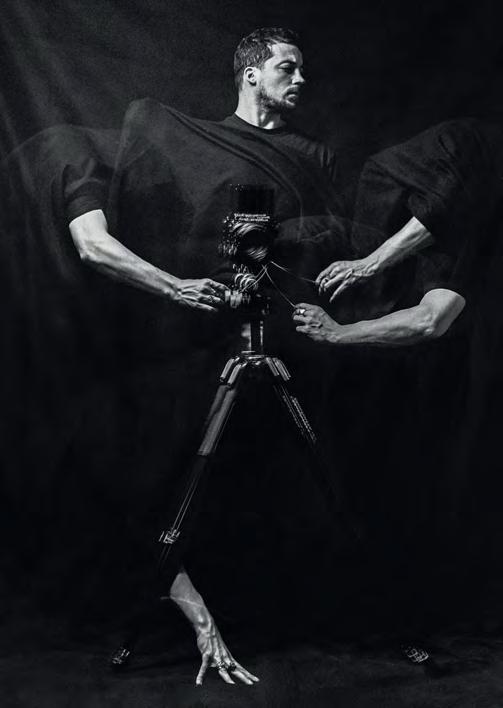
Fashion, as a tangible and three-dimensional expression, serves as a canvas for self-presentation. Photography, confined to two dimensions, relies on our sense of sight alone. However, when these two mediums converge, a harmonious synergy emerges, providing the audience with a comprehensive 360-degree insight into the craftsmanship and the subjects within the work, where the visual prowess of photography intertwines with the tactile world of fashion. Aart Verrips and Tarek Mawad, true masters of the lens, elevate their work beyond mere visuals. Through the strategic use of colours and light, they activate not only our sense of sight but engage all senses, creating a multisensory experience.
Their art is a romantic perception of the world, breathing life into images and transcending the limitations of a two-dimensional frame. With each photograph, they invite us to lose ourselves in contemplation, proving that simplicity in a 2D image can spark a world of intricate thoughts and emotions. Both artists, with their enlightening backgrounds, not only showcase their work but profoundly inspire. Their creations go beyond aesthetics; they elicit emotions, making us feel a connection to the stories and sentiments woven into every image. In the hands of Verrips and Mawad, fashion and photography become a transformative journey, a captivating odyssey that resonates far beyond the visual realm.
AART VERRIPS
TAREK MAWAD
Aart Verrips

Aart Verrips, a luminary filmmaker and photographer hailing from Durban, South Africa, is an eloquent storyteller whose artistry revolves around the core tenets of authenticity and forging emotional connections with a diverse range of subjects. His lens is a vehicle for capturing narratives that transcend the ordinary, with a particular affinity for showcasing the beauty in non-traditional faces, challenging conventional standards. Verrips’ distinctive visual language unfolds in a kaleidoscope of jewel tones, characterised by a pristine and clean aesthetic. His images come to life through a dance of playful romanticism, artful blurs, and carefully crafted, sculptural backgrounds. Embarking on a creative journey that took a detour from his initial pursuit of becoming a pastry chef in France, Verrips has left an indelible mark on the creative landscape.
THIS IS YUNG MASTERS OF THE LENS 238-239
Transitioning from pastry chef to photographer, how does your culinary background impact your visual storytelling?
My culinary background has instilled in me a keen eye for detail, which I apply to every stage of the photographic process, from conceptualization to post-production. Just as a chef carefully selects ingredients and arranges them on a plate to evoke a specific response from the diner, I meticulously curate every element within the frame to convey the intended mood and message in my photographs.
Moreover, my experience as a chef has honed my ability to work under pressure and adapt to changing circumstances, skills that are invaluable on a fast-paced photography set.
Your work is known for its emphasis on authenticity and emotional connections. Can you share the storytelling elements or themes that consistently drive your narrative in both photography and filmmaking?
In both my photography and filmmaking, authenticity and emotional connection are central to my storytelling. I believe that the most compelling narratives arise from genuine interactions and moments of vulnerability. One consistent theme in my work is the celebration of individuality and authenticity. Creating images and films that capture the essence of each subject, allowing their true selves to shine through. Whether it’s a personal project or a client commission, I prioritise portraying my subjects in a way that feels authentic and true to who they are.
Your work is often described as having a bold and provocative aesthetic. Could you delve into the inspirations and influences that shape this distinctive visual style?
My distinctive visual style draws inspiration from a variety of sources that have shaped my artistic journey. One significant influence on my work is classic cinema, particularly the films of directors like Wes Anderson. I’m drawn to Anderson’s meticulous attention to detail and his bold use of colour, which he employs to create visually stunning and emotionally resonant scenes. I find inspiration in the way he carefully composes each frame, using colour palettes to evoke mood and atmosphere. In addition to film, my visual style has been shaped by my experiences working alongside talented photographers and directors early in my career. Through these collaborations, I gained insights into different techniques and approaches to storytelling, which helped me refine my own aesthetic.
Your images often capture a sense of movement and energy. How do you convey these dynamic qualities, especially in fashion photography?
In my fashion photography, I aim to convey a sense of movement and energy by capturing dynamic moments that feel alive and spontaneous. Rather than static poses, I seek to capture the natural flow and rhythm of movement, whether it’s in the swish of a garment or the subtle gestures of the model. One technique I use to convey this dynamic quality is by creating a sense of motion within the frame. This could involve experimenting with composition, framing, and perspective to create a sense of depth and dimensionality. Additionally, I may incorporate elements such as wind, fabric manipulation, or props to add visual interest and enhance the sense of movement in the image.
In your pursuit of showcasing a new standard of beauty, how do you handle the balance between celebrating individuality and meeting the industry’s expectations or demands?
I approach the balance between celebrating individuality and industry expectations with consideration and adaptability.
Understanding the context of each project is crucial. For client work, I carefully assess the brief and objectives to determine how I can best align with the brand’s vision while also infusing elements of diversity and individuality. This might involve advocating for diverse casting choices, challenging traditional beauty standards, or incorporating inclusive messaging into the campaign.
The influence of colour is evident in your work. Can you elaborate on your colour grading process and how you use colour psychology to evoke specific emotions in your audience?
Colour plays a significant role in my work, and my colour grading process is integral to creating the desired emotional impact in my audience. When approaching colour grading, I aim to achieve harmony and balance between different hues, ensuring that they work together seamlessly to evoke specific emotions. My process typically involves working in a digital format, where I apply multiple layers of grading to enhance and refine the colours in the image. I carefully consider the overall mood and atmosphere I want to convey, as well as the specific emotions I aim to evoke in the audience.
Colour psychology plays a crucial role in this process. I draw upon the principles of colour psychology to select hues that are known to elicit certain emotional responses. For example, warm tones like reds and oranges can evoke feelings of passion and energy, while cool tones like blues and greens may evoke a sense of calmness or tranquillity.
How has your South African upbringing shaped your artistic identity, and do you draw inspiration from your roots in your storytelling?
Growing up in a country as culturally diverse and rich as South Africa has provided me with a wealth of experiences, perspectives, and inspiration that I draw upon in my work.
Living in various cities across South Africa, from Durban to Cape Town, Pretoria, and Johannesburg, has exposed me to different landscapes, cultures, and ways of life. Each city has its own unique energy and character, which I incorporate into my storytelling to create authentic and immersive narratives. The diversity of South Africa’s people and cultures has also had a profound impact on my artistic identity. I am constantly inspired by the resilience, creativity, and spirit of the South African people, and I strive to reflect these qualities in my work.
Your images often carry a cinematic quality. If you could choose a film director to collaborate with on a project, who would it be, and what kind of visual narrative do you envision creating together?
Collaborating with a visionary director like Wes Anderson would be an extraordinary opportunity to bring our creative visions together and craft a visually stunning narrative. Inspired by Anderson’s signature style, characterised by meticulous attention to colour, composition, and storytelling, I envision creating a whimsical and captivating perfume advertisement that transports viewers into a dreamlike world of elegance and charm. Drawing upon Anderson’s knack for creating meticulously crafted, visually immersive worlds, we would work together to design sets that are both enchanting and evocative. From elaborate, pastel-hued interiors to picturesque outdoor landscapes, each scene would be carefully curated to capture the essence of the fragrance and evoke a sense of wonder and fantasy. In terms of narrative, we would create a storyline that unfolds like a captivating short film, following a protagonist on a whimsical journey through enchanting settings, each imbued with its own distinct atmosphere and emotion.
The fusion of spontaneity and meticulousness is evident in your work. How do you strike a balance between carefully planned compositions and embracing the unexpected during a shoot?
Striking a balance between carefully planned compositions and embracing the unexpected during a shoot is essential to my creative process. I approach each shoot with a clear vision and plan in mind, but I also remain open to spontaneity and improvisation, allowing room for magic to happen organically. I typically begin by setting up the scene and establishing the initial composition, utilising props and elements already present in the environment to create a rich and dynamic backdrop. This meticulous planning helps to lay the foundation for the shoot and ensures that I capture the desired aesthetic and atmosphere. However, once the initial setup is in place, I embrace the freedom to experiment and play with different angles, perspectives, and movements.
“When approaching colour grading, I aim to achieve harmony and balance between different hues, ensuring that they work together seamlessly to evoke specific emotions.”
As someone who aims to “make the impossible seem possible,” can you elaborate on a moment in your career where you felt you successfully achieved this, pushing the limits of what can be portrayed through your lens?
One moment in my career where I felt I successfully achieved pushing the limits of what can be portrayed through my lens was during the shooting of the 2024 Lavazza Calendar. When I received the brief for the project, I was immediately drawn to the idea of creating larger-than-life sets and props, inspired by my love for films like “Alice in Wonderland” where surreal and fantastical worlds come to life. For this project, I wanted to create immersive environments where the models became integral parts of the storytelling, almost like accessories to the larger narrative. I envisioned scenes where the scale was distorted, playing with perspectives to create a sense of wonder and whimsy.
Many photographers have a signature element in their work. What would you say is your distinctive mark or recurring theme that ties your portfolio together?
A defining characteristic of my photography is my meticulous approach to colour grading. I pay close attention to the mood and atmosphere of each image, using colour to evoke specific emotions and enhance the overall impact. Whether it’s through bold and vibrant hues or subtle tonal shifts, my colour grading plays a crucial role in creating a cohesive visual aesthetic across my portfolio.
Your work captures a fusion of fantasy and reality. How do you decide on the level of surrealism or abstraction in your images, and what role does imagination play in your creative process? The balance between fantasy and reality in my images is often guided by the emotions and narratives I aim to convey. I see my work as a form of escapism—a way to transport viewers to surreal worlds where they can temporarily disconnect from the complexities of reality. When deciding on the level of surrealism or abstraction in my images, I draw upon my imagination and intuition. I envision each photograph as a story waiting to be told, and I allow my creativity to guide me in exploring different levels of fantasy. Sometimes, this might involve subtle touches of surrealism, such as incorporating dreamlike
elements or playing with perspective to create a sense of wonder. Other times, I may lean more heavily into abstraction, pushing the boundaries of reality to evoke strong emotional responses from viewers. Imagination plays a central role in my creative process. It fuels my experimentation with composition, colour, and storytelling, allowing me to push the limits of what’s possible within a photographic frame.
Your images often feature striking jewel tones and clean aesthetics. How do you choose the colour palette for a particular project, and how does colour contribute to the emotional resonance of your work?
Selecting the colour palette for a project is a collaborative process that involves close coordination between myself, the set designer, and the stylist. Each element of the composition needs to work in harmony to create a cohesive visual narrative, so meticulous attention to detail is essential. While I may have a vision in mind, I value the input and expertise of my team members, as their perspectives often enhance the overall creative direction.
If you could time travel to any period in history for a photography session, when and where would it be, and what story or moment would you aim to capture?
If I could time travel to any period in history for a photography session, I would choose the peak of the 1920s, often referred to as the Roaring Twenties. This era was characterised by a unique blend of cultural vibrancy, artistic innovation, and social change, making it an incredibly exciting time to capture through photography. I would aim to immerse myself in the bustling streets of cities like New York, Paris, or Berlin, where the spirit of the Jazz Age was palpable. Against the backdrop of dazzling Art Deco architecture and the glitz and glamour of the burgeoning entertainment industry, I would seek to capture the essence of this transformative period.
If you had to describe your creative style in three words, what would they be?
Authentic, intentional, mindful. ■
THIS IS YUNG MASTERS OF THE LENS 240-241


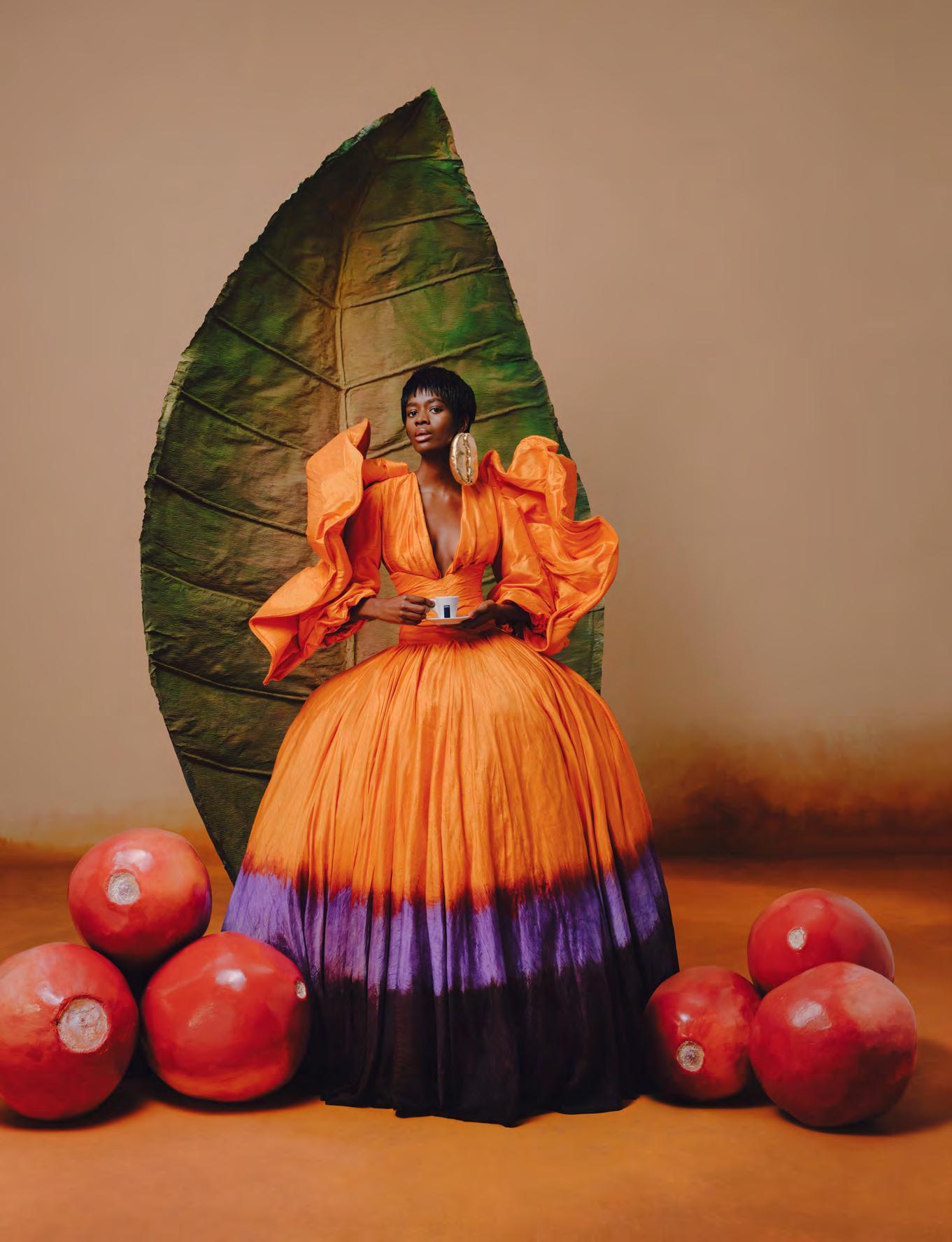
THIS IS YUNG MASTERS OF THE LENS 242-243

“I pay close attention to the mood and atmosphere of each image, using colour to evoke specific emotions and enhance the overall impact. Whether it’s through bold and vibrant hues or subtle tonal shifts, my colour grading plays a crucial role in creating a cohesive visual aesthetic across my portfolio.”

THIS IS YUNG MASTERS OF THE LENS 244-245
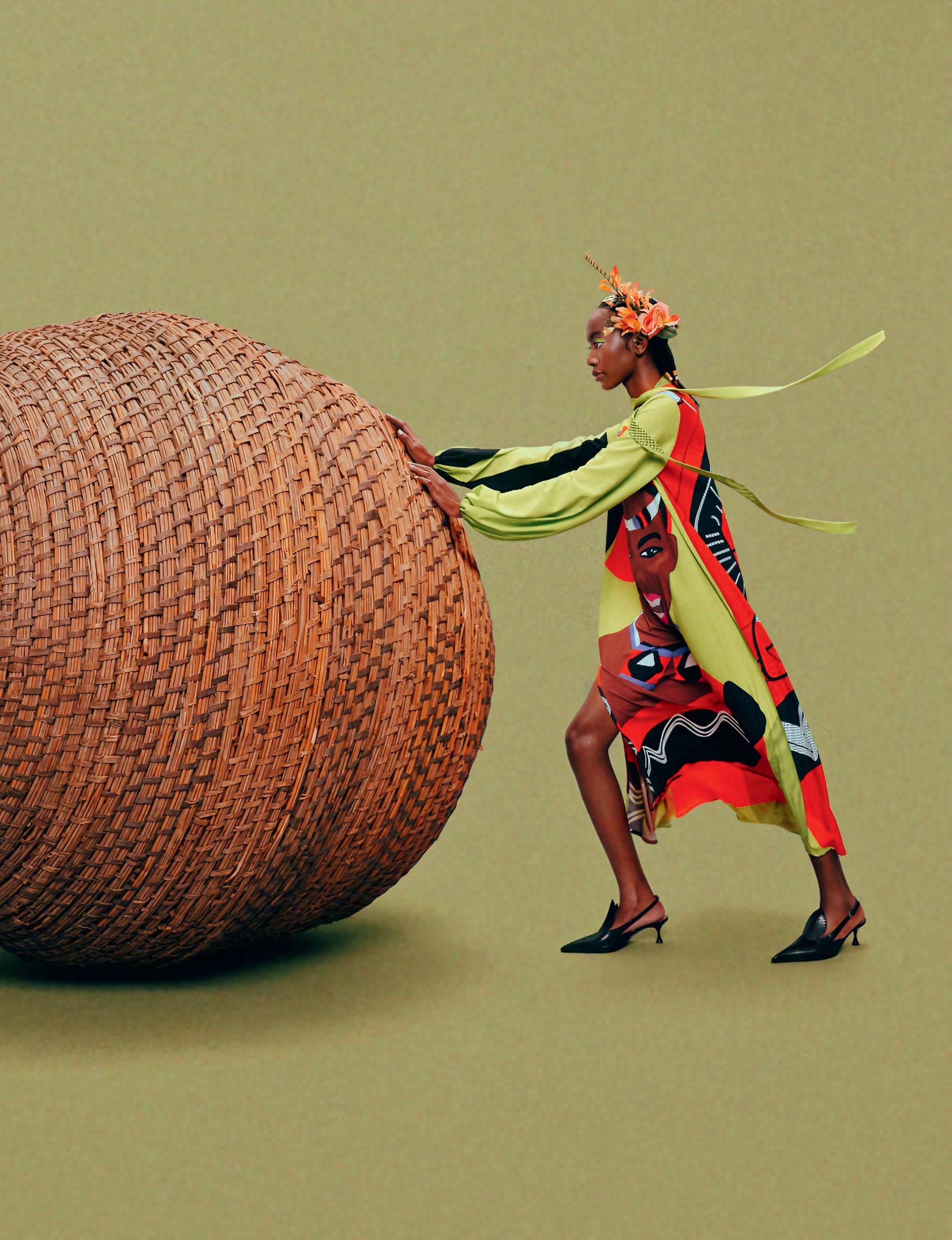
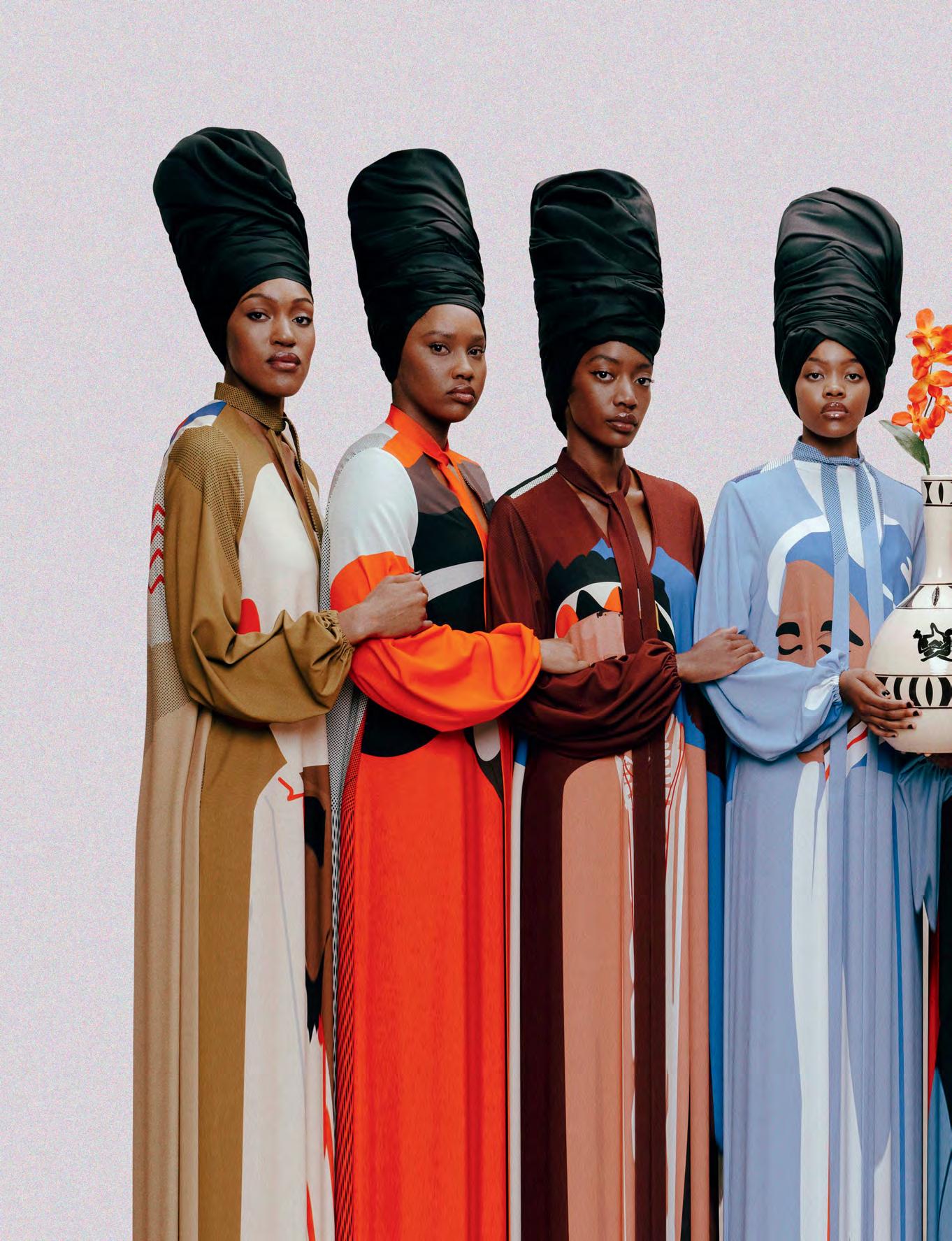
THIS IS YUNG MASTERS OF THE LENS 246-247


Tarek Mawad
THIS IS YUNG MASTERS OF THE LENS 248-249
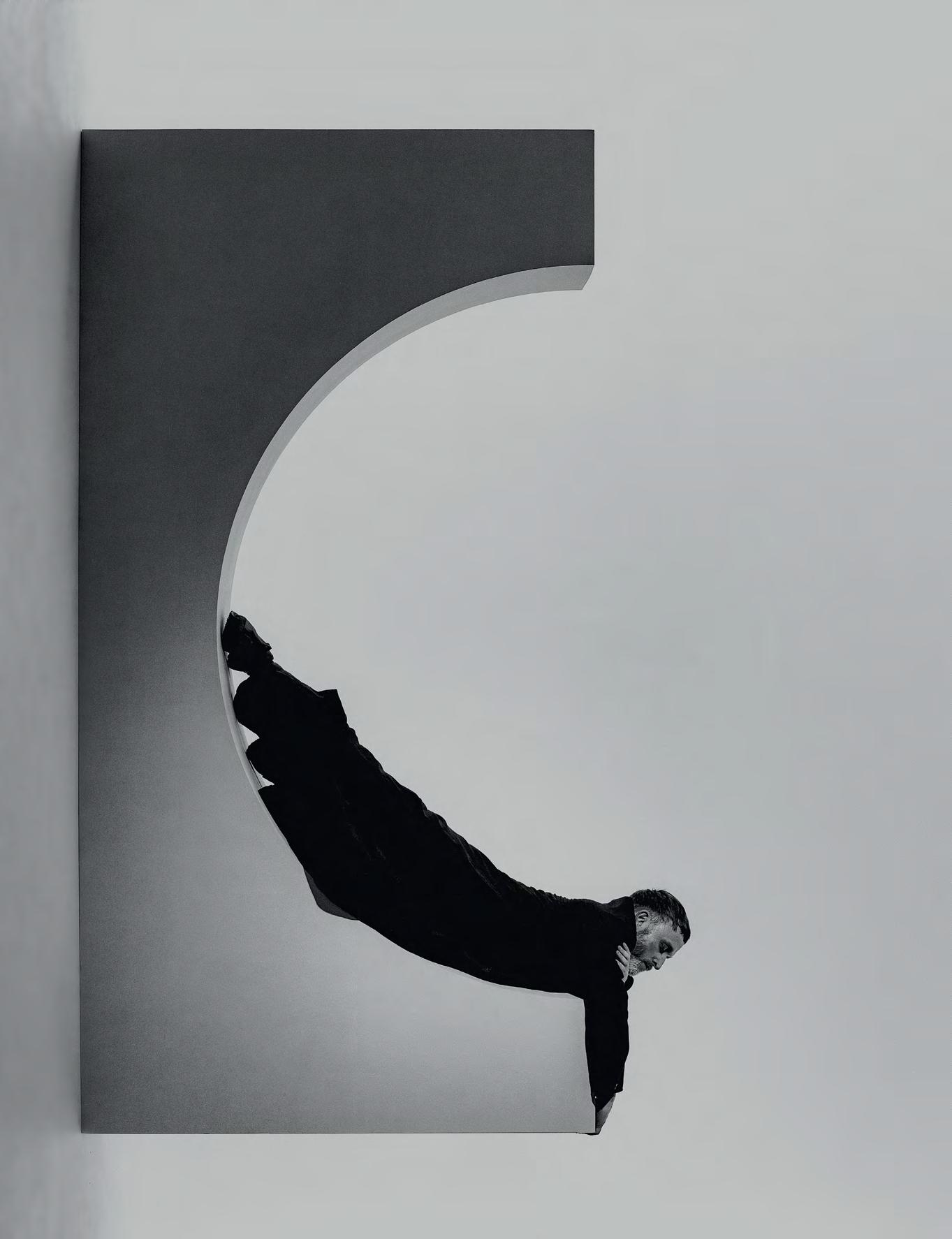
Tarek Mawad, a versatile artist and photographer based in Berlin and Paris, draws inspiration from anatomy, mythology, and art house cinema to create contemporary archetypes of individual uniqueness. Through his lens, he captures subjects as monumental figures, skillfully portraying various shades of their energy and vulnerability. Mawad’s visual language, characterised by dynamic contrasts and vibrant colour palettes reminiscent of Caravagesque claire-obscure pictures, shapes the subjects with a unique blend of light, materials, and styling. With a background in projection mapping, light installation, and the 3D universe, he infuses his photography with a cinematic feel, producing symbolic, intentional, and powerful imagery that encapsulates the remarkable essence of each person.

THIS IS YUNG MASTERS OF THE LENS 250-251
Can you walk us through the genesis of your career in art, creative direction, and photography? What ignited your passion and propelled you into these fields?
I studied media art and design in Saarbrücken, Germany, and worked in various fields including 3D animation, sculpting, VFX, light art, and projection mapping. I loved the total freedom of creation and the idea of bringing to life concepts that existed only in my head. Photography always intrigued me, and I would experiment with it whenever I had spare time.
Can you share with us the inspiration behind your unique artistic style that combines anatomy, mythology, and art house cinema?
A lot of inspiration comes from music, solitude, observation and from my background, which I integrate as a crucial layer into my photography. I’m restless and love to search and discover, finding new ways to express myself and uncovering techniques that haven’t been fully explored. I particularly enjoy the idea of creating a painting through photography. I enjoy both intentional photography and deeply exploring the materials and possibilities of photography, allowing the unknown to take over, leading to uncontrolled situations that weren’t planned, which always occurs during shootings. I’m especially drawn to timeless images and cinema. I aim to create photography that prompts viewers to stop, think, and observe. I want the audience to forget about time and become overwhelmed with questions, searching for answers.
How do you approach portraying your subjects as modern-day archetypes, and what significance do you find in capturing individual uniqueness?
When I photograph someone, I observe that person, which is why I love to meet the talents beforehand if possible. I want to ensure that I capture their persona in a strong, mature way that expresses an emotion that people can rarely see. This might be a second of vulnerability, when they are unaware of being photographed; that’s when they’re fully themselves, without pretence. However, the difficulty lies in transitioning from the unintentional to the intentional. I’m interested in the structure of the face and bones, how the skin moves with gestures.

Your work is described as having a “sculpturesque visual identity with Caravagesque claire-obscure” and vibrant colour palettes. Can you delve into how these artistic choices contribute to your storytelling through photography?
Light plays the most important role here. I appreciate darkness and the significance of light in a scene. When you enter a gallery where sculptures are being exhibited, they are mostly illuminated with several small spotlights to highlight edges and forms. I love the use of hard light for this reason and mixing it with soft light. Hard light emphasises the sculptural, expressive side of the human being, while soft light adds a more nuanced touch.
Why did you decide to shift from projection mapping, light installation and 3D universes to photography?
Simply because I was sitting for hours in front of the computer. I keep those techniques and everything I have learned with me and the past became very important to my photography. But at a certain point I felt the need to work with people. I have a lot of empathy to share and I loved the idea of connecting and transferring emotions to your subject to the point where it becomes a beautiful, invisible collaboration based on trust and intimacy.
In what ways does your background influence your approach to photography, especially in creating a strong cinematographic feel?
Using the facets that come with being multidisciplinary is very important to me. Collecting knowledge in different fields leads to endless possibilities in the ability to blend and combine several techniques together. The visual and technical language opens the door by telling a story that suddenly becomes surrealistic in the way it is executed, raising questions. Besides the story you see in the picture, there’s also a mostly invisible layer that tells a story from a technical perspective, which becomes part of the entire visual narrative. And that story starts in the execution. Opening that door to the viewer gives the audience access to a secret process, and therefore the entire image will become complete the more you think about it. For example, there is a huge difference between “photoshopping” a double exposure and actually creating a double exposure. And the difference lies in the mindset, story, and interaction with the model on set. It’s more than technical; it’s about trust in the person you´re working with, self-trust, value, appreciation, and focus.

THIS IS YUNG MASTERS OF THE LENS 252-253
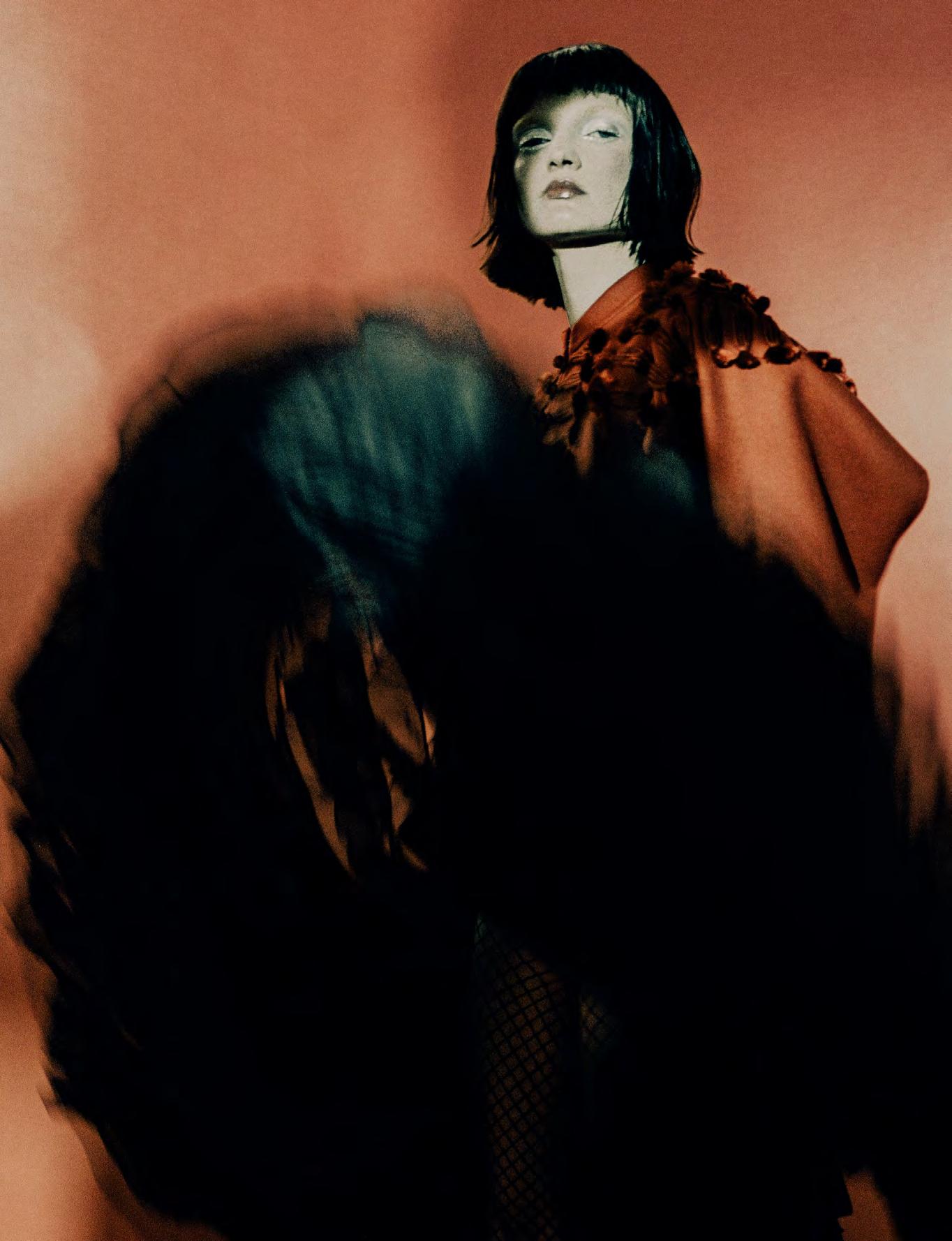
Can you share your creative process when conceptualising and executing a new project? How do you approach translating ideas into powerful visual narratives?
I love solitude; most ideas come from the space of being alone and isolated. Everything that comes up in my mind, I accept, even if I don’t know the meaning behind it. But if I find it interesting, I draw it in my sketchbook. Many inspirations come from dreams, music, or paintings. Then, I create a deck for everyone involved to understand and define the details, from light, set, styling, hair and makeup, expression, et cetera.
How does your Egyptian heritage impact your artistic vision and the themes in your photography? Are there key cultural elements shaping your creative perspective?
I love Egyptian mythology. I appreciate Egyptian sarcasm and enjoy translating it into a visual twist in photography as well. But generally speaking, I believe that heritage is deeply rooted inside me. From my childhood confrontations with my father, cultural clashes, and the unnecessary drama bestowed upon me [Laughs], I had so much drama in my life that I keep it for my art.
As an artist working across Berlin and Paris, how do these diverse cultural landscapes influence your artistic perspective?
I think it’s more about finding where I belong with the work I’m doing. Germany is less artistic in terms of photography and more commercial, while Paris is more artistically open to photography. So I started working more in those countries where I feel I can find viewers.
How do you navigate the intersection of fashion and fine arts in your symbolic, conceptual, intentional, monumental, and cinematic imagery?
It feels quite natural to me. I see fashion as arguably an art form as much as photography, depending on the perspective. The two are organically connected, and this connection becomes very clear when it comes to photography and observing shapes, forms, and materials. Everyone has a certain allure, and it’s often expressed through fashion and attitude, as if you’re creating a character.
How do you establish a connection with your subjects to capture their remarkable power on film?
I observe the unspoken communication, making them comfortable by being at my most natural with them. It’s something I do without thinking about it. There is a beautiful mutual trust that is created by being open.
Can you share your experiences of collaborating with other artists or professionals and how these collaborations have enriched your practice?
My journey as a professional artist photographer started through a creative collaboration with Hannah Goldfisch. We worked on several projects together and my work with her is probably the most known. We have built a strong bond and friendship and it was the first time I ever was in touch with fashion.
Another collaboration was with Patrick Mason. He’s remarkable in front of the camera and behind. Watching him perform and style himself made me fall in love with fashion and learn so much about posing, shapes, volume and styling.
And one of the most important collaborations was with Georgian artist, art director and sculptor Liza Kiladzé. It was an instant and unspoken artistic connection on a very deep and personal level that has led to several personal projects until now, with her in front of the lens but also together with me behind the lens. We are aiming for an exhibition this, or next year.
There’s nothing more beautiful than creating within the moment without having to explain yourself artistically, when you don’t need to explain it to yourself either.
Your work has a strong cinematic feel. Are there specific film genres or directors that influence your photographic storytelling? I admire the work of Stanley Kubrick. He manages to express himself in endless ways, creating different languages, yet you still recognize his natural self.
Lots of artists get too comfortable doing and repeating the same things over and over again. In today’s culture, we feel compelled to find that one thing that your audience associates you with, and it’s tempting to endlessly repeat it. I see it as something too comfortable and restricting. From my perspective I love challenges to maintain a signature across different fields.
How do you handle creative blocks or periods of uncertainty in your practice? Are there specific rituals or approaches you use to reignite your creative spark?
Accepting it. Not forcing it. Waiting until the right idea comes. Having said that, this is for the most personal work. But if you ask me what I do when I have to be creative tomorrow, I want to know everything: Who I’m shooting, how the styling will look, observing the talent’s face and expression, doing my research, and being alone with that information to connect the dots.
What message or emotion do you hope viewers take away from experiencing your art, and what exciting projects or themes can we look forward to from you in the near future?
I don’t have any expectations, but It makes me happy when people associate something personal with my work, beyond what I felt or the reasons I had for creating it. It’s a different version that makes the work valuable for someone I don’t know on a very personal level.
I’m mentally preparing for several important projects this year. Alongside developing new concepts for personal and editorial work, I’m focusing on my double and multiple exposure series. In this series, I explore the depth of shadows and aim for an exhibition at some point. Additionally, I’m working on another series that portrays human bodies and emerging souls using double and multiple exposure techniques, with a particular focus on the human form. The title of this body series is inspired by the spider’s exoskeleton process. ■
THIS IS YUNG MASTERS OF THE LENS 254-255
“I particularly enjoy the idea of creating a painting through photography.”
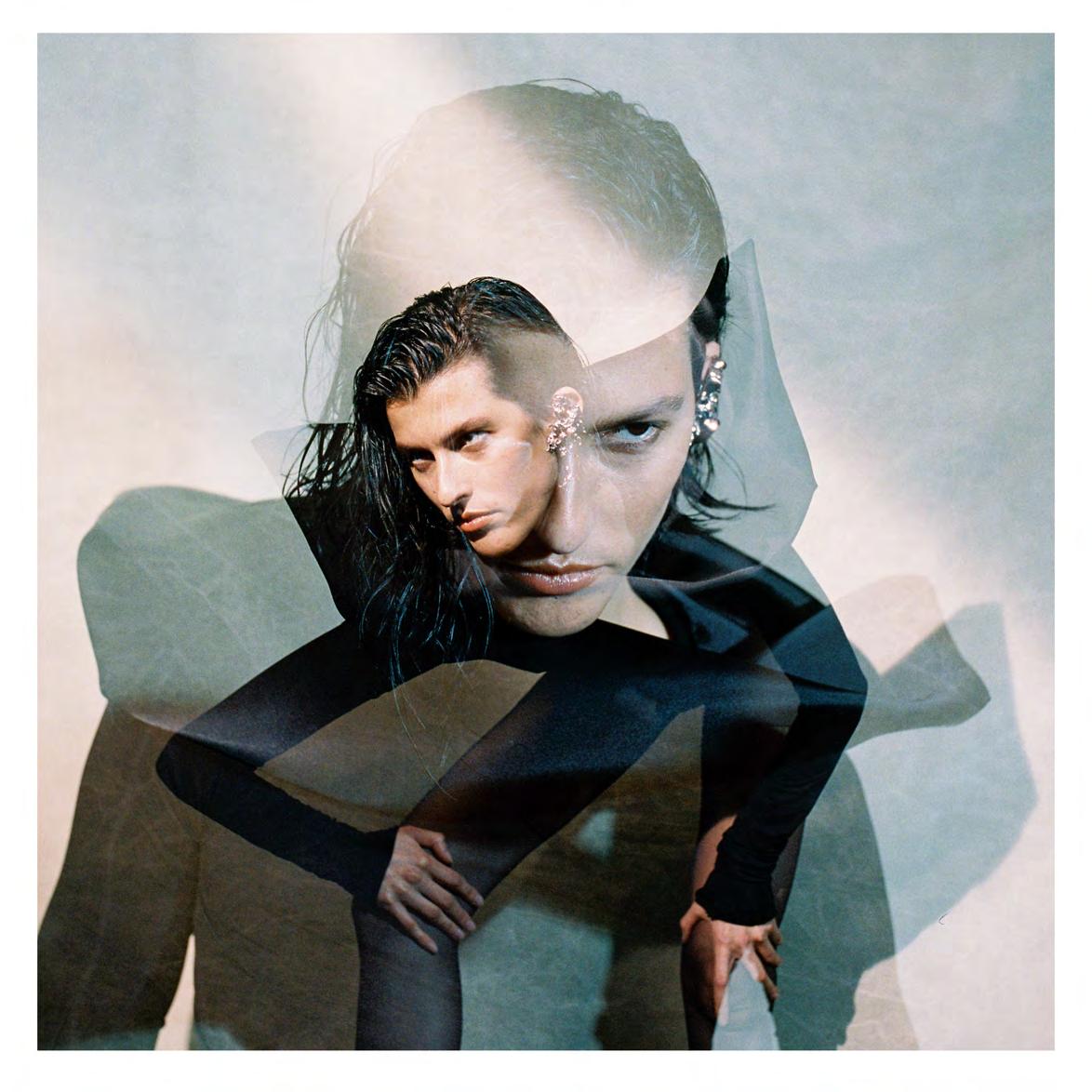
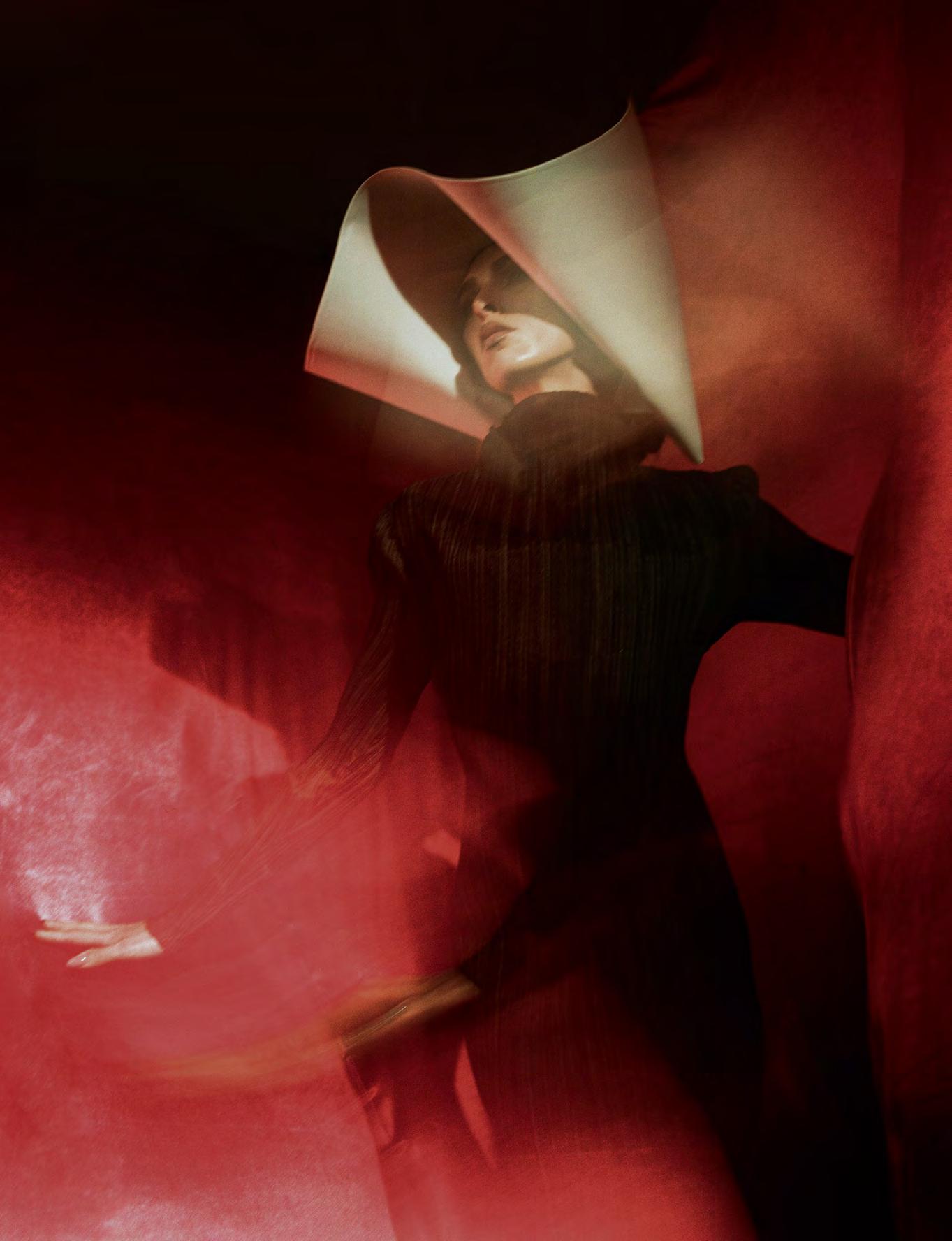
THIS IS YUNG MASTERS OF THE LENS 256-257

AI AND THE CAMERA
Sard Visuals is a creative studio formed in 2023 that pushes the boundaries of photography by leveraging the power of AI.
words LOUIS PARKS
THIS IS YUNG AI AND THE CAMERA 258-259
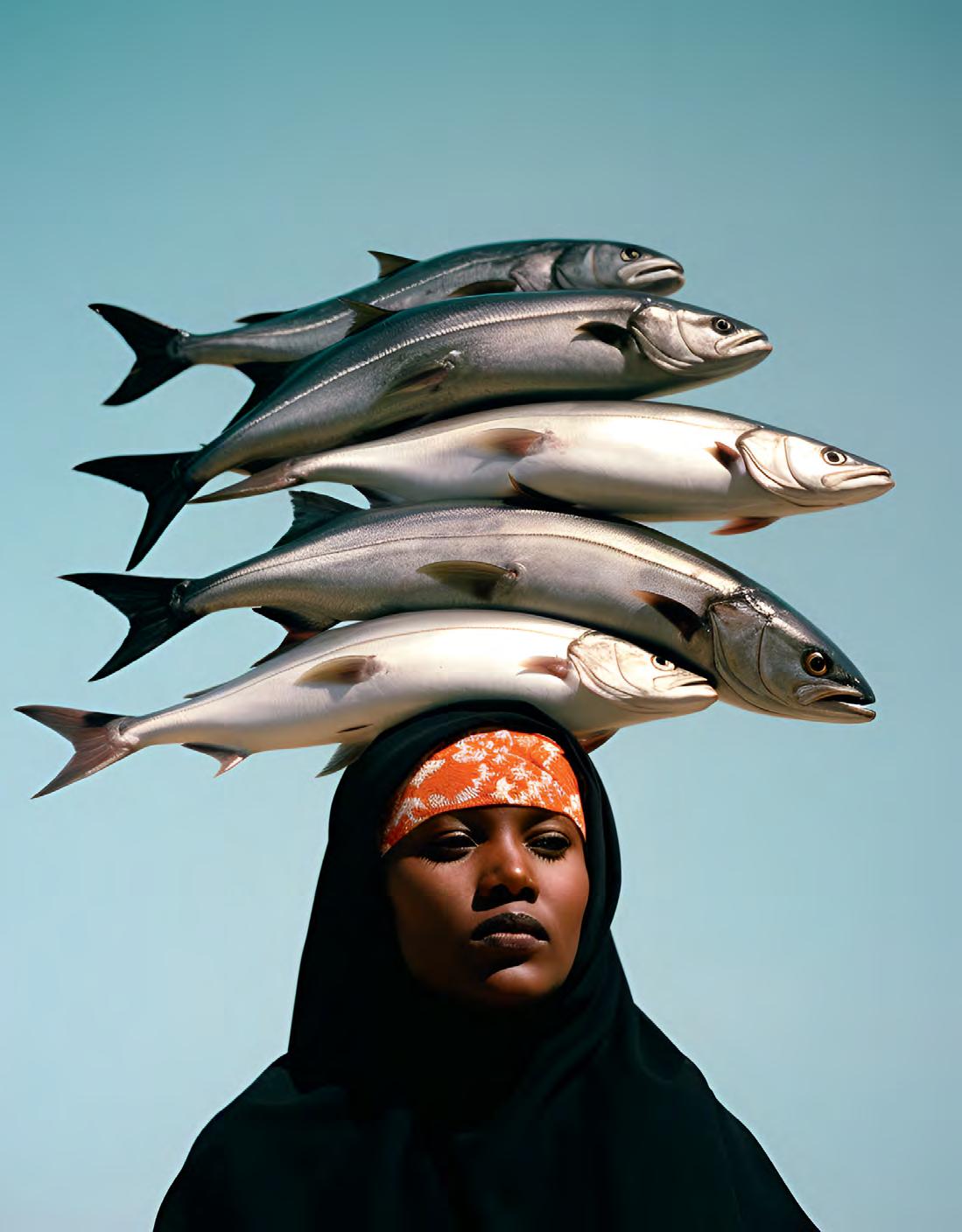
CAMERA

THIS IS YUNG AI AND THE CAMERA 260-261


Are they real? That’s the first question that pops into your mind when you see the work of Mujahid Al Malki, the Omani photographer and image maker behind Sard Visuals. Well, of course they are, they’re real images. However, they’re created using artificial intelligence (AI) and Al Malki’s own imagery, and as a result they blur the lines between photography and a new form of digital art. Whatever they are, they’re thought-provoking, and many of them are very, very fun.
AI and art. The very idea raises uncomfortable questions. If something is made by a machine, then is it “art”? If it uses elements and ideas found on the Internet – and therefore made by somebody, at some point – is it original? Is this a form of artistic or intellectual theft? Who is the creator? Who is the owner of the final piece? The more you think about it, the more questions occur to you. What is certain, however, is that AI art (or AI “art”) is here to stay.
Sard, which roughly translates to “storytelling”, or “narrative”, was founded in 2023 as an initiative to bring together AI and photography to create images of contemporary Arab culture. “My fascination with merging artificial intelligence and visual arts was ignited by witnessing the transformative potential of AI in creative realms. This interest culminated in the establishment of Sard Visuals, where AI serves as a catalyst for pushing the boundaries of traditional artistic expression,” says Al Malki.
It’s this pushing of boundaries that leaves many uncomfortable, but Al Malki believes that humankind is very much at the forefront of the process, “While AI offers immense possibilities, it is human intuition that guides the creative process, ensuring a harmonious fusion of technology and artistic vision,” he says. However, this is but an opinion, the line isn’t clear, that’s for sure. Without delving too deeply into an artist’s process, the combining of original works, cleverly directed prompts and the output of an algorithm is what creates these machine and man-inspired pieces. Quite how that all comes about is down to the artist and where you stand in terms of the man vs. machine debate is entirely up to you.
“Incorporating AI into my creative process posed various challenges, from mastering technical complexities to main-
taining artistic integrity. Additionally, I used a lot of graphic design through multiple [pieces of] software to enhance the image. Through perseverance and experimentation, I overcame these obstacles, continually refining my approach to harness the full potential of AI in my artistry,” says Al Malki. We’re long acquainted with the idea of Photoshop and other similar programs, indeed, their use is so prevalent that “to Photoshop” something has entered our language, we understand it, we’re not entirely comfortable with it, but it’s there.
Al Malki is transparent, if not specific, about his process. He begins by taking photos that “tell a story or evoke certain emotions”. He then uses AI to “transform” the images into something new, “Sometimes I even mix in other photos to create something visually interesting,” he says. But above, the process takes his original photos, his original art, and blends it with AI to create new artworks. AI is therefore, for Al Malki, a tool with which he enhances and changes his own work. Is it then that much of a stretch away from Photoshop? The initial response might be, “Yes, this is entirely different”. But is it? The starting point is Al Malki’s own work, after all. The works themselves, and the original photos they draw from, vary from spontaneous shots to more staged affairs, but there’s a sense of fun in the vast majority of them. While the images are immersed in reality, the stories they tell can be figments of his imagination, drawn from real life, but created as art, a platform through which he tells stories, or evokes emotions. In this final sense, it’s no different from traditional art.
Ethical questions and the search for clarity aside, Al Malki is working with a certain fresh, pop art appeal, crafting images that, to many outside our region, might seem entirely at odds with the long-established, though Western dominated, narrative. Girls ride motorbikes, old men volley footballs, mums and daughters race in trolleys through supermarkets, white beards rock out on electric guitars, a group of women in colourful dress tour the desert in the back of a pickup. It’s all refreshingly normal and it’s all presented in a contemporary, clean style. Al Malki says that his goal is to tell a compelling story with each image and your imagination certainly runs free when you see some of his pictures. Who is the old man with the skateboard, how high is he? Art is often incredibly serious, people speak of emotions an awful lot, well, amusement is an emotion, laughter is a response, and both are valid.

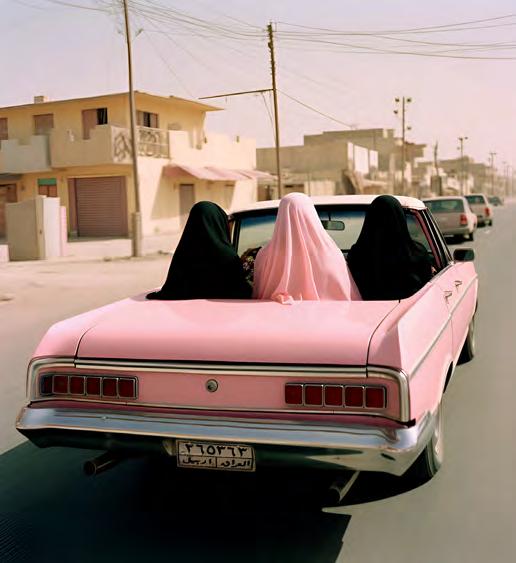
All this is about taking cultural and historical narratives from our region and retelling them in a contemporary manner, “For example, the piece where I paid tribute to the legendary Egyptian artist Um Kulthoom showcases how I incorporate cultural icons and narratives into my contemporary works,” he says. One image shows a woman in a Palestinian keffiyeh with a watermelon her head, a clear, but irreverent indication of national pride, fun, but also serious for those in the know.
Much of his work is set against a familiar backdrop; sweeping dunes, low mountains, single-storey sand-coloured buildings, this is all clearly a take on our region, and Al Malki is doing this on purpose, “Elements from my upbringing, such as vibrant landscapes and rich traditions, manifest in my art, enriching it with unique perspectives and narratives,” he says.
What’s clear is that, according to Al Malki, his works are well received and he’s getting a lot of positive feedback. He puts this down to the idea that his pieces are instantly recognizable, instantly human, despite the fact that they’re created with AI. There’s no dystopian element here, it’s all there in front of you and it’s all clearly labelled. That’s also part of Al Malki’s appeal, he’s open about it, it’s transparent. Wherever he posts his work, it’s all clearly presented as AI-influenced. There’s no subterfuge here, it’s all out in the open.
It’s hard not to come back to AI time and time again and, when asked, Al Malki very much refers to AI as a tool, though a revolutionary one that will change how artists create by “unlocking limitless possibilities for creative expression”. But, human talent remains, for him, very much at the forefront, “While concerns over AI’s impact on art are valid, I believe AI complements human creativity rather than replacing it. Artists should embrace AI as a tool for amplifying their vision and fostering collaboration.” And then, of course, there’s the fact that AI removes a whole lot of logistical, financial and technical obstacles due to the fact that
none of it is “real”. The end result of all this is a certain democratisation of art, an opening up of possibilities and the potential liberation of a new wave of creatives.
One final thought and we’ll leave AI behind. Al Malki, and many others, believe that the truly limiting element of AI, in its present state, is that it’s incapable of creating something truly new. Everything AI draws from, the argument goes, has already been created. Everything it does, it has been taught, or trained to do. Therefore, everything AI produces is derivative of something. True creativity, holders of this view would have you believe, lies only in the hands of the human. While it sounds entirely plausible for now, whether this remains the case will have to be seen.
Al Malki’s inspirations for his creations are certainly all too human, “My artistic influences range from Arab photographers to contemporary digital art pioneers. I am inspired by artists who challenge conventions and evoke emotions through their work,” he says. Al Malki’s own contributions to the artist environment might well be extremely modern, but they’re rooted in a regional experience, his culture and his own past.
One piece that encapsulates what Al Malki is trying to do is “Gelato”, where a group of colourfully-dressed women are gleefully clutching equally multicoloured gelatos. It’s fun, there’s a clear sense of joy, of friendship, of freedom. It’s a simple image, but it evokes so many emotions and questions, all of which are light-hearted. It’s local, and it’s clearly contemporary.
And there it is. Al Malki describes his work as “Life in Colours” and these vibrant, diverse stories are certainly that - life, in colour. Full of joy, full of freedom and vitality, they’re a testament to friendship, to a light-hearted moment. But, they’re also ours, they come from our region, they feature our people. It’s rich, it’s beautiful, it’s fun. ■
THIS IS YUNG AI AND THE CAMERA 262-263
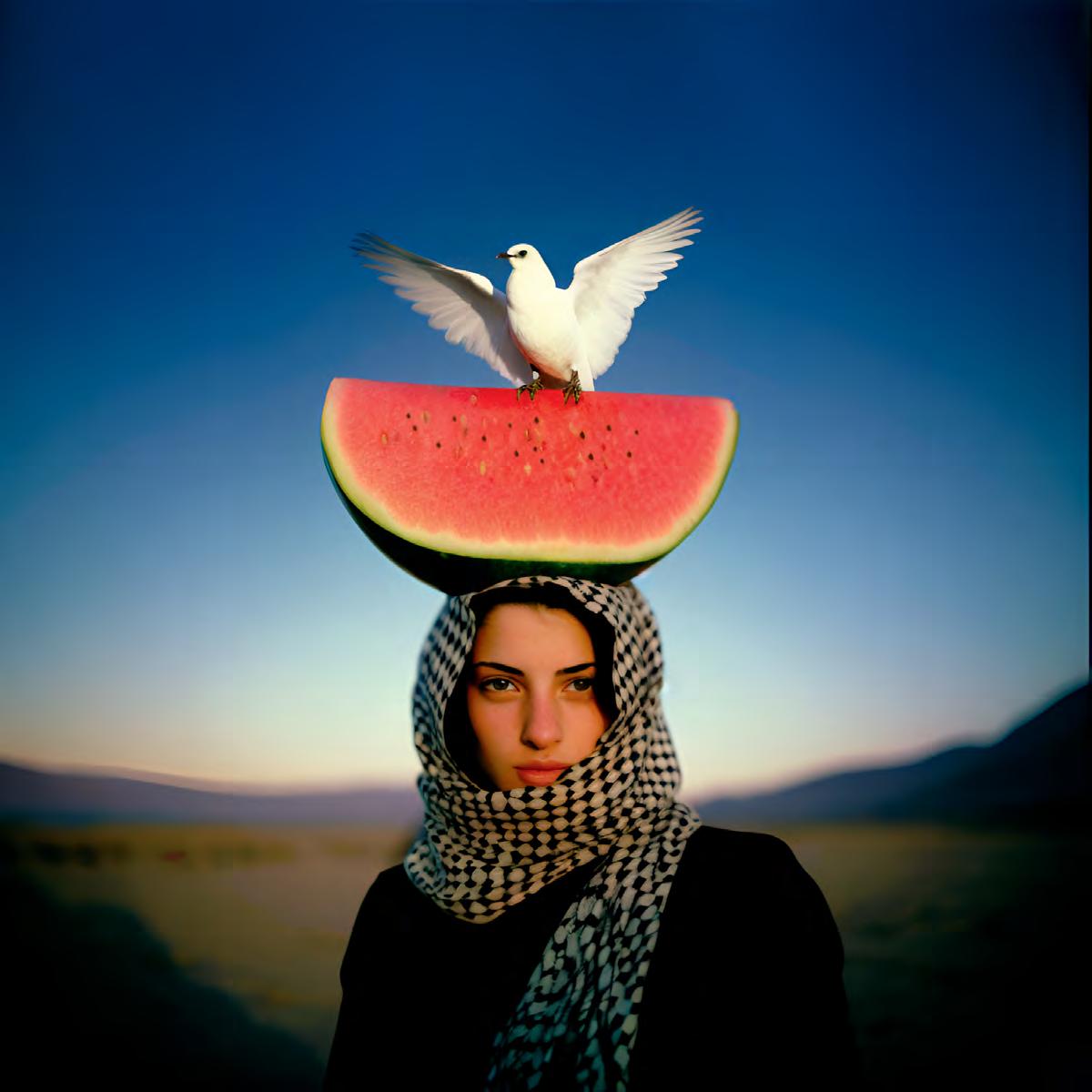
“Elements from my upbringing, such as vibrant landscapes and rich traditions, manifest in my art, enriching it with unique perspectives and narratives.”
IDRIES KARNACHI
words OMAIA JALLAD
THIS IS YUNG BUILDING DREAMS: IDRIES KARNACHI 264-265
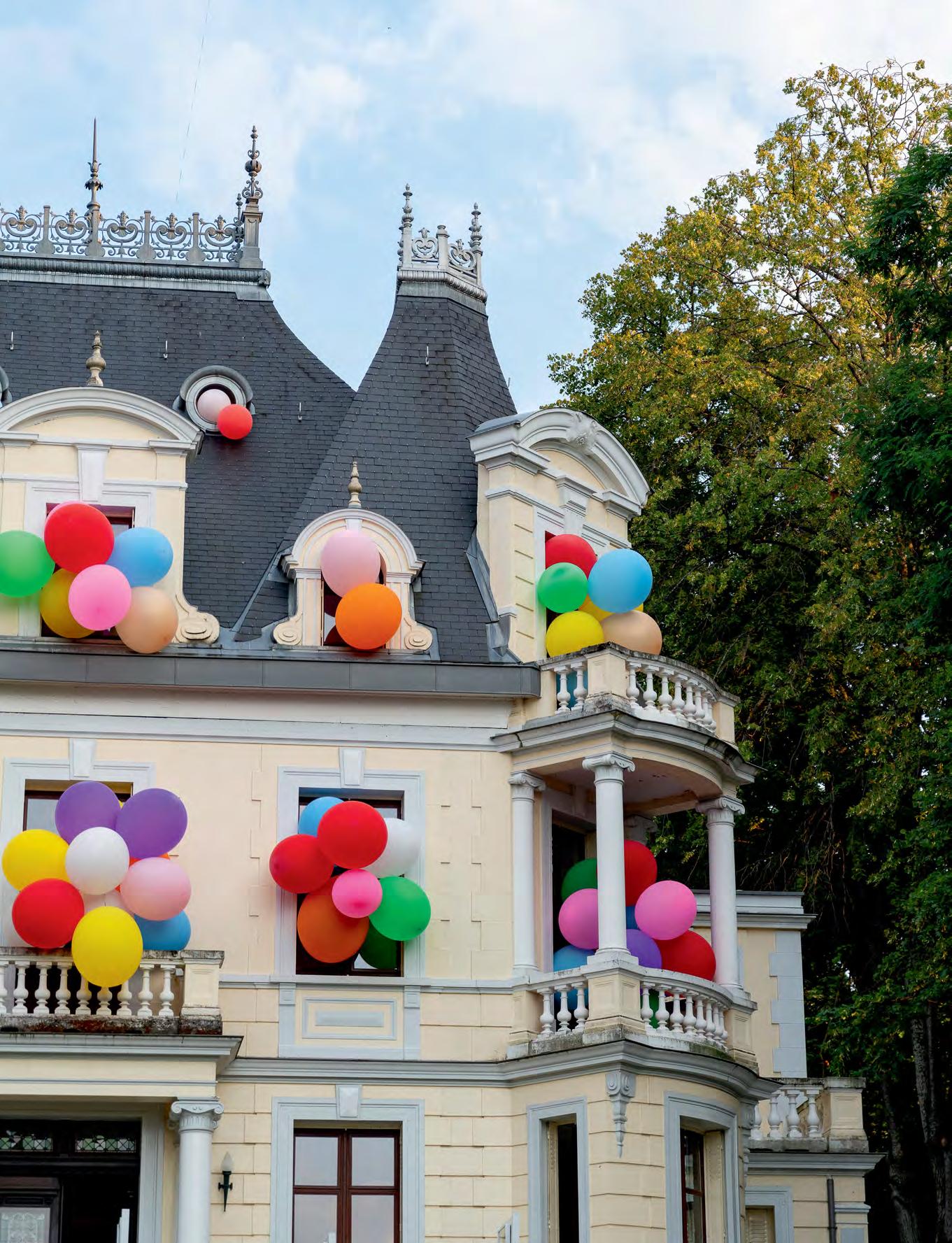 photography by HIND LAHRICHI
photography by HIND LAHRICHI

THIS IS YUNG 266-267 BUILDING DREAMS: IDRIES KARNACHI

As we traverse the journey of life, we naturally find ourselves drawn to narratives—immersing ourselves in stories, visualizing scenes, absorbing lessons, and often, sharing laughter through them. Words, like whispers in the wind, carry diverse meanings shaped by individual interpretations. The addition of visual elements introduces an enchanting layer to this experience; bathed in imagery, one is captivated by the narrative, yet the true allure lies in the subjective interpretations.
This is where the artistry of Idries Karnachi comes to life. Karnachi defies conventions, skillfully weaving narratives in diverse ways that beckon the audience to interpret his work freely. Playing with the interplay of words and images, he artfully prompts his audience to think, wonder, and find joy in lighthearted laughter. Wearing various creative hats, he acts as a catalyst for visual storytelling, encouraging us to peer beyond the ordinary — a view Through the Looking Glass.
Idries Karnachi has led a life as diverse as the 11 cities, four countries, and three continents he has called home. Embracing the richness of his cultural education, he has nurtured a broad perspective, fostering creativity along the way. From his roots in Morocco, Karnachi ventured abroad to study architecture in France and urban planning in Shanghai. Now accomplished in both of these fields, he made a mark at prestigious studios like David Chipperfield and Studio KO. Choosing to forge his own path, Karnachi co-founded Studio NossNoss, operating between Paris, Marrakech, and Geneva, seamlessly blending the worlds of art and architecture. His collage art, found where pop art, Surrealism, and Dadaïsme converge, serves as a canvas for his vision—a world where cultural diversity reigns, the boundaries of reality dissolve, and multiple truths coexist. Karnachi explores states of consciousness, breaking down the barriers of the mind with a purposeful, boundary-defying approach to his craft.
What is your earliest memory or experience of something that ignited your interest in the arts, be it architecture, collage art, or any other form of creative expression?
As a child growing up in Morocco, my earliest memory of being drawn to the arts was when I realized that my vivid imagination could be expressed and heard. Each experience, from wandering through bustling markets to exploring the labyrinthine medinas, fueled my passion for artistic expression. Moreover, my extensive travels across different cities and continents broadened my perspectives and nurtured a deeper appreciation for diverse forms of artistic expression. Later, studying architecture provided a structured outlet for channeling my creativity and honing my skills, blending cultural immersion with profound learning experiences.
Take us through your creative process. How do you translate a concept into a tangible design?
My creative process is deeply rooted in observation, exploration, and experimentation. It draws from everything I see or hear around me, fostering connections by combining ideas or thoughts that may seem unrelated. This process often leads to unexpected intersections and novel perspectives, enriching the creative journey. I believe that it stems from a finely tuned sense of observation, which was cultivated in architectural school.

THIS IS YUNG BUILDING DREAMS: IDRIES KARNACHI 268-269

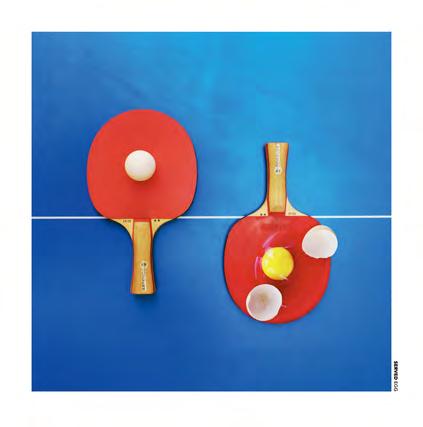



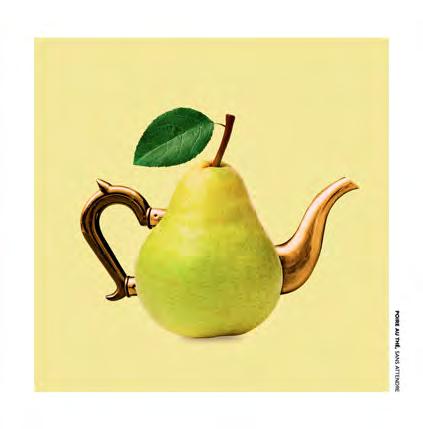


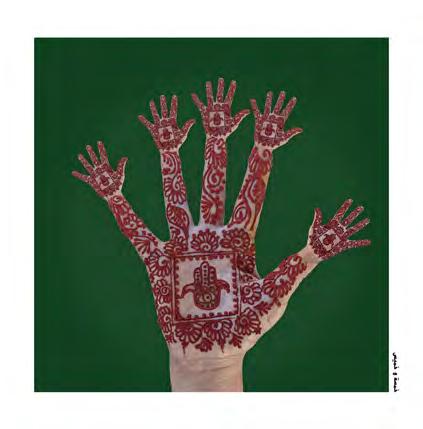
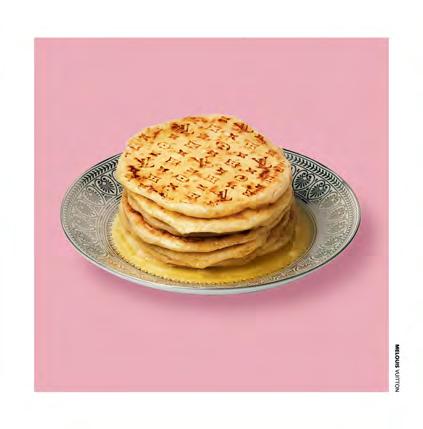
THIS IS YUNG BUILDING DREAMS: IDRIES KARNACHI 270-271
“My approach is informed by the recognition that multiple truths can coexist within a shared space, much like the visual illusion of the numbers “9” and “6”, one sees a “9”, the other sees a “6”. Each insists the other is wrong, yet both are right.”
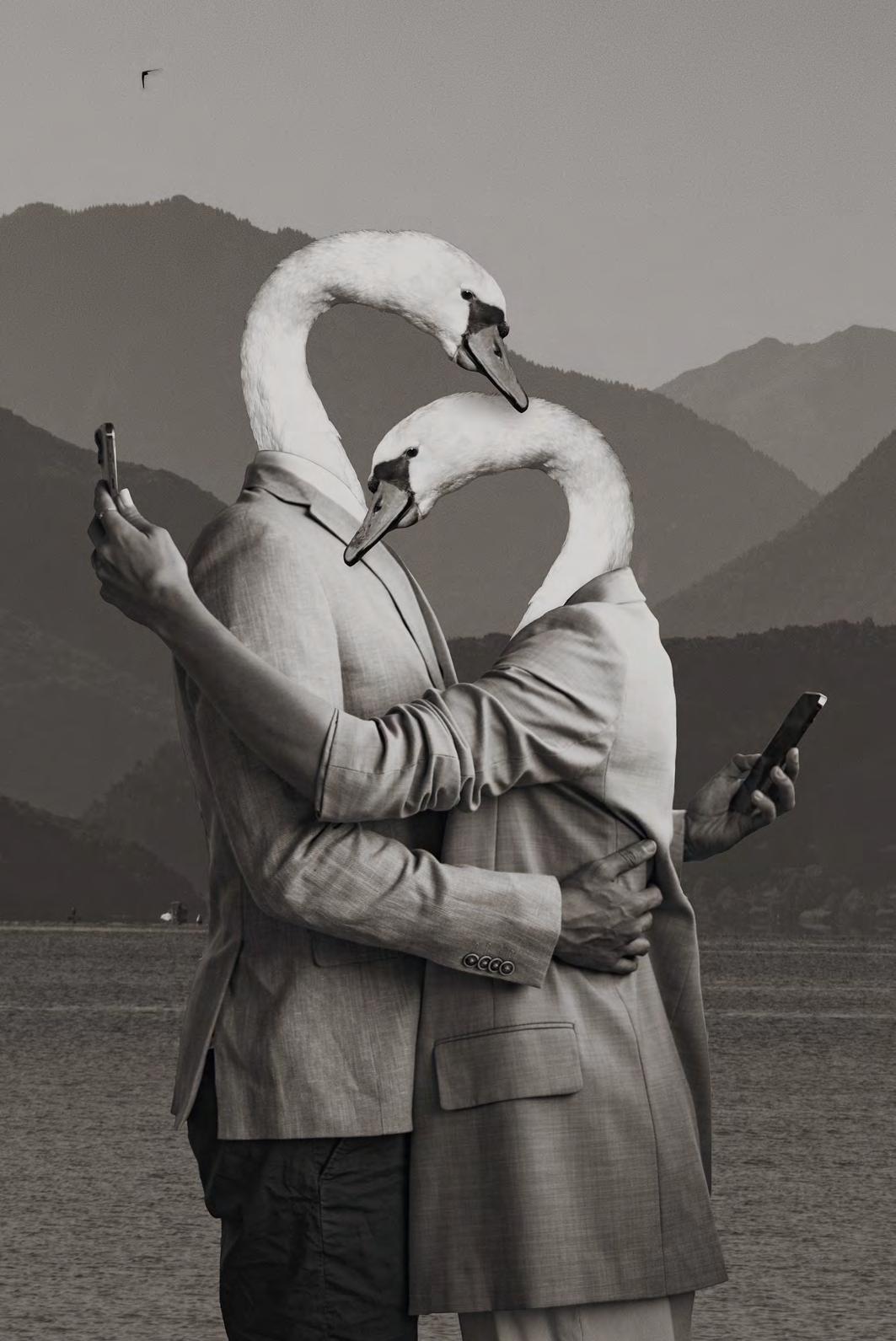
THIS IS YUNG BUILDING DREAMS: IDRIES KARNACHI 272-273
In your collage art, you aim to abolish the boundaries of reality and explore new perspectives. How do you believe art can contribute to challenging societal norms and encouraging a broader, more inclusive perspective?
My work resides between pop art and surrealism, with a hint of Dadaism. It’s an art form that aspires to be accessible to everyone, advocating for the existence of multiple truths and occasionally calling for a reassessment of arbitrarily established facts. This blend of styles and philosophies allows me to create pieces that speak to a wide audience, inviting viewers to reconsider conventional narratives and embrace alternative perspectives. Each piece is imbued with a sense of playfulness and subversion, encouraging audiences to engage in dialogue and reflection on the complexities of contemporary society.
In your architectural designs, what do you consider as the key element that sets your work apart and serves as a distinctive selling point?
I advocate for an architecture that is both simple and highly contextualized. By simplicity, I mean a departure from the relentless pursuit of compactness that many contemporary firms prioritize for reasons of profitability. Instead, spaces in my designs tend to have a sense of sobriety and an almost timeless character. Hyper-contextualization is another hallmark, as it reflects a commitment to responsible and adaptive architecture tailored to socio-cultural and meteorological climates. This approach ensures that each design resonates with its surroundings, contributing positively to its environment while meeting the needs of its inhabitants.
Your installations feel like real-life collages, blending artistic vision with architecture. What challenges arise in harmonizing these two seemingly distinct realms?
Architecture, as a discipline, uniquely allows one to dream while staying grounded. Similarly, in art, I allow myself to dream up my wildest ideas, and my technical knowledge and learned skills empower me to bring these dreams to life. This symbiotic relationship between dreaming and technical execution is central to both my architectural and artistic endeavors, enabling me to push the boundaries of creativity while ensuring the feasibility and functionality of my designs.
As an architect and urban planner, how do you navigate the challenges of working in different locations, specifically between Paris, Marrakech, and Geneva?
Having moved approximately every four years during my childhood, I find a sense of comfort in constant movement. I thrive on diversity and draw nourishment from the varied experiences that each location offers. This nomadic lifestyle has equipped me with adaptability and a deep appreciation for cultural diversity, which are invaluable assets when working across different locations. It allows me to seamlessly integrate into new environments, leveraging the richness of each setting to inform and enrich my creative process.
Your collage art often features wordplay with a mix of Arabic and French. How does this linguistic interplay contribute to the narrative of your artworks, and what role does language play in conveying your artistic messages?
The linguistic interplay in my collage art reflects the multicultural nature of my identity and serves as a means of bridging different worlds and perspectives. By blending Arabic, French and English, I aim to create layers of meaning and invite viewers to engage with my artworks on multiple levels. I like to define my art as “When the art of combining words to evoke images meets the art of combining images to evoke words”.

Can you recall the first project or design that you worked on that made you realize the impact and potential of your creative abilities?
I would say that I realized my creative potential by understanding the power that my creative work could have on society. A particular collage titled “Cover Your Eyes, Not Her Body” holds significant meaning, shedding light on the pervasive issue of public sexual harassment in Morocco. This artwork symbolizes a call to action, emphasizing the urgent need to eradicate this social disease from our society. It serves as a tribute to the resilience and courage of every Moroccan woman who navigates the streets, facing this harassment with unwavering bravery.
After living abroad for a considerable time, what aspects of Morocco drew you in when you were away, and what did you discover upon returning with a fresh perspective?
While living abroad, I was continually drawn to Morocco by realizing its vast creative potential, a relatively untapped space where anything is still possible, unlike a more saturated environment in Europe. In Morocco, artisans and their craftsmanship are more accessible, and not everything is predetermined. There’s a sense of freedom to explore, try, fail, and try again without dire consequences. It’s an environment where experimentation is encouraged, and the creative process feels more open-ended and forgiving. This aspect of Morocco’s creative landscape deeply resonated with me and inspired me to explore its rich artistic heritage and untapped possibilities.

THIS IS YUNG 274-275 BUILDING DREAMS: IDRIES KARNACHI
Your studio’s name, Studio Noss-Noss, is intriguing. Can you share the story or inspiration behind the name and how it reflects the essence of your practice?
The studio was founded in Switzerland and draws its name from the iconic Swiss dish, fondue moitié-moitié (half-half), which consists of half Vacherin Fribourgeois and half Gruyère cheese, as well as the Moroccan coffee with milk, known as nossnoss, meaning half-half. This name reflects the essence of our practice: a blend of influences from different cultures and disciplines. It symbolizes the fusion of two worlds, with one foot in Switzerland and the other in Morocco, one part architect and one part artist. Studio Noss-Noss embodies the spirit of diversity, collaboration, and the harmonious integration of varied influences into our work.
Your vision emphasizes a “cultural melting pot where multiple truths can coexist”. How does this philosophy translate into the design and planning decisions you make for urban spaces?
My philosophy in urban design revolves around the concept of inclusivity and the celebration of diversity. I believe that urban spaces should be dynamic environments that reflect the richness of human experience and accommodate the needs of diverse communities. My approach is informed by the recognition that multiple truths can coexist within a shared space, much like the visual illusion of the numbers “9” and “6”, one sees a “9”, the other sees a “6”. Each insists the other is wrong, yet both are right. Drawing inspiration from my experiences in Morocco, France, China and Switzerland, where I witnessed the power of perspective and the importance of embracing cultural diversity, I strive to imbue my urban designs with a sense of harmony and interconnectedness.
You recently showcased your work at Art Basel Miami, a remarkable achievement. Can you share the thoughts and emotions that crossed your mind as you witnessed your creations displayed in front of a global audience?
Participating in Art Basel Miami was an extraordinary experience that exceeded all expectations. It was incredibly gratifying to witness people from diverse cultural backgrounds connect with my work and engage in meaningful conversations about art and creativity. Art Basel Miami opened doors to new opportunities and collaborations, allowing me to showcase my vision on an international stage. The energy and enthusiasm of the audience reaffirmed my belief in the transformative power of art and its ability to transcend boundaries. I left the event feeling deeply inspired and grateful for the opportunity to share my artistic journey with the world.
If you could bring one of your collages to life, creating a fantasy world, which specific artwork would you choose and why?
Recently, I’ve embarked on the exciting journey of bringing my collages to life. This endeavor includes installations such as pictures loading as if waiting for a connection, filling an old castle in Evian, France with giant balloons, and creating the CAR-PET, a fully functional vintage 1974 Mercedes-Benz 240 D covered entirely in carpets in collaboration with Beni Rugs. Currently, I’m working on a Moroccan moped capable of accommodating 15 passengers, further pushing the boundaries of imaginative expression and merging art with reality.
Looking back, if you could give advice to your younger self when starting out in the field, what would it be?
If I could give advice to my younger self, it would be to embrace failure as a necessary step on the path to success, to trust my instincts, and to never lose sight of the passion that drives me to create.
To the aspiring young creatives, especially those in Morocco, I’d like to share that there’s no magic formula or instant solution in life. Beyond innate talent, which is undoubtedly valuable, talent can also be cultivated into skills. These skills can be honed further through hard work and perseverance.
I advise embracing a proactive mindset rather than waiting passively. Rather than trying to avoid boredom, see it as a catalyst for creation. It’s crucial to embrace moments of boredom; they often lead us to new discoveries and inspire innovation. We create, reflect, and rebel because of boredom, driving us toward new horizons and experiences. Moreover, it’s essential to seize opportunities actively. Luck doesn’t simply fall into our laps; we must actively pursue it. Once again, I emphasize the shift from a passive to a proactive stance. ■
“I like to define my art as “When the art of combining words to evoke images meets the art of combining images to evoke words”.”
MU THIS IS YUNG MUSIC 276-277
SIC
As Zaza’s star continues to rise, he continues to push the boundaries of music both within Egypt and far beyond its borders.
ZA ZA’S NEW WAVE
THIS IS YUNG ZAZA’S NEW WAVE 278-279
photography OMAR SHA3 production BEATROOT RECORDS words MENNA SHANAB
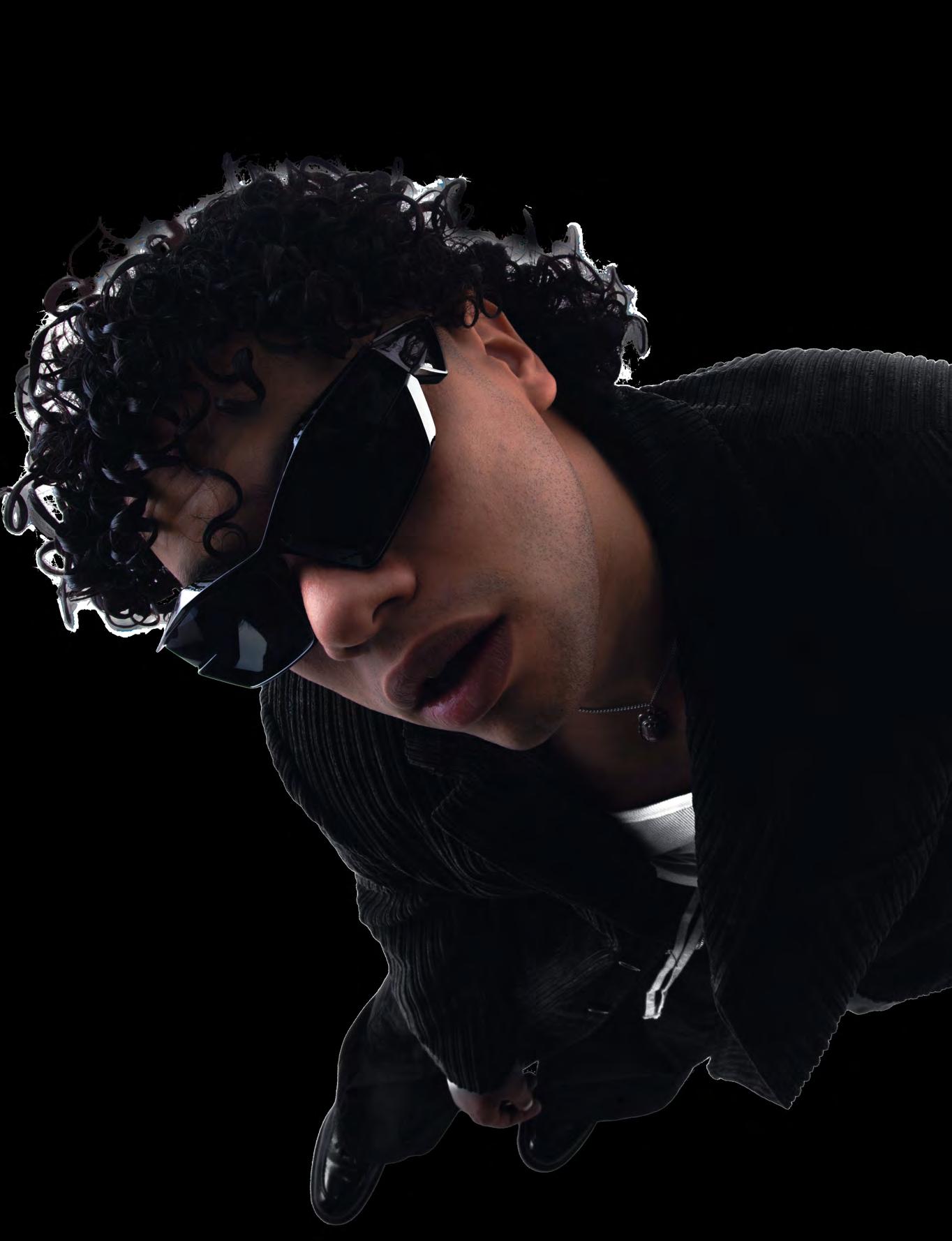

THIS IS YUNG ZAZA’S NEW WAVE 280-281
“I stay committed to my values and principles... I stay real with myself, and I always keep some things and some parts of life hidden, just for me.”
His presence is undeniable, a blend of charisma and quiet intensity that commands attention. With a voice that oscillates between a drawling delivery and an underlying growl, Egyptian rapper Ziad Zaza cuts through heavy drill beats with a sound seemingly at odds with the vibrant melodies and unexpected samples that pepper his music. It’s a defiant cocktail, expertly blending drill, oriental trap, and the kinetic energy of Brazilian funk. This, together with his unpretentious demeanor and genuine connection with his audience, solidifies Ziad Zaza as one of the defining voices of the next generation – sonically global, yet fiercely rooted in the local.
Zaza’s signature sound – an impassioned, off-kilter drawl layered atop potent drill beats – is instantly recognizable. It’s a style he can wield with impressive control for both ferocious social commentary and tender introspection.
From the streets of Sheikh Hassan in Fayoum, Zaza carries the legacy of his underground rap roots. Growing up, Zaza found himself drawn to the pulse of the rap scene. It was here, as a twelve-yearold fueled by MTV dreams, that he began writing. Today, that dedication has propelled him into the spotlight. When asked about the key to stardom, he’s remarkably grounded: “I don’t know exactly, but not to lose grip of your truth.”
His rise mirrors the changing tides of Egyptian music. In the bustling chaos of Cairo, he holds himself with the air of a protector, his connection to his people woven into the fabric of his artistry. Cairo provides a backdrop of constant creative tension. In this sprawling metropolis, he balances a quiet leadership among his peers with the raw energy of the streets that raised him. This duality is palpable in his music. There’s often a protective swagger that belies the persona he projects in videos yet his genuine warmth and humility are ever-present in his real life interactions. It’s this contradiction that adds another layer of depth and fascination.
Beneath the surface of his music lies a deeper meaning. Driven by a constant urge to break new ground, Zaza defines himself by pushing boundaries. “It’s not about exploring, as I know what’s new internationally... it’s about helping my audience explore new music and sonic territories through me and my music,” he explains.
Drill music, itself a controversial and exciting subgenre, can often fall into derivative patterns, with artists sticking to a formula of wellworn sounds. But there are always innovators who challenge these expectations and break the mould. Ziad Zaza is one of these people. His 2022 album “El Rays” features tracks like “Dayra” that subvert expectations through experimental sampling and unexpected sonic textures. This isn’t simply drill music with an Egyptian twist – it’s a reimagining of the genre itself.
This spirit of innovation shines through Zaza’s entire discography. MTV-inspired stardom might have been the initial dream, but Zaza’s artistry is grounded in a symbiosis of influences. “ZAZA ELWASEEM” (meaning “Zaza the Handsome”) is an ode to this intersectionality. With 13 tracks, the album stitches together a world of emotions, exploring personal trials, new experiences, anger, love, and warmth all wrapped in his distinctive musicality, shape-shifting to float and wrestle with a jungle of genres.
“I’m the kind of artist that does what he feels, not what’s trending... People connect with what’s real,” he says, reflecting on the positive response to his emotionally charged Valentine’s Day double single release, ‘Nsena’ and ‘Bent El Eh’, a bittersweet journey through past loves. He reflects on lost promises and lingering memories. ‘Nsena’ takes on a wistful reggaeton vibe with its simple production and haunting strings. Zaza’s vocals shift too, becoming soft and intimate, with a breathy, hushed style, mirroring the song’s gentle guitar. ‘Bent El Eh’ stands out with its clever twist on a classic. A sample from Farid Al-Atrash’s iconic ‘Alby We Moftaho’ forms the song’s heart, intertwined with laid-back beats makes the perfect backdrop for Zaza’s heartfelt lyrics.
Zaza wears his vulnerability openly. Tracks like the tender “Wrangler Beda” offer glimpses into a broken heart, revealing an emotional rawness that resonates deeply with listeners. This authenticity is perhaps why he pairs each EP track with customized tarot card art – depth is Zaza’s currency.
Egyptian rap, fueled by a new generation of talented artists like Zaza, is experiencing a surge in popularity. Zaza himself is at the forefront of this movement, reaching new audiences across the MENA region. Despite his newfound fame, he remains grounded. Offstage, he’s known for his friendly demeanor and his fierce loyalty to his loved ones. It may be this rootedness that
“60 Geneh” continues to make waves, participating in the Fribourg International Film Festival in March 2024 and hopefully many more festivals worldwide.
Zaza’s impact goes beyond sound – it’s about challenging norms in the name of what he believes. He turned down a major soft drink deal as an act of principled boycott. His refusal of a lucrative brand deal in solidarity with Palestine speaks
“I’m the kind of artist that does what he feels, not what’s trending... People connect with what’s real”
fosters his humility, “I don’t know how I got here,” he reflects, “it is Allah’s blessing.”
Zaza’s creative realm extends far beyond music. His compelling stage presence and aura of quiet leadership translate seamlessly to the silver screen, making him a sought-after collaborator – as seen in his work on Amr Salama’s groundbreaking short film “60 Egyptian Pounds”. Loosely inspired by Zaza’s song of the same name, the film tackles domestic abuse with raw performances and striking visuals. His starring role in “60 Geneh” marked a new chapter in his artistic journey, with the film making history as the opening feature at the prestigious El Gouna Film Festival. “Acting is part of who I am; it’s been my dream since childhood,” he reveals. Yet, he approaches his roles with focus: “I separate my musical identity from my acting. It’s about bringing the character to life, not about me.”
volumes, a powerful act of resistance in a world where conformity often reigns supreme. “If the artist doesn’t advocate for causes that matter, then what are they doing? Art is in everything,” he states firmly.
When asked about leading the ‘New Wave’ of Egyptian music, Zaza remains characteristically grounded, “I focus on doing what I love... I care more about being timeless than being anything else.” His influence is undeniable, as he amplifies the voices of a generation hungry for honest music. The “New Wave,” he says, “is the continuation of the old generation.” It’s about staying true to one’s roots while pushing and creating music that actually pushes the envelope.
Ziad Zaza stands out as a multi-faceted artist who, above all, never loses his truth, “I stay committed to my values and principles... I stay real with myself, and I always keep some things and some parts of life hidden, just for me.” It is this authenticity, his ability to weave global soundscapes with his intensely local perspective, and his steadfast commitment to using his voice for what matters, that truly makes him an artist to watch – and to listen to. ■
THIS IS YUNG ZAZA’S NEW WAVE 282-283

“Iseparatemy
“I focus on doing what I love... I care more about being timeless than being anything else.”
mus i c identity from my acti n g . It’s about bringing the character t o ton,efil a tuob .em ”
YUNG
THIS IS YUNG YUNG ESCAPES 284-285
words LOUIS PARKS
ESCAPES
THE PENINSULA LONDON: WHERE ELEGANCE MEETS TRADITION
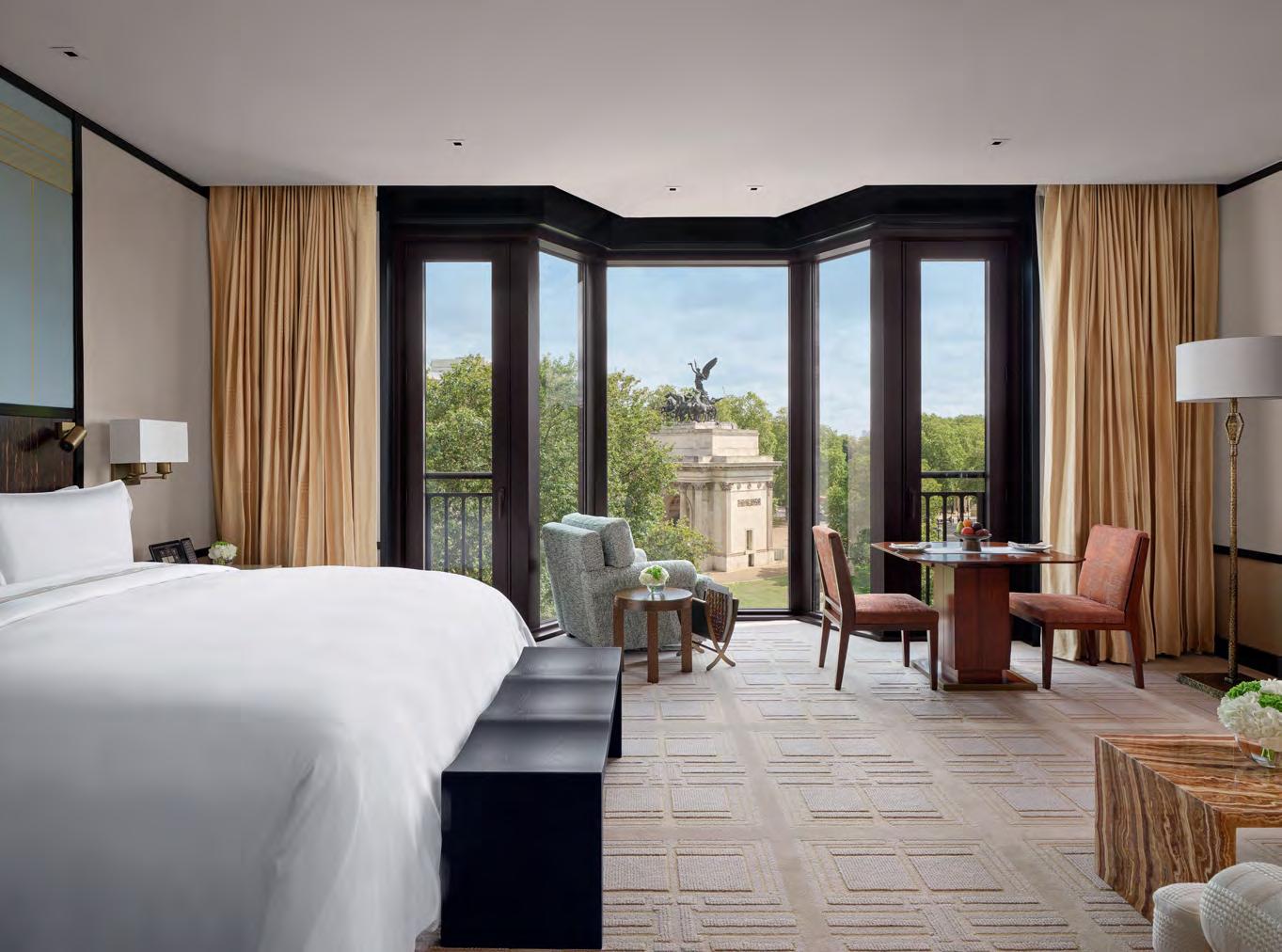
THIS IS YUNG YUNG ESCAPES 286-287


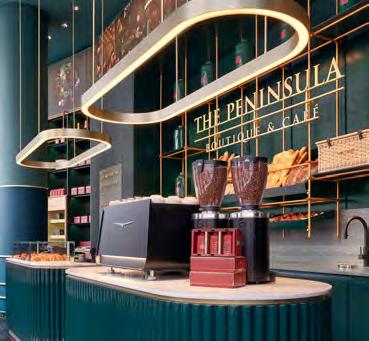

The newly open Peninsula London offers international dining, exceptional service and proximity to some of London’s most famous sites, all wrapped up in traditional English style. Is this an instant icon?
Nestled in the luxurious environs of Belgravia, The Peninsula London represents another iconic luxury hotel in the heart of the British capital, marking a new chapter in luxury hospitality. Positioned between Hyde Park Corner and Wellington Arch, this esteemed establishment promises a fusion of timeless British style, great food and contemporary opulence.
Designed to resonate with the essence of British heritage, The Peninsula London is replete with elements of architectural finesse. Crafted by Hopkins Architects, the hotel seamlessly blends with its surroundings, exuding a sense of grandeur and sophistication. Internationally acclaimed architect Peter Marino has curated 190 exquisite guest rooms and suites, each a haven of refined elegance. From bespoke furnishings to panoramic views of Belgravia, every detail speaks of unparalleled luxury.
Upon arrival, guests are greeted by an enchanting courtyard adorned with lush greenery, a rare sanctuary amid the bustling city. The hotel’s fleet of high-end vehicles offers discreet transportation options, ensuring a seamless transition into the lap of luxury.
Visitors indulge in a culinary journey at six distinct dining venues, each offering a symphony of flavours curated by world-class chefs. From traditional Peninsula Afternoon Tea to innovative Chinese cuisine at Canton Blue, every palate is catered to with the utmost finesse. The Brooklands Bar on the eighth floor is a must and the perfect place from which to enjoy sweeping views of the city.
The Peninsula London’s quintessentially British style and appeal is the result of exclusive collaborations with a series of acclaimed British artists and creators. The bespoke interior elements and amenities resulting from these exclusive collaborations – including works by fashion designer Jenny Packham, perfumier Timothy Han, and more than 40 artists from The Royal Drawing School – adorn all of the hotel’s public spaces, as well as its guest rooms.
In the future, guests will experience tranquillity and rejuvenation at The Peninsula Spa and Wellness Centre, set to open in November, offering world class treatment options in the middle of the city. As with all Peninsula properties, The Peninsula London pledges unwavering commitment to guest satisfaction and excellence in service. Come discover an instant icon next time you’re in London. ■
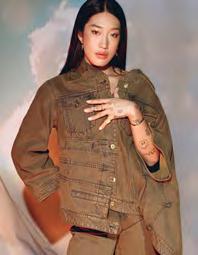
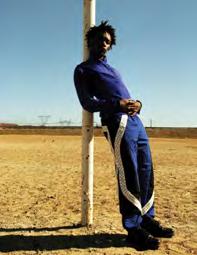
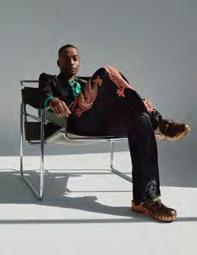


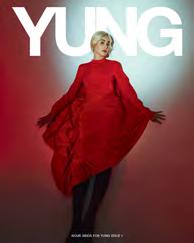

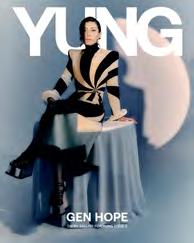

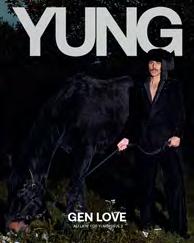
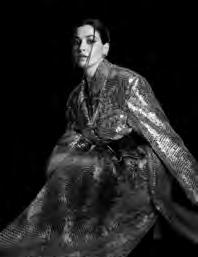
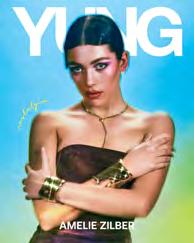
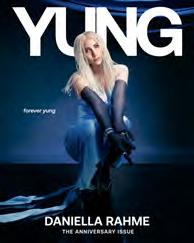
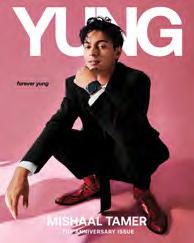




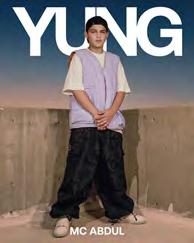



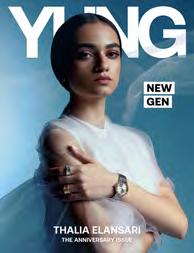
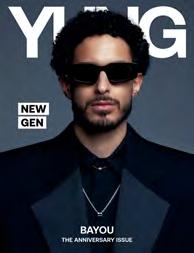
YUSRA MARDINI FOR YUNG ISSUE GEN LOVE THIS IS YUNG THE SPACE 288
TWO YEARS



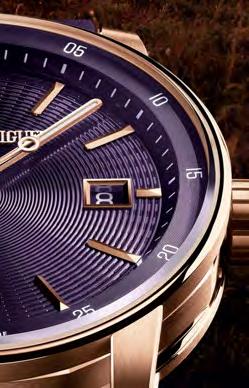
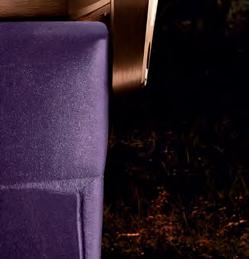
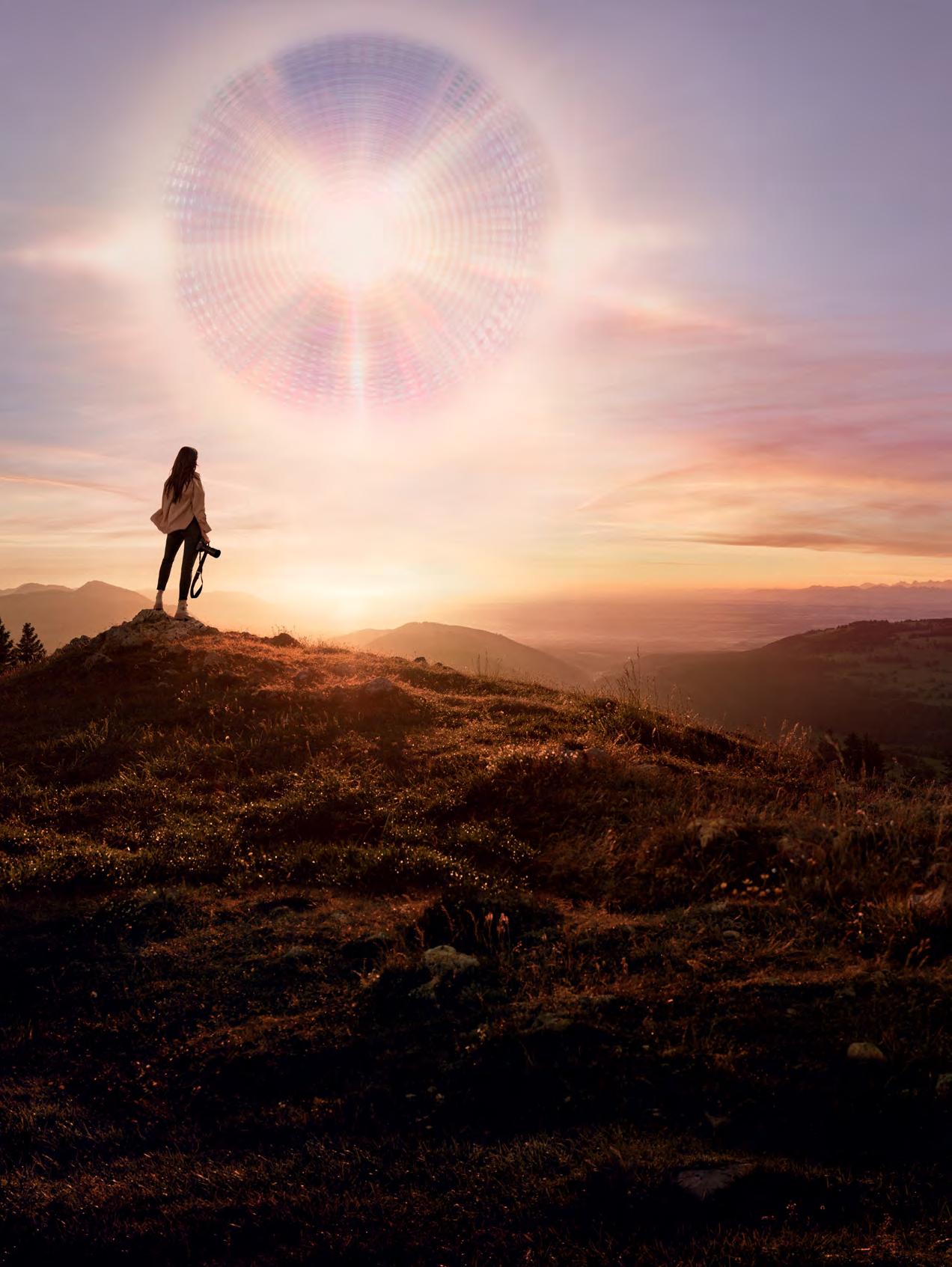


CODE 11.59 BY AUDEMARS PIGUET SELFWINDING
SEEK BEYOND















































































































 necklace, rings, watch, BULGARI. blazer, TOM FORD
necklace, rings, watch, BULGARI. blazer, TOM FORD








 earring, necklace, rings, BULGARI. dress, LOEWE
earring, necklace, rings, BULGARI. dress, LOEWE

 rings, bracelets, BULGARI. blazer, pans, shirt, tie, GEORGES HOBEIKA
rings, bracelets, BULGARI. blazer, pans, shirt, tie, GEORGES HOBEIKA
 earring, sunglasses, BULGARI. jacket, GEORGES HOBEIKA
earring, sunglasses, BULGARI. jacket, GEORGES HOBEIKA


















 rings, watch, BULGARI. dress, PRADA
rings, watch, BULGARI. dress, PRADA
 ring, watch, bracelet, necklace, earring BULGARI. top, NAFSIKA SKOURTI. skirt, VALENTINO
ring, watch, bracelet, necklace, earring BULGARI. top, NAFSIKA SKOURTI. skirt, VALENTINO

 earring, necklaces, BULGARI. top, NAFSIKA SKOURTI
earring, necklaces, BULGARI. top, NAFSIKA SKOURTI

 necklaces, BULGARI. dress, BOTTEGA VENETA
necklaces, BULGARI. dress, BOTTEGA VENETA






 rings, bracelet, BULGARI. top, pants, BOTTEGA VENETA
rings, bracelet, BULGARI. top, pants, BOTTEGA VENETA







 dress, VALENTINO. earrings BEA BONGIASCA
dress, VALENTINO. earrings BEA BONGIASCA
 blazer, trousers, heels, rose necklace
ALEXANDER MCQUEEN.
blazer, trousers, heels, rose necklace
ALEXANDER MCQUEEN.


 dress, heels ERDEM. necklace STYLIST’S OWN
dress, heels ERDEM. necklace STYLIST’S OWN

 top, skirt, RABANNE. heels, earrings, STYLIST’S OWN
top, skirt, RABANNE. heels, earrings, STYLIST’S OWN






















 “COCO CRUSH” necklaces in yellow gold, white gold and diamonds, all CHANEL FINE JEWELRY
“COCO CRUSH” necklaces in yellow gold, white gold and diamonds, all CHANEL FINE JEWELRY






 “COCO CRUSH” rings and earrings in white god, yellow gold and diamonds, all CHANEL FINE JEWELRY
“COCO CRUSH” rings and earrings in white god, yellow gold and diamonds, all CHANEL FINE JEWELRY




 vest, shorts, DOLCE & GABBANA. gloves, STYLIST’S OWN
vest, shorts, DOLCE & GABBANA. gloves, STYLIST’S OWN
















 Tod’s Mules, Tod’s Slingback Loafers, TOD’s
Tod’s Mules, Tod’s Slingback Loafers, TOD’s







 set design
YEHIA BEDIER; makeup
JEAN KAIROUZ; hair SHENEM FUAT; styling assistant AMY TAPPIN; production LANA SHASH
set design
YEHIA BEDIER; makeup
JEAN KAIROUZ; hair SHENEM FUAT; styling assistant AMY TAPPIN; production LANA SHASH
 Tod’s Di Bag, Tod’s Mules, full look, TOD’S
Tod’s Di Bag, Tod’s Mules, full look, TOD’S

 L: top, shorts, THE GIVING MOVEMENT. R: top, pants, THE GIVING MOVEMENT
L: top, shorts, THE GIVING MOVEMENT. R: top, pants, THE GIVING MOVEMENT







 MODELS SOHAILA KANDIL, ADAM JEMAME; PRODUCTION LANA SHASH bodysuit, THE GIVING MOVEMENT
MODELS SOHAILA KANDIL, ADAM JEMAME; PRODUCTION LANA SHASH bodysuit, THE GIVING MOVEMENT







 sneakers, BURBERRY
sneakers, BURBERRY

 sneakers, BURBERRY
sneakers, BURBERRY

 sneakers, BURBERRY
sneakers, BURBERRY

 sneakers, BURBERRY
sneakers, BURBERRY

 production assistant SANA JAMALI
sneakers, BURBERRY
production assistant SANA JAMALI
sneakers, BURBERRY
 bracelets, VAN CLEEF & ARPELS
bracelets, VAN CLEEF & ARPELS





 ring, bracelets, necklace, earrings, CARTIER
ring, bracelets, necklace, earrings, CARTIER

 bracelet, necklace, TIFFANY & CO.
bracelet, necklace, TIFFANY & CO.

 earrings, necklace, CHOPARD
earrings, necklace, CHOPARD









 BY MINA AL SHEIKHLY
BY MINA AL SHEIKHLY















































 photography by HIND LAHRICHI
photography by HIND LAHRICHI























































